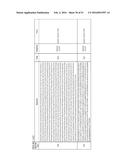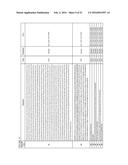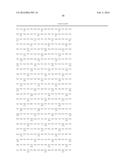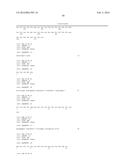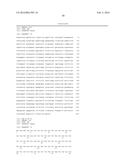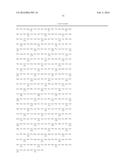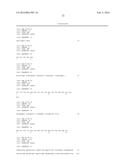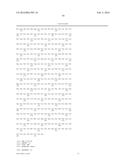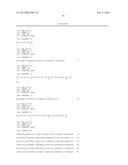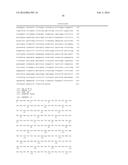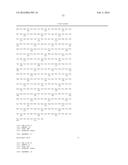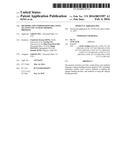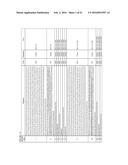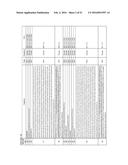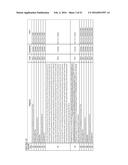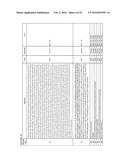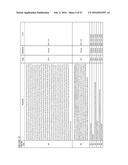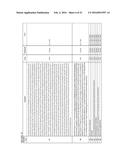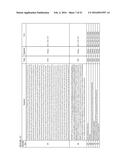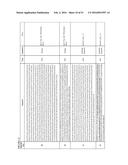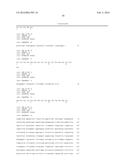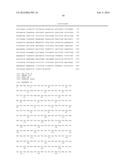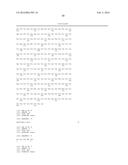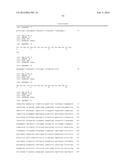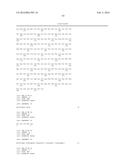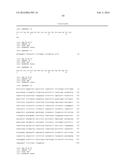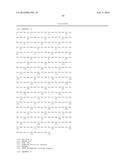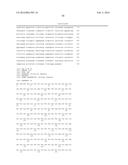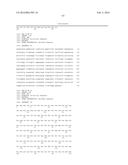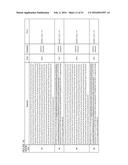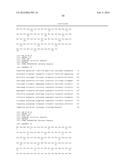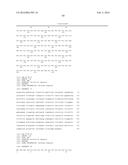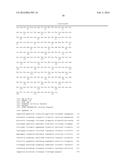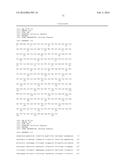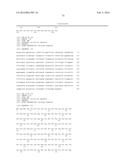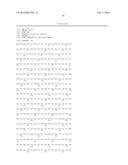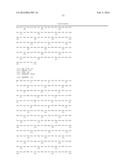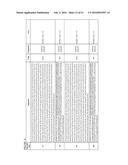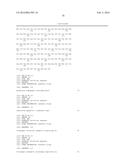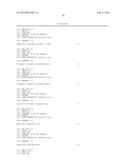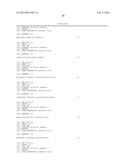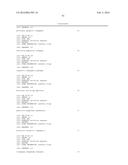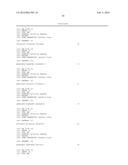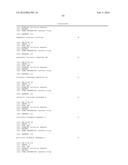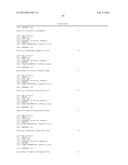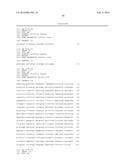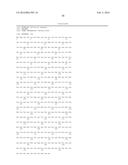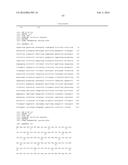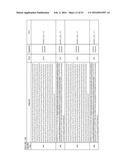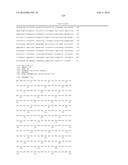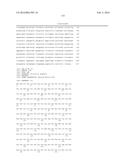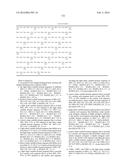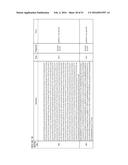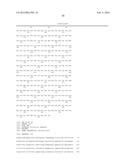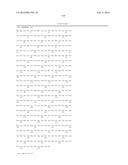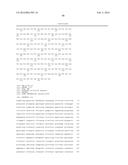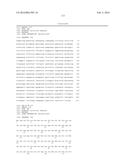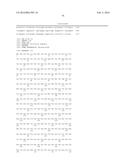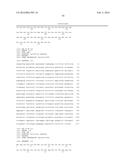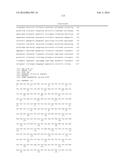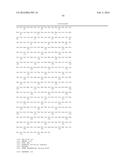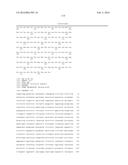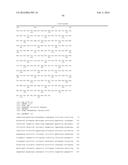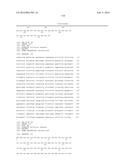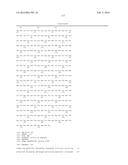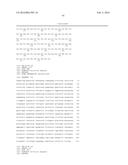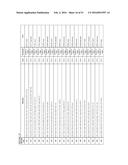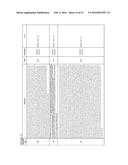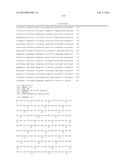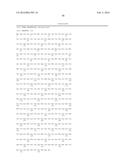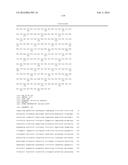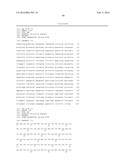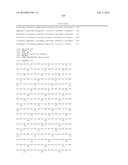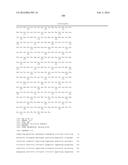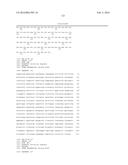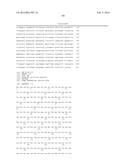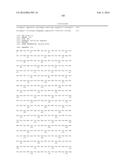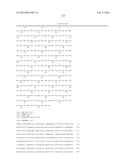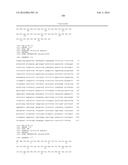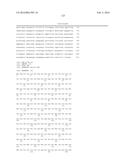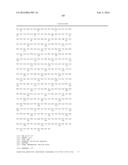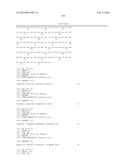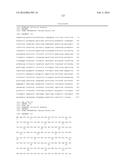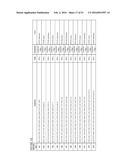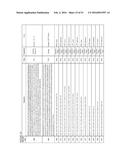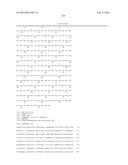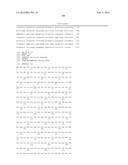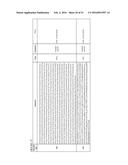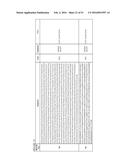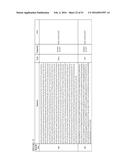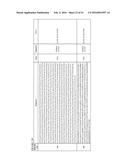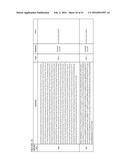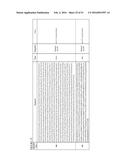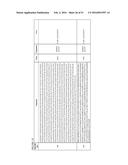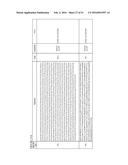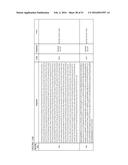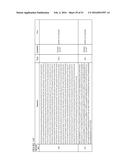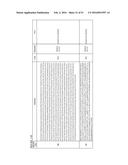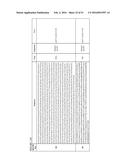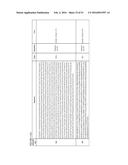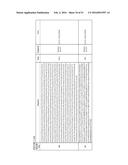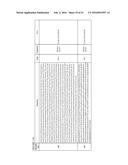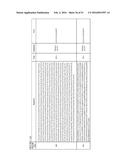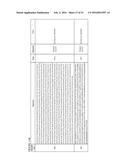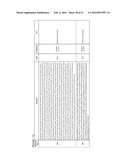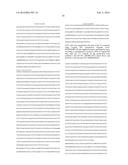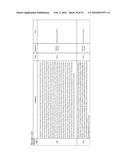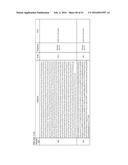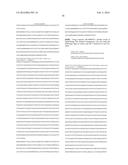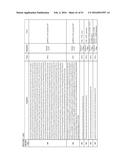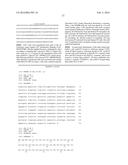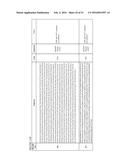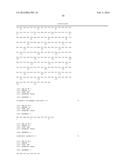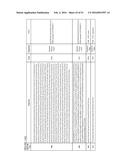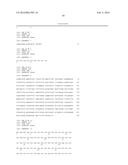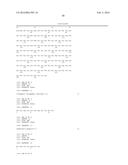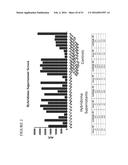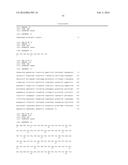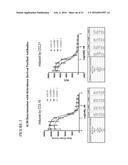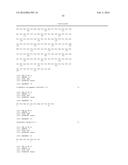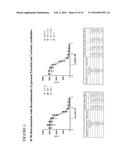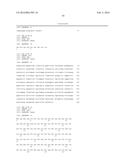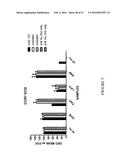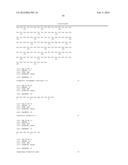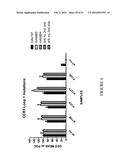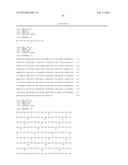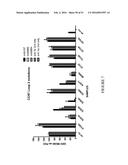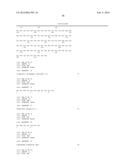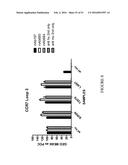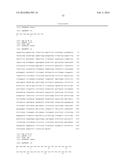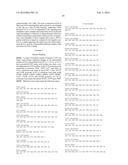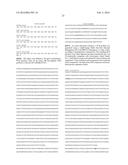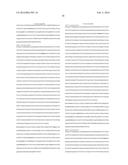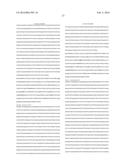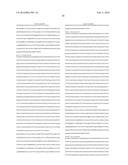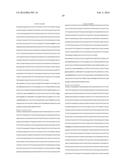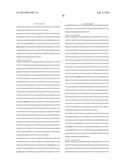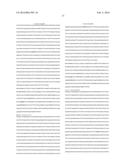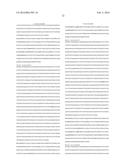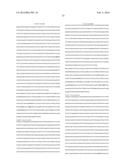Patent application title: METHODS AND COMPOSITIONS RELATING TO ANTI-CCR7 ANTIGEN BINDING PROTEINS
Inventors:
Chadwick Terence King (North Vancouver, CA)
Chadwick Terence King (North Vancouver, CA)
Gordon Ng (Vancouver, CA)
Shaw-Fen Sylvia Hu (Thousand Oaks, CA, US)
Hung Nguyen (Springfield, PA, US)
Jeannie Jung (Nagoya, Aichi, JP)
Assignees:
Amgen Inc.
IPC8 Class: AC07K1628FI
USPC Class:
5303873
Class name: Globulins immunoglobulin, antibody, or fragment thereof, other than immunoglobulin antibody, or fragment thereof that is conjugated or adsorbed chimeric, mutated, or recombined hybrid (e.g., bifunctional, bispecific, rodent-human chimeric, single chain, rfv, immunoglobulin fusion protein, etc.)
Publication date: 2016-02-04
Patent application number: 20160031997
Abstract:
The present invention provides compositions and methods relating to
antigen binding proteins against CCR7, including antibodies, nucleic
acids, vectors, methods of making the antigen binding proteins, and
methods of using the antigen binding proteins.Claims:
1. An isolated CCR7 antigen binding protein, wherein said antigen binding
protein comprises either: a. the light chain variable domain sequence of
antibody 6B4.1 LC, 6B5.1 LC, 6E1.2 LC, 6B4.1 LC desS, 6E1.2 LC H36Q,
MAB22_KLC-V1, MAB22_KLC_V2, MAB22_KLC_V3, MAB22_KLC_V4, MAB22_KLC_V5,
MAB22_KLC_V6, MAB22_KLC_V7, or MAB22_KLC_V8; or b. the heavy chain
variable domain sequence of 6B4.1 HC, 6B5.1 HC, 6E1.2 HC, 6E1.2 HC G2V,
6E1.2 HC F80Y, 6E1.2 HC G2V F80Y or MAB22_HC_V1; or c. a light chain
variable domain sequence that is at least 90%, 95%, 97%, or 99% identical
to the light chain variable domain sequence of 6B4.1 LC, 6B5.1 LC, 6E1.2
LC, 6B4.1 LC desS, 6E1.2 LC H36Q, MAB22_KLC-V1, MAB22_KLC_V2,
MAB22_KLC_V3, MAB22_KLC_V4, MAB22_KLC_V5, MAB22_KLC_V6, MAB22_KLC_V7, or
MAB22_KLC_V8; or d. a heavy chain variable domain sequence that is at
least 90%, 95%, 97%, or 99% identical to the heavy chain variable domain
sequence of 6B4.1 HC, 6B5.1 HC, 6E1.2 HC, or MAB22_HC_V1; or e. a light
chain variable domain sequence that differs at no more than 15, 12, 10,
8, 5, or 3 amino acid positions from the light chain variable domain
sequence of 6B4.1 LC, 6B5.1 LC, 6E1.2 LC, 6B4.1 LC desS, 6E1.2 LC H36Q,
MAB22_KLC-V1, MAB22_KLC_V2, MAB22_KLC_V3, MAB22_KLC_V4, MAB22_KLC_V5,
MAB22_KLC_V6, MAB22_KLC_V7, or MAB22_KLC_V8; or f. a heavy chain variable
domain sequence that differs at no more than 15, 12, 10, 8, 5, or 3 amino
acid positions from the heavy chain variable domain sequence of 6B4.1 HC,
6B5.1 HC, 6E1.2 HC, or MAB22_HC_V1; or g. a light chain variable domain
sequence that is encoded by a nucleic acid sequence that is at least 90%,
95%, 97%, or 99% identical to the nucleic acid sequence encoding the
light chain variable domain sequence of 6B4.1 LC, 6B5.1 LC, 6E1.2 LC,
6B4.1 LC desS, 6E1.2 LC H36Q, MAB22_KLC-V1, MAB22_KLC_V2, MAB22_KLC_V3,
MAB22_KLC_V4, MAB22_KLC_V5, MAB22_KLC_V6, MAB22_KLC_V7, or MAB22_KLC_V8
as provided in FIG. 1; or h. a heavy chain variable domain sequence that
is encoded by a nucleic acid sequence that is at least 90%, 95%, 97%, or
99% identical to the nucleic acid sequence encoding the heavy chain
variable domain sequence of 6B4.1 HC, 6B5.1 HC, 6E1.2 HC, 6E1.2 HC G2V,
6E1.2 HC F80Y, 6E1.2 HC G2V F80Y or MAB22_HC_V1, as provided in FIG. 1;
or i. a light chain variable domain sequence that is encoded by a nucleic
acid sequence that hybridizes under moderately stringent, stringent, or
highly stringent conditions to the nucleic acid sequence encoding the
light chain variable domain sequence of 6B4.1 LC, 6B5.1 LC, 6E1.2 LC,
6B4.1 LC desS, 6E1.2 LC H36Q, MAB22_KLC-V1, MAB22_KLC_V2, MAB22_KLC_V3,
MAB22_KLC_V4, MAB22_KLC_V5, MAB22_KLC_V6, MAB22_KLC_V7, or MAB22_KLC_V8
as provided in FIG. 1; or j. a heavy chain variable domain sequence that
is encoded by a nucleic acid sequence that hybridizes under moderately
stringent, stringent, or highly stringent conditions to the nucleic acid
sequence encoding the heavy chain variable domain sequence of 6B4.1 HC,
6B5.1 HC, 6E1.2 HC, 6E1.2 HC G2V, 6E1.2 HC F80Y, 6E1.2 HC G2V F80Y or
MAB22_HC_V1, as provided in FIG. 1; or k. CDR1, CDR2, and CDR3 of the
light chain variable domain sequence of 6B4.1 LC, 6B5.1 LC, 6E1.2 LC,
6B4.1 LC desS, 6E1.2 LC H36Q, or MAB22_KLC_V1; or l. CDR1, CDR2, and CDR3
of the heavy chain variable domain sequence of 6B4.1 HC, 6B5.1 HC, 6E1.2
HC, 6E1.2 HC G2V, 6E1.2 HC F80Y, 6E1.2 HC G2V F80Y, or MAB22_HC_V1; or m.
light chain variable domain CDR1, CDR2, and CDR3 sequences that each
differs at no more than 3, 2, or 1 amino acid positions from the light
chain variable domain CDR1, CDR2, and CDR3 sequences, respectively, of
the light chain variable domain sequence of 6B4.1 LC, 6B5.1 LC, 6E1.2 LC,
6B4.1 LC desS, 6E1.2 LC H36Q, or MAB22_KLC_V1; or n. heavy chain variable
domain CDR1, CDR2, and CDR3 sequences that each differs at no more than
3, 2, or 1 amino acid positions from the heavy chain variable domain
CDR1, CDR2, and CDR3 sequences, respectively, of the heavy chain variable
domain sequence of 6B4.1 HC, 6B5.1 HC, 6E1.2 HC, 6E1.2 HC G2V, 6E1.2 HC
F80Y, 6E1.2 HC G2V F80Y, or MAB22_HC_V1.
2. The isolated CCR7 antigen binding protein of claim 1, comprising: a. the light chain variable domain sequence of 6B4.1 LC or of 6B4.1 LC desS, as shown in FIG. 1, and the heavy chain variable domain sequence of 6B4.1 HC, as shown in FIG. 1; or b. the light chain variable domain sequence of 6B5.1 LC, as shown in FIG. 1, and the heavy chain variable domain sequence of 6B5.1 HC, as shown in FIG. 1; or c. the light chain variable domain sequence of 6E1.2 LC or of 6E1.2 LC H36Q, as shown in FIG. 1, and the heavy chain variable domain sequence of 6E1.2, 6E1.2 HC G2V, 6E1.2 HC F80Y, or 6E1.2 HC G2V F80Y, as shown in FIG. 1; or d. the light chain variable domain sequence of MAB22_KLC-V1, MAB22_KLC_V2, MAB22_KLC_V3, MAB22_KLC_V4, MAB22_KLC_V5, MAB22_KLC_V6, MAB22_KLC_V7, or MAB22_KLC_V1, as shown in FIG. 1, and the heavy chain variable domain sequence of MAB22_HC_V1, as shown in FIG. 2; or e. the light chain CDR 1, 2, and 3 sequences of 6B4.1 LC or of 6B4.1 LC desS, as shown in FIG. 1, and the heavy chain CDR 1, 2, and 3 sequences of 6B4.1 HC, as shown in FIG. 1; or f. the light chain CDR 1, 2, and 3 sequences of 6B5.1 LC, as shown in FIG. 1, and the heavy chain CDR 1, 2, and 3 sequences of 6B5.1 HC, as shown in FIG. 1; or g. the light chain CDR 1, 2, and 3 sequences of 6E1.2 LC or of 6E1.2 LC H36Q, as shown in FIG. 1, and the heavy chain CDR 1, 2, and 3 sequences of 6E1.2, 6E1.2 HC G2V, 6E1.2 HC F80Y, or 6E1.2 HC G2V F80Y, as shown in FIG. 1; or h. the light chain CDR 1, 2, and 3 sequences of MAB22_KLC-V1, as shown in FIG. 1, and the heavy chain CDR 1, 2, and 3 sequences of MAB22_HC_V1, as shown in FIG. 1; or i. a light chain variable domain sequence that is at least 90%, 95%, 97%, or 99% identical to the light chain variable domain sequence of 6B4.1 LC or of 6B4.1 LC desS, as shown in FIG. 1, and a heavy chain variable domain sequence that is at least 90%, 95%, 97%, or 99% identical to the heavy chain variable domain sequence of 6B4.1 HC, as shown in FIG. 1; or j. a light chain variable domain sequence that is at least 90%, 95%, 97%, or 99% identical to the light chain variable domain sequence of 6B5.1 LC, as shown in FIG. 1, and a heavy chain variable domain sequence that is at least 90%, 95%, 97%, or 99% identical to the heavy chain variable domain sequence of 6B5.1 HC, as shown in FIG. 1; or k. a light chain variable domain sequence that is at least 90%, 95%, 97%, or 99% identical to the light chain variable domain sequence of 6E1.2 LC or of 6E1.2 LC H36Q, as shown in FIG. 1, and a heavy chain variable domain sequence that is at least 90%, 95%, 97%, or 99% identical to the heavy chain variable domain sequence of 6E1.2, 6E1.2 HC G2V, 6E1.2 HC F80Y, or 6E1.2 HC G2V F80Y, as shown in FIG. 1; or l. a light chain variable domain sequence that is at least 90%, 95%, 97%, or 99% identical to the light chain variable domain sequence of MAB22_KLC-V1, MAB22_KLC_V2, MAB22_KLC_V3, MAB22_KLC_V4, MAB22_KLC_V5, MAB22_KLC_V6, MAB22_KLC_V7, or MAB22_KLC_V8, as shown in FIG. 1, and a heavy chain variable domain sequence that is at least 90%, 95%, 97%, or 99% identical to the heavy chain variable domain sequence of MAB22_HC_V1, as shown in FIG. 1; or m. the light chain sequence of 6B4.1 LC or of 6B4.1 LC desS, as shown in FIG. 1, and the heavy chain sequence of 6B4.1 HC, as shown in FIG. 1; or n. the light chain sequence of 6B5.1 LC, as shown in FIG. 1, and the heavy chain sequence of 6B5.1 HC, as shown in FIG. 1; or o. the light chain sequence of 6E1.2 LC or of 6E1.2 LC H36Q, as shown in FIG. 1, and the heavy chain sequence of 6E1.2, 6E1.2 HC G2V, 6E1.2 HC F80Y, or 6E1.2 HC G2V F80Y, as shown in FIG. 1; or p. the light chain sequence of MAB22_KLC-V1, MAB22_KLC_V2, MAB22_KLC_V3, MAB22_KLC_V4, MAB22_KLC_V5, MAB22_KLC_V6, MAB22_KLC_V7, or MAB22_KLC_V8, as shown in FIG. 1, and the heavy chain sequence of MAB22_HC_V1, as shown in FIG. 1.
3. The isolated CCR7 antigen binding protein of claim 1, wherein said CCR7 antigen binding protein is an anti-CCR7 antibody, and wherein said antibody comprises the sequences: a. 6B4.1 LC and 6B4. HC; b. 6B5.1 LC and 6B5.1 HC; or c. MAB22_KLC_V1 and MAB22_HC_V1.
4. The isolated CCR7 antigen binding protein of claim 1, wherein said antigen binding protein competes for binding to a human CCR7 with antibody 6B4.1, 6B5.1, or 6E1.2.
5. The isolated CCR7 antigen binding protein of claim 1, wherein said antigen binding protein comprises either: a. a light chain variable domain that differs from the light chain variable domain of antibody 6B4.1, 6B5.1, or 6E1.2 only in that one or more non-germline amino acid residues are replaced with the corresponding germline residues; b. a heavy chain variable domain that differs from the heavy chain variable domain of antibody 6B4.1, 6B5.1, or 6E1.2 only in that one or more non-germline amino acid residues are replaced with the corresponding germline residues; or c. a light chain variable domain that differs from the light chain variable domain of antibody 6B4.1, 6B5.1, or 6E1.2 only in that one or more non-germline amino acid residues are replaced with the corresponding germline residues, and a heavy chain variable domain that differs from the heavy chain variable domain of the same antibody 6B4.1, 6B5.1, or 6E1.2 only in that one or more non-germline amino acid residues are replaced with the corresponding germline residues.
6. The isolated CCR7 antigen binding protein of claim 1 wherein said antigen binding protein comprises: a. a human antibody; b. a humanized antibody; c. a chimeric antibody; d. a monoclonal antibody; e. a polyclonal antibody; f. a recombinant antibody; g. an antigen-binding antibody fragment; h. a single chain antibody; i. a diabody; j. a triabody; k. a tetrabody; l. a Fab fragment; m. a F(ab')2 fragment; n. a domain antibody; o. an IgD antibody; p. an IgE antibody; q. an IgM antibody; r. an IgG1 antibody; s. an IgG2 antibody; t. an IgG3 antibody; u. an IgG4 antibody; or v. an IgG4 antibody having at least one mutation in a hinge region that alleviates a tendency to form intra-H chain disulfide bond.
7. The isolated CCR7 antigen binding protein of claim 1 wherein said antigen binding protein inhibits binding of CCL19 or CCL21 to CCR7.
8. An isolated anti-CCR7 antibody, wherein said antibody binds to wild-type human CCR7, but does not bind to wild-type murine CCR7.
9. The isolated anti-CCR7 antibody of claim 8, wherein said antibody also binds to a mutated human CCR7 polypeptide, wherein said mutated human CCR7 polypeptide differs from wild-type human CCR7 only by the mutation F44Y.
10. The isolated anti-CCR7 antibody of claim 9, wherein said antibody binds to said mutated human CCR7 polypeptide at least as well as either antibody 6B4.1 or antibody 6B5.1.
11. The isolated anti-CCR7 antibody of claim 8, wherein said antibody does not bind to a mutated murine CCR7, wherein said mutated murine CCR7 differs from wild-type murine CCR7 only by the mutations Y44F and V47L.
12. The isolated anti-CCR7 antibody of claim 8, wherein said antibody binds better than antibody mAb197 to a mutated murine CCR7, wherein said mutated murine CCR7 differs from wild-type murine CCR7 only by the mutations K201R, N202S, G204S, T207A, and L208M.
13. An isolated polynucleotide comprising a sequence that encodes the light chain, the heavy chain, or both of said isolated CCR7 antigen binding protein of claim 1 or of the isolated anti-CCR7 antibody of claim 8.
14. The isolated polynucleotide of claim 13, wherein said isolated polynucleotide comprises a light chain variable domain nucleic acid sequence and/or a heavy chain variable domain nucleic acid sequence of FIG. 1.
15. A plasmid comprising said isolated polynucleotide of claim 13.
16. The plasmid of claim 15, wherein said plasmid is an expression vector.
17. An isolated cell comprising said isolated polynucleotide of claim 13.
18. The isolated cell of claim 17, wherein a chromosome of said cell comprises said polynucleotide.
19. The isolated cell of claim 17, wherein said cell is a hybridoma.
20. The isolated cell of claim 17, wherein an expression vector comprises said polynucleotide.
21. The isolated cell of claim 17, wherein said cell is a CHO cell.
22. The isolated cell of claim 17, wherein said cell is a bacterial cell.
23. The isolated cell of claim 17, wherein said cell is an E. coli cell.
24. The isolated cell of claim 17, wherein said cell is a yeast cell.
25. The isolated cell of claim 17, wherein said cell is an animal cell.
26. The isolated cell of claim 17, wherein said cell is a human cell.
27. A method of making a CCR7 antigen binding protein, comprising incubating said isolated cell of claim 17 under conditions that allow it to express said antigen binding protein.
28. A pharmaceutical composition comprising the CCR7 antigen binding protein of claim 1 or the anti-CCR7 antibody of claim 8.
Description:
CROSS-REFERENCE TO RELATED APPLICATIONS
[0001] This application claims the benefit of U.S. Provisional Application Ser. No. 61/962,296, filed Mar. 15, 2013. The above-identified application is incorporated herein by reference.
REFERENCE TO THE SEQUENCE LISTING
[0002] The present application is being filed along with a Sequence Listing in electronic format via EFS-Web. The Sequence Listing is provided as a text file entitled A-1814-WO-PCT_ST25.txt, created Mar. 11, 2014, which is 242,848 bytes in size. The information in the electronic format of the Sequence Listing is incorporated herein by reference in its entirety.
BACKGROUND
[0003] CCR7 and its ligands CCL19 and CCL21 play non-redundant roles in regulating the migration, organization, and activation of dendritic cells and naive T and B cells in secondary and tertiary (disease-associated) lymphoid structures.
[0004] CCR7 activity has been implicated in a diverse variety of disease states, including chronic inflammatory conditions (Moschovakis et al., 2012, Eur J Immunol. 42:1949-55), atherosclerosis (Luchtefeld et al., 2010, Circulation 122:1621-28), HIV infection (Evans et al., 2012, Cytokine Growth Factor Rev. 23:151-57), and cancer (Ben-Baruch, 2009, Cell Adhesion Migration 3:328-33).
SUMMARY OF THE INVENTION
[0005] In one aspect, the present invention provides an isolated anti-CCR7 antigen binding protein, wherein said antigen binding protein comprises either: the light chain variable domain sequence of antibody 6B4.1, 6B5.1, 6E1.2, 6B4.1 LC desS, 6E1.2 LC H36Q, MAB22_KLC-V1, MAB22_KLC_V2, MAB22_KLC_V3, MAB22_KLC_V4, MAB22_KLC_V5, MAB22_KLC_V6, MAB22_KLC_V7, or MAB22_KLC_V8; or the heavy chain variable domain sequence of 6B4.1, 6B5.1, 6E1.2, 6E1.2 HC G2V, 6E1.2 HC F80Y, 6E1.2 HC G2V F80Y or MAB22_HC_V1; or the heavy chain variable domain and the light chain variable domain of antibody 6B4.1, 6B5.1, or 6E1.2; or a light chain variable domain sequence that is at least 90%, 95%, 97%, or 99% identical to the light chain variable domain sequence of 6B4.1, 6B5.1, 6E1.2, 6B4.1 LC desS, or 6E1.2 LC H36Q; or a heavy chain variable domain sequence that is at least 90%, 95%, 97%, or 99% identical to the heavy chain variable domain sequence of 6B4.1, 6B5.1, or 6E1.2; or a light chain variable domain sequence and a heavy chain variable domain sequence that each is at least 90%, 95%, 97%, or 99% identical to the light chain variable domain sequence and the heavy chain variable domain sequence, respectively, of antibody 6B4.1, 6B5.1, or 6E1.2; or a light chain variable domain sequence that differs at no more than 15, 12, 10, 8, 5, or 3 amino acid positions from the light chain variable domain sequence of 6B4.1, 6B5.1, 6E1.2, 6B4.1 LC desS, or 6E1.2 LC H36Q; or a heavy chain variable domain sequence that differs at no more than 15, 12, 10, 8, 5, or 3 amino acid positions from the heavy chain variable domain sequence of 6B4.1, 6B5.1, or 6E1.2; or a light chain variable domain sequence and a heavy chain variable domain sequence that each differs at no more than 15, 12, 10, 8, 5, or 3 amino acid positions from the light chain variable domain sequence and the heavy chain variable domain sequence, respectively, of 6B4.1, 6B5.1, or 6E1.2; or a light chain variable domain sequence that is encoded by a nucleic acid sequence that is at least 90%, 95%, 97%, or 99% identical to the nucleic acid sequence encoding the light chain variable domain sequence of 6B4.1, 6B5.1, 6E1.2, 6B4.1 LC desS, 6E1.2 LC H36Q, MAB22_KLC-V1, MAB22_KLC_V2, MAB22_KLC_V3, MAB22_KLC_V4, MAB22_KLC_V5, MAB22_KLC_V6, MAB22_KLC_V7, or MAB22_KLC_V8 as provided in FIG. 1; or a heavy chain variable domain sequence that is encoded by a nucleic acid sequence that is at least 90%, 95%, 97%, or 99% identical to the nucleic acid sequence encoding the heavy chain variable domain sequence of 6B4.1, 6B5.1, 6E1.2, 6E1.2 HC G2V, 6E1.2 HC F80Y, 6E1.2 HC G2V F80Y or MAB22_HC_V1, as provided in FIG. 1; or a light chain variable domain sequence that is encoded by a nucleic acid sequence that is at least 90%, 95%, 97%, or 99% identical to the nucleic acid sequence encoding the light chain variable domain sequence of 6B4.1, 6B5.1, 6E1.2, 6B4.1 LC desS, 6E1.2 LC H36Q, MAB22_KLC-V1, MAB22_KLC_V2, MAB22_KLC_V3, MAB22_KLC_V4, MAB22_KLC_V5, MAB22_KLC_V6, MAB22_KLC_V7, or MAB22_KLC_V8 as provided in FIG. 1, and a heavy chain variable domain sequence that is encoded by a nucleic acid sequence that is at least 90%, 95%, 97%, or 99% identical to the nucleic acid sequence encoding the heavy chain variable domain sequence of 6B4.1, 6B5.1, 6E1.2, 6E1.2 HC G2V, 6E1.2 HC F80Y, 6E1.2 HC G2V F80Y or MAB22_HC_V1, as provided in FIG. 1; or a light chain variable domain sequence that is encoded by a nucleic acid sequence that hybridizes under moderately stringent, stringent, or highly stringent conditions to the nucleic acid sequence encoding the light chain variable domain sequence of 6B4.1, 6B5.1, 6E1.2, 6B4.1 LC desS, 6E1.2 LC H36Q, MAB22_KLC-V1, MAB22_KLC_V2, MAB22_KLC_V3, MAB22_KLC_V4, MAB22_KLC_V5, MAB22_KLC_V6, MAB22_KLC_V7, or MAB22_KLC_V8 as provided in FIG. 1; or a heavy chain variable domain sequence that is encoded by a nucleic acid sequence that hybridizes under moderately stringent, stringent, or highly stringent conditions to the nucleic acid sequence encoding the heavy chain variable domain sequence of 6B4.1, 6B5.1, 6E1.2, 6E1.2 HC G2V, 6E1.2 HC F80Y, 6E1.2 HC G2V F80Y or MAB22_HC_V1, as provided in FIG. 1; or a light chain variable domain sequence that is encoded by a nucleic acid sequence that hybridizes under moderately stringent, stringent, or highly stringent conditions to the nucleic acid sequence encoding the light chain variable domain sequence of 6B4.1, 6B5.1, 6E1.2, 6B4.1 LC desS, 6E1.2 LC H36Q, MAB22_KLC-V1, MAB22_KLC_V2, MAB22_KLC_V3, MAB22_KLC_V4, MAB22_KLC_V5, MAB22_KLC_V6, MAB22_KLC_V7, or MAB22_KLC_V8 as provided in FIG. 1, and a heavy chain variable domain sequence that is encoded by a nucleic acid sequence that hybridizes under moderately stringent, stringent, or highly stringent conditions to the nucleic acid sequence encoding the heavy chain variable domain sequence of the same antibody 6B4.1, 6B5.1, 6E1.2, 6E1.2 HC G2V, 6E1.2 HC F80Y, 6E1.2 HC G2V F80Y or MAB22_HC_V1; or CDR1, CDR2, and CDR3 of the light chain variable domain sequence of 6B4.1, 6B5.1, 6E1.2, 6B4.1 LC desS, 6E1.2 LC H36Q; or CDR1, CDR2, and CDR3 of the heavy chain variable domain sequence of 6B4.1, 6B5.1, 6E1.2, 6E1.2 HC G2V, 6E1.2 HC F80Y, or 6E1.2 HC G2V F80Y; or CDR1, CDR2, and CDR3 of the light chain variable domain sequence, and CDR1, CDR2, and CDR3 of the heavy chain variable domain sequence, of 6B4.1, 6B5.1, or 6E1.2; or light chain variable domain CDR1, CDR2, and CDR3 sequences that each differs at no more than 3, 2, or 1 amino acid positions from the light chain variable domain CDR1, CDR2, and CDR3 sequences, respectively, of the light chain variable domain sequence of 6B4.1, 6B5.1, 6E1.2, 6B4.1 LC desS, 6E1.2 LC H36Q; or heavy chain variable domain CDR1, CDR2, and CDR3 sequences that each differs at no more than 3, 2, or 1 amino acid positions from the heavy chain variable domain CDR1, CDR2, and CDR3 sequences, respectively, of the heavy chain variable domain sequence of 6B4.1, 6B5.1, 6E1.2, 6E1.2 HC G2V, 6E1.2 HC F80Y, or 6E1.2 HC G2V F80Y; or light chain variable domain CDR1, CDR2, and CDR3 sequences that each differs at no more than 3, 2, or 1 amino acid positions from the light chain variable domain CDR1, CDR2, and CDR3 sequences, respectively, of the light chain variable domain sequence of antibody 6B4.1, 6B5.1, or 6E1.2, and heavy chain variable domain CDR1, CDR2, and CDR3 sequences that each differs at no more than 3, 2, or 1 amino acid positions from the heavy chain variable domain CDR1, CDR2, and CDR3 sequences, respectively, of the heavy chain variable domain sequence of the same antibody 6B4.1, 6B5.1, or 6E1.2.
[0006] In one embodiment, the anti-CCR7 antigen binding protein comprises: the light chain sequence of 6B4.1 LC or of 6B4.1 LC desS and the heavy chain sequence of 6B4.1 HC, as shown in FIG. 1; or the light chain sequence of 6B5.1 LC and the heavy chain sequence of 6B5.1 HC, as shown in FIG. 1; or the light chain sequence of 6E1.2 LC or of 6E1.2 LC H36Q and the heavy chain sequence of 6E1.2, 6E1.2 HC G2V, 6E1.2 HC F80Y, or 6E1.2 HC G2V F80Y, as shown in FIG. 1; or the light chain sequence of MAB22_KLC-V1, MAB22_KLC_V2, MAB22_KLC_V3, MAB22_KLC_V4, MAB22_KLC_V5, MAB22_KLC_V6, MAB22_KLC_V7, or MAB22_KLC_V8 and the heavy chain sequence of MAB22_HC_V1.
[0007] In another embodiment, the isolated anti-CCR7 antigen binding protein competes for binding to a human CCR7 with antibody 6B4.1, 6B5.1, or 6E1.2.
[0008] In another embodiment, the antigen binding protein comprises either: a light chain variable domain that differs from the light chain variable domain of antibody 6B4.1, 6B5.1, or 6E1.2 only in that one or more non-germline amino acid residues are replaced with the corresponding germline residues; a heavy chain variable domain that differs from the heavy chain variable domain of antibody 6B4.1, 6B5.1, or 6E1.2 only in that one or more non-germline amino acid residues are replaced with the corresponding germline residues; or a light chain variable domain that differs from the light chain variable domain of antibody 6B4.1, 6B5.1, or 6E1.2 only in that one or more non-germline amino acid residues are replaced with the corresponding germline residues, and a heavy chain variable domain that differs from the heavy chain variable domain of the same antibody 6B4.1, 6B5.1, or 6E1.2 only in that one or more non-germline amino acid residues are replaced with the corresponding germline residues.
[0009] In another embodiment, the isolated CCR7 antigen binding protein comprises: a human antibody; a humanized antibody; a chimeric antibody; a monoclonal antibody; a polyclonal antibody; a recombinant antibody; an antigen-binding antibody fragment; a single chain antibody; a diabody; a triabody; a tetrabody; a Fab fragment; a F(ab')2 fragment; a domain antibody; an IgD antibody; an IgE antibody; an IgM antibody; an IgG1 antibody; an IgG2 antibody; an IgG3 antibody; an IgG4 antibody; or an IgG4 antibody having at least one mutation in a hinge region that alleviates a tendency to form intra-H chain disulfide bond.
[0010] In another embodiment, the isolated anti-CCR7 antigen binding protein inhibits binding of CCL19 or CCL21 to CCR7.
[0011] In another aspect, the present invention provides an isolated polynucleotide comprising a sequence that encodes the light chain, the heavy chain, or both of an isolated anti-CCR7 antigen binding protein.
[0012] In one embodiment, the isolated polynucleotide comprises a light chain variable domain nucleic acid sequence and/or a heavy chain variable domain nucleic acid sequence of FIG. 1.
[0013] In another aspect, the present invention provides a plasmid comprising the isolated polynucleotide.
[0014] In one embodiment, the plasmid is an expression vector.
[0015] In another aspect, the present invention provides an isolated cell comprising the isolated polynucleotide.
[0016] In another embodiment, a chromosome of the cell comprises the polynucleotide.
[0017] In another embodiment, the cell is a hybridoma.
[0018] In another embodiment, an expression vector comprises said polynucleotide.
[0019] In another embodiment, the cell is a CHO cell.
[0020] In another embodiment, the cell is a bacterial cell.
[0021] In another embodiment, the cell is an E. coli cell.
[0022] In another embodiment, the cell is a yeast cell.
[0023] In another embodiment, the cell is an animal cell.
[0024] In another embodiment, the cell is a human cell.
[0025] In another aspect, the present invention provides a method of making an anti-CCR7 antigen binding protein, comprising incubating the isolated cell under conditions that allow it to express the antigen binding protein.
[0026] In another aspect, the present invention provides a pharmaceutical composition comprising the anti-CCR7 antigen binding protein.
BRIEF DESCRIPTION OF THE FIGURE
[0027] FIG. 1A-AR provides nucleic acid and amino acid sequences of the antibodies and other polypeptides disclosed herein. Variable domain sequences of light and heavy chain antibody sequences are underlined.
[0028] FIG. 2 provides the results of a hybridoma supernatant screen.
[0029] FIG. 3 provides graphs for determining the IC50 of antibodies mAb197, 6B4.1, 6B5.1, and 6E1.2 for inhibition of CCR7 activity induced by CCL19 or by CCL21.
[0030] FIG. 4 provides IC50 determinations for antibodies mAB197, 6B5.1, 6B4.1, 6E1.2, 6E1.2 G2V, and 6E1.2 F90Y.
[0031] FIG. 5 provides epitope mapping data for antibodies mAb197, 6B4.1, and 6B5.1.
[0032] FIG. 6 provides epitope mapping data for antibodies mAb197, 6B4.1, and 6B5.1.
[0033] FIG. 7 provides epitope mapping data for antibodies mAb197, 6B4.1, and 6B5.1.
[0034] FIG. 8 provides epitope mapping data for antibodies mAb197, 6B4.1, and 6B5.1.
DETAILED DESCRIPTION
[0035] The section headings used herein are for organizational purposes only and are not to be construed as limiting the subject matter described.
[0036] Unless otherwise defined herein, scientific and technical terms used in connection with the present application shall have the meanings that are commonly understood by those of ordinary skill in the art. Further, unless otherwise required by context, singular terms shall include pluralities and plural terms shall include the singular.
[0037] Generally, the terminology and techniques of cell and tissue culture, molecular biology, immunology, microbiology, genetics, protein and nucleic acid chemistry, manufacturing, formulation, pharmacology, and medicine described herein are those well known and commonly used in the art. The methods and techniques of the present application are generally performed according to conventional methods well known in the art and as described in various general and more specific references that are cited and discussed throughout the present specification unless otherwise indicated. See, e.g., Sambrook et al., Molecular Cloning: A Laboratory Manual, 3rd ed., Cold Spring Harbor Laboratory Press, Cold Spring Harbor, N.Y. (2001), Ausubel et al., Current Protocols in Molecular Biology, Greene Publishing Associates (1992), and Harlow and Lane Antibodies: A Laboratory Manual Cold Spring Harbor Laboratory Press, Cold Spring Harbor, N.Y. (1990), which are incorporated herein by reference. Enzymatic reactions and purification techniques are performed according to manufacturer's specifications, as commonly accomplished in the art, or as described herein. The terminology used in connection with, and the laboratory procedures and techniques of, analytical chemistry, synthetic organic chemistry, and medicinal and pharmaceutical chemistry described herein are those well known and commonly used in the art. Standard techniques can be used for chemical syntheses, chemical analyses, pharmaceutical preparation, formulation, and delivery, and treatment of patients.
[0038] This invention is not limited to the particular methodology, protocols, reagents, etc., described herein. The terminology used herein is for the purpose of describing particular embodiments only, and is not intended to limit the scope of the present invention as defined by the claims.
[0039] Other than in the operating examples, or where otherwise indicated, all numbers expressing quantities of ingredients or reaction conditions used herein should be understood as modified in all instances by the term "about" as that term would be interpreted by the person skilled in the relevant art.
DEFINITIONS
[0040] The term "polynucleotide" or "nucleic acid" includes nucleotide polymers of any length. They can be, for example, single-stranded, double-stranded, or triple-stranded, or a combination of single- and/or double- and/or triple-stranded. Where a nucleotide polymer comprises more than one strand, each strand is itself understood to be a polynucleotide or nucleic acid. Where a nucleotide polymer is double-stranded, typically each of the strands is complementary to the other, although their complementarity need not be perfect and in some instances is sufficient to allow the stable association or hybridization of the two strands only under certain hybridization conditions. The nucleotides comprising the polynucleotide can be naturally-occurring or artificial nucleotide analogs, such as, for example, ribonucleotides, deoxyribonucleotides, or modified forms of either type of nucleotide, or a combination of different types of nucleotides and/or nucleotide analogs. Said modifications include, for example, base modifications, such as bromouridine and inosine derivatives, ribose modifications, such as 2',3'-dideoxyribose, and internucleotide linkage modifications, such as phosphorothioate, phosphorodithioate, phosphoroselenoate, phosphorodiselenoate, phosphoroanilothioate, phoshoraniladate and phosphoroamidate. The terms "polynucleotide" and "nucleic acid" include nucleotide polymers that have been covalently or non-covalently modified by the addition of one or more non-polynucleotide chemical entities, such as, for example, labels, (e.g., radiolabels), fluorescent labels, haptens or antigenic labels as well as nucleotide polymers that have been covalently or non-covalently bound to a solid object or surface, such as a hybridization membrane (e.g., a nitrocellulose hybridization membrane), a bead, a vessel wall, or the like.
[0041] The term "oligonucleotide" refers generally to shorter polynucleotide or nucleic acid sequences. The length of a particular oligonucleotide will depend on how it is made and/or its intended use. Typically, it refers to a polynucleotide comprising 200 or fewer nucleotides. In some embodiments, oligonucleotides are 10 to 60 bases in length. In other embodiments, oligonucleotides are 12, 13, 14, 15, 16, 17, 18, 19, or 20 to 40 nucleotides in length. Oligonucleotides may be, for example, single-, double-, or triple-stranded. Single stranded oligonucleotides may be sense or antisense oligonucleotides. Oligonucleotides have many uses, including, for example, as PCR primers, cloning primers, adapters for joining two or more polynucleotides, and hybridization probes.
[0042] An "isolated nucleic acid molecule" means a DNA or RNA of genomic, mRNA, cDNA, or synthetic origin, or some combination thereof, which is at least partially removed from its natural environment. Examples of isolated nucleic acid molecules include nucleic acids that have sequences found in nature but that are produced synthetically, naturally-occurring nucleic acids that are not associated with all or a portion of a polynucleotide in which the isolated polynucleotide is found in nature, naturally-occurring nucleic acids that are linked to a polynucleotide to which they are not linked in nature, and naturally-occurring nucleic acids that have been at least partially removed from their natural cellular environment. For purposes of this disclosure, it should be understood that "a nucleic acid molecule comprising" a particular nucleotide sequence does not encompass intact naturally-occurring chromosomes. Isolated nucleic acid molecules "comprising" specified nucleic acid sequences may include other sequences as well, such as, for example, one or more other coding sequences, operably linked regulatory sequences that control or affect expression of the coding region of the recited nucleic acid sequences, vector or plasmid sequences, sequences controlling or affecting replication of the nucleic acid, restriction sites, primer binding sites, and the like.
[0043] Unless specified otherwise, the left-hand end of any single-stranded polynucleotide sequence provided herein is the 5' end; the left-hand direction of double-stranded polynucleotide sequences is referred to as the 5' direction. The direction of 5' to 3' addition of nascent RNA transcripts is referred to as the transcription direction; sequence regions on the DNA strand having the same sequence as the RNA transcript that are 5' to the 5' end of the RNA transcript are referred to as "upstream sequences;" sequence regions on the DNA strand having the same sequence as the RNA transcript that are 3' to the 3' end of the RNA transcript are referred to as "downstream sequences."
[0044] The term "control sequence" refers to a polynucleotide sequence that can affect the expression and/or processing of a coding sequence to which it is ligated. The nature of such control sequences may depend upon the host organism. In particular embodiments, control sequences for prokaryotes may include a promoter, a ribosomal binding site, and a transcription termination sequence. Examples of control sequences for eukaryotes include promoters comprising one or a plurality of recognition sites for transcription factors, transcription enhancer sequences, and transcription termination sequences. The term "control sequences" can refer to leader sequences and/or fusion partner sequences as well.
[0045] The term "vector" means any molecule or entity (e.g., nucleic acid, plasmid, bacteriophage or virus) used to transfer protein coding information into a host cell.
[0046] The terms "expression vector," "expression plasmid," and "expression construct" each refers to a vector that is suitable for transformation of a host cell and contains nucleic acid sequences that allows (in conjunction with the host cell) expression of one or more heterologous coding regions operatively linked thereto. An expression construct may include, but is not limited to, sequences that affect or control transcription, translation, and, if introns are present, affect RNA splicing of a coding region operably linked thereto.
[0047] As used herein, "operably linked" means that the components to which the term is applied are in a relationship that allows them to carry out their inherent or desired functions under suitable conditions. An example of a control sequence that is "operably linked" to a protein coding sequence in a vector is an enhancer region that is ligated (either directly or via intermediary sequences) to the protein coding sequence such that expression of the protein coding sequence is achieved under conditions compatible with the transcriptional activity of the enhancer region.
[0048] The term "host cell" means a cell capable of expressing, under the correct conditions, a coding sequence of interest. The term includes the progeny of the parent cell, whether or not the progeny is identical in morphology or in genetic make-up to the original parent cell, so long as the coding sequence of interest is present. A "host cell" can be a cell that has been transformed, or is capable of being transformed, with a nucleic acid sequence and thereby express a coding sequence of interest.
[0049] The term "transduction" means the transfer of genes from one bacterium to another, usually by bacteriophage. "Transduction" also refers to the acquisition and transfer of eukaryotic cellular sequences by replication defective retroviruses.
[0050] The term "transfection" means the uptake of foreign or exogenous DNA by a cell, and a cell has been "transfected" when the exogenous DNA has been introduced into the cell. A number of transfection techniques are well known in the art and are disclosed herein. See, e.g., Graham et al., 1973, Virology 52:456; Sambrook et al., 2001, Molecular Cloning: A Laboratory Manual, supra; Davis et al., 1986, Basic Methods in Molecular Biology, Elsevier; Chu et al., 1981, Gene 13:197. Such techniques can be used to introduce one or more exogenous DNA moieties into suitable host cells. Depending on the technique used to make the transfected cell and the desired use of the transfected cell, a cell can be transfected either stably or transiently.
[0051] The term "transformation" refers to a change in a cell's genetic characteristics, and a cell has been transformed when it has been modified to contain new DNA or RNA. For example, a cell is transformed where it is genetically modified from its native state by introducing new genetic material via, for example, transfection or transduction, or via another technique, such as a chemical, ballistic, or electroporation technique. Following transformation, the transforming DNA may recombine with that of the cell by physically integrating into a chromosome of the cell, or may be maintained transiently as an episomal element without being replicated and/or stably propagated during cellular division, or it may replicate independently as a plasmid. A cell is considered to have been "stably transformed" when the transforming DNA is replicated as part of the host cell's cycle of cell division.
[0052] The terms "polypeptide" or "protein" are used interchangeably herein to refer to a polymer of amino acid residues. The terms also apply to amino acid polymers in which one or more amino acid residues is an analog, derivative, or mimetic of a naturally occurring amino acid, as well as to naturally occurring amino acid polymers. The terms also encompass amino acid polymers that have been modified. Such modifications include any naturally-occurring or artificial modification of a polypeptide. Some such modifications will alter the sequence of the polypeptide, but others will not. Examples of such modifications include the addition of carbohydrate residues and phosphorylation. Polypeptides and proteins can be produced and/or modified by a naturally-occurring and non-recombinant cell or they can be produced by a genetically-engineered or recombinant cell. "Polypeptides" and "proteins" comprise molecules having the amino acid sequence of a native protein, or molecules having deletions from, additions to, and/or substitutions of one or more amino acids of, the native sequence. The terms "polypeptide" and "protein" specifically encompass CCR7 antigen-binding proteins, antibodies, or sequences that have deletions from, additions to, and/or substitutions of one or more amino acids of an antigen-binding protein. The term "polypeptide fragment" refers to a polypeptide that has an amino-terminal deletion, a carboxyl-terminal deletion, and/or an internal deletion as compared with the full-length protein. Such fragments may also contain modified amino acids as compared with the full-length protein. In certain embodiments, fragments are about five to 500 amino acids long. For example, fragments may be at least 5, 6, 8, 10, 14, 20, 50, 70, 100, 110, 150, 200, 250, 300, 350, 400, or 450 amino acids long. Useful polypeptide fragments include immunologically functional fragments of antibodies, including binding domains. In the case of a CCR7-binding antibody, useful fragments include but are not limited to a CDR region, a variable domain of a heavy or light chain, a portion of an antibody chain or just its variable region including two CDRs, and the like.
[0053] An "isolated protein" (1) is free of at least some other proteins or cellular components with which it would normally be found, (2) is essentially free of other proteins from the same source, e.g., from the same species, (3) is expressed by a cell from a different species, (4) has been separated from at least about 50 percent of polynucleotides, lipids, carbohydrates, or other materials with which it is associated in nature, (5) is operably associated (by covalent or noncovalent bonds) with a polypeptide with which it is not associated in nature, or (6) does not occur in nature. An "isolated protein" can constitute at least about 5%, at least about 10%, at least about 25%, or at least about 50% of a given sample. Genomic DNA, cDNA, mRNA or other RNA, of synthetic origin, or any combination thereof may encode such an isolated protein. In some embodiments, the isolated protein is substantially free from proteins or polypeptides or other contaminants that are found in its natural environment that would interfere with its therapeutic, diagnostic, prophylactic, research or other use.
[0054] A "variant" of a polypeptide (e.g., of an antigen binding protein or of an antibody) comprises an amino acid sequence wherein one or more amino acid residues are inserted into, deleted from and/or substituted into the amino acid sequence relative to another polypeptide sequence. A fusion protein comprising all or part of a polypeptide is one example of a variant of the polypeptide.
[0055] A "derivative" of a polypeptide is a polypeptide (e.g., an antigen binding protein, or an antibody) that has been chemically modified in some manner distinct from the insertion, deletion, and/or substitution of amino acids, e.g., via conjugation to another chemical moiety. An antigen binding protein that contains all or most of either the light- or heavy-chain variable domain of an antibody, but lacks most or all of the other variable domain of the antibody, is an example of a derivative of the antibody.
[0056] The term "naturally occurring" as used throughout the specification in connection with biological materials such as polypeptides, nucleic acids, host cells, and the like, refers to materials which are found in nature.
[0057] An "antigen binding protein" as used herein means a protein that specifically binds a specified target antigen, such as CCR7 or human CCR7.
[0058] An antigen binding protein, such as an antibody or antibody fragment, variant, or derivative, is said to "specifically bind" its target antigen when it binds immunospecifically to its target antigen. In some embodiments, a specifically binding antigen binding protein has a dissociation constant (KD) of 1 to 10×10-8 M. The antibody specifically binds antigen with "high affinity" when the KD is 1 to 10×10-9 M, and with "very high affinity" when the KD is 1 to 10×10-10 M. In one embodiment, the antibody has a KD of 1 to 10×10-9 M and an off-rate of about 1×10-4/sec. In one embodiment, the off-rate is about 1×10-5/sec. In other embodiments, the antibodies will bind to CCR7, or human CCR7, with a KD of between about 10-8 M and 10-10 M, and in yet another embodiment it will bind with a KD of 1 to 2×10-10.
[0059] "Antigen binding region" means the portion of an antibody or other antigen binding protein, or a fragment, derivative, or variant thereof, that specifically binds a specified antigen. An antigen binding region can include one or more "complementarity determining regions" ("CDRs"). Certain antigen binding regions also include one or more "framework" regions. Residues within the framework regions of some antibodies and other antigen binding proteins can contribute directly to the specific binding of the antibody or antigen binding protein to its antigen, but typically framework regions aid in maintaining a conformation of the CDRs that allows binding between the antigen binding region and the antigen.
[0060] In certain aspects, recombinant antigen binding proteins that bind CCR7, or human CCR7, are provided. In this context, a "recombinant protein" is a protein made using recombinant techniques, e.g., through the expression of a recombinant nucleic acid. Methods and techniques for the production of recombinant proteins are well known in the art.
[0061] The term "antibody" refers to an intact antigen-binding immunoglobulin of any kind, or a fragment thereof that itself specifically binds to the antibody's target antigen, and includes, for example, chimeric, humanized, fully human, and bispecific antibodies. An "antibody" is a type of an antigen binding protein. In some embodiments, an intact antibody comprises two full-length heavy chains and two full-length light chains. In other embodiments, an intact antibody includes fewer chains such as antibodies naturally occurring in camelids, which may comprise only heavy chains. In other embodiments, a fragment or derivative of an antibody is made that lacks part or all of the antibody's light chains or light chain variable regions. In other embodiments, a fragment or derivative of an antibody is made that lacks some or all of the antibody's heavy chains. Such derivatives or fragments typically will comprise one or more linker or other amino acid sequences to join the light chains or light chain fragments and/or allow them to adopt a conformation that allows for binding of the fragment or derivative to its antigen.
[0062] The amino acid sequences of an antibody may be derived solely from a single source, or may be "chimeric"; that is, different portions of the antibody may be derived from two different antibodies as described further below. The antigen binding proteins, antibodies, or binding fragments may be produced in hybridomas, by recombinant DNA techniques, or by enzymatic or chemical cleavage of intact antibodies. Unless otherwise indicated, the term "antibody" includes, in addition to antibodies comprising two full-length heavy chains and two full-length light chains, derivatives, variants, fragments, and mutations thereof.
[0063] The term "light chain" includes full-length light chain as well as fragments, derivatives, and variants thereof having a variable region sequence that is sufficient, in combination, as needed, with a suitable heavy chain or heavy chain fragment, derivative, or variant, to confer specific binding to an antigen. A full-length light chain includes a variable region domain, VL, and a constant region domain, CL. Examples of light chains include kappa light chains and lambda light chains.
[0064] The term "heavy chain" includes a full-length heavy chain as well as fragments, derivatives, and variants thereof having a variable region sequence that is sufficient, in combination, as needed, with a suitable light chain or light chain fragment, derivative, or variant, to confer specific binding to an antigen. A full-length heavy chain includes a variable region domain, VH, and three constant region domains, CH1, CH2, and CH3. Heavy chains may be of any isotype, including IgG (including IgG1, IgG2, IgG3 and IgG4 subtypes), IgA (including IgA1 and IgA2 subtypes), IgM and IgE, as well as derivatives and variants thereof.
[0065] The term "immunologically functional fragment" of an antibody or immunoglobulin chain (heavy or light chain), as used herein, is an antigen binding protein comprising a portion (regardless of how that portion is obtained or synthesized) of an antibody that lacks at least some of the amino acids present in a full-length chain but which is capable of specifically binding to an antigen. Such fragments are biologically active in that they bind specifically to the target antigen. In some embodiment, such a fragment will retain at least one CDR present in the full-length light or heavy chain, and in some embodiments will comprise a single heavy chain and/or light chain or portion thereof. These biologically active fragments may be produced by, for example, recombinant DNA techniques or by enzymatic or chemical cleavage of antigen binding proteins, including of intact antibodies. Immunologically functional immunoglobulin fragments include, but are not limited to, Fab, Fab', F(ab')2, Fv, domain antibodies and single-chain antibodies, and may be derived from any mammalian source, including but not limited to human, mouse, rat, camelid or rabbit. It is contemplated further that a functional portion of the antigen binding proteins disclosed herein, for example, one or more CDRs, could be covalently bound to a second protein or to a small molecule to create a therapeutic agent directed to a particular target in the body, possessing bifunctional therapeutic properties, or having a prolonged serum half-life.
[0066] "Single-chain antibodies" are Fv molecules in which the heavy and light chain variable regions have been connected by a flexible linker to form a single polypeptide chain, which forms an antigen-binding region. Single chain antibodies are discussed in detail in International Patent Application Publication No. WO 88/01649 and U.S. Pat. No. 4,946,778 and U.S. Pat. No. 5,260,203, the disclosures of which are incorporated by reference.
[0067] A "domain antibody" is an immunologically functional immunoglobulin fragment containing only the variable region of a heavy chain or the variable region of a light chain. In some instances, two or more VH regions are covalently joined with a peptide linker to create a bivalent domain antibody. The two VH regions of a bivalent domain antibody may target the same or different antigens.
[0068] A "bivalent antigen binding protein" or "bivalent antibody" comprises two antigen binding sites. In some embodiments, the two binding sites have the same antigen specificities. In other embodiments, the bivalent antigen binding proteins and bivalent antibodies are bispecific.
[0069] A multispecific antigen binding protein" or "multispecific antibody" is one that specifically binds more than one antigen or epitope.
[0070] A "bispecific," "dual-specific" or "bifunctional" antigen binding protein or antibody is a hybrid antigen binding protein or antibody, respectively, having two antigen binding sites that each specifically binds to a different epitope. The two epitopes can be present on the same molecule (e.g., on the CCR7 protein) or on different molecules (e.g., on the CCR7 protein and on CCL19 OR CCL21). Bispecific antigen binding proteins and antibodies are a species of multispecific antigen binding protein or multispecific antibody and may be produced by a variety of methods including, but not limited to, fusion of hybridomas or linking of Fab' fragments. See, e.g., Songsivilai and Lachmann, 1990, Clin. Exp. Immunol 79:315-321; Kostelny et al., 1992, J. Immunol 148:1547-1553.
[0071] The terms "inhibitory antigen binding protein," "inhibitory antibody," "antagonistic antigen binding protein," "antagonistic antibody," "neutralizing antigen binding protein" and "neutralizing antibody" refers to an antigen binding protein or antibody, respectively, that specifically binds to its target and thereby reduces or prevents a biological activity of the target, such as, for example, its ability to bind with a ligand, receptor, binding partner, regulatory molecule, or substrate, catalyze a reaction, send or propagate a signal, or phosphorylate or de-phosphorylate itself or another protein.
[0072] The term "compete" when used in the context of antigen binding proteins (e.g., neutralizing antigen binding proteins or neutralizing antibodies) that bind to the same target means competition between antigen binding proteins is determined by an assay in which the antigen binding protein (e.g., antibody or immunologically functional fragment thereof) under test prevents, reduces or inhibits specific binding of a reference antigen binding protein (e.g., a ligand, or a reference antibody) to a common antigen (e.g., CCR7 or a fragment thereof). Numerous types of competitive binding assays can be used, for example: solid phase direct or indirect radioimmunoassay (RIA), solid phase direct or indirect enzyme immunoassay (EIA), sandwich competition assay (see, e.g., Stahli et al., 1983, Methods in Enzymology 9:242-253); solid phase direct biotin-avidin EIA (see, e.g., Kirkland et al., 1986, J. Immunol. 137:3614-3619) solid phase direct labeled assay, solid phase direct labeled sandwich assay (see, e.g., Harlow and Lane, 1988, Antibodies, A Laboratory Manual, Cold Spring Harbor Press); solid phase direct label RIA using 1-125 label (see, e.g., Morel et al., 1988, Molec. Immunol 25:7-15); solid phase direct biotin-avidin EIA (see, e.g., Cheung, et al., 1990, Virology 176:546-552); and direct labeled RIA (Moldenhauer et al., 1990, Scand. J. Immunol. 32:77-82). Typically, such an assay involves the use of purified antigen bound to a solid surface or cells bearing either of these, an unlabelled test antigen binding protein and a labeled reference antigen binding protein. Competitive inhibition is measured by determining the amount of label bound to the solid surface or cells in the presence of the test antigen binding protein. Usually the test antigen binding protein is present in excess. Antigen binding proteins identified by competition assay (competing antigen binding proteins) include antigen binding proteins binding to the same epitope as the reference antigen binding proteins, an epitope that overlaps the epitope as the reference antigen binding proteins, and epitopes that do not overlap but that allow for steric hindrance to occur between the test and reference antigen binding proteins. A specific method for determining competitive binding is provided in the examples herein. Usually, when a competing antigen binding protein is present in excess, it will inhibit specific binding of a reference antigen binding protein to a common antigen by at least 20%, 25%, 30%, 35%, 40%, 45%, 50%, 55%, 60%, 65%, 70% or 75%. In some instance, binding is inhibited by at least 80%, 85%, 90%, 95%, or 97% or more.
[0073] The term "antigen" refers to a molecule or a portion of a molecule capable of being bound by a selective binding agent, such as an antigen binding protein (including, e.g., an antibody or immunological functional fragment thereof), and additionally capable of being used in an animal to produce antibodies capable of binding to that antigen. An antigen may possess one or more epitopes that are capable of interacting with different antigen binding proteins, e.g., antibodies.
[0074] The term "epitope" is the portion of a molecule that is bound by an antigen binding protein (for example, an antibody). The term includes any determinant capable of specifically binding to an antigen binding protein, such as an antibody or to a T-cell receptor. An epitope can be contiguous or non-contiguous (e.g., in a polypeptide, amino acid residues that are not contiguous to one another in the polypeptide sequence but that within in context of the molecule are bound by the antigen binding protein). In certain embodiments, epitopes may be mimetic in that they comprise a three dimensional structure that is similar to an epitope used to generate the antigen binding protein, yet comprise none or only some of the amino acid residues found in that epitope used to generate the antigen binding protein. Most often, epitopes reside on proteins, but in some instances may reside on other kinds of molecules, such as nucleic acids. Epitope determinants may include chemically active surface groupings of molecules such as amino acids, sugar side chains, phosphoryl or sulfonyl groups, and may have specific three dimensional structural characteristics, and/or specific charge characteristics. Generally, antibodies specific for a particular target antigen will preferentially recognize an epitope on the target antigen in a complex mixture of proteins and/or macromolecules.
[0075] The term "identity" refers to a relationship between the sequences of two or more polypeptide molecules or two or more nucleic acid molecules, as determined by aligning and comparing the sequences. "Percent identity" means the percent of identical residues between the amino acids or nucleotides in the compared molecules and is calculated based on the size of the smallest of the molecules being compared. For these calculations, gaps in alignments (if any) must be addressed by a particular mathematical model or computer program (i.e., an "algorithm"). Methods that can be used to calculate the identity of the aligned nucleic acids or polypeptides include those described in Computational Molecular Biology, (Lesk, A. M., ed.), 1988, New York: Oxford University Press; Biocomputing Informatics and Genome Projects, (Smith, D. W., ed.), 1993, New York: Academic Press; Computer Analysis of Sequence Data, Part I, (Griffin, A. M., and Griffin, H. G., eds.), 1994, New Jersey: Humana Press; von Heinje, G., 1987, Sequence Analysis in Molecular Biology, New York: Academic Press; Sequence Analysis Primer, (Gribskov, M. and Devereux, J., eds.), 1991, New York: M. Stockton Press; and Carillo et al., 1988, SIAM J. Applied Math. 48:1073.
[0076] In calculating percent identity, the sequences being compared are aligned in a way that gives the largest match between the sequences. The computer program used to determine percent identity is the GCG program package, which includes GAP (Devereux et al., 1984, Nucl. Acid Res. 12:387; Genetics Computer Group, University of Wisconsin, Madison, Wis.). The computer algorithm GAP is used to align the two polypeptides or polynucleotides for which the percent sequence identity is to be determined. The sequences are aligned for optimal matching of their respective amino acid or nucleotide (the "matched span", as determined by the algorithm). A gap opening penalty (which is calculated as 3× the average diagonal, wherein the "average diagonal" is the average of the diagonal of the comparison matrix being used; the "diagonal" is the score or number assigned to each perfect amino acid match by the particular comparison matrix) and a gap extension penalty (which is usually 1/10 times the gap opening penalty), as well as a comparison matrix such as PAM 250 or BLOSUM 62 are used in conjunction with the algorithm. In certain embodiments, a standard comparison matrix (see, Dayhoff et al., 1978, Atlas of Protein Sequence and Structure 5:345-352 for the PAM 250 comparison matrix; Henikoff et al., 1992, Proc. Natl. Acad. Sci. USA. 89:10915-10919 for the BLOSUM 62 comparison matrix) is also used by the algorithm.
[0077] Parameters for determining percent identity for polypeptides or nucleotide sequences using the GAP program are the following:
[0078] Algorithm: Needleman et al., 1970, J. Mol. Biol. 48:443-453;
[0079] Comparison matrix: BLOSUM 62 from Henikoff et al., 1992, supra;
[0080] Gap Penalty: 12 (but with no penalty for end gaps)
[0081] Gap Length Penalty: 4
[0082] Threshold of Similarity: 0
[0083] Certain alignment schemes for aligning two amino acid sequences may result in matching of only a short region of the two sequences, and this small aligned region may have very high sequence identity even though there is no significant relationship between the two full-length sequences. Accordingly, the selected alignment method (GAP program) can be adjusted if so desired to result in an alignment that spans at least 50 contiguous amino acids of the target polypeptide.
[0084] As used herein, "substantially pure" means that the described species of molecule is the predominant species present, that is, on a molar basis it is more abundant than any other individual species in the same mixture. In certain embodiments, a substantially pure molecule is a composition wherein the object species comprises at least 50% (on a molar basis) of all macromolecular species present. In other embodiments, a substantially pure composition will comprise at least 80%, 85%, 90%, 95%, or 99% of all macromolecular species present in the composition. In other embodiments, the object species is purified to essential homogeneity wherein contaminating species cannot be detected in the composition by conventional detection methods and thus the composition consists of a single detectable macromolecular species.
[0085] The term "treating" refers to any indicia of success in the prevention, prophylaxis, treatment or amelioration of an injury, pathology, disease or condition, including any objective or subjective parameter such as abatement; remission; diminishing of symptoms or making the injury, pathology or condition more tolerable to the patient; slowing in the rate of degeneration or decline; making the final point of degeneration less debilitating; improving a patient's physical or mental well-being. The treatment or amelioration of symptoms can be based on objective or subjective parameters; including the results of a physical examination, neuropsychiatric exams, and/or a psychiatric evaluation. For example, certain methods presented herein successfully treat inflammatory conditions by decreasing the incidence of inflammation, causing remission of inflammation and/or ameliorating a symptom associated with inflammation.
[0086] An "effective amount" of a therapeutic treatment is generally an amount sufficient to reduce the severity and/or frequency of symptoms, eliminate the symptoms and/or underlying cause, prevent the occurrence of symptoms and/or their underlying cause, and/or improve or remediate the damage that results from or is associated with symptoms or their underlying cause. In some embodiments, the effective amount is a therapeutically effective amount or a prophylactically effective amount. A "therapeutically effective amount" is an amount sufficient to remedy a disease state (e.g. inflammation) or symptoms, particularly a state or symptoms associated with the disease state, or otherwise prevent, hinder, retard or reverse the progression of the disease state or any other undesirable symptom associated with the disease in any way whatsoever. A "prophylactically effective amount" is an amount of a pharmaceutical composition that, when administered to a subject, will have the intended prophylactic effect, e.g., preventing or delaying the onset (or reoccurrence) of inflammation, or reducing the likelihood of the onset (or reoccurrence) of inflammation or inflammation symptoms. The full therapeutic or prophylactic effect does not necessarily occur by administration of one dose, and may occur only after administration of a series of doses. Thus, a therapeutically or prophylactically effective amount may be administered in one or more administrations.
[0087] "Amino acid" includes its normal meaning in the art. The twenty naturally-occurring amino acids and their abbreviations follow conventional usage. See, Immunology--A Synthesis, 2nd Edition, (E. S. Golub and D. R. Green, eds.), Sinauer Associates: Sunderland, Mass. (1991), incorporated herein by reference for any purpose. Stereoisomers (e.g., D-amino acids) of the twenty conventional amino acids, unnatural amino acids such as [alpha]-, [alpha]-disubstituted amino acids, N-alkyl amino acids, and other unconventional amino acids may also be suitable components for polypeptides and are included in the phrase "amino acid." Examples of unconventional amino acids include: 4-hydroxyproline, [gamma]-carboxyglutamate, [epsilon]-N,N,N-trimethyllysine, [epsilon]-N-acetyllysine, O-phosphoserine, N-acetylserine, N-formylmethionine, 3-methylhistidine, 5-hydroxylysine, [sigma]-N-methylarginine, and other similar amino acids and imino acids (e.g., 4-hydroxyproline). In the polypeptide notation used herein, the left-hand direction is the amino terminal direction and the right-hand direction is the carboxyl-terminal direction, in accordance with standard usage and convention.
[0088] The term "CCR7 mediated disease" includes, but is not limited to, inflammatory, infectious, and autoimmune diseases. An "autoimmune disease" as used herein refers to disease states and conditions wherein a patient's immune response is directed toward the patient's own constituents. For example, CCR7 mediated diseases include, but are not limited to, Acquired Immune Deficiency Syndrome (AIDS), rheumatoid arthritis including juvenile rheumatoid arthritis, inflammatory bowel diseases including ulcerative colitis and Crohn's disease, multiple sclerosis, Addison's disease, diabetes (type I), diabetes (type 2), insulin resistance, metabolic syndrome, heart disease, coronary artery disease, epididymitis, glomerulonephritis, Graves' disease, Guillain-Barre syndrome, Hashimoto's disease, hemolytic anemia, systemic lupus erythematosus (SLE), lupus nephritis, myasthenia gravis, pemphigus, psoriasis, psoriatic arthritis, atherosclerosis, erythropoietin resistance, graft versus host disease, transplant rejection, autoimmune hepatitis-induced hepatic injury, biliary cirrhosis, alcohol-induced liver injury including alcoholic cirrhosis, rheumatic fever, sarcoidosis, scleroderma, Sjogren's syndrome, spondyloarthropathies including ankylosing spondylitis, thyroiditis, vasculitis, atherosclerosis, coronary artery disease, and heart disease. The term "CCR7 mediated disease" also encompasses any medical condition associated with increased levels of CCL19 or CCL21 or CCR7 or increased sensitivity to CCL19 OR CCL21.
[0089] Antigen Binding Proteins
[0090] In one aspect, the present invention provides antigen binding proteins (e.g., antibodies, antibody fragments, antibody derivatives, antibody muteins, and antibody variants), that bind to CCR7, e.g., human CCR7.
[0091] Antigen binding proteins in accordance with the present invention include antigen binding proteins that inhibit a biological activity of CCR7. Examples of such biological activities include binding a signaling molecule (e.g., CCL19 or CCL21), and transducing a signal in response to binding a signaling molecule.
[0092] Different antigen binding proteins may bind to different domains or epitopes of CCR7 or act by different mechanisms of action. Examples include but are not limited to antigen binding proteins that interfere with binding of CCL19 or CCL21 to CCR7 or that inhibit signal transduction. The site of action may be, for example, intracellular (e.g., by interfering with an intracellular signaling cascade) or extracellular. An antigen binding protein need not completely inhibit a CCL19 or CCL21 induced activity to find use in the present invention; rather, antigen binding proteins that reduce a particular activity of CCL19 or CCL21 are contemplated for use as well. (Discussions herein of particular mechanisms of action for CCR7-binding antigen binding proteins in treating particular diseases are illustrative only, and the methods presented herein are not bound thereby.)
[0093] In another aspect, the present invention provides CCR7 antigen binding proteins that comprise a light chain variable region and/or a heavy chain variable region selected from the sequences provided herein, or that comprise one or more CDR sequences selected from the sequences provided herein. Examples of antigen binding proteins of the present invention include antigen binding proteins, antibodies, and antibody derivatives and fragments comprising all or part of the sequences of 6B4.1, 6B5.1, 6E1.2, 6B4.1 LC desS, 6E1.2 HC G2V, 6E1.2 HC F80Y, 6E1.2 HC G2V F80Y, 6E1.2 LC H36Q, MAB22_KLC-V1, MAB22_KLC_V2, MAB22_KLC_V3, MAB22_KLC_V4, MAB22_KLC_V5, MAB22_KLC_V6, MAB22_KLC_V7, MAB22_KLC_V8, and/or MAB22_HC_V1, as disclosed herein. Specific examples of such antigen binding proteins include antibody 6B4.1 [SEQ ID NO:2 and 42], antibody 6B5.1 [SEQ ID NO:18 and 50], antibody 6E1.2 [SEQ ID NO:26 and 58], and antibody mAb 22 [SEQ ID NO:92 and 108]. Specific fragments of these antibodies that are found in various embodiments of the invention include their signal sequences, variable domains, CDRs, framework regions, and constant regions. In one such embodiment, the antigen binding protein comprises the heavy chain variable domain of 6B4.1 HC, 6B5.1 HC, 6E1.2 HC, 6E1.2 HC G2V, 6E1.2 HC F80Y, 6E1.2 HC G2V F80Y or MAB22_HC_V1. In another such embodiment, the antigen binding protein comprises the light chain variable domain of 6B4.1 LC, 6B5.1 LC, 6E1.2 LC, 6B4.1 LC desS, 6E1.2 LC H36Q, MAB22_KLC-V1, MAB22_KLC_V2, MAB22_KLC_V3, MAB22_KLC_V4, MAB22_KLC_V5, MAB22_KLC_V6, MAB22_KLC_V7, or MAB22_KLC_V8. In another such embodiment, the antigen binding protein comprises the light chain variable domain and the heavy chain variable domain of antibody 6B4.1, 6B5.1, 6E1.2, or the heavy chain variable domain of 6B4.1 and the light chain variable domain of 6B4.1 LC desS, or the light chain variable domain of 6E1.2 LC and the heavy chain variable domain of 6E1.2 HC G2V, 6E1.2 HC F80Y, or 6E1.2 HC G2V F80Y, or the heavy chain variable domain of 6E1.2 HC and the light chain variable domain of 6E1.2 LC H36Q. In another such embodiment, the antigen binding protein comprises the heavy chain CDR sequences of antibody 6B4.1 HC, 6B5.1 HC, or 6E1.2 HC. In another such embodiment, the antigen binding protein comprises the light chain CDR sequences of antibody 6B4.1, 6B5.1, or 6E1.2. In another such embodiment, the antigen binding protein comprises the heavy chain CDR sequences and the light chain CDR sequences of antibody 6B4.1 LC, 6B5.1 LC, or 6E1.2 LC. In some such embodiments, the antigen binding protein is an antibody or an antigen-binding fragment of an antibody.
[0094] In another embodiment, the present invention provides a CCR7 antigen binding protein comprising a light chain variable domain comprising a sequence of amino acids that differs from the sequence of a light chain variable domain disclosed herein only at 15, 14, 13, 12, 11, 10, 9, 8, 7, 6, 5, 4, 3, 2, or 1 residues, wherein each such sequence difference is independently either a deletion, insertion, or substitution of one amino acid residue. In another embodiment, the light-chain variable domain comprises a sequence of amino acids that is at least 70%, 75%, 80%, 85%, 90%, 95%, 97%, or 99% identical to the sequence of a light chain variable domain selected from the light chain variable domain sequences disclosed herein. In another embodiment, the light chain variable domain comprises a sequence of amino acids that is encoded by a nucleotide sequence that is at least 70%, 75%, 80%, 85%, 90%, 95%, 97%, or 99% identical to a nucleotide sequence disclosed herein. In another embodiment, the light chain variable domain comprises a sequence of amino acids that is encoded by a polynucleotide that hybridizes under moderately stringent conditions to the complement of a polynucleotide disclosed herein. In another embodiment, the light chain variable domain comprises a sequence of amino acids that is encoded by a polynucleotide that hybridizes under moderately stringent conditions to the complement of a polynucleotide disclosed herein. In another embodiment, the light chain variable domain comprises a sequence of amino acids that is encoded by a polynucleotide that hybridizes under moderately stringent conditions to a complement of a light chain polynucleotide disclosed herein.
[0095] In another embodiment, the present invention provides a CCR7 antigen binding protein comprising a heavy chain variable domain comprising a sequence of amino acids that differs from the sequence of a heavy chain variable domain selected disclosed herein only at 15, 14, 13, 12, 11, 10, 9, 8, 7, 6, 5, 4, 3, 2, or 1 residue(s), wherein each such sequence difference is independently either a deletion, insertion, or substitution of one amino acid residue. In another embodiment, the heavy chain variable domain comprises a sequence of amino acids that is at least 70%, 75%, 80%, 85%, 90%, 95%, 97%, or 99% identical to the sequence of a heavy chain variable domain sequence disclosed herein. In another embodiment, the heavy chain variable domain comprises a sequence of amino acids that is encoded by a nucleotide sequence that is at least 70%, 75%, 80%, 85%, 90%, 95%, 97%, or 99% identical to a nucleotide sequence disclosed herein. In another embodiment, the heavy chain variable domain comprises a sequence of amino acids that is encoded by a polynucleotide that hybridizes under moderately stringent conditions to the complement of a polynucleotide disclosed herein. In another embodiment, the heavy chain variable domain comprises a sequence of amino acids that is encoded by a polynucleotide that hybridizes under moderately stringent conditions to the complement of a polynucleotide disclosed herein. In another embodiment, the heavy chain variable domain comprises a sequence of amino acids that is encoded by a polynucleotide that hybridizes under moderately stringent conditions to a complement of a heavy chain polynucleotide disclosed herein.
[0096] Particular embodiments of antigen binding proteins of the present invention comprise one or more amino acid sequences that are identical to the amino acid sequences of one or more of the CDRs and/or FRs disclosed herein. In one embodiment, the antigen binding protein comprises a light chain CDR1 sequence disclosed herein. In another embodiment, the antigen binding protein comprises a light chain CDR2 sequence disclosed herein. In another embodiment, the antigen binding protein comprises a light chain CDR3 sequence disclosed herein. In another embodiment, the antigen binding protein comprises a heavy chain CDR1 sequence disclosed herein. In another embodiment, the antigen binding protein comprises a heavy chain CDR2 sequence disclosed herein. In another embodiment, the antigen binding protein comprises a heavy chain CDR3 sequence disclosed herein. In another embodiment, the antigen binding protein comprises a light chain FR1 sequence disclosed herein. In another embodiment, the antigen binding protein comprises a light chain FR2 sequence disclosed herein. In another embodiment, the antigen binding protein comprises a light chain FR3 sequence disclosed herein. In another embodiment, the antigen binding protein comprises a light chain FR4 sequence disclosed herein. In another embodiment, the antigen binding protein comprises a heavy chain FR1 sequence disclosed herein. In another embodiment, the antigen binding protein comprises a heavy chain FR2 sequence disclosed herein. In another embodiment, the antigen binding protein comprises a heavy chain FR3 sequence disclosed herein. In another embodiment, the antigen binding protein comprises a heavy chain FR4 sequence disclosed herein.
[0097] In one embodiment, the present invention provides an antigen binding protein that comprises one or more CDR sequences that each differs from a CDR sequence disclosed herein by no more than 5, 4, 3, 2, or 1 amino acid residues.
[0098] In another embodiment, the present invention provides antibodies that cross-compete with one or more of the antibodies described herein for binding to the extracellular domain of human CCR7, wherein two antibodies "cross-compete" if each antibody reduces the binding of the other by at least 80%.
[0099] The nucleotide sequences or amino acid sequences disclosed herein can be altered, for example, by random mutagenesis or by site-directed mutagenesis (e.g., oligonucleotide-directed site-specific mutagenesis) to create an altered polynucleotide comprising one or more particular nucleotide substitutions, deletions, or insertions as compared to the non-mutated polynucleotide. Examples of techniques for making such alterations are described in Walder et al., 1986, Gene 42:133; Bauer et al. 1985, Gene 37:73; Craik, BioTechniques, January 1985, 12-19; Smith et al., 1981, Genetic Engineering: Principles and Methods, Plenum Press; and U.S. Pat. Nos. 4,518,584 and 4,737,462. These and other methods can be used to make, for example, derivatives of anti-CCR7 antibodies that have a desired property, for example, increased affinity, avidity, or specificity for CCR7, increased activity or stability in vivo or in vitro, or reduced in vivo side-effects as compared to the underivatized antibody.
[0100] Other derivatives of anti-CCR7 antibodies within the scope of this invention include covalent or aggregative conjugates of anti-CCR7 antibodies, or fragments thereof, with other proteins or polypeptides, such as by expression of recombinant fusion proteins comprising heterologous polypeptides fused to the N-terminus or C-terminus of an anti-CCR7 antibody polypeptide. For example, the conjugated peptide may be a heterologous signal (or leader) polypeptide, e.g., the yeast alpha-factor leader, or a peptide such as an epitope tag. Antigen binding protein-containing fusion proteins can comprise peptides added to facilitate purification or identification of antigen binding protein (e.g., polyHis). An antigen binding protein also can be linked to the FLAG peptide Asp-Tyr-Lys-Asp-Asp-Asp-Asp-Lys (DYKDDDDK) as described in Hopp et al., Bio/Technology 6:1204, 1988, and U.S. Pat. No. 5,011,912. The FLAG peptide is highly antigenic and provides an epitope reversibly bound by a specific monoclonal antibody (mAb), enabling rapid assay and facile purification of expressed recombinant protein. Reagents useful for preparing fusion proteins in which the FLAG peptide is fused to a given polypeptide are commercially available (Sigma, St. Louis, Mo.).
[0101] Oligomers that contain one or more antigen binding proteins may be employed as CCR7 antagonists. Oligomers may be in the form of covalently-linked or non-covalently-linked dimers, trimers, or higher oligomers. Oligomers comprising two or more antigen binding protein are contemplated for use, with one example being a homodimer. Other oligomers include heterodimers, homotrimers, heterotrimers, homotetramers, heterotetramers, etc.
[0102] One embodiment is directed to oligomers comprising multiple antigen binding proteins joined via covalent or non-covalent interactions between peptide moieties fused to theantigen binding proteins. Such peptides may be peptide linkers (spacers), or peptides that have the property of promoting oligomerization. Leucine zippers and certain polypeptides derived from antibodies are among the peptides that can promote oligomerization of antigen binding proteins attached thereto, as described in more detail below.
[0103] In particular embodiments, the oligomers comprise from two to four antigen binding proteins. The antigen binding proteins of the oligomer may be in any form, such as any of the forms described above, e.g., variants or fragments. Preferably, the oligomers comprise antigen binding proteins that have CCR7 binding activity.
[0104] In one embodiment, an oligomer is prepared using polypeptides derived from immunoglobulins. Preparation of fusion proteins comprising certain heterologous polypeptides fused to various portions of antibody-derived polypeptides (including the Fc domain) has been described, e.g., by Ashkenazi et al., 1991, PNAS USA 88:10535; Byrn et al., 1990, Nature 344:677; and Hollenbaugh et al., 1992 "Construction of Immunoglobulin Fusion Proteins", in Current Protocols in Immunology, Suppl. 4, pages 10.19.1-10.19.11.
[0105] One embodiment of the present invention is directed to a dimer comprising two fusion proteins created by fusing a CCR7 binding fragment of an anti-CCR7 antibody to the Fc region of an antibody. The dimer can be made by, for example, inserting a gene fusion encoding the fusion protein into an appropriate expression vector, expressing the gene fusion in host cells transformed with the recombinant expression vector, and allowing the expressed fusion protein to assemble much like antibody molecules, whereupon interchain disulfide bonds form between the Fc moieties to yield the dimer
[0106] The term "Fc polypeptide" as used herein includes native and mutein forms of polypeptides derived from the Fc region of an antibody. Truncated forms of such polypeptides containing the hinge region that promotes dimerization also are included. Fusion proteins comprising Fc moieties (and oligomers formed therefrom) offer the advantage of facile purification by affinity chromatography over Protein A or Protein G columns.
[0107] One suitable Fc polypeptide, described in PCT application WO 93/10151 (hereby incorporated by reference), is a single chain polypeptide extending from the N-terminal hinge region to the native C-terminus of the Fc region of a human IgG1 antibody. Another useful Fc polypeptide is the Fc mutein described in U.S. Pat. No. 5,457,035 and in Baum et al., 1994, EMBO J. 13:3992-4001. The amino acid sequence of this mutein is identical to that of the native Fc sequence presented in WO 93/10151, except that amino acid 19 has been changed from Leu to Ala, amino acid 20 has been changed from Leu to Glu, and amino acid 22 has been changed from Gly to Ala. The mutein exhibits reduced affinity for Fc receptors.
[0108] In other embodiments, the variable portion of the heavy and/or light chains of an anti-CCR7 antibody may be substituted for the variable portion of an antibody heavy and/or light chain.
[0109] Alternatively, the oligomer is a fusion protein comprising multiple antigen binding proteins, with or without peptide linkers (spacer peptides). Among the suitable peptide linkers are those described in U.S. Pat. Nos. 4,751,180 and 4,935,233.
[0110] Another method for preparing oligomeric antigen binding proteins involves use of a leucine zipper. Leucine zipper domains are peptides that promote oligomerization of the proteins in which they are found. Leucine zippers were originally identified in several DNA-binding proteins (Landschulz et al., 1988, Science 240:1759), and have since been found in a variety of different proteins. Among the known leucine zippers are naturally occurring peptides and derivatives thereof that dimerize or trimerize. Examples of leucine zipper domains suitable for producing soluble oligomeric proteins are described in PCT application WO 94/10308, and the leucine zipper derived from lung surfactant protein D (SPD) described in Hoppe et al., 1994, FEBS Letters 344:191, hereby incorporated by reference. The use of a modified leucine zipper that allows for stable trimerization of a heterologous protein fused thereto is described in Fanslow et al., 1994, Semin. Immunol. 6:267-78. In one approach, recombinant fusion proteins comprising an anti-CCR7 antibody fragment or derivative fused to a leucine zipper peptide are expressed in suitable host cells, and the soluble oligomeric anti-CCR7 antibody fragments or derivatives that form are recovered from the culture supernatant.
[0111] In another aspect, the present invention provides an antigen binding protein that binds to the ligand binding domain of human CCR7. Antigen binding proteins that bind to the ligand binding domain can be made using any technique known in the art. For example, such antigen binding proteins can be isolated using the full-length CCR7 polypeptide (e.g., in a membrane-bound preparation), a soluble extracellular domain fragment of CCR7, or a smaller fragment of the CCR7 extracellular domain comprising or consisting of the ligand binding domain. Antigen binding proteins so isolated can be screened to determine their binding specificity using any method known in the art. Examples of suitable assays are assays that test the antigen binding proteins for the ability to inhibit binding of CCL19 or CCL21 to cells expressing CCR7, or that test antigen binding proteins for the ability to reduce a biological or cellular response that results from the binding of CCL19 or CCL21 to cell surface CCR7 receptors.
[0112] In another aspect, the present invention provides an antigen binding protein that binds to the same epitope as a reference antibody disclosed herein, for example, 6B4.1, 6B5.1, or 6E1.2. In one embodiment, the antigen binding protein competes for binding to human CCR7 with the reference antibody. In another embodiment, the antigen binding protein and the reference antibody cross-compete for binding to human CCR7. In another embodiment, the epitope of the reference antibody and of the antigen binding protein is determined by solving the X-ray crystal structure of the antibody or antigen binding protein bound to human CCR7, for example, to a soluble fragment of human CCR7. In one such embodiment, the epitope is defined as those residues on the surface of human CCR7 that show at least a 10% reduction in solvent accessibility when the reference antibody or the antigen binding protein is bound to it as compared to when it is bound to neither. In one embodiment, the epitope substantially overlaps the CCL19 or CCL21 binding domain of human CCR7.
[0113] In another aspect, the present invention provides an antigen binding protein that demonstrates species selectivity. In one embodiment, the antigen binding protein binds to one or more mammalia CCR7s, for example, to human CCR7 and to one or more of mouse, rat, guinea pig, hamster, gerbil, cat, rabbit, dog, goat, sheep, cow, horse, camel, and non-human primate CCR7. In another embodiment, the antigen binding protein binds to one or more primate CCR7s, for example, to human CCR7 and to one or more of cynomologous, marmoset, rhesus, and chimpanzee CCR7s. In another embodiment, the antigen binding protein binds specifically to human, cynomologous, marmoset, rhesus, or chimpanzee CCR7. In another embodiment, the antigen binding protein does not bind to one or more of mouse, rat, guinea pig, hamster, gerbil, cat, rabbit, dog, goat, sheep, cow, horse, camel, and non-human primate CCR7. In another embodiment, the antigen binding protein does not bind to a New World monkey species such as a marmoset. In another embodiment, the antigen binding protein does not exhibit specific binding to any naturally occurring protein other tha CCR7. In another embodiment, the antigen binding protein does not exhibit specific binding to any naturally occurring protein other than mammalia CCR7. In another embodiment, the antigen binding protein does not exhibit specific binding to any naturally occurring protein other than primate CCR7. In another embodiment, the antigen binding protein does not exhibit specific binding to any naturally occurring protein other than human CCR7. In another embodiment, the antigen binding protein specifically binds to mouse, rat, cynomolgus monkey, and human CCR7. In another embodiment, the antigen binding protein specifically binds to mouse, rat, cynomolgus monkey, and human CCR7 with a similar binding affinity. In another embodiment, the antigen binding protein blocks binding of human CCL19 or CCL21 with mouse, rat, cynomolgus monkey, and human CCR7. In another embodiment, the antigen binding protein blocks binding of human CCL19 OR CCL21 with mouse, rat, cynomolgus monkey, and human CCR7 with similar Ki.
[0114] One may determine the selectivity of an antigen binding protein for a CCR7 using methods well known in the art and following the teachings of the specification. For example, one may determine the selectivity using Western blot, FACS, ELISA or RIA.
[0115] Antigen-binding fragments of antigen binding proteins of the invention may be produced by conventional techniques. Examples of such fragments include, but are not limited to, Fab and F(ab')2 fragments. Antibody fragments and derivatives produced by genetic engineering techniques also are contemplated.
[0116] Additional embodiments include chimeric antibodies, e.g., humanized versions of non-human (e.g., murine) monoclonal antibodies. Such humanized antibodies may be prepared by known techniques, and offer the advantage of reduced immunogenicity when the antibodies are administered to humans. In one embodiment, a humanized monoclonal antibody comprises the variable domain of a murine antibody (or all or part of the antigen binding site thereof) and a constant domain derived from a human antibody. Alternatively, a humanized antibody fragment may comprise the antigen binding site of a murine monoclonal antibody and a variable domain fragment (lacking the antigen-binding site) derived from a human antibody. Procedures for the production of chimeric and further engineered monoclonal antibodies include those described in Riechmann et al., 1988, Nature 332:323, Liu et al., 1987, Proc. Nat. Acad. Sci. USA 84:3439, Larrick et al., 1989, Bio/Technology 7:934, and Winter et al., 1993, TIPS 14:139. In one embodiment, the chimeric antibody is a CDR grafted antibody. Techniques for humanizing antibodies are discussed in, e.g., U.S. patent application Ser. No. 10/194,975 (published Feb. 27, 2003), U.S. Pat. Nos. 5,869,619, 5,225,539, 5,821,337, 5,859,205, Padlan et al., 1995, FASEB J. 9:133-39, and Tamura et al., 2000, J. Immunol. 164:1432-41.
[0117] Procedures have been developed for generating human or partially human antibodies in non-human animals. For example, mice in which one or more endogenous immunoglobulin genes have been inactivated by various means have been prepared. Human immunoglobulin genes have been introduced into the mice to replace the inactivated mouse genes. Antibodies produced in the animal incorporate human immunoglobulin polypeptide chains encoded by the human genetic material introduced into the animal. In one embodiment, a non-human animal, such as a transgenic mouse, is immunized with a CCR7 polypeptide, such that antibodies directed against the CCR7 polypeptide are generated in the animal. One example of a suitable immunogen is a soluble human CCR7, such as a polypeptide comprising its extracellular domain or other immunogenic fragment. Examples of techniques for production and use of transgenic animals for the production of human or partially human antibodies are described in U.S. Pat. Nos. 5,814,318, 5,569,825, and 5,545,806, Davis et al., 2003, Production of human antibodies from transgenic mice in Lo, ed. Antibody Engineering: Methods and Protocols, Humana Press, NJ:191-200, Kellermann et al., 2002, Curr Opin Biotechnol. 13:593-97, Russel et al., 2000, Infect Immun. 68:1820-26, Gallo et al., 2000, Eur J Immun 30:534-40, Davis et al., 1999, Cancer Metastasis Rev. 18:421-25, Green, 1999, J Immunol Methods. 231:11-23, Jakobovits, 1998, Advanced Drug Delivery Reviews 31:33-42, Green et al., 1998, J Exp Med. 188:483-95, Jakobovits A, 1998, Exp. Opin. Invest. Drugs. 7:607-14, Tsuda et al., 1997, Genomics. 42:413-21, Mendez et al., 1997, Nat Genet. 15:146-56, Jakobovits, 1994, Curr Biol. 4:761-63, Arbones et al., 1994, Immunity. 1:247-60, Green et al., 1994, Nat Genet. 7:13-21, Jakobovits et al., 1993, Nature. 362:255-58, Jakobovits et al., 1993, Proc Natl Acad Sci USA. 90:2551-55. Chen, J., M. Trounstine, F. W. Alt, F. Young, C. Kurahara, J. Loring, D. Huszar. "Immunoglobulin gene rearrangement in B cell deficient mice generated by targeted deletion of the JH locus." International Immunology 5 (1993): 647-656, Choi et al., 1993, Nature Genetics 4: 117-23, Fishwild et al., 1996, Nature Biotechnology 14: 845-51, Harding et al., 1995, Annals of the New York Academy of Sciences, Lonberg et al., 1994, Nature 368: 856-59, Lonberg, 1994, Transgenic Approaches to Human Monoclonal Antibodies in Handbook of Experimental Pharmacology 113: 49-101, Lonberg et al., 1995, Internal Review of Immunology 13: 65-93, Neuberger, 1996, Nature Biotechnology 14: 826, Taylor et al., 1992, Nucleic Acids Research 20: 6287-95, Taylor et al., 1994, International Immunology 6: 579-91, Tomizuka et al., 1997, Nature Genetics 16: 133-43, Tomizuka et al., 2000, Proceedings of the National Academy of Sciences USA 97: 722-27, Tuaillon et al., 1993, Proceedings of the National Academy of Sciences USA 90: 3720-24, and Tuaillon et al., 1994, Journal of Immunology 152: 2912-20.
[0118] In another aspect, the present invention provides monoclonal antibodies that bind to CCR7. Monoclonal antibodies may be produced using any technique known in the art, e.g., by immortalizing spleen cells harvested from the transgenic animal after completion of the immunization schedule. The spleen cells can be immortalized using any technique known in the art, e.g., by fusing them with myeloma cells to produce hybridomas. Myeloma cells for use in hybridoma-producing fusion procedures preferably are non-antibody-producing, have high fusion efficiency, and enzyme deficiencies that render them incapable of growing in certain selective media which support the growth of only the desired fused cells (hybridomas). Examples of suitable cell lines for use in mouse fusions include Sp-20, P3-X63/Ag8, P3-X63-Ag8.653, NS1/1.Ag 4 1, Sp210-Ag14, FO, NSO/U, MPC-11, MPC11-X45-GTG 1.7 and S194/5XX0 Bul; examples of cell lines used in rat fusions include R210.RCY3, Y3-Ag 1.2.3, IR983F and 4B210. Other cell lines useful for cell fusions are U-266, GM1500-GRG2, LICR-LON-HMy2 and UC729-6.
[0119] In one embodiment, a hybridoma cell line is produced by immunizing an animal (e.g., a transgenic animal having human immunoglobulin sequences) with a CCR7 immunogen; harvesting spleen cells from the immunized animal; fusing the harvested spleen cells to a myeloma cell line, thereby generating hybridoma cells; establishing hybridoma cell lines from the hybridoma cells, and identifying a hybridoma cell line that produces an antibody that binds a CCR7 polypeptide. Such hybridoma cell lines, and anti-CCR7 monoclonal antibodies produced by them, are encompassed by the present invention.
[0120] Monoclonal antibodies secreted by a hybridoma cell line can be purified using any technique known in the art. Hybridomas or mAbs may be further screened to identify mAbs with particular properties, such as the ability to block an CCL19 or CCL21 induced activity. Examples of such screens are provided in the examples below.
[0121] Molecular evolution of the complementarity determining regions (CDRs) in the center of the antibody binding site also has been used to isolate antibodies with increased affinity, for example, antibodies having increased affinity for c-erbB-2, as described by Schier et al., 1996, J. Mol. Biol. 263:551. Accordingly, such techniques are useful in preparing antibodies to CCR7.
[0122] Antigen binding proteins directed against a CCR7 can be used, for example, in assays to detect the presence of CCR7 polypeptides, either in vitro or in vivo. The antigen binding proteins also may be employed in purifying CCR7 proteins by immunoaffinity chromatography. Those antigen binding proteins that additionally can block binding of CCL19 or CCL21 to CCR7 may be used to inhibit a biological activity that results from such binding. Blocking antigen binding proteins can be used in the methods of the present invention. Such antigen binding proteins that function as CCL19 or CCL21 antagonists may be employed in treating any CCL19- or CCL21-induced condition, including but not limited to lupus, SLE, and arthritis. In one embodiment, a human anti-CCR7 monoclonal antibody generated by procedures involving immunization of transgenic mice is employed in treating such conditions.
[0123] Antigen binding proteins may be employed in an in vitro procedure, or administered in vivo to inhibit an CCL19 or CCL21-induced biological activity. Disorders caused or exacerbated (directly or indirectly) by the interaction of CCL19 or CCL21 with cell surface CCR7, examples of which are provided herein, thus may be treated. In one embodiment, the present invention provides a therapeutic method comprising in vivo administration of an CCL19 or CCL21 blocking antigen binding protein to a mammal in need thereof in an amount effective for reducing an CCL19 or CCL21-induced biological activity.
[0124] Antigen binding proteins of the invention include partially human and fully human monoclonal antibodies that inhibit a biological activity of CCL19 or CCL21. One embodiment is directed to a human monoclonal antibody that at least partially blocks binding of CCL19 or CCL21 to a cell that expresses human CCR7. In one embodiment, the antibodies are generated by immunizing a transgenic mouse with a CCR7 immunogen. In another embodiment, the immunogen is a human CCR7 polypeptide (e.g., a soluble fragment comprising all or part of the CCR7 extracellular domain). Hybridoma cell lines derived from such immunized mice, wherein the hybridoma secretes a monoclonal antibody that binds CCR7, also are provided herein.
[0125] Although human, partially human, or humanized antibodies will be suitable for many applications, particularly those involving administration of the antibody to a human subject, other types of antigen binding proteins will be suitable for certain applications. The non-human antibodies of the invention can be, for example, derived from any antibody-producing animal, such as mouse, rat, rabbit, goat, donkey, or non-human primate (such as monkey (e.g., cynomologous or rhesus monkey) or ape (e.g., chimpanzee)). Non-human antibodies of the invention can be used, for example, in in vitro and cell-culture based applications, or any other application where an immune response to the antibody of the invention does not occur, is insignificant, can be prevented, is not a concern, or is desired. In one embodiment, a non-human antibody of the invention is administered to a non-human subject. In another embodiment, the non-human antibody does not elicit an immune response in the non-human subject. In another embodiment, the non-human antibody is from the same species as the non-human subject, e.g., a mouse antibody of the invention is administered to a mouse. An antibody from a particular species can be made by, for example, immunizing an animal of that species with the desired immunogen (e.g., a soluble CCR7 polypeptide) or using an artificial system for generating antibodies of that species (e.g., a bacterial or phage display-based system for generating antibodies of a particular species), or by converting an antibody from one species into an antibody from another species by replacing, e.g., the constant region of the antibody with a constant region from the other species, or by replacing one or more amino acid residues of the antibody so that it more closely resembles the sequence of an antibody from the other species. In one embodiment, the antibody is a chimeric antibody comprising amino acid sequences derived from antibodies from two or more different species.
[0126] Antigen binding proteins may be prepared by any of a number of conventional techniques. For example, they may be purified from cells that naturally express them (e.g., an antibody can be purified from a hybridoma that produces it), or produced in recombinant expression systems, using any technique known in the art. See, for example, Monoclonal Antibodies, Hybridomas: A New Dimension in Biological Analyses, Kennet et al. (eds.), Plenum Press, New York (1980); and Antibodies: A Laboratory Manual, Harlow and Land (eds.), Cold Spring Harbor Laboratory Press, Cold Spring Harbor, N.Y., (1988).
[0127] Any expression system known in the art can be used to make the recombinant polypeptides of the invention. In general, host cells are transformed with a recombinant expression vector that comprises DNA encoding a desired polypeptide. Among the host cells that may be employed are prokaryotes, yeast or higher eukaryotic cells. Prokaryotes include gram negative or gram positive organisms, for example E. coli or bacilli. Higher eukaryotic cells include insect cells and established cell lines of mammalian origin. Examples of suitable mammalian host cell lines include the COS-7 line of monkey kidney cells (ATCC CRL 1651) (Gluzman et al., 1981, Cell 23:175), L cells, 293 cells, C127 cells, 3T3 cells (ATCC CCL 163), Chinese hamster ovary (CHO) cells, HeLa cells, BHK (ATCC CRL 10) cell lines, and the CVI/EBNA cell line derived from the African green monkey kidney cell line CVI (ATCC CCL 70) as described by McMahan et al., 1991, EMBO J. 10: 2821. Appropriate cloning and expression vectors for use with bacterial, fungal, yeast, and mammalian cellular hosts are described by Pouwels et al. (Cloning Vectors: A Laboratory Manual, Elsevier, New York, 1985).
[0128] The transformed cells can be cultured under conditions that promote expression of the polypeptide, and the polypeptide recovered by conventional protein purification procedures. One such purification procedure includes the use of affinity chromatography, e.g., over a matrix having all or a portion (e.g., the extracellular domain) of CCR7 bound thereto. Polypeptides contemplated for use herein include substantially homogeneous recombinant mammalian anti-CCR7 antibody polypeptides substantially free of contaminating endogenous materials.
[0129] Antigen binding proteins may be prepared, and screened for desired properties, by any of a number of known techniques. Certain of the techniques involve isolating a nucleic acid encoding a polypeptide chain (or portion thereof) of an antigen binding protein of interest (e.g., an anti-CCR7 antibody), and manipulating the nucleic acid through recombinant DNA technology. The nucleic acid may be fused to another nucleic acid of interest, or altered (e.g., by mutagenesis or other conventional techniques) to add, delete, or substitute one or more amino acid residues, for example.
[0130] In one aspect, the present invention provides antigen-binding fragments of an anti-CCR7 antibody of the invention. Such fragments can consist entirely of antibody-derived sequences or can comprise additional sequences. Examples of antigen-binding fragments include Fab, F(ab')2, single chain antibodies, diabodies, triabodies, tetrabodies, and domain antibodies. Other examples are provided in Lunde et al., 2002, Biochem. Soc. Trans. 30:500-06.
[0131] Single chain antibodies may be formed by linking heavy and light chain variable domain (Fv region) fragments via an amino acid bridge (short peptide linker), resulting in a single polypeptide chain. Such single-chain Fvs (scFvs) have been prepared by fusing DNA encoding a peptide linker between DNAs encoding the two variable domain polypeptides (VL and VH). The resulting polypeptides can fold back on themselves to form antigen-binding monomers, or they can form multimers (e.g., dimers, trimers, or tetramers), depending on the length of a flexible linker between the two variable domains (Kortt et al., 1997, Prot. Eng. 10:423; Kortt et al., 2001, Biomol. Eng. 18:95-108). By combining different VL and VH-comprising polypeptides, one can form multimeric scFvs that bind to different epitopes (Kriangkum et al., 2001, Biomol. Eng. 18:31-40). Techniques developed for the production of single chain antibodies include those described in U.S. Pat. No. 4,946,778; Bird, 1988, Science 242:423; Huston et al., 1988, Proc. Natl. Acad. Sci. USA 85:5879; Ward et al., 1989, Nature 334:544, de Graaf et al., 2002, Methods Mol Biol. 178:379-87. Single chain antibodies derived from antibodies provided herein include, but are not limited to, scFvs comprising one or more variable domain sequences, or one or more CDR sequences from one or more variable domain sequences, disclosed herein.
[0132] In some embodiments, antigen binding proteins (e.g., antibodies, antibody fragments, and antibody derivatives) of the invention comprise a light chain and/or a heavy chain antibody constant region. Any antibody constant regions known in the art can be used. The light chain constant region can be, for example, a kappa- or lambda-type light chain constant region, e.g., a human kappa- or lambda-type light chain constant region. The heavy chain constant region can be, for example, an alpha-, delta-, epsilon-, gamma-, or mu-type heavy chain constant regions, e.g., a human alpha-, delta-, epsilon-, gamma-, or mu-type heavy chain constant region. In one embodiment, the light or heavy chain constant region is a fragment, derivative, variant, or mutein of a naturally occurring constant region.
[0133] Techniques are known for deriving an antibody of a different subclass or isotype from an antibody of interest, i.e., subclass switching. Thus, IgG antibodies may be derived from an IgM antibody, for example, and vice versa. Such techniques allow the preparation of new antibodies that possess the antigen-binding properties of a given antibody (the parent antibody), but also exhibit biological properties associated with an antibody isotype or subclass different from that of the parent antibody. Recombinant DNA techniques may be employed. Cloned DNA encoding particular antibody polypeptides may be employed in such procedures, e.g., DNA encoding the constant domain of an antibody of the desired isotype. See also Lantto et al., 2002, Methods Mol. Biol. 178:303-16.
[0134] Accordingly, the antigen binding proteins of the present invention include those comprising, for example, one or more of the variable domain sequences disclosed herein and having a desired isotype (for example, IgA, IgG1, IgG2, IgG3, IgG4, IgM, IgE, and IgD), as well as Fab or F(ab')2 fragments thereof. Moreover, if an IgG4 is desired, it may also be desired to introduce a point mutation (CPSCP->CPPCP) in the hinge region as described in Bloom et al., 1997, Protein Science 6:407, incorporated by reference herein) to alleviate a tendency to form intra-H chain disulfide bonds that can lead to heterogeneity in the IgG4 antibodies.
[0135] Techniques for deriving antigen binding proteins having different properties (i.e., varying affinities for the antigen to which they bind) are also known. One such technique, referred to as chain shuffling, involves displaying immunoglobulin variable domain gene repertoires on the surface of filamentous bacteriophage, often referred to as phage display. Chain shuffling has been used to prepare high affinity antibodies to the hapten 2-phenyloxazol-5-one, as described by Marks et al., 1992, BioTechnology, 10:779.
[0136] In another embodiment, the present invention provides an antigen binding protein that has a low dissociation rate from CCR7. In one embodiment, the antigen binding protein has a Koff of 1×10-4 s-1 or lower. In another embodiment, the Koff is 5×10-5 s-1 or lower. In another embodiment, the Koff is substantially the same as an antibody disclosed herein. In another embodiment, the antigen binding protein binds to CCR7 with substantially the same Koff as an antibody disclosed herein. In another embodiment, the antigen binding protein binds to CCR7 with substantially the same Koff as an antibody that comprises one or more CDRs from an antibody disclosed herein.
[0137] In another aspect, the present invention provides an antigen binding protein having a half-life of at least one day in vitro or in vivo (e.g., when administered to a human subject). In one embodiment, the antigen binding protein has a half-life of at least three days. In another embodiment, the antigen binding protein has a half-life of four days or longer. In another embodiment, the antigen binding protein has a half-life of eight days or longer. In another embodiment, the antigen binding protein is derivatized or modified such that it has a longer half-life as compared to the underivatized or unmodified antigen binding protein. In another embodiment, the antigen binding protein contains one or more point mutations to increase serum half life, such as described in WO 00/09560, published Feb. 24, 2000, incorporated by reference.
[0138] The present invention further provides multi-specific antigen binding proteins, for example, bispecific antigen binding protein, e.g., antigen binding protein that bind to two different epitopes of CCR7, or to an epitope of CCR7 and an epitope of another molecule, via two different antigen binding sites or regions. Moreover, bispecific antigen binding protein as disclosed herein can comprise a CCR7 binding site from one of the herein-described antibodies and a second CCR7 binding region from another of the herein-described antibodies, including those described herein by reference to other publications. Alternatively, a bispecific antigen binding protein may comprise an antigen binding site from one of the herein described antibodies and a second antigen binding site from another CCR7 antibody that is known in the art, or from an antibody that is prepared by known methods or the methods described herein.
[0139] Numerous methods of preparing bispecific antibodies are known in the art, and discussed in U.S. patent application Ser. No. 09/839,632, filed Apr. 20, 2001 (incorporated by reference herein). Such methods include the use of hybrid-hybridomas as described by Milstein et al., 1983, Nature 305:537, and others (U.S. Pat. No. 4,474,893, U.S. Pat. No. 6,106,833), and chemical coupling of antibody fragments (Brennan et al., 1985, Science 229:81; Glennie et al., 1987, J. Immunol. 139:2367; U.S. Pat. No. 6,010,902). Moreover, bispecific antibodies can be produced via recombinant means, for example by using leucine zipper moieties (i.e., from the Fos and Jun proteins, which preferentially form heterodimers; Kostelny et al., 1992, J. Immnol. 148:1547) or other lock and key interactive domain structures as described in U.S. Pat. No. 5,582,996. Additional useful techniques include those described in Kortt et al., 1997, supra; U.S. Pat. No. 5,959,083; and U.S. Pat. No. 5,807,706.
[0140] In another aspect, the antigen binding protein of the present invention comprises a derivative of an antibody. The derivatized antibody can comprise any molecule or substance that imparts a desired property to the antibody, such as increased half-life in a particular use. The derivatized antibody can comprise, for example, a detectable (or labeling) moiety (e.g., a radioactive, colorimetric, antigenic or enzymatic molecule, a detecable bead (such as a magnetic or electrodense (e.g., gold) bead), or a molecule that binds to another molecule (e.g., biotin or streptavidin)), a therapeutic or diagnostic moiety (e.g., a radioactive, cytotoxic, or pharmaceutically active moiety), or a molecule that increases the suitability of the antibody for a particular use (e.g., administration to a subject, such as a human subject, or other in vivo or in vitro uses). Examples of molecules that can be used to derivatize an antibody include albumin (e.g., human serum albumin) and polyethylene glycol (PEG). Albumin-linked and PEGylated derivatives of antibodies can be prepared using techniques well known in the art. In one embodiment, the antibody is conjugated or otherwise linked to transthyretin (TTR) or a TTR variant. The TTR or TTR variant can be chemically modified with, for example, a chemical selected from the group consisting of dextran, poly(n-vinyl pyurrolidone), polyethylene glycols, propropylene glycol homopolymers, polypropylene oxide/ethylene oxide co-polymers, polyoxyethylated polyols and polyvinyl alcohols. US Pat. App. No. 20030195154.
[0141] In another aspect, the present invention provides methods of screening for a molecule that binds to CCR7 using the antigen binding proteins of the present invention. Any suitable screening technique can be used. In one embodiment, a CCR7 molecule, or a fragment thereof to which an antigen binding protein of the present invention binds, is contacted with the antigen binding protein of the invention and with another molecule, wherein the other molecule binds to CCR7 if it reduces the binding of the antigen binding protein to CCR7. Binding of the antigen binding protein can be detected using any suitable method, e.g., an ELISA. Detection of binding of the antigen binding protein to CCR7 can be simplified by detectably labeling the antigen binding protein, as discussed above. In another embodiment, the CCR7-binding molecule is further analyzed to determine whether it inhibits CCR7-mediated signaling.
[0142] Nucleic Acids
[0143] In one aspect, the present invention provides isolated nucleic acid molecules. The nucleic acids comprise, for example, polynucleotides that encode all or part of an antigen binding protein, for example, one or both chains of an antibody of the invention, or a fragment, derivative, mutein, or variant thereof, polynucleotides sufficient for use as hybridization probes, PCR primers or sequencing primers for identifying, analyzing, mutating or amplifying a polynucleotide encoding a polypeptide, anti-sense nucleic acids for inhibiting expression of a polynucleotide, and complementary sequences of the foregoing. The nucleic acids can be any length. They can be, for example, 5, 10, 15, 20, 25, 30, 35, 40, 45, 50, 75, 100, 125, 150, 175, 200, 250, 300, 350, 400, 450, 500, 750, 1,000, 1,500, 3,000, 5,000 or more nucleotides in length, and/or can comprise one or more additional sequences, for example, regulatory sequences, and/or be part of a larger nucleic acid, for example, a vector. The nucleic acids can be single-stranded or double-stranded and can comprise RNA and/or DNA nucleotides, and artificial variants thereof (e.g., peptide nucleic acids).
[0144] Nucleic acids encoding antibody polypeptides (e.g., heavy or light chain, variable domain only, or full length) may be isolated from B-cells of mice that have been immunized with CCR7. The nucleic acid may be isolated by conventional procedures such as polymerase chain reaction (PCR).
[0145] Representative nucleic acid sequences encoding some of the antibodies of the invention are disclosed herein. Particular nucleic acid sequences encoding the variable domains of 6B4.1, 6B5.1, 6E1.2, 6B4.1 LC desS, 6E1.2 HC G2V, 6E1.2 HC F80Y, 6E1.2 HC G2V F80Y, 6E1.2 LC H36Q, MAB22_KLC-V1, MAB22_KLC_V2, MAB22_KLC_V3, MAB22_KLC_V4, MAB22_KLC_V5, MAB22_KLC_V6, MAB22_KLC_V7, MAB22_KLC_V8, and MAB22_HC_V1, are disclosed herein. The skilled artisan will appreciate that, due to the degeneracy of the genetic code, each of the polypeptide sequences disclosed herein is encoded by a large number of nucleic acid sequences. The present invention provides each degenerate nucleotide sequence encoding each antigen binding protein or other polypeptide of the invention.
[0146] The invention further provides nucleic acids that hybridize to other nucleic acids (e.g., nucleic acids comprising a nucleotide sequence disclosed herein) under particular hybridization conditions. Methods for hybridizing nucleic acids are well-known in the art. See, e.g., Current Protocols in Molecular Biology, John Wiley & Sons, N.Y. (1989), 6.3.1-6.3.6. As defined herein, a moderately stringent hybridization condition uses a prewashing solution containing 5× sodium chloride/sodium citrate (SSC), 0.5% SDS, 1.0 mM EDTA (pH 8.0), hybridization buffer of about 50% formamide, 6×SSC, and a hybridization temperature of 55° C. (or other similar hybridization solutions, such as one containing about 50% formamide, with a hybridization temperature of 42° C.), and washing conditions of 60° C., in 0.5×SSC, 0.1% SDS. A stringent hybridization condition hybridizes in 6×SSC at 45° C., followed by one or more washes in 0.1×SSC, 0.2% SDS at 68° C. Furthermore, one of skill in the art can manipulate the hybridization and/or washing conditions to increase or decrease the stringency of hybridization such that nucleic acids comprising nucleotide sequences that are at least 65, 70, 75, 80, 85, 90, 95, 98 or 99% identical to each other typically remain hybridized to each other. The basic parameters affecting the choice of hybridization conditions and guidance for devising suitable conditions are set forth by, for example, Sambrook, Fritsch, and Maniatis (1989, Molecular Cloning: A Laboratory Manual, Cold Spring Harbor Laboratory Press, Cold Spring Harbor, N.Y., chapters 9 and 11; and Current Protocols in Molecular Biology, 1995, Ausubel et al., eds., John Wiley & Sons, Inc., sections 2.10 and 6.3-6.4), and can be readily determined by those having ordinary skill in the art based on, for example, the length and/or base composition of the DNA.
[0147] Changes can be introduced by mutation into a nucleic acid, thereby leading to changes in the amino acid sequence of a polypeptide (e.g., an antigen binding protein) that it encodes. Mutations can be introduced using any technique known in the art. In one embodiment, one or more particular amino acid residues are changed using, for example, a site-directed mutagenesis protocol. In another embodiment, one or more randomly selected residues is changed using, for example, a random mutagenesis protocol. However it is made, a mutant polypeptide can be expressed and screened for a desired property (e.g., binding to CCR7 or blocking the binding of CCL19 or CCL21 to CCR7).
[0148] Mutations can be introduced into a nucleic acid without significantly altering the biological activity of a polypeptide that it encodes. For example, one can make nucleotide substitutions leading to amino acid substitutions at non-essential amino acid residues. In one embodiment, a nucleotide sequence provided herein, or a desired fragment, variant, or derivative thereof, is mutated such that it encodes an amino acid sequence comprising one or more deletions, substitutions, or additions of amino acid residues. In another embodiment, one or more mutations are introduced into a nucleic acid that selectively change the biological activity (e.g., binding of CCR7, inhibiting CCL19 or CCL21 binding, etc.) of a polypeptide that it encodes. For example, the mutation can quantitatively or qualitatively change the biological activity. Examples of quantitative changes include increasing, reducing or eliminating the activity. Examples of qualitative changes include changing the antigen specificity of an antigen binding protein.
[0149] In another aspect, the present invention provides nucleic acid molecules that are suitable for use as primers or hybridization probes for the detection of nucleic acid sequences of the invention. A nucleic acid molecule of the invention can comprise only a portion of a nucleic acid sequence encoding a full-length polypeptide of the invention, for example, a fragment that can be used as a probe or primer or a fragment encoding an active portion (e.g., a CCR7 binding portion) of a polypeptide of the invention.
[0150] Probes based on the sequence of a nucleic acid of the invention can be used to detect the nucleic acid or similar nucleic acids, for example, transcripts encoding a polypeptide of the invention. The probe can comprise a label group, e.g., a radioisotope, a fluorescent compound, an enzyme, or an enzyme co-factor. Such probes can be used to identify a cell that expresses the polypeptide.
[0151] In another aspect, the present invention provides vectors comprising a nucleic acid encoding a polypeptide of the invention or a portion thereof. Examples of vectors include, but are not limited to, plasmids, viral vectors, non-episomal mammalian vectors and expression vectors, for example, recombinant expression vectors.
[0152] The recombinant expression vectors of the invention can comprise a nucleic acid of the invention in a form suitable for expression of the nucleic acid in a host cell. The recombinant expression vectors include one or more regulatory sequences, selected on the basis of the host cells to be used for expression, which is operably linked to the nucleic acid sequence to be expressed. Regulatory sequences include those that direct constitutive expression of a nucleotide sequence in many types of host cells (e.g., SV40 early gene enhancer, Rous sarcoma virus promoter and cytomegalovirus promoter), those that direct expression of the nucleotide sequence only in certain host cells (e.g., tissue-specific regulatory sequences, see Voss et al., 1986, Trends Biochem. Sci. 11:287, Maniatis et al., 1987, Science 236:1237, incorporated by reference herein in their entireties), and those that direct inducible expression of a nucleotide sequence in response to particular treatment or condition (e.g., the metallothionin promoter in mammalian cells and the tet-responsive and/or streptomycin responsive promoter in both prokaryotic and eukaryotic systems (see id.). It will be appreciated by those skilled in the art that the design of the expression vector can depend on such factors as the choice of the host cell to be transformed, the level of expression of protein desired, etc. The expression vectors of the invention can be introduced into host cells to thereby produce proteins or peptides, including fusion proteins or peptides, encoded by nucleic acids as described herein.
[0153] In another aspect, the present invention provides host cells into which a recombinant expression vector of the invention has been introduced. A host cell can be any prokaryotic cell (for example, E. coli) or eukaryotic cell (for example, yeast, insect, or mammalian cells (e.g., CHO cells)). Vector DNA can be introduced into prokaryotic or eukaryotic cells via conventional transformation or transfection techniques. For stable transfection of mammalian cells, it is known that, depending upon the expression vector and transfection technique used, only a small fraction of cells may integrate the foreign DNA into their genome. In order to identify and select these integrants, a gene that encodes a selectable marker (e.g., for resistance to antibiotics) is generally introduced into the host cells along with the gene of interest. Preferred selectable markers include those which confer resistance to drugs, such as G418, hygromycin and methotrexate. Cells stably transfected with the introduced nucleic acid can be identified by drug selection (e.g., cells that have incorporated the selectable marker gene will survive, while the other cells die), among other methods.
[0154] Methods of Making Anti-CCR7 Antigen Binding Proteins
[0155] A host cell comprising sequences that encode an anti-CCR7 antigen binding protein of the invention can be used to make the anti-CCR7 antigen binding protein. Typically, expression vectors used in a host cell will contain sequences for plasmid maintenance and for cloning and expression of exogenous nucleotide sequences. Such sequences, collectively referred to as "flanking sequences" in certain embodiments will typically include one or more of the following nucleotide sequences: a promoter, one or more enhancer sequences, an origin of replication, a transcriptional termination sequence, a complete intron sequence containing a donor and acceptor splice site, a sequence encoding a leader sequence for polypeptide secretion, a ribosome binding site, a polyadenylation sequence, a polylinker region for inserting the nucleic acid encoding the polypeptide to be expressed, and a selectable marker element. Each of these sequences is discussed below.
[0156] Optionally, the vector may contain a "tag"-encoding sequence, i.e., an oligonucleotide molecule located at the 5' or 3' end of the anti-CCR7 antigen binding protein coding sequence(s); the oligonucleotide sequence encodes polyHis (such as hexaHis), or another "tag" such as FLAG, HA (hemaglutinin influenza virus), or myc, for which commercially available antibodies exist. This tag is typically fused to the polypeptide upon expression of the polypeptide, and can serve as a means for affinity purification or detection of the anti-CCR7 antigen binding protein from the host cell. Affinity purification can be accomplished, for example, by column chromatography using antibodies against the tag as an affinity matrix. Optionally, the tag can subsequently be removed from the purified anti-CCR7 antigen binding protein polypeptide by various means such as using certain peptidases for cleavage.
[0157] Flanking sequences may be homologous (i.e., from the same species and/or strain as the host cell), heterologous (ie., from a species other than the host cell species or strain), hybrid (i.e., a combination of flanking sequences from more than one source), synthetic or native. As such, the source of a flanking sequence may be any prokaryotic or eukaryotic organism, any vertebrate or invertebrate organism, or any plant, provided that the flanking sequence is functional in, and can be activated by, the host cell machinery.
[0158] Flanking sequences useful in the vectors of this invention may be obtained by any of several methods well known in the art. Typically, flanking sequences useful herein will have been previously identified by mapping and/or by restriction endonuclease digestion and can thus be isolated from the proper tissue source using the appropriate restriction endonucleases. In some cases, the full nucleotide sequence of a flanking sequence may be known. Here, the flanking sequence may be synthesized using the methods described herein for nucleic acid synthesis or cloning.
[0159] Whether all or only a portion of the flanking sequence is known, it may be obtained using polymerase chain reaction (PCR) and/or by screening a genomic library with a suitable probe such as an oligonucleotide and/or flanking sequence fragment from the same or another species. Where the flanking sequence is not known, a fragment of DNA containing a flanking sequence may be isolated from a larger piece of DNA that may contain, for example, a coding sequence or even another gene or genes. Isolation may be accomplished by restriction endonuclease digestion to produce the proper DNA fragment followed by isolation using agarose gel purification, Qiagene® column chromatography (Chatsworth, Calif.), or other methods known to the skilled artisan. The selection of suitable enzymes to accomplish this purpose will be readily apparent to one of ordinary skill in the art.
[0160] An origin of replication is typically a part of those prokaryotic expression vectors purchased commercially, and the origin aids in the amplification of the vector in a host cell. If the vector of choice does not contain an origin of replication site, one may be chemically synthesized based on a known sequence, and ligated into the vector. For example, the origin of replication from the plasmid pBR322 (New England Biolabs, Beverly, Mass.) is suitable for most gram-negative bacteria, and various viral origins (e.g., SV40, polyoma, adenovirus, vesicular stomatitus virus (VSV), or papillomaviruses such as HPV or BPV) are useful for cloning vectors in mammalian cells. Generally, the origin of replication component is not needed for mammalian expression vectors (for example, the SV40 origin is often used only because it also contains the virus early promoter).
[0161] A transcription termination sequence is typically located 3' to the end of a polypeptide coding region and serves to terminate transcription. Usually, a transcription termination sequence in prokaryotic cells is a G-C rich fragment followed by a poly-T sequence. While the sequence is easily cloned from a library or even purchased commercially as part of a vector, it can also be readily synthesized using methods for nucleic acid synthesis such as those described herein.
[0162] A selectable marker gene encodes a protein necessary for the survival and growth of a host cell grown in a selective culture medium. Typical selection marker genes encode proteins that (a) confer resistance to antibiotics or other toxins, e.g., ampicillin, tetracycline, or kanamycin for prokaryotic host cells; (b) complement auxotrophic deficiencies of the cell; or (c) supply critical nutrients not available from complex or defined media. Preferred selectable markers are the kanamycin resistance gene, the ampicillin resistance gene, and the tetracycline resistance gene. Advantageously, a neomycin resistance gene may also be used for selection in both prokaryotic and eukaryotic host cells.
[0163] Other selectable genes may be used to amplify the gene that will be expressed. Amplification is the process wherein genes that are required for production of a protein critical for growth or cell survival are reiterated in tandem within the chromosomes of successive generations of recombinant cells. Examples of suitable selectable markers for mammalian cells include dihydrofolate reductase (DHFR) and promoterless thymidine kinase genes. Mammalian cell transformants are placed under selection pressure wherein only the transformants are uniquely adapted to survive by virtue of the selectable gene present in the vector. Selection pressure is imposed by culturing the transformed cells under conditions in which the concentration of selection agent in the medium is successively increased, thereby leading to the amplification of both the selectable gene and the DNA that encodes another gene, such as an antibody that binds to CCR7 polypeptide. As a result, increased quantities of a polypeptide such as an anti-CCR7 antibody are synthesized from the amplified DNA.
[0164] A ribosome-binding site is usually necessary for translation initiation of mRNA and is characterized by a Shine-Dalgamo sequence (prokaryotes) or a Kozak sequence (eukaryotes). The element is typically located 3' to the promoter and 5' to the coding sequence of the polypeptide to be expressed.
[0165] In some cases, such as where glycosylation is desired in a eukaryotic host cell expression system, one may manipulate the various pre- or prosequences to improve glycosylation or yield. For example, one may alter the peptidase cleavage site of a particular signal peptide, or add pro-sequences, which also may affect glycosylation. The final protein product may have, in the -1 position (relative to the first amino acid of the mature protein) one or more additional amino acids incident to expression, which may not have been totally removed. For example, the final protein product may have one or two amino acid residues found in the peptidase cleavage site, attached to the amino-terminus. Alternatively, use of some enzyme cleavage sites may result in a slightly truncated form of the desired polypeptide, if the enzyme cuts at such area within the mature polypeptide.
[0166] Expression and cloning vectors of the invention will typically contain a promoter that is recognized by the host organism and operably linked to the molecule encoding the anti-CCR7 antigen binding protein. Promoters are untranscribed sequences located upstream (i.e., 5') to the start codon of a structural gene (generally within about 100 to 1000 bp) that control transcription of the structural gene. Promoters are conventionally grouped into one of two classes: inducible promoters and constitutive promoters. Inducible promoters initiate increased levels of transcription from DNA under their control in response to some change in culture conditions, such as the presence or absence of a nutrient or a change in temperature. Constitutive promoters, on the other hand, uniformly transcribe gene to which they are operably linked, that is, with little or no control over gene expression. A large number of promoters, recognized by a variety of potential host cells, are well known. A suitable promoter is operably linked to the DNA encoding heavy chain or light chain comprising an anti-CCR7 antigen binding protein of the invention by removing the promoter from the source DNA by restriction enzyme digestion and inserting the desired promoter sequence into the vector.
[0167] Suitable promoters for use with yeast hosts are also well known in the art. Yeast enhancers are advantageously used with yeast promoters. Suitable promoters for use with mammalian host cells are well known and include, but are not limited to, those obtained from the genomes of viruses such as polyoma virus, fowlpox virus, adenovirus (such as Adenovirus 2), bovine papilloma virus, avian sarcoma virus, cytomegalovirus, retroviruses, hepatitis-B virus and most preferably Simian Virus 40 (SV40). Other suitable mammalian promoters include heterologous mammalian promoters, for example, heat-shock promoters and the actin promoter.
[0168] Additional promoters which may be of interest include, but are not limited to: SV40 early promoter (Benoist and Chambon, 1981, Nature 290:304-10); CMV promoter (Thomsen et al., 1984, Proc. Natl. Acad. USA 81:659-663); the promoter contained in the 3' long terminal repeat of Rous sarcoma virus (Yamamoto, et al., 1980, Cell 22:787-97); herpes thymidine kinase promoter (Wagner et al., 1981, Proc. Natl. Acad. Sci. U.S.A. 78:144445); promoter and regulatory sequences from the metallothionine gene (Brinster et al., 1982, Nature 296:39-42); and prokaryotic promoters such as the beta-lactamase promoter (Villa-Kamaroff et al., 1978, Proc. Natl. Acad. Sci. U.S.A., 75:3727-31); or the tac promoter (DeBoer et al., 1983, Proc. Natl. Acad. Sci. U.S.A., 80:21-25). Also of interest are the following animal transcriptional control regions, which exhibit tissue specificity and have been utilized in transgenic animals: the elastase I gene control region that is active in pancreatic acinar cells (Swift et al., 1984, Cell 38:63946; Ornitz et al., 1986, Cold Spring Harbor Symp. Quant. Biol. 50:399409 (1986); MacDonald, 1987, Hepatology 7:425-515); the insulin gene control region that is active in pancreatic beta cells (Hanahan, 1985, Nature 315:115-22); the immunoglobulin gene control region that is active in lymphoid cells (Grosschedl et al., 1984, Cell 38:647-58; Adames et al., 1985, Nature 318:533-38; Alexander et al., 1987, Mol. Cell. Biol, 7:1436-44); the mouse mammary tumor virus control region that is active in testicular, breast, lymphoid and mast cells (Leder et al., 1986, Cell 45:485-95); the albumin gene control region that is active in liver (Pinkert et al., 1987, Genes and Devel. 1:268-76); the alpha-feto-protein gene control region that is active in liver (Krumlauf et al., 1985, Mol. Cell. Biol., 5:1639-48; Hammer et al., 1987, Science 235:53-58); the alpha 1-antitrypsin gene control region that is active in liver (Kelsey et al., 1987, Genes and Devel. 1:161-71); the beta-globin gene control region that is active in myeloid cells (Mogram et al., 1985, Nature 315:33840; Kollias et al., 1986, Cell 46:89-94); the myelin basic protein gene control region that is active in oligodendrocyte cells in the brain (Readhead et al., 1987, Cell 48:703-12); the myosin light chain-2 gene control region that is active in skeletal muscle (Sani, 1985, Nature 314:283-86); and the gonadotropic releasing hormone gene control region that is active in the hypothalamus (Mason et al., 1986, Science 234:1372-78).
[0169] An enhancer sequence may be inserted into the vector to increase transcription of DNA encoding light chain or heavy chain comprising an anti-CCR7 antigen binding protein of the invention by higher eukaryotes. Enhancers are cis-acting elements of DNA, usually about 10-300 bp in length, that act on the promoter to increase transcription Enhancers are relatively orientation and position independent, having been found at positions both 5' and 3' to the transcription unit. Several enhancer sequences available from mammalian genes are known (e.g., globin, elastase, albumin, alpha-feto-protein and insulin). Typically, however, an enhancer from a virus is used. The SV40 enhancer, the cytomegalovirus early promoter enhancer, the polyorna enhancer, and adenovirus enhancers known in the art are exemplary enhancing elements for the activation of eukaryotic promoters. While an enhancer may be positioned in the vector either 5' or 3' to a coding sequence, it is typically located at a site 5' from the promoter.
[0170] A sequence encoding an appropriate native or heterologous signal sequence (leader sequence or signal peptide) can be incorporated into an expression vector, to promote extracellular secretion of the antibody. The choice of signal peptide or leader depends on the type of host cells in which the antibody is to be produced, and a heterologous signal sequence can replace the native signal sequence. Examples of signal peptides that are functional in mammalian host cells include the following: the signal sequence for interleukin-7 (IL-7) described in U.S. Pat. No. 4,965,195; the signal sequence for interleukin-2 receptor described in Cosman et al. (1984, Nature 312: 768); the interleukin-4 receptor signal peptide described in EP Patent No. 0 367 566; the type I interleukin-1 receptor signal peptide described in U.S. Pat. No. 4,968,607; the type II interleukin-1 receptor signal peptide described in EP Patent No. 0 460 846; the signal sequence of human IgK; and the signal sequence of human growth hormone.
[0171] Expression vectors of the invention may be constructed from a starting vector such as a commercially available vector. Such vectors may or may not contain all of the desired flanking sequences. Where one or more of the flanking sequences described herein are not already present in the vector, they may be individually obtained and ligated into the vector. Methods used for obtaining each of the flanking sequences are well known to one skilled in the art.
[0172] After the vector has been constructed and a nucleic acid molecule encoding light chain, a heavy chain, or a light chain and a heavy chain comprising an anti-CCR7 antibody has been inserted into the proper site of the vector, the completed vector may be inserted into a suitable host cell for amplification and/or polypeptide expression. The transformation of an expression vector for an anti-CCR7 antigen binding protein into a selected host cell may be accomplished by well known methods including transfection, infection, calcium phosphate co-precipitation, electroporation, microinjection, lipofection, DEAE-dextran mediated transfection, or other known techniques. The method selected will in part be a function of the type of host cell to be used.
[0173] A host cell, when cultured under appropriate conditions, synthesizes an anti-CCR7 antigen binding protein that can subsequently be collected from the culture medium (if the host cell secretes it into the medium) or directly from the host cell producing it (if it is not secreted). The selection of an appropriate host cell will depend upon various factors, such as desired expression levels, polypeptide modifications that are desirable or necessary for activity (such as glycosylation or phosphorylation) and ease of folding into a biologically active molecule.
[0174] Mammalian cell lines available as hosts for expression are well known in the art and include, but are not limited to, immortalized cell lines available from the American Type Culture Collection (ATCC), including but not limited to Chinese hamster ovary (CHO) cells, HeLa cells, baby hamster kidney (BHK) cells, monkey kidney cells (COS), human hepatocellular carcinoma cells (e.g., Hep G2), and a number of other cell lines. In certain embodiments, cell lines may be selected through determining which cell lines have high expression levels and constitutively produce antibodies with CCR7 binding properties. In another embodiment, a cell line from the B cell lineage that does not make its own antibody but has a capacity to make and secrete a heterologous antibody can be selected.
[0175] Formulations
[0176] In some embodiments, the invention provides pharmaceutical compositions comprising a therapeutically effective amount of one or a plurality of the antibodies of the invention together with a pharmaceutically acceptable diluent, carrier, solubilizer, emulsifier, preservative, and/or adjuvant. Preferably, acceptable formulation materials are nontoxic to recipients at the dosages and concentrations employed. In preferred embodiments, pharmaceutical compositions comprising a therapeutically effective amount of anti-CCR7 antibodies are provided.
[0177] In certain embodiments, acceptable formulation materials preferably are nontoxic to recipients at the dosages and concentrations employed.
[0178] In certain embodiments, the pharmaceutical composition may contain formulation materials for modifying, maintaining or preserving, for example, the pH, osmolarity, viscosity, clarity, color, isotonicity, odor, sterility, stability, rate of dissolution or release, adsorption or penetration of the composition. In such embodiments, suitable formulation materials include, but are not limited to, amino acids (such as glycine, glutamine, asparagine, arginine or lysine); antimicrobials; antioxidants (such as ascorbic acid, sodium sulfite or sodium hydrogen-sulfite); buffers (such as borate, bicarbonate, Tris-HCl, citrates, phosphates or other organic acids); bulking agents (such as mannitol or glycine); chelating agents (such as ethylenediamine tetraacetic acid (EDTA)); complexing agents (such as caffeine, polyvinylpyrrolidone, beta-cyclodextrin or hydroxypropyl-beta-cyclodextrin); fillers; monosaccharides; disaccharides; and other carbohydrates (such as glucose, mannose or dextrins); proteins (such as serum albumin, gelatin or immunoglobulins); coloring, flavoring and diluting agents; emulsifying agents; hydrophilic polymers (such as polyvinylpyrrolidone); low molecular weight polypeptides; salt-forming counterions (such as sodium); preservatives (such as benzalkonium chloride, benzoic acid, salicylic acid, thimerosal, phenethyl alcohol, methylparaben, propylparaben, chlorhexidine, sorbic acid or hydrogen peroxide); solvents (such as glycerin, propylene glycol or polyethylene glycol); sugar alcohols (such as mannitol or sorbitol); suspending agents; surfactants or wetting agents (such as pluronics, PEG, sorbitan esters, polysorbates such as polysorbate 20, polysorbate 80, triton, tromethamine, lecithin, cholesterol, tyloxapal); stability enhancing agents (such as sucrose or sorbitol); tonicity enhancing agents (such as alkali metal halides, preferably sodium or potassium chloride, mannitol sorbitol); delivery vehicles; diluents; excipients and/or pharmaceutical adjuvants. See REMINGTON'S PHARMACEUTICAL SCIENCES, 18th Edition, (A. R. Gennaro, ed.), 1990, Mack Publishing Company.
[0179] In certain embodiments, the optimal pharmaceutical composition will be determined by one skilled in the art depending upon, for example, the intended route of administration, delivery format and desired dosage. See, for example, REMINGTON'S PHARMACEUTICAL SCIENCES, supra. In certain embodiments, such compositions may influence the physical state, stability, rate of in vivo release and rate of in vivo clearance of the antibodies of the invention.
[0180] In certain embodiments, the primary vehicle or carrier in a pharmaceutical composition may be either aqueous or non-aqueous in nature. For example, a suitable vehicle or carrier may be water for injection, physiological saline solution or artificial cerebrospinal fluid, possibly supplemented with other materials common in compositions for parenteral administration. Neutral buffered saline or saline mixed with serum albumin are further exemplary vehicles. In preferred embodiments, pharmaceutical compositions comprise Tris buffer of about pH 7.0-8.5, or acetate buffer of about pH 4.0-5.5, and may further include sorbitol or a suitable substitute therefor. In certain embodiments of the invention, anti-CCR7 antigen binding protein compositions may be prepared for storage by mixing the selected composition having the desired degree of purity with optional formulation agents (REMINGTON'S PHARMACEUTICAL SCIENCES, supra) in the form of a lyophilized cake or an aqueous solution. Further, in certain embodiments, the, anti-CCR7 antigen binding protein product may be formulated as a lyophilizate using appropriate excipients such as sucrose.
[0181] The pharmaceutical compositions of the invention can be selected for parenteral delivery. Alternatively, the compositions may be selected for inhalation or for delivery through the digestive tract, such as orally. Preparation of such pharmaceutically acceptable compositions is within the skill of the art.
[0182] The formulation components are present preferably in concentrations that are acceptable to the site of administration. In certain embodiments, buffers are used to maintain the composition at physiological pH or at a slightly lower pH, typically within a pH range of from about 5 to about 8.
[0183] When parenteral administration is contemplated, the therapeutic compositions for use in this invention may be provided in the form of a pyrogen-free, parenterally acceptable aqueous solution comprising the desired anti-CCR7 antigen binding protein in a pharmaceutically acceptable vehicle. A particularly suitable vehicle for parenteral injection is sterile distilled water in which the, anti-CCR7 antigen binding protein is formulated as a sterile, isotonic solution, properly preserved. In certain embodiments, the preparation can involve the formulation of the desired molecule with an agent, such as injectable microspheres, bio-erodible particles, polymeric compounds (such as polylactic acid or polyglycolic acid), beads or liposomes, that may provide controlled or sustained release of the product which can be delivered via depot injection. In certain embodiments, hyaluronic acid may also be used, having the effect of promoting sustained duration in the circulation. In certain embodiments, implantable drug delivery devices may be used to introduce the desired antibody molecule.
[0184] Pharmaceutical compositions of the invention can be formulated for inhalation. In these embodiments, anti-CCR7 antigen binding proteins are advantageously formulated as a dry, inhalable powder. In preferred embodiments, anti-CCR7 antigen binding protein inhalation solutions may also be formulated with a propellant for aerosol delivery. In certain embodiments, solutions may be nebulized. Pulmonary administration and formulation methods therefore are further described in International Patent Application No. PCT/US94/001875, which is incorporated by reference and describes pulmonary delivery of chemically modified proteins.
[0185] It is also contemplated that formulations can be administered orally. Anti-CCR7 antigen binding proteins that are administered in this fashion can be formulated with or without carriers customarily used in the compounding of solid dosage forms such as tablets and capsules. In certain embodiments, a capsule may be designed to release the active portion of the formulation at the point in the gastrointestinal tract when bioavailability is maximized and pre-systemic degradation is minimized. Additional agents can be included to facilitate absorption of the anti-CCR7 antigen binding protein. Diluents, flavorings, low melting point waxes, vegetable oils, lubricants, suspending agents, tablet disintegrating agents, and binders may also be employed.
[0186] A pharmaceutical composition of the invention is preferably provided to comprise an effective quantity of one or a plurality of anti-CCR7 antigen binding proteins in a mixture with non-toxic excipients that are suitable for the manufacture of tablets. By dissolving the tablets in sterile water, or another appropriate vehicle, solutions may be prepared in unit-dose form. Suitable excipients include, but are not limited to, inert diluents, such as calcium carbonate, sodium carbonate or bicarbonate, lactose, or calcium phosphate; or binding agents, such as starch, gelatin, or acacia; or lubricating agents such as magnesium stearate, stearic acid, or talc.
[0187] Additional pharmaceutical compositions will be evident to those skilled in the art, including formulations involving anti-CCR7 antigen binding proteins in sustained- or controlled-delivery formulations. Techniques for formulating a variety of other sustained- or controlled-delivery means, such as liposome carriers, bio-erodible microparticles or porous beads and depot injections, are also known to those skilled in the art. See, for example, International Patent Application No. PCT/US93/00829, which is incorporated by reference and describes controlled release of porous polymeric microparticles for delivery of pharmaceutical compositions. Sustained-release preparations may include semipermeable polymer matrices in the form of shaped articles, e.g. films, or microcapsules. Sustained release matrices may include polyesters, hydrogels, polylactides (as disclosed in U.S. Pat. No. 3,773,919 and European Patent Application Publication No. EP 058481, each of which is incorporated by reference), copolymers of L-glutamic acid and gamma ethyl-L-glutamate (Sidman et al., 1983, Biopolymers 22:547-556), poly (2-hydroxyethyl-methacrylate) (Langer et al., 1981, J. Biomed. Mater. Res. 15:167-277 and Langer, 1982, Chem. Tech. 12:98-105), ethylene vinyl acetate (Langer et al., supra) or poly-D(-)-3-hydroxybutyric acid (European Patent Application Publication No. EP 133,988). Sustained release compositions may also include liposomes that can be prepared by any of several methods known in the art. See e.g., Eppstein et al., 1985, Proc. Natl. Acad. Sci. USA 82:3688-3692; European Patent Application Publication Nos. EP 036,676; EP 088,046 and EP 143,949, incorporated by reference.
[0188] Pharmaceutical compositions used for in vivo administration are typically provided as sterile preparations. Sterilization can be accomplished by filtration through sterile filtration membranes. When the composition is lyophilized, sterilization using this method may be conducted either prior to or following lyophilization and reconstitution. Compositions for parenteral administration can be stored in lyophilized form or in a solution. Parenteral compositions generally are placed into a container having a sterile access port, for example, an intravenous solution bag or vial having a stopper pierceable by a hypodermic injection needle.
[0189] Once the pharmaceutical composition has been formulated, it may be stored in sterile vials as a solution, suspension, gel, emulsion, solid, crystal, or as a dehydrated or lyophilized powder. Such formulations may be stored either in a ready-to-use form or in a form (e.g., lyophilized) that is reconstituted prior to administration.
[0190] The invention also provides kits for producing a single-dose administration unit. The kits of the invention may each contain both a first container having a dried protein and a second container having an aqueous formulation. In certain embodiments of this invention, kits containing single and multi-chambered pre-filled syringes (e.g., liquid syringes and lyosyringes) are provided.
[0191] Indications
[0192] The methods and compositions of the present invention (including, for example, anti-CCR7 antigen binding proteins, antibodies, antibody fragments, antibody derivatives, and other molecules of the present invention) can be used to treat a wide range of diseases, conditions, and indications. Examples of types of diseases that can be treated include inflammatory conditions, cancerous conditions, and conditions and complications arising from tissue or organ transplantation.
[0193] CCR7 activity is implicated in Inflammatory bowel diseases (IBDs) such as Crohn's disease and ulcerative colitis. Crohn's disease is chronic and debilitating inflammatory bowel disease that is thought to reflect a overly-active TH1-mediated immune response to the flora of the gut. The lesions of Crohn's disease can appear anywhere in the bowel and occasionally elsewhere in the gastrointestinal tract. Ulcerative colitis lesions, on the other hand, usually appear in the colon. The nature of the lesions is also different, but the diseases are sufficiently similar that is sometimes difficult to distinguish them clinically. See, e.g., U.S. Pat. No. 6,558,661. The compositions and methods described herein can be used to treat IBD patients, and/or reduce, prevent, or eliminate one or more symptoms or complications of IBD.
[0194] Inhibition of CCR7 activity has been implicated in tissue or organ transplant rejection (Lo et al., 2011, Transplantation 91:70-77; Liu et al., 2011, Eur J Immunol 41:611-23; Yuling et al., Am J Transplant 8:1401-12). The compositions and methods described herein can be used to treat tissue or organ transplant recipients, for example, kidney, heart, skin, or lung transplant recipients, and/or reduce, prevent, or eliminate one or more complications of transplant surgery.
[0195] CCR7 activity has been implicated in asthma, allergic airway inflammation, airway smooth muscle hyperplasia, and fibrotic lung diseases (Gomperts et al., 2007, J Leukoc Biol. 82:449-56; Kawakami et al., 2012, Cell Immunol 2575:24-32; Saunders et al., 2009, Clin Exp Allergy 39:1684-92). The compositions and methods described herein can be used to treat patients with asthma, allergic airway inflammation, airway smooth muscle hyperplasia, or fibrotic lung diseases, and/or to reduce, prevent, or eliminate one or more symptoms or complications of these diseases.
[0196] CCR7 activity has been implicated in rheumatoid arthritis (Moschovakis et al., 2012, Eur J Immunol. 42:1949-55). The compositions and methods described herein can be used to treat patients with rheumatoid arthritis, and/or to reduce, prevent, or eliminate one or more symptoms or complications of rheumatoid arthritis.
[0197] CCR7 activity has been implicated in multiple sclerosis (Aung et al., 2010, J Neuroimmunol. 226:158-64). The compositions and methods described herein can be used to treat patients with multiple sclerosis, and/or to reduce, prevent, or eliminate one or more symptoms or complications of multiple sclerosis.
[0198] CCR7 activity has been implicated in atherosclerosis (Luchtefeld et al., 2010, Circulation 122:1621-28). The compositions and methods described herein can be used to treat patients with atherosclerosis, and/or to reduce, prevent, or eliminate one or more symptoms or complications of atherosclerosis.
[0199] CCR7 activity has been implicated in HIV infection (Evans et al., 2012, Cytokine Growth Factor Rev. 23:151-57). The compositions and methods described herein can be used to treat patients infected with HIV, including patients having AIDS, or patients at risk of contracting HIV or of developing AIDS, and/or to reduce, prevent, or eliminate one or more symptoms or complications of HIV or AIDS.
[0200] CCR7 activity has been implicated in certain aspects of the development and spread of cancer (Ben-Baruch, 2009, 3:328-33).mThe compositions and methods described herein can be used to treat patients with cancer, and/or to reduce, prevent, or eliminate one or more symptoms or complications of cancer. In one particular embodiment, the compositions and/or methods of the present invention are used to prevent, reduce, slow, or reverse the metastatic spread of cancer in a patient.
[0201] Therapeutic Methods and Administration of Antigen Binding Proteins
[0202] In one aspect, the present invention provides methods of treating a subject. The method can, for example, have a generally salubrious effect on the subject, e.g., it can increase the subject's expected longevity. Alternatively, the method can, for example, treat, prevent, cure, relieve, or ameliorate ("treat") a disease, disorder, condition, or illness ("a condition"). Among the conditions to be treated in accordance with the present invention are conditions characterized by inappropriate expression or activity of CCR7 and/or CCL19 and/or CCL21. In some such conditions, the expression or activity level is too high, and the treatment comprises administering a CCR7 antagonist as described herein. In other such conditions, the expression or activity level is too low, and the treatment comprises administering a CCR7 agonist as described herein. In other such conditions, the levels of CCR7 and/or CCL19 and/or CCL21 activity are not necessarily elevated, but the subject is more sensitive to them.
[0203] In another aspect, the present invention provides methods of identifying subjects who are more likely to benefit from treatment using the compositions and/or methods of treatment of the present invention. Such methods can enable a caregiver to better tailor a therapeutic regimen to a particular subject's needs and reduce the likelihood of an ineffective or counterproductive course of treatment. In one embodiment, the present invention provides a method of determining whether a subject is a candidate for treatment using a composition or method as described herein comprising determining whether a target cell type in the subject expresses CCR7, wherein if the target cell type expresses CCR7, then the subject is a candidate for treatment. In another embodiment, the method comprises determining the approximate average number of CCR7 molecules per target cell, wherein 102, 103, 104, 105, or 106 CCR7 per cell indicates that the subject is a candidate for treatment. The approximate average number of CCR7 molecules per target cell can be determined using any technique known in the art, for example, by staining a sample comprising cells of the target cell type with a CCR7 binding molecule, and detecting the amount of CCR7 binding molecule bound to the sample, where the amount of CCR7 binding molecule detected is proportional to the average number of CCR7 molecules in the sample. In another embodiment, the method comprises comparing the approximate average number of CCR7 molecules per target cell to a reference standard, wherein if the approximate average number of CCR7 molecules per target cell is greater than the reference standard, then the subject is more likely to benefit from treatment using the compositions and/or methods of treatment of the present invention. In another aspect, the method comprises determining whether CCL19 or CCL21 is present at elevated levels in the tissue of interest, e.g., in the vicinity of immune cells expressing CCR7. In another aspect, the method comprises determining whether a molecule downstream of CCR7 is altered or activated in a CCR7-dependent fashion.
[0204] Certain methods provided herein comprise administering a CCR7 binding antigen binding protein to a subject, thereby reducing an CCL19 or CCL21-induced biological response that plays a role in a particular condition. In particular embodiments, methods of the invention involve contacting endogenous CCR7 with a CCR7 binding antigen binding protein, e.g., via administration to a subject or in an ex vivo procedure.
[0205] The term "treatment" encompasses alleviation or prevention of at least one symptom or other aspect of a disorder, or reduction of disease severity, and the like. An antigen binding protein need not effect a complete cure, or eradicate every symptom or manifestation of a disease, to constitute a viable therapeutic agent. As is recognized in the pertinent field, drugs employed as therapeutic agents may reduce the severity of a given disease state, but need not abolish every manifestation of the disease to be regarded as useful therapeutic agents. Similarly, a prophylactically administered treatment need not be completely effective in preventing the onset of a condition in order to constitute a viable prophylactic agent. Simply reducing the impact of a disease (for example, by reducing the number or severity of its symptoms, or by increasing the effectiveness of another treatment, or by producing another beneficial effect), or reducing the likelihood that the disease will occur or worsen in a subject, is sufficient. One embodiment of the invention is directed to a method comprising administering to a patient a CCR7 antagonist in an amount and for a time sufficient to induce a sustained improvement over baseline of an indicator that reflects the severity of the particular disorder.
[0206] As is understood in the pertinent field, pharmaceutical compositions comprising the molecules of the invention are administered to a subject in a manner appropriate to the indication. Pharmaceutical compositions may be administered by any suitable technique, including but not limited to parenterally, topically, or by inhalation. If injected, the pharmaceutical composition can be administered, for example, via intra-articular, intravenous, intramuscular, intralesional, intraperitoneal or subcutaneous routes, by bolus injection, or continuous infusion. Localized administration, e.g. at a site of disease or injury is contemplated, as are transdermal delivery and sustained release from implants. Delivery by inhalation includes, for example, nasal or oral inhalation, use of a nebulizer, inhalation of the antagonist in aerosol form, and the like. Other alternatives include eyedrops; oral preparations including pills, syrups, lozenges or chewing gum; and topical preparations such as lotions, gels, sprays, and ointments.
[0207] Use of antigen binding proteins in ex vivo procedures also is contemplated. For example, a patient's blood or other bodily fluid may be contacted with an antigen binding protein that binds CCR7 ex vivo. The antigen binding protein may be bound to a suitable insoluble matrix or solid support material.
[0208] Advantageously, antigen binding proteins are administered in the form of a composition comprising one or more additional components such as a physiologically acceptable carrier, excipient or diluent. Optionally, the composition additionally comprises one or more physiologically active agents, for example, a second CCR7-inhibiting substance, an anti-inflammatory substance, an anti-angiogenic substance, a chemotherapeutic substance, or an analgesic substance. In various particular embodiments, the composition comprises one, two, three, four, five, or six physiologically active agents in addition to a CCR7 binding antigen binding protein.
[0209] In one embodiment, the pharmaceutical composition comprise an antigen binding protein of the invention together with one or more substances selected from the group consisting of a buffer, an antioxidant such as ascorbic acid, a low molecular weight polypeptide (such as those having fewer than 10 amino acids), a protein, an amino acid, a carbohydrate such as glucose, sucrose or dextrins, a chelating agent such as EDTA, glutathione, a stabilizer, and an excipient. Neutral buffered saline or saline mixed with conspecific serum albumin are examples of appropriate diluents. In accordance with appropriate industry standards, preservatives such as benzyl alcohol may also be added. The composition may be formulated as a lyophilizate using appropriate excipient solutions (e.g., sucrose) as diluents. Suitable components are nontoxic to recipients at the dosages and concentrations employed. Further examples of components that may be employed in pharmaceutical formulations are presented in Remington's Pharmaceutical Sciences, 16th Ed. (1980) and 20th Ed. (2000), Mack Publishing Company, Easton, Pa.
[0210] Kits for use by medical practitioners include a CCR7-inhibiting substance of the invention and a label or other instructions for use in treating any of the conditions discussed herein. In one embodiment, the kit includes a sterile preparation of one or more CCR7 binding antigen binding proteins, which may be in the form of a composition as disclosed above, and may be in one or more vials.
[0211] Dosages and the frequency of administration may vary according to such factors as the route of administration, the particular antigen binding proteins employed, the nature and severity of the disease to be treated, whether the condition is acute or chronic, and the size and general condition of the subject. Appropriate dosages can be determined by procedures known in the pertinent art, e.g. in clinical trials that may involve dose escalation studies.
[0212] A CCR7 inhibiting substance of the invention may be administered, for example, once or more than once, e.g., at regular intervals over a period of time. In particular embodiments, an antigen binding protein is administered over a period of at least a month or more, e.g., for one, two, or three months or even indefinitely. For treating chronic conditions, long-term treatment is generally most effective. However, for treating acute conditions, administration for shorter periods, e.g. from one to six weeks, may be sufficient. In general, the antigen binding protein is administered until the patient manifests a medically relevant degree of improvement over baseline for the chosen indicator or indicators.
[0213] Particular embodiments of the present invention involve administering to a subject an antigen binding protein at a dosage of from about 1 ng of antigen binding protein per kg of subject's weight per day ("lng/kg/day") to about 100 mg/kg/day, from about 500 ng/kg/day to about 50 mg/kg/day, from about 5 μg/kg/day to about 20 mg/kg/day, and from about 5 mg/kg/day to about 20 mg/kg/day to a subject. In additional embodiments, an antigen binding protein is administered to adults one time per week, two times per week, three times per week, four times per week, five times per week, six times per week, or seven or more times per week, to treat a CCR7 mediated disease, condition or disorder, e.g., a medical disorder disclosed herein. If injected, the effective amount of antigen binding protein per adult dose may range from, for example, 1-20 mg/m2, or from about 5-12 mg/m2. Alternatively, a flat dose may be administered; the amount may range from 1-300 mg/dose. One range for a flat dose is about 20-30 mg per dose. In one embodiment of the invention, a flat dose of 25 mg/dose is repeatedly administered by injection. If a route of administration other than injection is used, the dose is appropriately adjusted in accordance with standard medical practices. One example of a therapeutic regimen involves injecting a dose of about 20-30 mg of antigen binding protein to one to three times per week over a period of at least three weeks, though treatment for longer periods may be necessary to induce the desired degree of improvement. For pediatric subjects (age 4-17), one exemplary suitable regimen involves the subcutaneous injection of 0.4 mg/kg, up to a maximum dose of 25 mg of antigen binding protein administered two or three times per week.
[0214] Particular embodiments of the methods provided herein involve subcutaneous injection of from 0.5 mg to 10 mg, preferably from 3 to 5 mg, of an antigen binding protein, once or twice per week. Another embodiment is directed to pulmonary administration (e.g., by nebulizer) of 3 or more mg of antigen binding protein once a week.
[0215] Examples of therapeutic regimens provided herein comprise subcutaneous injection of an antigen binding protein once a week, at a dose of 1.5 to 3 mg, to treat a condition in which CCR7 signaling plays a role. Examples of such conditions are provided herein and are known in the art. Administration of antigen binding protein can be continued until a desired result is achieved, e.g., the subject's symptoms subside. Treatment may resume as needed, or, alternatively, maintenance doses may be administered.
[0216] Other examples of therapeutic regimens provided herein comprise subcutaneous or intravenous administration of a dose of 1, 3, 5, 6, 7, 8, 9, 10, 11, 12, 15, or 20 milligrams of a CCR7 inhibitor of the present invention per kilogram body mass of the subject (mg/kg). The dose can be administered once to the subject, or more than once at a certain interval, for example, once a day, three times a week, twice a week, once a week, once every two weeks, once every three weeks, three times a month, twice a month, once a month, once every two months, once every three months, once every six months, or once a year. The duration of the treatment, and any changes to the dose and/or frequency of treatment, can be altered or varied during the course of treatment in order to meet the particular needs of the subject.
[0217] In another embodiment, an antigen binding protein is administered to the subject in an amount and for a time sufficient to maintain the concentration of the antigen binding protein at or above a desired level, to maintain the amount, concentration, or other state of a biomarker at a desired level, or to induce an improvement, preferably a sustained improvement, in at least one symptom or other indicator that reflects the severity of the disorder that is being treated. Various indicators that reflect the extent of the subject's illness, disease or condition may be assessed for determining whether the amount and time of the treatment is sufficient. Such indicators include, for example, clinically recognized indicators of disease severity, symptoms, or manifestations of the disorder in question. In one embodiment, an improvement is considered to be sustained if the subject exhibits the improvement on at least two occasions separated by two to four weeks. The degree of improvement generally is determined by a physician, who may make this determination based on signs, symptoms, biopsies, or other test results, and who may also employ questionnaires that are administered to the subject, such as quality-of-life questionnaires developed for a given disease.
[0218] Combination Therapies
[0219] Treatments exist for most CCR7 mediated diseases, even though many of these treatments are effective only to a limited extent or for only a subset of patients, and/or have substantial toxicities that limit patient tolerance of treatment. The CCR7 inhibitors described herein can be combined with other existing therapies for CCR7-mediated diseases.
[0220] In one embodiment, a patient suffering from an inflammatory bowel disease (IBD), such as Crohn's disease or ulcerative colitis, can be concurrently treated with a therapy for IBD plus an anti-CCR7 antibody as described herein. Existing therapies for IBD include sulfasalazine, 5-aminosalicylic acid and its derivatives (such as olsalazine, balsalazide, and mesalamine), anti-IFN-γ antibodies, anti-TNF antibodies (including infliximab, adalimumab, golimumab, and certolizumab pegol), corticosteroids for oral or parenteral administration (including prednisone, methylprednisone, budesonide, or hydrocortisone), adrenocorticotropic hormone, antibiotics (including metronidazole, ciprofloxacin, or rifaximin), azathioprine, 6-mercaptopurine, methotrexate, cyclosporine, tacrolimus, and thalidomide.
[0221] In other embodiments, a patient suffering from rheumatoid arthritis can be concurrently treated with a drug used for RA therapy plus an anti-CCR7 antibody as described herein. Therapies for rheumatoid arthritis (RA) include non-steroidal anti-inflammatory drugs (NSAIDs) (such aspirin and cyclooxygenase-2 (COX-2) inhibitors), disease modifying anti-inflammatory drugs (DMARDs)(such as methotrexate, leflunomide, and sulfasalazine), anti-malarials (such as hydroxychloroquine), cyclophosphamide, D-penicillamine, azathioprine, gold salts, tumor necrosis factor inhibitors (such as etanercept, infliximab, adalimumab, golimumab, and certolizumab pegol), CD20 inhibitors such as rituximab, IL-1 antagonists such as anakinra, IL-6 inhibitors such as tocilizumab, inhibitors of Janus kinases (JAK)(such as tofacitinib), abatacept, and glucocorticoids, among others.
EXAMPLES
Example 1
Preparation of Human Monoclonal Antibodies
[0222] Immunizations were conducted using one or more suitable forms of CCR7 antigen, including: (1) CHO/AM1D cells engineered to stably express huCCR7, (2) murine L1.2 cells engineered to stably express full length human CCR7, and (3) 293T cells transiently transfected with human CCR7.
[0223] A suitable amount of immunogen (i.e., 3-4×106 cells/mouse of stably transfected CHO cells, transiently transfected 293T cells as mentioned above, or other CCR7-expressing cell type was used for initial immunization in XENOMOUSE® (Amgen, Thousand Oaks, Calif.) according to the methods disclosed in U.S. patent application Ser. No. 08/759,620, filed Dec. 3, 1996 and International Patent Application Nos. WO 98/24893, and WO 00/76310, the disclosures of which are incorporated by reference. Following the initial immunization, subsequent boost immunizations of immunogen (2.0×106 CCR7 transfected cells/mouse) were administered on a schedule and for the duration necessary to induce a suitable anti-CCR7 titer in the mice. Titers were determined by a suitable method, for example, fluorescence activated cell sorting (FACS).
[0224] Animals exhibiting suitable titers were identified, and lymphocytes were obtained from draining lymph nodes and, if necessary, pooled for each cohort. Lymphocytes were dissociated from lymphoid tissue by grinding in a suitable medium (for example, Dulbecco's Modified Eagle Medium; DMEM; obtainable from Invitrogen, Carlsbad, Calif.) to release the cells from the tissues, and suspended in DMEM. B cells were selected and/or expanded using standard methods, and fused with suitable fusion partner, for example, nonsecretory myeloma P3X63Ag8.653 cells (American Type Culture Collection CRL 1580; Kearney et al, (1979) J. Immunol. 123:1548-1550), using techniques that were known in the art.
[0225] In one suitable fusion method, lymphocytes were mixed with fusion partner cells at a ratio of 1:4. The cell mixture was gently pelleted by centrifugation at 400×g for 4 minutes, the supernatant decanted, and the cell mixture gently mixed. Fusion was induced with PEG/DMSO (polyethylene glycol/dimethyl sulfoxide; obtained from Sigma-Aldrich, St. Louis Mo.; 1 ml per million of lymphocytes). PEG/DMSO was slowly added with gentle agitation over one minute followed, by one minute of mixing. IDMEM (DMEM without glutamine; 2 ml per million of B cells), was then added over 2 minutes with gentle agitation, followed by additional IDMEM (8 ml per million B-cells) which was added over 3 minutes.
[0226] The fused cells were pelleted (400×g 6 minutes) and resuspended in 20 ml Selection media (for example, DMEM containing Azaserine and Hypoxanthine [HA] and other supplemental materials as necessary) per million B-cells. Cells were incubated for 20-30 minutes at 37° C. and then resuspended in 200 ml selection media and cultured for three to four days in T175 flasks prior to 96 well plating.
[0227] Cells were distributed into 96-well plates using standard techniques to maximize clonality of the resulting colonies. An alternative method was also employed and the fused cells were directly plated clonally into 384-well plates to ensure monoclonality from the start. After several days of culture, supernatants were collected and subjected to screening assays as detailed in the examples below, including confirmation of binding to human CCR7 receptor. Positive cells were further selected and subjected to standard cloning and subcloning techniques. Clonal lines were expanded in vitro, and the secreted human antibodies obtained for analysis.
[0228] In this manner, mice were immunized with cells expressing full length CCR7 cells with a range of 11-17 immunizations over a period of approximately one to two and one half months. Several hybrdidoma lines secreting CCR7-specific antibodies were obtained, and the antibodies were further characterized.
[0229] Among the antibodies generated in this way were 6B4.1, 6B5.1, and 6E1.2.
Example 2
Selection of Binding Antibodies by FMAT
[0230] After 14 days of culture, hybridoma supernatants were screened for CCR7-specific monoclonal antibodies by Fluorometric Microvolume Assay Technology (FMAT) by screening against either the CHO AM1/D/huCCR7 cell line or recombinant HEK293T cells that were transfected with human CCR7 and counter-screening against parental CHO/AM1D or HEK293T cells. Briefly, the cells in Freestyle media (Invitrogen; Carlsbad, Calif.) were seeded into 384-well FMAT plates in a volume of 50 μL/well at a density of 3500 cells/well for the stable transfectants, and at a density of 8500 cells/well for the parental cells, and cells were incubated overnight at 37° C. 20 μL/well of supernatant was then added, and the plates were incubated for approximately one hour at 4° C., after which 10 μL/well of anti-human IgG-Cy5 secondary antibody was added at a concentration of 2.8 μg/ml (400 ng/ml final concentration). Plates were then incubated for one hour at 4° C., and fluorescence was read using an FMAT Cellular Detection System (Applied Biosystems, Grand Island, N.Y.).
[0231] In total, 81 hybridoma supernatants were identified as binding to the CCR7 receptor expressing cells but not to parental cells by the FMAT method. These supernatants were then tested in the CCR7 functional assays as described below.
Example 3
Preparation of Humanized Antibodies
[0232] Normal mice (i.e., mice with a murine immune system) were immunized with human CCR7-expressing cells. Murine anti-human CCR7 antibodies were isolated from these mice, among them the blocking antibody MAb 22. MAb22 was chimerized by replacing heavy chain constant region residues with their human counterparts, generating MAb22_HC_V1 and MAb22_LC_V1. This antibody retained its ability to bind human CCR7. The light chain of this antibody was further altered to generate a series of humanized MAb 22 variants by altering framework regions 1, 2, 3, and 4. This produced sequences MAb22_KLC_V2, MAb22_KLC_V3, MAb22_KLC_V4, MAb22_KLC_V5, MAb22_KLC_V6, MAb22_KLC_V7, and MAb22_KLC_V8.
Example 4
Functional Screening to Identify Antibody Antagonists
[0233] Hybridoma supernatants were screened for the ability to block CCL19-dependant or CCL21-dependant CCR7 signaling. The functional assay used was either a human or cyno CCR7 dependant aequorin-based reporter system using engineered CHO cell lines. The assay was performed by seeding 96 well plates with 60,000 cell/well and growing them at 37° C. overnight. On day two, growth medium was removed and an assay buffer containing 30 μM coelenterazine was added to the cells. Cells were then incubated for 3 hours at 34° C. Hybridoma supernatants or control samples were then spiked into each well and incubated for an additional 30 minutes at 34° C. CCL19 ligand was then added at an EC80 concentration (approximately 113.6 nM). Alternatively, the CCL21 ligand was used at an EC80 concentration (approximately 166.7 nM). The level of aequorin activity is then assayed by detecting blue light emitted at a wavelength of 469 nm on a mini FLASH machine. Antibodies which blocked CCL19- or CCL21-dependant CCR7 signaling were identified as those samples that reduced the level of activated aequorin leading to a reduction in signal intensity. Data Generated on hybridoma supernatants is shown in FIG. 2; antagonists were identified as those samples that cause a 50% or greater reduction in signal as compared to the negative control. In a similar approach, the same assay was used to determine the IC50 activity of the purified antibody samples. Data are shown in FIGS. 3 and 4.
Example 5
Epitope Mapping
[0234] A series of mutated variants of human CCR7 was made. Each variant contained changes to its extracellular domain (ECD), extracellular loop (ECL) 1, ECL2, or ECL3 that converted hCCR7 amino acid residues into their corresponding murine CCR7 residues. In the ECD, mutations were introduced at positions D35E, F44Y, L47V and S49F. In ECL1, mutations were made in the A118E, V123I, H127Y and F128L positions. In ECL2, mutations were made in the D198G, R201K, S202N, S204G, Q206D, A207T, M208L, I213V, T214S, E215A and H216Q positions. For ECL3, mutations were made at positions S295N, T297S and L300T.
[0235] Mutations were made using the following oligos:
TABLE-US-00001 D35E sense: GAC GAT TAC ATC GGA GAG AAC ACC ACA GTG GAC TA D35E antisense: TAG TCC ACT GTG GTG TTC TCT CCG ATG TAA TCG TC F44Y sense: CAC AGT GGA CTA CAC TTT GTA TGA GTC TTT GTG CTC CAA GAA F44Y antisense: TTC TTG GAG CAC AAA GAC TCA TAC AAA GTG TAG TCC ACT GTG L47V sense: TGG ACT ACA CTT TGT TCG AGT CTG TGT GCT CCA AGA L47V antisense: TCT TGG AGC ACA CAG ACT CGA ACA AAG TGT AGT CCA S49F sense: TTC GAG TCT TTG TGC TTC AAG AAG GAC GTG CGG S49F antisense: CCG CAC GTC CTT CTT GAA GCA CAA AGA CTC GAA A118E sense: GGGCCT ACA GCG AGG CCA AGT CCT G A118 antisense: CAG GAC TTG GCC TCG CTG TAG GCC C V123I sense: CGG CCA AGT CCT GGA TCT TCG GTG TCC AC V123I antisense: GTG GAC ACC GAA GAT CCA GGA CTT GGC CG H127Y sense: GTC CTG GGT CTT CGG TGT CTA TTT TTG CAA GCT CAT CTT TG H127Y antisense: CAA AGA TGA GCT TGC AAA AAT AGA CAC CGA AGA CCC AGG AC F128L sense: GGG TCT TCG GTG TCC ACT TAT GCA AGC TCA TCT T F128L antisense: AAG ATG AGC TTG CAT AAG TGG ACA CCG AAG ACC C D198G sense: GCT CCT GTA CAG TGG CCT CCA GAG GAG CA D198G antisense: TGC TCC TCT GGA GGC CAC TGT ACA GGA GC R201K sense: CAG TGA CCT CCA GAA GAG CAG CAG TGA GC R201K antisense: GCT CAC TGC TGC TCT TCT GGA GGT CAC TG S202N sense: GTG ACC TCC AGA GGA ACA GCA GTG AGC AAG C S202N antisense: GCT TGC TCA CTG CTG TTC CTC TGG AGG TCA C S204G sense: TCC AGA GGA GCA GCG GTG AGC AAG CGA TG S204G antisense: CAT CGC TTG CTC ACC GCT GCT CCT CTG GA Q206D sense: GGA GCA GCA GTG AGG ATG CGA TGC GAT GCT C Q206D antisense: GAG CAT CGC ATC GCA TCC TCA CTG CTG CTC C A207T sense: AGG AGC AGC AGT GAG CAA ACG ATG CGA TCG A207T antisense: GCA TCG CAT CGT TTG CTC ACT GCT GCT CCT M208L sense: GCA GTG AGC AAG CGT TGC GAT GCT CTC TC M208L antisense: GAG AGA GCA TCG CAA CGC TTG CTC ACT GC I213V sense: GAT GCG ATG CTC TCT CGT CAC AGA GCA TGT GGA I213V antisense: TCC ACA TGC TCT GTG ACG AGA GAG CAT CGC ATC T214S sense: CGA TGC TCT CTC ATC TCA GAG CAT GTG GAG G T214S antisense: CCT CCA CAT GCT CTG AGA TGA GAG AGC ATC G E215A sense: GCT CTC TCA TCA CAG CGC ATG TGG AGG CCT T E215A antisense: AAG GCC TCC ACA TGC GCT GTG ATG AGA GAG C H216Q sense: TCT CTC ATC ACA GAG CAG GTG GAG GCC TTT ATC AC H216Q antisense: GTG ATA AAG GCC TCC ACC TGC TCT GTG ATG AGA GA S295N sense: CAA CTT CAA CAT CAC CAA TAG CAC CTG TGA GCT CA S295 antisense: TGA GCT CAC AGG TGC TAT TGG TGA TGT TGA AGT TG T297S sense: CAA CAT CAC CAG TAG CAG CTG TGA GCT CAG TAA GC T297S antisense: GCT TAC TGA GCT CAC AGC TGC TAC TGG TGA TGT TG L300T sense: CAC CAG TAG CAC CTG TGA GAC CAG TAA GCA ACT CAA CAT C L300T antisense: GAT GTT GAG TTG CTT ACT GGT CTC ACA GGT GCT ACT GGT G
[0236] The oligos were diluted to 50 ng/μl concentration. PCR reactions were set up using 100 ng template DNA pcDNA3.1 Neo-hCCR7 (20100121357):
TABLE-US-00002 ATGGACCTGGGGAAACCAATGAAAAGCGTGCTGGTGGTGGCTCTCCTT GTCATTTTCCAGGTATGCCTGTGTCAAGATGAGGTCACGGACGATTAC ATCGGAGACAACACCACAGTGGACTACACTTTGTTCGAGTCTTTGTGC TCCAAGAAGGACGTGCGGAACTTTAAAGCCTGGTTCCTCCCTATCATG TACTCCATCATTTGTTTCGTGGGCCTACTGGGCAATGGGCTGGTCGTG TTGACCTATATCTATTTCAAGAGGCTCAAGACCATGACCGATACCTAC CTGCTCAACCTGGCGGTGGCAGACATCCTCTTCCTCCTGACCCTTCCC TTCTGGGCCTACAGCGCGGCCAAGTCCTGGGTCTTCGGTGTCCACTTT TGCAAGCTCATCTTTGCCATCTACAAGATGAGCTTCTTCAGTGGCATG CTCCTACTTCTTTGCATCAGCATTGACCGCTACGTGGCCATCGTCCAG GCTGTCTCAGCTCACCGCCACCGTGCCCGCGTCCTTCTCATCAGCAAG CTGTCCTGTGTGGGCATCTGGATACTAGCCACAGTGCTCTCCATCCCA GAGCTCCTGTACAGTGACCTCCAGAGGAGCAGCAGTGAGCAAGCGATG CGATGCTCTCTCATCACAGAGCATGTGGAGGCCTTTATCACCATCCAG GTGGCCCAGATGGTGATCGGCTTTCTGGTCCCCCTGCTGGCCATGAGC TTCTGTTACCTTGTCATCATCCGCACCCTGCTCCAGGCACGCAACTTT GAGCGCAACAAGGCCATCAAGGTGATCATCGCTGTGGTCGTGGTCTTC ATAGTCTTCCAGCTGCCCTACAATGGGGTGGTCCTGGCCCAGACGGTG GCCAACTTCAACATCACCAGTAGCACCTGTGAGCTCAGTAAGCAACTC AACATCGCCTACGACGTCACCTACAGCCTGGCCTGCGTCCGCTGCTGC GTCAACCCTTTCTTGTACGCCTTCATCGGCGTCAAGTTCCGCAACGAT CTCTTCAAGCTCTTCAAGGACCTGGGCTGCCTCAGCCAGGAGCAGCTC CGGCAGTGGTCTTCCTGTCGGCACATCCGGCGCTCCTCCATGAGTGTG GAGGCCGAGACCACCACCACCTTCTCCCCATAG MDLGKPMKSVLVVALLVIFQVCLCQDEVTDDYIGDNTTVDYTLFESLC SKKDVRNFKAWFLPIMYSIICFVGLLGNGLVVLTYIYFKRLKTMTDTY LLNLAVADILFLLTLPFWAYSAAKSWVFGVHFCKLIFAIYKMSFFSGM LLLLCISIDRYVAIVQAVSAHRHRARVLLISKLSCVGIWILATVLSIP ELLYSDLQRSSSEQAMRCSLITEHVEAFITIQVAQMVIGFLVPLLAMS FCYLVIIRTLLQARNFERNKAIKVIIAVVVVFIVFQLPYNGVVLAQTV ANFNITSSTCELSKQLNIAYDVTYSLACVRCCVNPFLYAFIGVKFRND LFKLFKDLGCLSQEQLRQWSSCRHIRRSSMSVEAETTTTFSP*
[0237] For each individual mutation, a PCR product was generated using a QuikChange Multi Site-Site Directed Mutagenesis Kit (Cat#200531) (Stratagene, La Jolla, Calif.) according to manufacturer's instructions. The resulting PCR products were DpnI digested and then transformed into Top 10 chemically competent cells (Invitrogen, Grand Island, N.Y.). Individual colonies were picked for each construct and sequenced. Clones with the correct sequences were scaled up and re-sequenced. The final clone DNA sequences and translated protein sequences follow:
TABLE-US-00003 D35E 20100122625 ATGGACCTGGGGAAACCAATGAAAAGCGTGCTGGTGGTGGCTCTCCTTGT CATTTTCCAGGTATGCCTGTGTCAAGATGAGGTCACGGACGATTACATCG GAGAGAACACCACAGTGGACTACACTTTGTTCGAGTCTTTGTGCTCCAAG AAGGACGTGCGGAACTTTAAAGCCTGGTTCCTCCCTATCATGTACTCCAT CATTTGTTTCGTGGGCCTACTGGGCAATGGGCTGGTCGTGTTGACCTATA TCTATTTCAAGAGGCTCAAGACCATGACCGATACCTACCTGCTCAACCTG GCGGTGGCAGACATCCTCTTCCTCCTGACCCTTCCCTTCTGGGCCTACAG CGCGGCCAAGTCCTGGGTCTTCGGTGTCCACTTTTGCAAGCTCATCTTTG CCATCTACAAGATGAGCTTCTTCAGTGGCATGCTCCTACTTCTTTGCATC AGCATTGACCGCTACGTGGCCATCGTCCAGGCTGTCTCAGCTCACCGCCA CCGTGCCCGCGTCCTTCTCATCAGCAAGCTGTCCTGTGTGGGCATCTGGA TACTAGCCACAGTGCTCTCCATCCCAGAGCTCCTGTACAGTGACCTCCAG AGGAGCAGCAGTGAGCAAGCGATGCGATGCTCTCTCATCACAGAGCATGT GGAGGCCTTTATCACCATCCAGGTGGCCCAGATGGTGATCGGCTTTCTGG TCCCCCTGCTGGCCATGAGCTTCTGTTACCTTGTCATCATCCGCACCCTG CTCCAGGCACGCAACTTTGAGCGCAACAAGGCCATCAAGGTGATCATCGC TGTGGTCGTGGTCTTCATAGTCTTCCAGCTGCCCTACAATGGGGTGGTCC TGGCCCAGACGGTGGCCAACTTCAACATCACCAGTAGCACCTGTGAGCTC AGTAAGCAACTCAACATCGCCTACGACGTCACCTACAGCCTGGCCTGCGT CCGCTGCTGCGTCAACCCTTTCTTGTACGCCTTCATCGGCGTCAAGTTCC GCAACGATCTCTTCAAGCTCTTCAAGGACCTGGGCTGCCTCAGCCAGGAG CAGCTCCGGCAGTGGTCTTCCTGTCGGCACATCCGGCGCTCCTCCATGAG TGTGGAGGCCGAGACCACCACCACCTTCTCCCCATAG MDLGKPMKSVLVVALLVIFQVCLCQDEVTDDYIGENTTVDYTLFESLCSK KDVRNFKAWFLPIMYSIICFVGLLGNGLVVLTYIYFKRLKTMTDTYLLNL AVADILFLLTLPFWAYSAAKSWVFGVHFCKLIFAIYKMSFFSGMLLLLCI SIDRYVAIVQAVSAHRHRARVLLISKLSCVGIWILATVLSIPELLYSDLQ RSSSEQAMRCSLITEHVEAFITIQVAQMVIGFLVPLLAMSFCYLVIIRTL LQARNFERNKAIKVIIAVVVVFIVFQLPYNGVVLAQTVANFNITSSTCEL SKQLNIAYDVTYSLACVRCCVNPFLYAFIGVKFRNDLFKLFKDLGCLSQE QLRQWSSCRHIRRSSMSVEAETTTTFSP F44Y 20100128285 ATGGACCTGGGGAAACCAATGAAAAGCGTGCTGGTGGTGGCTCTCCTTGT CATTTTCCAGGTATGCCTGTGTCAAGATGAGGTCACGGACGATTACATCG GAGACAACACCACAGTGGACTACACTTTGTATGAGTCTTTGTGCTCCAAG AAGGACGTGCGGAACTTTAAAGCCTGGTTCCTCCCTATCATGTACTCCAT CATTTGTTTCGTGGGCCTACTGGGCAATGGGCTGGTCGTGTTGACCTATA TCTATTTCAAGAGGCTCAAGACCATGACCGATACCTACCTGCTCAACCTG GCGGTGGCAGACATCCTCTTCCTCCTGACCCTTCCCTTCTGGGCCTACAG CGCGGCCAAGTCCTGGGTCTTCGGTGTCCACTTTTGCAAGCTCATCTTTG CCATCTACAAGATGAGCTTCTTCAGTGGCATGCTCCTACTTCTTTGCATC AGCATTGACCGCTACGTGGCCATCGTCCAGGCTGTCTCAGCTCACCGCCA CCGTGCCCGCGTCCTTCTCATCAGCAAGCTGTCCTGTGTGGGCATCTGGA TACTAGCCACAGTGCTCTCCATCCCAGAGCTCCTGTACAGTGACCTCCAG AGGAGCAGCAGTGAGCAAGCGATGCGATGCTCTCTCATCACAGAGCATGT GGAGGCCTTTATCACCATCCAGGTGGCCCAGATGGTGATCGGCTTTCTGG TCCCCCTGCTGGCCATGAGCTTCTGTTACCTTGTCATCATCCGCACCCTG CTCCAGGCACGCAACTTTGAGCGCAACAAGGCCATCAAGGTGATCATCGC TGTGGTCGTGGTCTTCATAGTCTTCCAGCTGCCCTACAATGGGGTGGTCC TGGCCCAGACGGTGGCCAACTTCAACATCACCAGTAGCACCTGTGAGCTC AGTAAGCAACTCAACATCGCCTACGACGTCACCTACAGCCTGGCCTGCGT CCGCTGCTGCGTCAACCCTTTCTTGTACGCCTTCATCGGCGTCAAGTTCC GCAACGATCTCTTCAAGCTCTTCAAGGACCTGGGCTGCCTCAGCCAGGAG CAGCTCCGGCAGTGGTCTTCCTGTCGGCACATCCGGCGCTCCTCCATGAG TGTGGAGGCCGAGACCACCACCACCTTCTCCCCATAG MDLGKPMKSVLVVALLVIFQVCLCQDEVTDDYIGDNTTVDYTLYESLCSK KDVRNFKAWFLPIMYSIICFVGLLGNGLVVLTYIYFKRLKTMTDTYLLNL AVADILFLLTLPFWAYSAAKSWVFGVHFCKLIFAIYKMSFFSGMLLLLCI SIDRYVAIVQAVSAHRHRARVLLISKLSCVGIWILATVLSIPELLYSDLQ RSSSEQAMRCSLITEHVEAFITIQVAQMVIGFLVPLLAMSFCYLVIIRTL LQARNFERNKAIKVIIAVVVVFIVFQLPYNGVVLAQTVANFNITSSTCEL SKQLNIAYDVTYSLACVRCCVNPFLYAFIGVKFRNDLFKLFKDLGCLSQE QLRQWSSCRHIRRSSMSVEAETTTTFSP L47V 20100122626 ATGGACCTGGGGAAACCAATGAAAAGCGTGCTGGTGGTGGCTCTCCTTGT CATTTTCCAGGTATGCCTGTGTCAAGATGAGGTCACGGACGATTACATCG GAGACAACACCACAGTGGACTACACTTTGTTCGAGTCTGTGTGCTCCAAG AAGGACGTGCGGAACTTTAAAGCCTGGTTCCTCCCTATCATGTACTCCAT CATTTGTTTCGTGGGCCTACTGGGCAATGGGCTGGTCGTGTTGACCTATA TCTATTTCAAGAGGCTCAAGACCATGACCGATACCTACCTGCTCAACCTG GCGGTGGCAGACATCCTCTTCCTCCTGACCCTTCCCTTCTGGGCCTACAG CGCGGCCAAGTCCTGGGTCTTCGGTGTCCACTTTTGCAAGCTCATCTTTG CCATCTACAAGATGAGCTTCTTCAGTGGCATGCTCCTACTTCTTTGCATC AGCATTGACCGCTACGTGGCCATCGTCCAGGCTGTCTCAGCTCACCGCCA CCGTGCCCGCGTCCTTCTCATCAGCAAGCTGTCCTGTGTGGGCATCTGGA TACTAGCCACAGTGCTCTCCATCCCAGAGCTCCTGTACAGTGACCTCCAG AGGAGCAGCAGTGAGCAAGCGATGCGATGCTCTCTCATCACAGAGCATGT GGAGGCCTTTATCACCATCCAGGTGGCCCAGATGGTGATCGGCTTTCTGG TCCCCCTGCTGGCCATGAGCTTCTGTTACCTTGTCATCATCCGCACCCTG CTCCAGGCACGCAACTTTGAGCGCAACAAGGCCATCAAGGTGATCATCGC TGTGGTCGTGGTCTTCATAGTCTTCCAGCTGCCCTACAATGGGGTGGTCC TGGCCCAGACGGTGGCCAACTTCAACATCACCAGTAGCACCTGTGAGCTC AGTAAGCAACTCAACATCGCCTACGACGTCACCTACAGCCTGGCCTGCGT CCGCTGCTGCGTCAACCCTTTCTTGTACGCCTTCATCGGCGTCAAGTTCC GCAACGATCTCTTCAAGCTCTTCAAGGACCTGGGCTGCCTCAGCCAGGAG CAGCTCCGGCAGTGGTCTTCCTGTCGGCACATCCGGCGCTCCTCCATGAG TGTGGAGGCCGAGACCACCACCACCTTCTCCCCATAG MDLGKPMKSVLVVALLVIFQVCLCQDEVTDDYIGDNTTVDYTLFESVCSK KDVRNFKAWFLPIMYSIICFVGLLGNGLVVLTYIYFKRLKTMTDTYLLNL AVADILFLLTLPFWAYSAAKSWVFGVHFCKLIFAIYKMSFFSGMLLLLCI SIDRYVAIVQAVSAHRHRARVLLISKLSCVGIWILATVLSIPELLYSDLQ RSSSEQAMRCSLITEHVEAFITIQVAQMVIGFLVPLLAMSFCYLVIIRTL LQARNFERNKAIKVIIAVVVVFIVFQLPYNGVVLAQTVANFNITSSTCEL SKQLNIAYDVTYSLACVRCCVNPFLYAFIGVKFRNDLFKLFKDLGCLSQE QLRQWSSCRHIRRSSMSVEAETTTTFSP S49F 20100122627 ATGGACCTGGGGAAACCAATGAAAAGCGTGCTGGTGGTGGCTCTCCTTGT CATTTTCCAGGTATGCCTGTGTCAAGATGAGGTCACGGACGATTACATCG GAGACAACACCACAGTGGACTACACTTTGTTCGAGTCTTTGTGCTTCAAG AAGGACGTGCGGAACTTTAAAGCCTGGTTCCTCCCTATCATGTACTCCAT CATTTGTTTCGTGGGCCTACTGGGCAATGGGCTGGTCGTGTTGACCTATA TCTATTTCAAGAGGCTCAAGACCATGACCGATACCTACCTGCTCAACCTG GCGGTGGCAGACATCCTCTTCCTCCTGACCCTTCCCTTCTGGGCCTACAG CGCGGCCAAGTCCTGGGTCTTCGGTGTCCACTTTTGCAAGCTCATCTTTG CCATCTACAAGATGAGCTTCTTCAGTGGCATGCTCCTACTTCTTTGCATC AGCATTGACCGCTACGTGGCCATCGTCCAGGCTGTCTCAGCTCACCGCCA CCGTGCCCGCGTCCTTCTCATCAGCAAGCTGTCCTGTGTGGGCATCTGGA TACTAGCCACAGTGCTCTCCATCCCAGAGCTCCTGTACAGTGACCTCCAG AGGAGCAGCAGTGAGCAAGCGATGCGATGCTCTCTCATCACAGAGCATGT GGAGGCCTTTATCACCATCCAGGTGGCCCAGATGGTGATCGGCTTTCTGG TCCCCCTGCTGGCCATGAGCTTCTGTTACCTTGTCATCATCCGCACCCTG CTCCAGGCACGCAACTTTGAGCGCAACAAGGCCATCAAGGTGATCATCGC TGTGGTCGTGGTCTTCATAGTCTTCCAGCTGCCCTACAATGGGGTGGTCC TGGCCCAGACGGTGGCCAACTTCAACATCACCAGTAGCACCTGTGAGCTC AGTAAGCAACTCAACATCGCCTACGACGTCACCTACAGCCTGGCCTGCGT CCGCTGCTGCGTCAACCCTTTCTTGTACGCCTTCATCGGCGTCAAGTTCC GCAACGATCTCTTCAAGCTCTTCAAGGACCTGGGCTGCCTCAGCCAGGAG CAGCTCCGGCAGTGGTCTTCCTGTCGGCACATCCGGCGCTCCTCCATGAG TGTGGAGGCCGAGACCACCACCACCTTCTCCCCATAG MDLGKPMKSVLVVALLVIFQVCLCQDEVTDDYIGDNTTVDYTLFESLCFK KDVRNFKAWFLPIMYSIICFVGLLGNGLVVLTYIYFKRLKTMTDTYLLNL AVADILFLLTLPFWAYSAAKSWVFGVHFCKLIFAIYKMSFFSGMLLLLCI SIDRYVAIVQAVSAHRHRARVLLISKLSCVGIWILATVLSIPELLYSDLQ RSSSEQAMRCSLITEHVEAFITIQVAQMVIGFLVPLLAMSFCYLVIIRTL LQARNFERNKAIKVIIAVVVVFIVFQLPYNGVVLAQTVANFNITSSTCEL SKQLNIAYDVTYSLACVRCCVNPFLYAFIGVKFRNDLFKLFKDLGCLSQE
QLRQWSSCRHIRRSSMSVEAETTTTFSP A118E 20100130760 ATGGACCTGGGGAAACCAATGAAAAGCGTGCTGGTGGTGGCTCTCCTTGT CATTTTCCAGGTATGCCTGTGTCAAGATGAGGTCACGGACGATTACATCG GAGACAACACCACAGTGGACTACACTTTGTTCGAGTCTTTGTGCTCCAAG AAGGACGTGCGGAACTTTAAAGCCTGGTTCCTCCCTATCATGTACTCCAT CATTTGTTTCGTGGGCCTACTGGGCAATGGGCTGGTCGTGTTGACCTATA TCTATTTCAAGAGGCTCAAGACCATGACCGATACCTACCTGCTCAACCTG GCGGTGGCAGACATCCTCTTCCTCCTGACCCTTCCCTTCTGGGCCTACAG CGAGGCCAAGTCCTGGGTCTTCGGTGTCCACTTTTGCAAGCTCATCTTTG CCATCTACAAGATGAGCTTCTTCAGTGGCATGCTCCTACTTCTTTGCATC AGCATTGACCGCTACGTGGCCATCGTCCAGGCTGTCTCAGCTCACCGCCA CCGTGCCCGCGTCCTTCTCATCAGCAAGCTGTCCTGTGTGGGCATCTGGA TACTAGCCACAGTGCTCTCCATCCCAGAGCTCCTGTACAGTGACCTCCAG AGGAGCAGCAGTGAGCAAGCGATGCGATGCTCTCTCATCACAGAGCATGT GGAGGCCTTTATCACCATCCAGGTGGCCCAGATGGTGATCGGCTTTCTGG TCCCCCTGCTGGCCATGAGCTTCTGTTACCTTGTCATCATCCGCACCCTG CTCCAGGCACGCAACTTTGAGCGCAACAAGGCCATCAAGGTGATCATCGC TGTGGTCGTGGTCTTCATAGTCTTCCAGCTGCCCTACAATGGGGTGGTCC TGGCCCAGACGGTGGCCAACTTCAACATCACCAGTAGCACCTGTGAGCTC AGTAAGCAACTCAACATCGCCTACGACGTCACCTACAGCCTGGCCTGCGT CCGCTGCTGCGTCAACCCTTTCTTGTACGCCTTCATCGGCGTCAAGTTCC GCAACGATCTCTTCAAGCTCTTCAAGGACCTGGGCTGCCTCAGCCAGGAG CAGCTCCGGCAGTGGTCTTCCTGTCGGCACATCCGGCGCTCCTCCATGAG TGTGGAGGCCGAGACCACCACCACCTTCTCCCCATAG MDLGKPMKSVLVVALLVIFQVCLCQDEVTDDYIGDNTTVDYTLFESLCSK KDVRNFKAWFLPIMYSIICFVGLLGNGLVVLTYIYFKRLKTMTDTYLLNL AVADILFLLTLPFWAYSEAKSWVFGVHFCKLIFAIYKMSFFSGMLLLLCI SIDRYVAIVQAVSAHRHRARVLLISKLSCVGIWILATVLSIPELLYSDLQ RSSSEQAMRCSLITEHVEAFITIQVAQMVIGFLVPLLAMSFCYLVIIRTL LQARNFERNKAIKVIIAVVVVFIVFQLPYNGVVLAQTVANFNITSSTCEL SKQLNIAYDVTYSLACVRCCVNPFLYAFIGVKFRNDLFKLFKDLGCLSQE QLRQWSSCRHIRRSSMSVEAETTTTFSP V123I 20100126473 ATGGACCTGGGGAAACCAATGAAAAGCGTGCTGGTGGTGGCTCTCCTTGT CATTTTCCAGGTATGCCTGTGTCAAGATGAGGTCACGGACGATTACATCG GAGACAACACCACAGTGGACTACACTTTGTTCGAGTCTTTGTGCTCCAAG AAGGACGTGCGGAACTTTAAAGCCTGGTTCCTCCCTATCATGTACTCCAT CATTTGTTTCGTGGGCCTACTGGGCAATGGGCTGGTCGTGTTGACCTATA TCTATTTCAAGAGGCTCAAGACCATGACCGATACCTACCTGCTCAACCTG GCGGTGGCAGACATCCTCTTCCTCCTGACCCTTCCCTTCTGGGCCTACAG CGCGGCCAAGTCCTGGATCTTCGGTGTCCACTTTTGCAAGCTCATCTTTG CCATCTACAAGATGAGCTTCTTCAGTGGCATGCTCCTACTTCTTTGCATC AGCATTGACCGCTACGTGGCCATCGTCCAGGCTGTCTCAGCTCACCGCCA CCGTGCCCGCGTCCTTCTCATCAGCAAGCTGTCCTGTGTGGGCATCTGGA TACTAGCCACAGTGCTCTCCATCCCAGAGCTCCTGTACAGTGACCTCCAG AGGAGCAGCAGTGAGCAAGCGATGCGATGCTCTCTCATCACAGAGCATGT GGAGGCCTTTATCACCATCCAGGTGGCCCAGATGGTGATCGGCTTTCTGG TCCCCCTGCTGGCCATGAGCTTCTGTTACCTTGTCATCATCCGCACCCTG CTCCAGGCACGCAACTTTGAGCGCAACAAGGCCATCAAGGTGATCATCGC TGTGGTCGTGGTCTTCATAGTCTTCCAGCTGCCCTACAATGGGGTGGTCC TGGCCCAGACGGTGGCCAACTTCAACATCACCAGTAGCACCTGTGAGCTC AGTAAGCAACTCAACATCGCCTACGACGTCACCTACAGCCTGGCCTGCGT CCGCTGCTGCGTCAACCCTTTCTTGTACGCCTTCATCGGCGTCAAGTTCC GCAACGATCTCTTCAAGCTCTTCAAGGACCTGGGCTGCCTCAGCCAGGAG CAGCTCCGGCAGTGGTCTTCCTGTCGGCACATCCGGCGCTCCTCCATGAG TGTGGAGGCCGAGACCACCACCACCTTCTCCCCATAG MDLGKPMKSVLVVALLVIFQVCLCQDEVTDDYIGDNTTVDYTLFESLCSK KDVRNFKAWFLPIMYSIICFVGLLGNGLVVLTYIYFKRLKTMTDTYLLNL AVADILFLLTLPFWAYSAAKSWIFGVHFCKLIFAIYKMSFFSGMLLLLCI SIDRYVAIVQAVSAHRHRARVLLISKLSCVGIWILATVLSIPELLYSDLQ RSSSEQAMRCSLITEHVEAFITIQVAQMVIGFLVPLLAMSFCYLVIIRTL LQARNFERNKAIKVIIAVVVVFIVFQLPYNGVVLAQTVANFNITSSTCEL SKQLNIAYDVTYSLACVRCCVNPFLYAFIGVKFRNDLFKLFKDLGCLSQE QLRQWSSCRHIRRSSMSVEAETTTTFSP H127Y 20100135009 ATGGACCTGGGGAAACCAATGAAAAGCGTGCTGGTGGTGGCTCTCCTTGT CATTTTCCAGGTATGCCTGTGTCAAGATGAGGTCACGGACGATTACATCG GAGACAACACCACAGTGGACTACACTTTGTTCGAGTCTTTGTGCTCCAAG AAGGACGTGCGGAACTTTAAAGCCTGGTTCCTCCCTATCATGTACTCCAT CATTTGTTTCGTGGGCCTACTGGGCAATGGGCTGGTCGTGTTGACCTATA TCTATTTCAAGAGGCTCAAGACCATGACCGATACCTACCTGCTCAACCTG GCGGTGGCAGACATCCTCTTCCTCCTGACCCTTCCCTTCTGGGCCTACAG CGCGGCCAAGTCCTGGGTCTTCGGTGTCTATTTTTGCAAGCTCATCTTTG CCATCTACAAGATGAGCTTCTTCAGTGGCATGCTCCTACTTCTTTGCATC AGCATTGACCGCTACGTGGCCATCGTCCAGGCTGTCTCAGCTCACCGCCA CCGTGCCCGCGTCCTTCTCATCAGCAAGCTGTCCTGTGTGGGCATCTGGA TACTAGCCACAGTGCTCTCCATCCCAGAGCTCCTGTACAGTGACCTCCAG AGGAGCAGCAGTGAGCAAGCGATGCGATGCTCTCTCATCACAGAGCATGT GGAGGCCTTTATCACCATCCAGGTGGCCCAGATGGTGATCGGCTTTCTGG TCCCCCTGCTGGCCATGAGCTTCTGTTACCTTGTCATCATCCGCACCCTG CTCCAGGCACGCAACTTTGAGCGCAACAAGGCCATCAAGGTGATCATCGC TGTGGTCGTGGTCTTCATAGTCTTCCAGCTGCCCTACAATGGGGTGGTCC TGGCCCAGACGGTGGCCAACTTCAACATCACCAGTAGCACCTGTGAGCTC AGTAAGCAACTCAACATCGCCTACGACGTCACCTACAGCCTGGCCTGCGT CCGCTGCTGCGTCAACCCTTTCTTGTACGCCTTCATCGGCGTCAAGTTCC GCAACGATCTCTTCAAGCTCTTCAAGGACCTGGGCTGCCTCAGCCAGGAG CAGCTCCGGCAGTGGTCTTCCTGTCGGCACATCCGGCGCTCCTCCATGAG TGTGGAGGCCGAGACCACCACCACCTTCTCCCCATAG MDLGKPMKSVLVVALLVIFQVCLCQDEVTDDYIGDNTTVDYTLFESLCSK KDVRNFKAWFLPIMYSIICFVGLLGNGLVVLTYIYFKRLKTMTDTYLLNL AVADILFLLTLPFWAYSAAKSWVFGVYFCKLIFAIYKMSFFSGMLLLLCI SIDRYVAIVQAVSAHRHRARVLLISKLSCVGIWILATVLSIPELLYSDLQ RSSSEQAMRCSLITEHVEAFITIQVAQMVIGFLVPLLAMSFCYLVIIRTL LQARNFERNKAIKVIIAVVVVFIVFQLPYNGVVLAQTVANFNITSSTCEL SKQLNIAYDVTYSLACVRCCVNPFLYAFIGVKFRNDLFKLFKDLGCLSQE QLRQWSSCRHIRRSSMSVEAETTTTFSP F128L 20100126472 ATGGACCTGGGGAAACCAATGAAAAGCGTGCTGGTGGTGGCTCTCCTTGT CATTTTCCAGGTATGCCTGTGTCAAGATGAGGTCACGGACGATTACATCG GAGACAACACCACAGTGGACTACACTTTGTTCGAGTCTTTGTGCTCCAAG AAGGACGTGCGGAACTTTAAAGCCTGGTTCCTCCCTATCATGTACTCCAT CATTTGTTTCGTGGGCCTACTGGGCAATGGGCTGGTCGTGTTGACCTATA TCTATTTCAAGAGGCTCAAGACCATGACCGATACCTACCTGCTCAACCTG GCGGTGGCAGACATCCTCTTCCTCCTGACCCTTCCCTTCTGGGCCTACAG CGCGGCCAAGTCCTGGGTCTTCGGTGTCCACTTATGCAAGCTCATCTTTG CCATCTACAAGATGAGCTTCTTCAGTGGCATGCTCCTACTTCTTTGCATC AGCATTGACCGCTACGTGGCCATCGTCCAGGCTGTCTCAGCTCACCGCCA CCGTGCCCGCGTCCTTCTCATCAGCAAGCTGTCCTGTGTGGGCATCTGGA TACTAGCCACAGTGCTCTCCATCCCAGAGCTCCTGTACAGTGACCTCCAG AGGAGCAGCAGTGAGCAAGCGATGCGATGCTCTCTCATCACAGAGCATGT GGAGGCCTTTATCACCATCCAGGTGGCCCAGATGGTGATCGGCTTTCTGG TCCCCCTGCTGGCCATGAGCTTCTGTTACCTTGTCATCATCCGCACCCTG CTCCAGGCACGCAACTTTGAGCGCAACAAGGCCATCAAGGTGATCATCGC TGTGGTCGTGGTCTTCATAGTCTTCCAGCTGCCCTACAATGGGGTGGTCC TGGCCCAGACGGTGGCCAACTTCAACATCACCAGTAGCACCTGTGAGCTC AGTAAGCAACTCAACATCGCCTACGACGTCACCTACAGCCTGGCCTGCGT CCGCTGCTGCGTCAACCCTTTCTTGTACGCCTTCATCGGCGTCAAGTTCC GCAACGATCTCTTCAAGCTCTTCAAGGACCTGGGCTGCCTCAGCCAGGAG CAGCTCCGGCAGTGGTCTTCCTGTCGGCACATCCGGCGCTCCTCCATGAG TGTGGAGGCCGAGACCACCACCACCTTCTCCCCATAG MDLGKPMKSVLVVALLVIFQVCLCQDEVTDDYIGDNTTVDYTLFESLCSK KDVRNFKAWFLPIMYSIICFVGLLGNGLVVLTYIYFKRLKTMTDTYLLNL AVADILFLLTLPFWAYSAAKSWVFGVHLCKLIFAIYKMSFFSGMLLLLCI SIDRYVAIVQAVSAHRHRARVLLISKLSCVGIWILATVLSIPELLYSDLQ RSSSEQAMRCSLITEHVEAFITIQVAQMVIGFLVPLLAMSFCYLVIIRTL LQARNFERNKAIKVIIAVVVVFIVFQLPYNGVVLAQTVANFNITSSTCEL SKQLNIAYDVTYSLACVRCCVNPFLYAFIGVKFRNDLFKLFKDLGCLSQE
QLRQWSSCRHIRRSSMSVEAETTTTFSP D198G 20110009482 ATGGACCTGGGGAAACCAATGAAAAGCGTGCTGGTGGTGGCTCTCCTTGT CATTTTCCAGGTATGCCTGTGTCAAGATGAGGTCACGGACGATTACATCG GAGACAACACCACAGTGGACTACACTTTGTTCGAGTCTTTGTGCTCCAAG AAGGACGTGCGGAACTTTAAAGCCTGGTTCCTCCCTATCATGTACTCCAT CATTTGTTTCGTGGGCCTACTGGGCAATGGGCTGGTCGTGTTGACCTATA TCTATTTCAAGAGGCTCAAGACCATGACCGATACCTACCTGCTCAACCTG GCGGTGGCAGACATCCTCTTCCTCCTGACCCTTCCCTTCTGGGCCTACAG CGCGGCCAAGTCCTGGGTCTTCGGTGTCCACTTTTGCAAGCTCATCTTTG CCATCTACAAGATGAGCTTCTTCAGTGGCATGCTCCTACTTCTTTGCATC AGCATTGACCGCTACGTGGCCATCGTCCAGGCTGTCTCAGCTCACCGCCA CCGTGCCCGCGTCCTTCTCATCAGCAAGCTGTCCTGTGTGGGCATCTGGA TACTAGCCACAGTGCTCTCCATCCCAGAGCTCCTGTACAGTGGCCTCCAG AGGAGCAGCAGTGAGCAAGCGATGCGATGCTCTCTCATCACAGAGCATGT GGAGGCCTTTATCACCATCCAGGTGGCCCAGATGGTGATCGGCTTTCTGG TCCCCCTGCTGGCCATGAGCTTCTGTTACCTTGTCATCATCCGCACCCTG CTCCAGGCACGCAACTTTGAGCGCAACAAGGCCATCAAGGTGATCATCGC TGTGGTCGTGGTCTTCATAGTCTTCCAGCTGCCCTACAATGGGGTGGTCC TGGCCCAGACGGTGGCCAACTTCAACATCACCAGTAGCACCTGTGAGCTC AGTAAGCAACTCAACATCGCCTACGACGTCACCTACAGCCTGGCCTGCGT CCGCTGCTGCGTCAACCCTTTCTTGTACGCCTTCATCGGCGTCAAGTTCC GCAACGATCTCTTCAAGCTCTTCAAGGACCTGGGCTGCCTCAGCCAGGAG CAGCTCCGGCAGTGGTCTTCCTGTCGGCACATCCGGCGCTCCTCCATGAG TGTGGAGGCCGAGACCACCACCACCTTCTCCCCATAG MDLGKPMKSVLVVALLVIFQVCLCQDEVTDDYIGDNTTVDYTLFESLCSK KDVRNFKAWFLPIMYSIICFVGLLGNGLVVLTYIYFKRLKTMTDTYLLNL AVADILFLLTLPFWAYSAAKSWVFGVHFCKLIFAIYKMSFFSGMLLLLCI SIDRYVAIVQAVSAHRHRARVLLISKLSCVGIWILATVLSIPELLYSGLQ RSSSEQAMRCSLITEHVEAFITIQVAQMVIGFLVPLLAMSFCYLVIIRTL LQARNFERNKAIKVIIAVVVVFIVFQLPYNGVVLAQTVANFNITSSTCEL SKQLNIAYDVTYSLACVRCCVNPFLYAFIGVKFRNDLFKLFKDLGCLSQE QLRQWSSCRHIRRSSMSVEAETTTTFSP R201K 20100171268 ATGGACCTGGGGAAACCAATGAAAAGCGTGCTGGTGGTGGCTCTCCTTGT CATTTTCCAGGTATGCCTGTGTCAAGATGAGGTCACGGACGATTACATCG GAGACAACACCACAGTGGACTACACTTTGTTCGAGTCTTTGTGCTCCAAG AAGGACGTGCGGAACTTTAAAGCCTGGTTCCTCCCTATCATGTACTCCAT CATTTGTTTCGTGGGCCTACTGGGCAATGGGCTGGTCGTGTTGACCTATA TCTATTTCAAGAGGCTCAAGACCATGACCGATACCTACCTGCTCAACCTG GCGGTGGCAGACATCCTCTTCCTCCTGACCCTTCCCTTCTGGGCCTACAG CGCGGCCAAGTCCTGGGTCTTCGGTGTCCACTTTTGCAAGCTCATCTTTG CCATCTACAAGATGAGCTTCTTCAGTGGCATGCTCCTACTTCTTTGCATC AGCATTGACCGCTACGTGGCCATCGTCCAGGCTGTCTCAGCTCACCGCCA CCGTGCCCGCGTCCTTCTCATCAGCAAGCTGTCCTGTGTGGGCATCTGGA TACTAGCCACAGTGCTCTCCATCCCAGAGCTCCTGTACAGTGACCTCCAG AAGAGCAGCAGTGAGCAAGCGATGCGATGCTCTCTCATCACAGAGCATGT GGAGGCCTTTATCACCATCCAGGTGGCCCAGATGGTGATCGGCTTTCTGG TCCCCCTGCTGGCCATGAGCTTCTGTTACCTTGTCATCATCCGCACCCTG CTCCAGGCACGCAACTTTGAGCGCAACAAGGCCATCAAGGTGATCATCGC TGTGGTCGTGGTCTTCATAGTCTTCCAGCTGCCCTACAATGGGGTGGTCC TGGCCCAGACGGTGGCCAACTTCAACATCACCAGTAGCACCTGTGAGCTC AGTAAGCAACTCAACATCGCCTACGACGTCACCTACAGCCTGGCCTGCGT CCGCTGCTGCGTCAACCCTTTCTTGTACGCCTTCATCGGCGTCAAGTTCC GCAACGATCTCTTCAAGCTCTTCAAGGACCTGGGCTGCCTCAGCCAGGAG CAGCTCCGGCAGTGGTCTTCCTGTCGGCACATCCGGCGCTCCTCCATGAG TGTGGAGGCCGAGACCACCACCACCTTCTCCCCATAG MDLGKPMKSVLVVALLVIFQVCLCQDEVTDDYIGDNTTVDYTLFESLCSK KDVRNFKAWFLPIMYSIICFVGLLGNGLVVLTYIYFKRLKTMTDTYLLNL AVADILFLLTLPFWAYSAAKSWVFGVHFCKLIFAIYKMSFFSGMLLLLCI SIDRYVAIVQAVSAHRHRARVLLISKLSCVGIWILATVLSIPELLYSDLQ KSSSEQAMRCSLITEHVEAFITIQVAQMVIGFLVPLLAMSFCYLVIIRTL LQARNFERNKAIKVIIAVVVVFIVFQLPYNGVVLAQTVANFNITSSTCEL SKQLNIAYDVTYSLACVRCCVNPFLYAFIGVKFRNDLFKLFKDLGCLSQE QLRQWSSCRHIRRSSMSVEAETTTTFSP S202N 20110009483 ATGGACCTGGGGAAACCAATGAAAAGCGTGCTGGTGGTGGCTCTCCTTGT CATTTTCCAGGTATGCCTGTGTCAAGATGAGGTCACGGACGATTACATCG GAGACAACACCACAGTGGACTACACTTTGTTCGAGTCTTTGTGCTCCAAG AAGGACGTGCGGAACTTTAAAGCCTGGTTCCTCCCTATCATGTACTCCAT CATTTGTTTCGTGGGCCTACTGGGCAATGGGCTGGTCGTGTTGACCTATA TCTATTTCAAGAGGCTCAAGACCATGACCGATACCTACCTGCTCAACCTG GCGGTGGCAGACATCCTCTTCCTCCTGACCCTTCCCTTCTGGGCCTACAG CGCGGCCAAGTCCTGGGTCTTCGGTGTCCACTTTTGCAAGCTCATCTTTG CCATCTACAAGATGAGCTTCTTCAGTGGCATGCTCCTACTTCTTTGCATC AGCATTGACCGCTACGTGGCCATCGTCCAGGCTGTCTCAGCTCACCGCCA CCGTGCCCGCGTCCTTCTCATCAGCAAGCTGTCCTGTGTGGGCATCTGGA TACTAGCCACAGTGCTCTCCATCCCAGAGCTCCTGTACAGTGACCTCCAG AGGAACAGCAGTGAGCAAGCGATGCGATGCTCTCTCATCACAGAGCATGT GGAGGCCTTTATCACCATCCAGGTGGCCCAGATGGTGATCGGCTTTCTGG TCCCCCTGCTGGCCATGAGCTTCTGTTACCTTGTCATCATCCGCACCCTG CTCCAGGCACGCAACTTTGAGCGCAACAAGGCCATCAAGGTGATCATCGC TGTGGTCGTGGTCTTCATAGTCTTCCAGCTGCCCTACAATGGGGTGGTCC TGGCCCAGACGGTGGCCAACTTCAACATCACCAGTAGCACCTGTGAGCTC AGTAAGCAACTCAACATCGCCTACGACGTCACCTACAGCCTGGCCTGCGT CCGCTGCTGCGTCAACCCTTTCTTGTACGCCTTCATCGGCGTCAAGTTCC GCAACGATCTCTTCAAGCTCTTCAAGGACCTGGGCTGCCTCAGCCAGGAG CAGCTCCGGCAGTGGTCTTCCTGTCGGCACATCCGGCGCTCCTCCATGAG TGTGGAGGCCGAGACCACCACCACCTTCTCCCCATAG MDLGKPMKSVLVVALLVIFQVCLCQDEVTDDYIGDNTTVDYTLFESLCSK KDVRNFKAWFLPIMYSIICFVGLLGNGLVVLTYIYFKRLKTMTDTYLLNL AVADILFLLTLPFWAYSAAKSWVFGVHFCKLIFAIYKMSFFSGMLLLLCI SIDRYVAIVQAVSAHRHRARVLLISKLSCVGIWILATVLSIPELLYSDLQ RNSSEQAMRCSLITEHVEAFITIQVAQMVIGFLVPLLAMSFCYLVIIRTL LQARNFERNKAIKVIIAVVVVFIVFQLPYNGVVLAQTVANFNITSSTCEL SKQLNIAYDVTYSLACVRCCVNPFLYAFIGVKFRNDLFKLFKDLGCLSQE QLRQWSSCRHIRRSSMSVEAETTTTFSP S204G 20100171269 ATGGACCTGGGGAAACCAATGAAAAGCGTGCTGGTGGTGGCTCTCCTTGT CATTTTCCAGGTATGCCTGTGTCAAGATGAGGTCACGGACGATTACATCG GAGACAACACCACAGTGGACTACACTTTGTTCGAGTCTTTGTGCTCCAAG AAGGACGTGCGGAACTTTAAAGCCTGGTTCCTCCCTATCATGTACTCCAT CATTTGTTTCGTGGGCCTACTGGGCAATGGGCTGGTCGTGTTGACCTATA TCTATTTCAAGAGGCTCAAGACCATGACCGATACCTACCTGCTCAACCTG GCGGTGGCAGACATCCTCTTCCTCCTGACCCTTCCCTTCTGGGCCTACAG CGCGGCCAAGTCCTGGGTCTTCGGTGTCCACTTTTGCAAGCTCATCTTTG CCATCTACAAGATGAGCTTCTTCAGTGGCATGCTCCTACTTCTTTGCATC AGCATTGACCGCTACGTGGCCATCGTCCAGGCTGTCTCAGCTCACCGCCA CCGTGCCCGCGTCCTTCTCATCAGCAAGCTGTCCTGTGTGGGCATCTGGA TACTAGCCACAGTGCTCTCCATCCCAGAGCTCCTGTACAGTGACCTCCAG AGGAGCAGCGGTGAGCAAGCGATGCGATGCTCTCTCATCACAGAGCATGT GGAGGCCTTTATCACCATCCAGGTGGCCCAGATGGTGATCGGCTTTCTGG TCCCCCTGCTGGCCATGAGCTTCTGTTACCTTGTCATCATCCGCACCCTG CTCCAGGCACGCAACTTTGAGCGCAACAAGGCCATCAAGGTGATCATCGC TGTGGTCGTGGTCTTCATAGTCTTCCAGCTGCCCTACAATGGGGTGGTCC TGGCCCAGACGGTGGCCAACTTCAACATCACCAGTAGCACCTGTGAGCTC AGTAAGCAACTCAACATCGCCTACGACGTCACCTACAGCCTGGCCTGCGT CCGCTGCTGCGTCAACCCTTTCTTGTACGCCTTCATCGGCGTCAAGTTCC GCAACGATCTCTTCAAGCTCTTCAAGGACCTGGGCTGCCTCAGCCAGGAG CAGCTCCGGCAGTGGTCTTCCTGTCGGCACATCCGGCGCTCCTCCATGAG TGTGGAGGCCGAGACCACCACCACCTTCTCCCCATAG MDLGKPMKSVLVVALLVIFQVCLCQDEVTDDYIGDNTTVDYTLFESLCSK KDVRNFKAWFLPIMYSIICFVGLLGNGLVVLTYIYFKRLKTMTDTYLLNL AVADILFLLTLPFWAYSAAKSWVFGVHFCKLIFAIYKMSFFSGMLLLLCI SIDRYVAIVQAVSAHRHRARVLLISKLSCVGIWILATVLSIPELLYSDLQ RSSGEQAMRCSLITEHVEAFITIQVAQMVIGFLVPLLAMSFCYLVIIRTL LQARNFERNKAIKVIIAVVVVFIVFQLPYNGVVLAQTVANFNITSSTCEL
SKQLNIAYDVTYSLACVRCCVNPFLYAFIGVKFRNDLFKLFKDLGCLSQE QLRQWSSCRHIRRSSMSVEAETTTTFSP Q206D 20110009484 ATGGACCTGGGGAAACCAATGAAAAGCGTGCTGGTGGTGGCTCTCCTTGT CATTTTCCAGGTATGCCTGTGTCAAGATGAGGTCACGGACGATTACATCG GAGACAACACCACAGTGGACTACACTTTGTTCGAGTCTTTGTGCTCCAAG AAGGACGTGCGGAACTTTAAAGCCTGGTTCCTCCCTATCATGTACTCCAT CATTTGTTTCGTGGGCCTACTGGGCAATGGGCTGGTCGTGTTGACCTATA TCTATTTCAAGAGGCTCAAGACCATGACCGATACCTACCTGCTCAACCTG GCGGTGGCAGACATCCTCTTCCTCCTGACCCTTCCCTTCTGGGCCTACAG CGCGGCCAAGTCCTGGGTCTTCGGTGTCCACTTTTGCAAGCTCATCTTTG CCATCTACAAGATGAGCTTCTTCAGTGGCATGCTCCTACTTCTTTGCATC AGCATTGACCGCTACGTGGCCATCGTCCAGGCTGTCTCAGCTCACCGCCA CCGTGCCCGCGTCCTTCTCATCAGCAAGCTGTCCTGTGTGGGCATCTGGA TACTAGCCACAGTGCTCTCCATCCCAGAGCTCCTGTACAGTGACCTCCAG AGGAGCAGCAGTGAGGATGCGATGCGATGCTCTCTCATCACAGAGCATGT GGAGGCCTTTATCACCATCCAGGTGGCCCAGATGGTGATCGGCTTTCTGG TCCCCCTGCTGGCCATGAGCTTCTGTTACCTTGTCATCATCCGCACCCTG CTCCAGGCACGCAACTTTGAGCGCAACAAGGCCATCAAGGTGATCATCGC TGTGGTCGTGGTCTTCATAGTCTTCCAGCTGCCCTACAATGGGGTGGTCC TGGCCCAGACGGTGGCCAACTTCAACATCACCAGTAGCACCTGTGAGCTC AGTAAGCAACTCAACATCGCCTACGACGTCACCTACAGCCTGGCCTGCGT CCGCTGCTGCGTCAACCCTTTCTTGTACGCCTTCATCGGCGTCAAGTTCC GCAACGATCTCTTCAAGCTCTTCAAGGACCTGGGCTGCCTCAGCCAGGAG CAGCTCCGGCAGTGGTCTTCCTGTCGGCACATCCGGCGCTCCTCCATGAG TGTGGAGGCCGAGACCACCACCACCTTCTCCCCATAG MDLGKPMKSVLVVALLVIFQVCLCQDEVTDDYIGDNTTVDYTLFESLCSK KDVRNFKAWFLPIMYSIICFVGLLGNGLVVLTYIYFKRLKTMTDTYLLNL AVADILFLLTLPFWAYSAAKSWVFGVHFCKLIFAIYKMSFFSGMLLLLCI SIDRYVAIVQAVSAHRHRARVLLISKLSCVGIWILATVLSIPELLYSDLQ RSSSEDAMRCSLITEHVEAFITIQVAQMVIGFLVPLLAMSFCYLVIIRTL LQARNFERNKAIKVIIAVVVVFIVFQLPYNGVVLAQTVANFNITSSTCEL SKQLNIAYDVTYSLACVRCCVNPFLYAFIGVKFRNDLFKLFKDLGCLSQE QLRQWSSCRHIRRSSMSVEAETTTTFSP A207T 20100171270 ATGGACCTGGGGAAACCAATGAAAAGCGTGCTGGTGGTGGCTCTCCTTGT CATTTTCCAGGTATGCCTGTGTCAAGATGAGGTCACGGACGATTACATCG GAGACAACACCACAGTGGACTACACTTTGTTCGAGTCTTTGTGCTCCAAG AAGGACGTGCGGAACTTTAAAGCCTGGTTCCTCCCTATCATGTACTCCAT CATTTGTTTCGTGGGCCTACTGGGCAATGGGCTGGTCGTGTTGACCTATA TCTATTTCAAGAGGCTCAAGACCATGACCGATACCTACCTGCTCAACCTG GCGGTGGCAGACATCCTCTTCCTCCTGACCCTTCCCTTCTGGGCCTACAG CGCGGCCAAGTCCTGGGTCTTCGGTGTCCACTTTTGCAAGCTCATCTTTG CCATCTACAAGATGAGCTTCTTCAGTGGCATGCTCCTACTTCTTTGCATC AGCATTGACCGCTACGTGGCCATCGTCCAGGCTGTCTCAGCTCACCGCCA CCGTGCCCGCGTCCTTCTCATCAGCAAGCTGTCCTGTGTGGGCATCTGGA TACTAGCCACAGTGCTCTCCATCCCAGAGCTCCTGTACAGTGACCTCCAG AGGAGCAGCAGTGAGCAAACGATGCGATGCTCTCTCATCACAGAGCATGT GGAGGCCTTTATCACCATCCAGGTGGCCCAGATGGTGATCGGCTTTCTGG TCCCCCTGCTGGCCATGAGCTTCTGTTACCTTGTCATCATCCGCACCCTG CTCCAGGCACGCAACTTTGAGCGCAACAAGGCCATCAAGGTGATCATCGC TGTGGTCGTGGTCTTCATAGTCTTCCAGCTGCCCTACAATGGGGTGGTCC TGGCCCAGACGGTGGCCAACTTCAACATCACCAGTAGCACCTGTGAGCTC AGTAAGCAACTCAACATCGCCTACGACGTCACCTACAGCCTGGCCTGCGT CCGCTGCTGCGTCAACCCTTTCTTGTACGCCTTCATCGGCGTCAAGTTCC GCAACGATCTCTTCAAGCTCTTCAAGGACCTGGGCTGCCTCAGCCAGGAG CAGCTCCGGCAGTGGTCTTCCTGTCGGCACATCCGGCGCTCCTCCATGAG TGTGGAGGCCGAGACCACCACCACCTTCTCCCCATAG MDLGKPMKSVLVVALLVIFQVCLCQDEVTDDYIGDNTTVDYTLFESLCSK KDVRNFKAWFLPIMYSIICFVGLLGNGLVVLTYIYFKRLKTMTDTYLLNL AVADILFLLTLPFWAYSAAKSWVFGVHFCKLIFAIYKMSFFSGMLLLLCI SIDRYVAIVQAVSAHRHRARVLLISKLSCVGIWILATVLSIPELLYSDLQ RSSSEQTMRCSLITEHVEAFITIQVAQMVIGFLVPLLAMSFCYLVIIRTL LQARNFERNKAIKVIIAVVVVFIVFQLPYNGVVLAQTVANFNITSSTCEL SKQLNIAYDVTYSLACVRCCVNPFLYAFIGVKFRNDLFKLFKDLGCLSQE QLRQWSSCRHIRRSSMSVEAETTTTFSP M208L 20100171271 ATGGACCTGGGGAAACCAATGAAAAGCGTGCTGGTGGTGGCTCTCCTTGT CATTTTCCAGGTATGCCTGTGTCAAGATGAGGTCACGGACGATTACATCG GAGACAACACCACAGTGGACTACACTTTGTTCGAGTCTTTGTGCTCCAAG AAGGACGTGCGGAACTTTAAAGCCTGGTTCCTCCCTATCATGTACTCCAT CATTTGTTTCGTGGGCCTACTGGGCAATGGGCTGGTCGTGTTGACCTATA TCTATTTCAAGAGGCTCAAGACCATGACCGATACCTACCTGCTCAACCTG GCGGTGGCAGACATCCTCTTCCTCCTGACCCTTCCCTTCTGGGCCTACAG CGCGGCCAAGTCCTGGGTCTTCGGTGTCCACTTTTGCAAGCTCATCTTTG CCATCTACAAGATGAGCTTCTTCAGTGGCATGCTCCTACTTCTTTGCATC AGCATTGACCGCTACGTGGCCATCGTCCAGGCTGTCTCAGCTCACCGCCA CCGTGCCCGCGTCCTTCTCATCAGCAAGCTGTCCTGTGTGGGCATCTGGA TACTAGCCACAGTGCTCTCCATCCCAGAGCTCCTGTACAGTGACCTCCAG AGGAGCAGCAGTGAGCAAGCGTTGCGATGCTCTCTCATCACAGAGCATGT GGAGGCCTTTATCACCATCCAGGTGGCCCAGATGGTGATCGGCTTTCTGG TCCCCCTGCTGGCCATGAGCTTCTGTTACCTTGTCATCATCCGCACCCTG CTCCAGGCACGCAACTTTGAGCGCAACAAGGCCATCAAGGTGATCATCGC TGTGGTCGTGGTCTTCATAGTCTTCCAGCTGCCCTACAATGGGGTGGTCC TGGCCCAGACGGTGGCCAACTTCAACATCACCAGTAGCACCTGTGAGCTC AGTAAGCAACTCAACATCGCCTACGACGTCACCTACAGCCTGGCCTGCGT CCGCTGCTGCGTCAACCCTTTCTTGTACGCCTTCATCGGCGTCAAGTTCC GCAACGATCTCTTCAAGCTCTTCAAGGACCTGGGCTGCCTCAGCCAGGAG CAGCTCCGGCAGTGGTCTTCCTGTCGGCACATCCGGCGCTCCTCCATGAG TGTGGAGGCCGAGACCACCACCACCTTCTCCCCATAG MDLGKPMKSVLVVALLVIFQVCLCQDEVTDDYIGDNTTVDYTLFESLCSK KDVRNFKAWFLPIMYSIICFVGLLGNGLVVLTYIYFKRLKTMTDTYLLNL AVADILFLLTLPFWAYSAAKSWVFGVHFCKLIFAIYKMSFFSGMLLLLCI SIDRYVAIVQAVSAHRHRARVLLISKLSCVGIWILATVLSIPELLYSDLQ RSSSEQALRCSLITEHVEAFITIQVAQMVIGFLVPLLAMSFCYLVIIRTL LQARNFERNKAIKVIIAVVVVFIVFQLPYNGVVLAQTVANFNITSSTCEL SKQLNIAYDVTYSLACVRCCVNPFLYAFIGVKFRNDLFKLFKDLGCLSQE QLRQWSSCRHIRRSSMSVEAETTTTFSP I213V 20100168569 ATGGACCTGGGGAAACCAATGAAAAGCGTGCTGGTGGTGGCTCTCCTTGT CATTTTCCAGGTATGCCTGTGTCAAGATGAGGTCACGGACGATTACATCG GAGACAACACCACAGTGGACTACACTTTGTTCGAGTCTTTGTGCTCCAAG AAGGACGTGCGGAACTTTAAAGCCTGGTTCCTCCCTATCATGTACTCCAT CATTTGTTTCGTGGGCCTACTGGGCAATGGGCTGGTCGTGTTGACCTATA TCTATTTCAAGAGGCTCAAGACCATGACCGATACCTACCTGCTCAACCTG GCGGTGGCAGACATCCTCTTCCTCCTGACCCTTCCCTTCTGGGCCTACAG CGCGGCCAAGTCCTGGGTCTTCGGTGTCCACTTTTGCAAGCTCATCTTTG CCATCTACAAGATGAGCTTCTTCAGTGGCATGCTCCTACTTCTTTGCATC AGCATTGACCGCTACGTGGCCATCGTCCAGGCTGTCTCAGCTCACCGCCA CCGTGCCCGCGTCCTTCTCATCAGCAAGCTGTCCTGTGTGGGCATCTGGA TACTAGCCACAGTGCTCTCCATCCCAGAGCTCCTGTACAGTGACCTCCAG AGGAGCAGCAGTGAGCAAGCGATGCGATGCTCTCTCGTCACAGAGCATGT GGAGGCCTTTATCACCATCCAGGTGGCCCAGATGGTGATCGGCTTTCTGG TCCCCCTGCTGGCCATGAGCTTCTGTTACCTTGTCATCATCCGCACCCTG CTCCAGGCACGCAACTTTGAGCGCAACAAGGCCATCAAGGTGATCATCGC TGTGGTCGTGGTCTTCATAGTCTTCCAGCTGCCCTACAATGGGGTGGTCC TGGCCCAGACGGTGGCCAACTTCAACATCACCAGTAGCACCTGTGAGCTC AGTAAGCAACTCAACATCGCCTACGACGTCACCTACAGCCTGGCCTGCGT CCGCTGCTGCGTCAACCCTTTCTTGTACGCCTTCATCGGCGTCAAGTTCC GCAACGATCTCTTCAAGCTCTTCAAGGACCTGGGCTGCCTCAGCCAGGAG CAGCTCCGGCAGTGGTCTTCCTGTCGGCACATCCGGCGCTCCTCCATGAG TGTGGAGGCCGAGACCACCACCACCTTCTCCCCATAG MDLGKPMKSVLVVALLVIFQVCLCQDEVTDDYIGDNTTVDYTLFESLCSK KDVRNFKAWFLPIMYSIICFVGLLGNGLVVLTYIYFKRLKTMTDTYLLNL AVADILFLLTLPFWAYSAAKSWVFGVHFCKLIFAIYKMSFFSGMLLLLCI SIDRYVAIVQAVSAHRHRARVLLISKLSCVGIWILATVLSIPELLYSDLQ RSSSEQAMRCSLVTEHVEAFITIQVAQMVIGFLVPLLAMSFCYLVIIRTL LQARNFERNKAIKVIIAVVVVFIVFQLPYNGVVLAQTVANFNITSSTCEL
SKQLNIAYDVTYSLACVRCCVNPFLYAFIGVKFRNDLFKLFKDLGCLSQE QLRQWSSCRHIRRSSMSVEAETTTTFSP T214S 20100168568 ATGGACCTGGGGAAACCAATGAAAAGCGTGCTGGTGGTGGCTCTCCTTGT CATTTTCCAGGTATGCCTGTGTCAAGATGAGGTCACGGACGATTACATCG GAGACAACACCACAGTGGACTACACTTTGTTCGAGTCTTTGTGCTCCAAG AAGGACGTGCGGAACTTTAAAGCCTGGTTCCTCCCTATCATGTACTCCAT CATTTGTTTCGTGGGCCTACTGGGCAATGGGCTGGTCGTGTTGACCTATA TCTATTTCAAGAGGCTCAAGACCATGACCGATACCTACCTGCTCAACCTG GCGGTGGCAGACATCCTCTTCCTCCTGACCCTTCCCTTCTGGGCCTACAG CGCGGCCAAGTCCTGGGTCTTCGGTGTCCACTTTTGCAAGCTCATCTTTG CCATCTACAAGATGAGCTTCTTCAGTGGCATGCTCCTACTTCTTTGCATC AGCATTGACCGCTACGTGGCCATCGTCCAGGCTGTCTCAGCTCACCGCCA CCGTGCCCGCGTCCTTCTCATCAGCAAGCTGTCCTGTGTGGGCATCTGGA TACTAGCCACAGTGCTCTCCATCCCAGAGCTCCTGTACAGTGACCTCCAG AGGAGCAGCAGTGAGCAAGCGATGCGATGCTCTCTCATCTCAGAGCATGT GGAGGCCTTTATCACCATCCAGGTGGCCCAGATGGTGATCGGCTTTCTGG TCCCCCTGCTGGCCATGAGCTTCTGTTACCTTGTCATCATCCGCACCCTG CTCCAGGCACGCAACTTTGAGCGCAACAAGGCCATCAAGGTGATCATCGC TGTGGTCGTGGTCTTCATAGTCTTCCAGCTGCCCTACAATGGGGTGGTCC TGGCCCAGACGGTGGCCAACTTCAACATCACCAGTAGCACCTGTGAGCTC AGTAAGCAACTCAACATCGCCTACGACGTCACCTACAGCCTGGCCTGCGT CCGCTGCTGCGTCAACCCTTTCTTGTACGCCTTCATCGGCGTCAAGTTCC GCAACGATCTCTTCAAGCTCTTCAAGGACCTGGGCTGCCTCAGCCAGGAG CAGCTCCGGCAGTGGTCTTCCTGTCGGCACATCCGGCGCTCCTCCATGAG TGTGGAGGCCGAGACCACCACCACCTTCTCCCCATAG MDLGKPMKSVLVVALLVIFQVCLCQDEVTDDYIGDNTTVDYTLFESLCSK KDVRNFKAWFLPIMYSIICFVGLLGNGLVVLTYIYFKRLKTMTDTYLLNL AVADILFLLTLPFWAYSAAKSWVFGVHFCKLIFAIYKMSFFSGMLLLLCI SIDRYVAIVQAVSAHRHRARVLLISKLSCVGIWILATVLSIPELLYSDLQ RSSSEQAMRCSLISEHVEAFITIQVAQMVIGFLVPLLAMSFCYLVIIRTL LQARNFERNKAIKVIIAVVVVFIVFQLPYNGVVLAQTVANFNITSSTCEL SKQLNIAYDVTYSLACVRCCVNPFLYAFIGVKFRNDLFKLFKDLGCLSQE QLRQWSSCRHIRRSSMSVEAETTTTFSP E215A 20100168567 ATGGACCTGGGGAAACCAATGAAAAGCGTGCTGGTGGTGGCTCTCCTTGT CATTTTCCAGGTATGCCTGTGTCAAGATGAGGTCACGGACGATTACATCG GAGACAACACCACAGTGGACTACACTTTGTTCGAGTCTTTGTGCTCCAAG AAGGACGTGCGGAACTTTAAAGCCTGGTTCCTCCCTATCATGTACTCCAT CATTTGTTTCGTGGGCCTACTGGGCAATGGGCTGGTCGTGTTGACCTATA TCTATTTCAAGAGGCTCAAGACCATGACCGATACCTACCTGCTCAACCTG GCGGTGGCAGACATCCTCTTCCTCCTGACCCTTCCCTTCTGGGCCTACAG CGCGGCCAAGTCCTGGGTCTTCGGTGTCCACTTTTGCAAGCTCATCTTTG CCATCTACAAGATGAGCTTCTTCAGTGGCATGCTCCTACTTCTTTGCATC AGCATTGACCGCTACGTGGCCATCGTCCAGGCTGTCTCAGCTCACCGCCA CCGTGCCCGCGTCCTTCTCATCAGCAAGCTGTCCTGTGTGGGCATCTGGA TACTAGCCACAGTGCTCTCCATCCCAGAGCTCCTGTACAGTGACCTCCAG AGGAGCAGCAGTGAGCAAGCGATGCGATGCTCTCTCATCACAGCGCATGT GGAGGCCTTTATCACCATCCAGGTGGCCCAGATGGTGATCGGCTTTCTGG TCCCCCTGCTGGCCATGAGCTTCTGTTACCTTGTCATCATCCGCACCCTG CTCCAGGCACGCAACTTTGAGCGCAACAAGGCCATCAAGGTGATCATCGC TGTGGTCGTGGTCTTCATAGTCTTCCAGCTGCCCTACAATGGGGTGGTCC TGGCCCAGACGGTGGCCAACTTCAACATCACCAGTAGCACCTGTGAGCTC AGTAAGCAACTCAACATCGCCTACGACGTCACCTACAGCCTGGCCTGCGT CCGCTGCTGCGTCAACCCTTTCTTGTACGCCTTCATCGGCGTCAAGTTCC GCAACGATCTCTTCAAGCTCTTCAAGGACCTGGGCTGCCTCAGCCAGGAG CAGCTCCGGCAGTGGTCTTCCTGTCGGCACATCCGGCGCTCCTCCATGAG TGTGGAGGCCGAGACCACCACCACCTTCTCCCCATAG MDLGKPMKSVLVVALLVIFQVCLCQDEVTDDYIGDNTTVDYTLFESLCSK KDVRNFKAWFLPIMYSIICFVGLLGNGLVVLTYIYFKRLKTMTDTYLLNL AVADILFLLTLPFWAYSAAKSWVFGVHFCKLIFAIYKMSFFSGMLLLLCI SIDRYVAIVQAVSAHRHRARVLLISKLSCVGIWILATVLSIPELLYSDLQ RSSSEQAMRCSLITAHVEAFITIQVAQMVIGFLVPLLAMSFCYLVIIRTL LQARNFERNKAIKVIIAVVVVFIVFQLPYNGVVLAQTVANFNITSSTCEL SKQLNIAYDVTYSLACVRCCVNPFLYAFIGVKFRNDLFKLFKDLGCLSQE QLRQWSSCRHIRRSSMSVEAETTTTFSP H216Q 20110009485 ATGGACCTGGGGAAACCAATGAAAAGCGTGCTGGTGGTGGCTCTCCTTGT CATTTTCCAGGTATGCCTGTGTCAAGATGAGGTCACGGACGATTACATCG GAGACAACACCACAGTGGACTACACTTTGTTCGAGTCTTTGTGCTCCAAG AAGGACGTGCGGAACTTTAAAGCCTGGTTCCTCCCTATCATGTACTCCAT CATTTGTTTCGTGGGCCTACTGGGCAATGGGCTGGTCGTGTTGACCTATA TCTATTTCAAGAGGCTCAAGACCATGACCGATACCTACCTGCTCAACCTG GCGGTGGCAGACATCCTCTTCCTCCTGACCCTTCCCTTCTGGGCCTACAG CGCGGCCAAGTCCTGGGTCTTCGGTGTCCACTTTTGCAAGCTCATCTTTG CCATCTACAAGATGAGCTTCTTCAGTGGCATGCTCCTACTTCTTTGCATC AGCATTGACCGCTACGTGGCCATCGTCCAGGCTGTCTCAGCTCACCGCCA CCGTGCCCGCGTCCTTCTCATCAGCAAGCTGTCCTGTGTGGGCATCTGGA TACTAGCCACAGTGCTCTCCATCCCAGAGCTCCTGTACAGTGACCTCCAG AGGAGCAGCAGTGAGCAAGCGATGCGATGCTCTCTCATCACAGAGCAGGT GGAGGCCTTTATCACCATCCAGGTGGCCCAGATGGTGATCGGCTTTCTGG TCCCCCTGCTGGCCATGAGCTTCTGTTACCTTGTCATCATCCGCACCCTG CTCCAGGCACGCAACTTTGAGCGCAACAAGGCCATCAAGGTGATCATCGC TGTGGTCGTGGTCTTCATAGTCTTCCAGCTGCCCTACAATGGGGTGGTCC TGGCCCAGACGGTGGCCAACTTCAACATCACCAGTAGCACCTGTGAGCTC AGTAAGCAACTCAACATCGCCTACGACGTCACCTACAGCCTGGCCTGCGT CCGCTGCTGCGTCAACCCTTTCTTGTACGCCTTCATCGGCGTCAAGTTCC GCAACGATCTCTTCAAGCTCTTCAAGGACCTGGGCTGCCTCAGCCAGGAG CAGCTCCGGCAGTGGTCTTCCTGTCGGCACATCCGGCGCTCCTCCATGAG TGTGGAGGCCGAGACCACCACCACCTTCTCCCCATAG MDLGKPMKSVLVVALLVIFQVCLCQDEVTDDYIGDNTTVDYTLFESLCSK KDVRNFKAWFLPIMYSIICFVGLLGNGLVVLTYIYFKRLKTMTDTYLLNL AVADILFLLTLPFWAYSAAKSWVFGVHFCKLIFAIYKMSFFSGMLLLLCI SIDRYVAIVQAVSAHRHRARVLLISKLSCVGIWILATVLSIPELLYSDLQ RSSSEQAMRCSLITEQVEAFITIQVAQMVIGFLVPLLAMSFCYLVIIRTL LQARNFERNKAIKVIIAVVVVFIVFQLPYNGVVLAQTVANFNITSSTCEL SKQLNIAYDVTYSLACVRCCVNPFLYAFIGVKFRNDLFKLFKDLGCLSQE QLRQWSSCRHIRRSSMSVEAETTTTFSP S295N 20110018205 ATGGACCTGGGGAAACCAATGAAAAGCGTGCTGGTGGTGGCTCTCCTTGT CATTTTCCAGGTATGCCTGTGTCAAGATGAGGTCACGGACGATTACATCG GAGACAACACCACAGTGGACTACACTTTGTTCGAGTCTTTGTGCTCCAAG AAGGACGTGCGGAACTTTAAAGCCTGGTTCCTCCCTATCATGTACTCCAT CATTTGTTTCGTGGGCCTACTGGGCAATGGGCTGGTCGTGTTGACCTATA TCTATTTCAAGAGGCTCAAGACCATGACCGATACCTACCTGCTCAACCTG GCGGTGGCAGACATCCTCTTCCTCCTGACCCTTCCCTTCTGGGCCTACAG CGCGGCCAAGTCCTGGGTCTTCGGTGTCCACTTTTGCAAGCTCATCTTTG CCATCTACAAGATGAGCTTCTTCAGTGGCATGCTCCTACTTCTTTGCATC AGCATTGACCGCTACGTGGCCATCGTCCAGGCTGTCTCAGCTCACCGCCA CCGTGCCCGCGTCCTTCTCATCAGCAAGCTGTCCTGTGTGGGCATCTGGA TACTAGCCACAGTGCTCTCCATCCCAGAGCTCCTGTACAGTGACCTCCAG AGGAGCAGCAGTGAGCAAGCGATGCGATGCTCTCTCATCACAGAGCATGT GGAGGCCTTTATCACCATCCAGGTGGCCCAGATGGTGATCGGCTTTCTGG TCCCCCTGCTGGCCATGAGCTTCTGTTACCTTGTCATCATCCGCACCCTG CTCCAGGCACGCAACTTTGAGCGCAACAAGGCCATCAAGGTGATCATCGC TGTGGTCGTGGTCTTCATAGTCTTCCAGCTGCCCTACAATGGGGTGGTCC TGGCCCAGACGGTGGCCAACTTCAACATCACCAATAGCACCTGTGAGCTC AGTAAGCAACTCAACATCGCCTACGACGTCACCTACAGCCTGGCCTGCGT CCGCTGCTGCGTCAACCCTTTCTTGTACGCCTTCATCGGCGTCAAGTTCC GCAACGATCTCTTCAAGCTCTTCAAGGACCTGGGCTGCCTCAGCCAGGAG CAGCTCCGGCAGTGGTCTTCCTGTCGGCACATCCGGCGCTCCTCCATGAG TGTGGAGGCCGAGACCACCACCACCTTCTCCCCATAG MDLGKPMKSVLVVALLVIFQVCLCQDEVTDDYIGDNTTVDYTLFESLCSK YKDVRNFKAWFLPIMSIICFVGLLGNGLVVLTYIYFKRLKTMTDTYLLNL AVADILFLLTLPFWAYSAAKSWVFGVHFCKLIFAIYKMSFFSGMLLLLCI SIDRYVAIVQAVSAHRHRARVLLISKLSCVGIWILATVLSIPELLYSDLQ RSSSEQAMRCSLITEHVEAFITIQVAQMVIGFLVPLLAMSFCYLVIIRTL
LQARNFERNKAIKVIIAVVVVFIVFQLPYNGVVLAQTVANFNITNSTCEL SKQLNIAYDVTYSLACVRCCVNPFLYAFIGVKFRNDLFKLFKDLGCLSQE QLRQWSSCRHIRRSSMSVEAETTTTFSP T297S 20110018203 ATGGACCTGGGGAAACCAATGAAAAGCGTGCTGGTGGTGGCTCTCCTTGT CATTTTCCAGGTATGCCTGTGTCAAGATGAGGTCACGGACGATTACATCG GAGACAACACCACAGTGGACTACACTTTGTTCGAGTCTTTGTGCTCCAAG AAGGACGTGCGGAACTTTAAAGCCTGGTTCCTCCCTATCATGTACTCCAT CATTTGTTTCGTGGGCCTACTGGGCAATGGGCTGGTCGTGTTGACCTATA TCTATTTCAAGAGGCTCAAGACCATGACCGATACCTACCTGCTCAACCTG GCGGTGGCAGACATCCTCTTCCTCCTGACCCTTCCCTTCTGGGCCTACAG CGCGGCCAAGTCCTGGGTCTTCGGTGTCCACTTTTGCAAGCTCATCTTTG CCATCTACAAGATGAGCTTCTTCAGTGGCATGCTCCTACTTCTTTGCATC AGCATTGACCGCTACGTGGCCATCGTCCAGGCTGTCTCAGCTCACCGCCA CCGTGCCCGCGTCCTTCTCATCAGCAAGCTGTCCTGTGTGGGCATCTGGA TACTAGCCACAGTGCTCTCCATCCCAGAGCTCCTGTACAGTGACCTCCAG AGGAGCAGCAGTGAGCAAGCGATGCGATGCTCTCTCATCACAGAGCATGT GGAGGCCTTTATCACCATCCAGGTGGCCCAGATGGTGATCGGCTTTCTGG TCCCCCTGCTGGCCATGAGCTTCTGTTACCTTGTCATCATCCGCACCCTG CTCCAGGCACGCAACTTTGAGCGCAACAAGGCCATCAAGGTGATCATCGC TGTGGTCGTGGTCTTCATAGTCTTCCAGCTGCCCTACAATGGGGTGGTCC TGGCCCAGACGGTGGCCAACTTCAACATCACCAGTAGCAGCTGTGAGCTC AGTAAGCAACTCAACATCGCCTACGACGTCACCTACAGCCTGGCCTGCGT CCGCTGCTGCGTCAACCCTTTCTTGTACGCCTTCATCGGCGTCAAGTTCC GCAACGATCTCTTCAAGCTCTTCAAGGACCTGGGCTGCCTCAGCCAGGAG CAGCTCCGGCAGTGGTCTTCCTGTCGGCACATCCGGCGCTCCTCCATGAG TGTGGAGGCCGAGACCACCACCACCTTCTCCCCATAG MDLGKPMKSVLVVALLVIFQVCLCQDEVTDDYIGDNTTVDYTLFESLCSK KDVRNFKAWFLPIMYSIICFVGLLGNGLVVLTYIYFKRLKTMTDTYLLNL AVADILFLLTLPFWAYSAAKSWVFGVHFCKLIFAIYKMSFFSGMLLLLCI SIDRYVAIVQAVSAHRHRARVLLISKLSCVGIWILATVLSIPELLYSDLQ RSSSEQAMRCSLITEHVEAFITIQVAQMVIGFLVPLLAMSFCYLVIIRTL LQARNFERNKAIKVIIAVVVVFIVFQLPYNGVVLAQTVANFNITSSSCEL SKQLNIAYDVTYSLACVRCCVNPFLYAFIGVKFRNDLFKLFKDLGCLSQE QLRQWSSCRHIRRSSMSVEAETTTTFSP L300T 20110018204 ATGGACCTGGGGAAACCAATGAAAAGCGTGCTGGTGGTGGCTCTCCTTGT CATTTTCCAGGTATGCCTGTGTCAAGATGAGGTCACGGACGATTACATCG GAGACAACACCACAGTGGACTACACTTTGTTCGAGTCTTTGTGCTCCAAG AAGGACGTGCGGAACTTTAAAGCCTGGTTCCTCCCTATCATGTACTCCAT CATTTGTTTCGTGGGCCTACTGGGCAATGGGCTGGTCGTGTTGACCTATA TCTATTTCAAGAGGCTCAAGACCATGACCGATACCTACCTGCTCAACCTG GCGGTGGCAGACATCCTCTTCCTCCTGACCCTTCCCTTCTGGGCCTACAG CGCGGCCAAGTCCTGGGTCTTCGGTGTCCACTTTTGCAAGCTCATCTTTG CCATCTACAAGATGAGCTTCTTCAGTGGCATGCTCCTACTTCTTTGCATC AGCATTGACCGCTACGTGGCCATCGTCCAGGCTGTCTCAGCTCACCGCCA CCGTGCCCGCGTCCTTCTCATCAGCAAGCTGTCCTGTGTGGGCATCTGGA TACTAGCCACAGTGCTCTCCATCCCAGAGCTCCTGTACAGTGACCTCCAG AGGAGCAGCAGTGAGCAAGCGATGCGATGCTCTCTCATCACAGAGCATGT GGAGGCCTTTATCACCATCCAGGTGGCCCAGATGGTGATCGGCTTTCTGG TCCCCCTGCTGGCCATGAGCTTCTGTTACCTTGTCATCATCCGCACCCTG CTCCAGGCACGCAACTTTGAGCGCAACAAGGCCATCAAGGTGATCATCGC TGTGGTCGTGGTCTTCATAGTCTTCCAGCTGCCCTACAATGGGGTGGTCC TGGCCCAGACGGTGGCCAACTTCAACATCACCAGTAGCACCTGTGAGACC AGTAAGCAACTCAACATCGCCTACGACGTCACCTACAGCCTGGCCTGCGT CCGCTGCTGCGTCAACCCTTTCTTGTACGCCTTCATCGGCGTCAAGTTCC GCAACGATCTCTTCAAGCTCTTCAAGGACCTGGGCTGCCTCAGCCAGGAG CAGCTCCGGCAGTGGTCTTCCTGTCGGCACATCCGGCGCTCCTCCATGAG TGTGGAGGCCGAGACCACCACCACCTTCTCCCCATAG MDLGKPMKSVLVVALLVIFQVCLCQDEVTDDYIGDNTTVDYTLFESLCSK KDVRNFKAWFLPIMYSIICFVGLLGNGLVVLTYIYFKRLKTMTDTYLLNL AVADILFLLTLPFWAYSAAKSWVFGVHFCKLIFAIYKMSFFSGMLLLLCI SIDRYVAIVQAVSAHRHRARVLLISKLSCVGIWILATVLSIPELLYSDLQ RSSSEQAMRCSLITEHVEAFITIQVAQMVIGFLVPLLAMSFCYLVIIRTL LQARNFERNKAIKVIIAVVVVFIVFQLPYNGVVLAQTVANFNITSSTCET SKQLNIAYDVTYSLACVRCCVNPFLYAFIGVKFRNDLFKLFKDLGCLSQE QLRQWSSCRHIRRSSMSVEAETTTTFSP*
293T cells were transfected with each of the 22 constructs using Fugene HD Transfection Reagent (Cat#: 04709705001) (Roche Applied Sciences, Indianapolis, Ind.), according to manufacturer's protocol. DNA to Fugene HD ratio used was 1:3. Controls for the transfection were pcDNA3.1 Neo-hCCR7 (20100121357) listed above, and pcDNA3.1 Neo-mouseCCR7 (20060298628):
TABLE-US-00004 ATGGACCCAGGGAAACCCAGGAAAAACGTGCTGGTGGTGGCTCTCCTT GTCATTTTCCAGGTGTGCTTCTGCCAAGATGAGGTCACCGATGACTAC ATCGGCGAGAATACCACGGTGGACTACACCCTGTACGAGTCGGTGTGC TTCAAGAAGGATGTGCGGAACTTTAAGGCCTGGTTCCTGCCTCTCATG TATTCTGTCATCTGCTTCGTGGGCCTGCTCGGCAACGGGCTGGTGATA CTGACGTACATCTATTTCAAGAGGCTCAAGACCATGACGGATACCTAC CTGCTCAACCTGGCCGTGGCAGACATCCTTTTCCTCCTAATTCTTCCC TTCTGGGCCTACAGCGAAGCCAAGTCCTGGATCTTTGGCGTCTACCTG TGTAAGGGCATCTTTGGCATCTATAAGTTAAGCTTCTTCAGCGGGATG CTGCTGCTCCTATGCATCAGCATTGACCGCTACGTAGCCATCGTCCAG GCCGTGTCGGCTCATCGCCACCGCGCCCGCGTGCTTCTCATCAGCAAG CTGTCCTGTGTGGGCATCTGGATGCTGGCCCTCTTCCTCTCCATCCCG GAGCTGCTCTACAGCGGCCTCCAGAAGAACAGCGGCGAGGACACGCTG AGATGCTCACTGGTCAGTGCCCAAGTGGAGGCCTTGATCACCATCCAA GTGGCCCAGATGGTTTTTGGGTTCCTAGTGCCTATGCTGGCTATGAGT TTCTGCTACCTCATTATCATCCGTACCTTGCTCCAGGCACGCAACTTT GAGCGGAACAAGGCCATCAAGGTGATCATTGCCGTGGTGGTAGTCTTC ATAGTCTTCCAGCTGCCCTACAATGGGGTGGTCCTGGCTCAGACGGTG GCCAACTTCAACATCACCAATAGCAGCTGCGAAACCAGCAAGCAGCTC AACATTGCCTATGACGTCACCTACAGCCTGGCCTCCGTCCGCTGCTGC GTCAACCCTTTCTTGTATGCCTTCATCGGCGTCAAGTTCCGCAGCGAC CTCTTCAAGCTCTTCAAGGACTTGGGCTGCCTCAGCCAGGAACGGCTC CGGCACTGGTCTTCCTGCCGGCATGTACGGAACGCGTCGGTGAGCATG GAGGCGGAGACCACCACAACCTTCTCCCCGTAG MDPGKPRKNVLVVALLVIFQVCFCQDEVTDDYIGENTTVDYTLYESVC FKKDVRNFKAWFLPLMYSVICFVGLLGNGLVILTYIYFKRLKTMTDTY LLNLAVADILFLLILPFWAYSEAKSWIFGVYLCKGIFGIYKLSFFSGM LLLLCISIDRYVAIVQAVSAHRHRARVLLISKLSCVGIWMLALFLSIP ELLYSGLQKNSGEDTLRCSLVSAQVEALITIQVAQMVFGFLVPMLAMS FCYLIIIRTLLQARNFERNKAIKVIIAVVVVFIVFQLPYNGVVLAQTV ANFNITNSSCETSKQLNIAYDVTYSLASVRCCVNPFLYAFIGVKFRSD LFKLFKDLGCLSQERLRHWSSCRHVRNASVSMEAETTTTFSP
[0238] After 48 hours, transfected cells were harvested and washed with PBS+5% FBS two times. Cells were counted using the Nexcelom Cell Counter (Nexcelom Bioscience, Lawrence, Mass.), and 250,000 cells per well were plated in a 96 well round bottom plate. Cells transfected with each construct were stained in duplicate as follows: unstained control, 6B4.1 primary Ab followed by Goat anti-human-PE secondary Ab, 6B5.1 primary Ab followed by Goat anti-human-PE secondary Ab, mAb197 primary Ab (R&D Systems, Minneapolis, Minn.) followed by Goat anti-mouse-PE secondary Ab, and the controls of secondary Ab Goat anti-mouse-PE only and Goat anti-human-PE only. The cells were visualized by flow cytometry and geo means were generated and analyzed.
[0239] FIG. 5 shows that mAb197 showed lower binding, as compared to 6B4.1 and 6B5.1, to the CDR construct having the F44Y mutation, demonstrating that antibodies 6B4.1 and 6B5.1 each bound to an epitope different than that of mAb197. All three antibodies bound to the D35 variant about as well as each bound to wild-type human CCR7, less well to the L47V variant, and better to the S49F variant. Of these antibodies, only mAb197 bound to wild-type murine CCR7.
[0240] FIG. 6 shows that no obvious differences occurred in binding to variants within ECL1. Each of the three antibodies bound roughly as well to each mutant as it bound to wild-type human CCR7.
[0241] FIG. 7 shows that mAb197 showed less of a reduction in binding to the S202N, S204G, and A207T variants of ECL2 (as compared to its binding to wild-type human CCR7) than the reduction showed by either 6B.4 or 6B.5, although all three antibodies bound less well to these variants, and to the R201K and M208L variants, than they bound to wild-type human CCR7.
[0242] FIG. 8 shows that all three antibodies bound about as well to each of the tested ECL3 variants as it bound to wild-type human CCR7. Again, only mAb197 bound to the wild-type murine CCR7 receptor.
[0243] Reciprocal constructs were made in which a wild-type murine CCR7 sequence was mutated to replace certain of its amino acid residues with the residue found at the homologous position in wild-type human CCR7.
[0244] The following mutations were made: Y44F, V47L, K201R, N202S, G204S, T207A, L208M. These amino acid changes were used in the following combinations as individual constructs:
[0245] 1) Y44F and V47L mutations
[0246] 2) K201R/N202S/G204S/T207A/L208M
[0247] 3) All of the above: Y44F/V47L/K201R/N202S/G204S/T207A/L208M
[0248] The following oligos were made:
TABLE-US-00005 Y44F_V47L sense: ACGGTGGACTACACCCTGTTCGAGTCGTTGTGCTTCAA Y44F_V47L_antisense: TTGAAGCACAACGACTCGAACAGGGTGTAGTCCACCGT K201R_N202S_G204S_T207A_L208M sense: CAGCGGCCTCCAGAGGAGCAGCAGCGAGGACGCGATGAGATGCTC K201R_N202S_G204S_T207A_L208M antisense: GAGCATCTCATCGCGTCCTCGCTGCTGCTCCTCTGGAGGCCGCTG
[0249] The oligos were diluted to 50 ng/l concentration. PCR reactions were set up using 100 ng template DNA pcDNA3.1 Neo-mCCR7 (20060298628). For each individual mutation, a PCR product was generated using a QuikChange Multi Site-Site Directed Mutagenesis Kit (Cat#200531) (Stratagene, La Jolla, Calif.) according to manufacturer's instructions. The resulting PCR products were DpnI digested and then transformed into Top 10 chemically competent cells (Invitrogen, Grand Island, N.Y.). Individual colonies were picked for each construct and sequenced. Clones with the correct sequences were scaled up and re-sequenced. The final clone DNA sequences and translated protein sequences follow:
TABLE-US-00006 Y44F and V47L construct 20110094675 ("YV"): ATGGACCCAGGGAAACCCAGGAAAAACGTGCTGGTGGTGGCTCTCCTTG TCATTTTCCAGGTGTGCTTCTGCCAAGATGAGGTCACCGATGACTACAT CGGCGAGAATACCACGGTGGACTACACCCTGTTCGAGTCGTTGTGCTTC AAGAAGGATGTGCGGAACTTTAAGGCCTGGTTCCTGCCTCTCATGTATT CTGTCATCTGCTTCGTGGGCCTGCTCGGCAACGGGCTGGTGATACTGAC GTACATCTATTTCAAGAGGCTCAAGACCATGACGGATACCTACCTGCTC AACCTGGCCGTGGCAGACATCCTTTTCCTCCTAATTCTTCCCTTCTGGG CCTACAGCGAAGCCAAGTCCTGGATCTTTGGCGTCTACCTGTGTAAGGG CATCTTTGGCATCTATAAGTTAAGCTTCTTCAGCGGGATGCTGCTGCTC CTATGCATCAGCATTGACCGCTACGTAGCCATCGTCCAGGCCGTGTCGG CTCATCGCCACCGCGCCCGCGTGCTTCTCATCAGCAAGCTGTCCTGTGT GGGCATCTGGATGCTGGCCCTCTTCCTCTCCATCCCGGAGCTGCTCTAC AGCGGCCTCCAGAAGAACAGCGGCGAGGACACGCTGAGATGCTCACTGG TCAGTGCCCAAGTGGAGGCCTTGATCACCATCCAAGTGGCCCAGATGGT TTTTGGGTTCCTAGTGCCTATGCTGGCTATGAGTTTCTGCTACCTCATT ATCATCCGTACCTTGCTCCAGGCACGCAACTTTGAGCGGAACAAGGCCA TCAAGGTGATCATTGCCGTGGTGGTAGTCTTCATAGTCTTCCAGCTGCC CTACAATGGGGTGGTCCTGGCTCAGACGGTGGCCAACTTCAACATCACC AATAGCAGCTGCGAAACCAGCAAGCAGCTCAACATTGCCTATGACGTCA CCTACAGCCTGGCCTCCGTCCGCTGCTGCGTCAACCCTTTCTTGTATGC CTTCATCGGCGTCAAGTTCCGCAGCGACCTCTTCAAGCTCTTCAAGGAC TTGGGCTGCCTCAGCCAGGAACGGCTCCGGCACTGGTCTTCCTGCCGGC ATGTACGGAACGCGTCGGTGAGCATGGAGGCGGAGACCACCACAACCTT CTCCCCGTAG MDPGKPRKNVLVVALLVIFQVCFCQDEVTDDYIGENTTVDYTLFESLCF KKDVRNFKAWFLPLMYSVICFVGLLGNGLVILTYIYFKRLKTMTDTYLL NLAVADILFLLILPFWAYSEAKSWIFGVYLCKGIFGIYKLSFFSGMLLL LCISIDRYVAIVQAVSAHRHRARVLLISKLSCVGIWMLALFLSIPELLY SGLQKNSGEDTLRCSLVSAQVEALITIQVAQMVFGFLVPMLAMSFCYLI IIRTLLQARNFERNKAIKVIIAVVVVFIVFQLPYNGVVLAQTVANFNIT NSSCETSKQLNIAYDVTYSLASVRCCVNPFLYAFIGVKFRSDLFKLFKD LGCLSQERLRHWSSCRHVRNASVSMEAETTTTFSP K201R/N202S/G204S/T207A/L208M construct 20110094673 ("KNGTL"): ATGGACCCAGGGAAACCCAGGAAAAACGTGCTGGTGGTGGCTCTCCTTG TCATTTTCCAGGTGTGCTTCTGCCAAGATGAGGTCACCGATGACTACAT CGGCGAGAATACCACGGTGGACTACACCCTGTACGAGTCGGTGTGCTTC AAGAAGGATGTGCGGAACTTTAAGGCCTGGTTCCTGCCTCTCATGTATT CTGTCATCTGCTTCGTGGGCCTGCTCGGCAACGGGCTGGTGATACTGAC GTACATCTATTTCAAGAGGCTCAAGACCATGACGGATACCTACCTGCTC AACCTGGCCGTGGCAGACATCCTTTTCCTCCTAATTCTTCCCTTCTGGG CCTACAGCGAAGCCAAGTCCTGGATCTTTGGCGTCTACCTGTGTAAGGG CATCTTTGGCATCTATAAGTTAAGCTTCTTCAGCGGGATGCTGCTGCTC CTATGCATCAGCATTGACCGCTACGTAGCCATCGTCCAGGCCGTGTCGG CTCATCGCCACCGCGCCCGCGTGCTTCTCATCAGCAAGCTGTCCTGTGT GGGCATCTGGATGCTGGCCCTCTTCCTCTCCATCCCGGAGCTGCTCTAC AGCGGCCTCCAGAGGAGCAGCAGCGAGGACGCGATGAGATGCTCACTGG TCAGTGCCCAAGTGGAGGCCTTGATCACCATCCAAGTGGCCCAGATGGT TTTTGGGTTCCTAGTGCCTATGCTGGCTATGAGTTTCTGCTACCTCATT ATCATCCGTACCTTGCTCCAGGCACGCAACTTTGAGCGGAACAAGGCCA TCAAGGTGATCATTGCCGTGGTGGTAGTCTTCATAGTCTTCCAGCTGCC CTACAATGGGGTGGTCCTGGCTCAGACGGTGGCCAACTTCAACATCACC AATAGCAGCTGCGAAACCAGCAAGCAGCTCAACATTGCCTATGACGTCA CCTACAGCCTGGCCTCCGTCCGCTGCTGCGTCAACCCTTTCTTGTATGC CTTCATCGGCGTCAAGTTCCGCAGCGACCTCTTCAAGCTCTTCAAGGAC TTGGGCTGCCTCAGCCAGGAACGGCTCCGGCACTGGTCTTCCTGCCGGC ATGTACGGAACGCGTCGGTGAGCATGGAGGCGGAGACCACCACAACCTT CTCCCCGTAG MDPGKPRKNVLVVALLVIFQVCFCQDEVTDDYIGENTTVDYTLYESVCF KKDVRNFKAWFLPLMYSVICFVGLLGNGLVILTYIYFKRLKTMTDTYLL NLAVADILFLLILPFWAYSEAKSWIFGVYLCKGIFGIYKLSFFSGMLLL LCISIDRYVAIVQAVSAHRHRARVLLISKLSCVGIWMLALFLSIPELLY SGLQRSSSEDAMRCSLVSAQVEALITIQVAQMVFGFLVPMLAMSFCYLI IIRTLLQARNFERNKAIKVIIAVVVVFIVFQLPYNGVVLAQTVANFNIT NSSCETSKQLNIAYDVTYSLASVRCCVNPFLYAFIGVKFRSDLFKLFKD LGCLSQERLRHWSSCRHVRNASVSMEAETTTTFSP
[0250] Using construct 20110094673, another round of QuikChange Site directed mutagenesis was run using the following oligos in order to get all 7 mutations in one construct:
TABLE-US-00007 Y44F_V47L sense: ACGGTGGACTACACCCTGTTCGAGTCGTTGTGCTTCAA Y44F_V47L_antisense: TTGAAGCACAACGACTCGAACAGGGTGTAGTCCACCGT
TABLE-US-00008 Y44F/V47L/K201R/N202S/G204S/T207A/L208M construct 20110105423 ("YVKNGTL"): ATGGACCCAGGGAAACCCAGGAAAAACGTGCTGGTGGTGGCTCTCCTT GTCATTTTCCAGGTGTGCTTCTGCCAAGATGAGGTCACCGATGACTAC ATCGGCGAGAATACCACGGTGGACTACACCCTGTTCGAGTCGTTGTGC TTCAAGAAGGATGTGCGGAACTTTAAGGCCTGGTTCCTGCCTCTCATG TATTCTGTCATCTGCTTCGTGGGCCTGCTCGGCAACGGGCTGGTGATA CTGACGTACATCTATTTCAAGAGGCTCAAGACCATGACGGATACCTAC CTGCTCAACCTGGCCGTGGCAGACATCCTTTTCCTCCTAATTCTTCCC TTCTGGGCCTACAGCGAAGCCAAGTCCTGGATCTTTGGCGTCTACCTG TGTAAGGGCATCTTTGGCATCTATAAGTTAAGCTTCTTCAGCGGGATG CTGCTGCTCCTATGCATCAGCATTGACCGCTACGTAGCCATCGTCCAG GCCGTGTCGGCTCATCGCCACCGCGCCCGCGTGCTTCTCATCAGCAAG CTGTCCTGTGTGGGCATCTGGATGCTGGCCCTCTTCCTCTCCATCCCG GAGCTGCTCTACAGCGGCCTCCAGAGGAGCAGCAGCGAGGACGCGATG AGATGCTCACTGGTCAGTGCCCAAGTGGAGGCCTTGATCACCATCCAA GTGGCCCAGATGGTTTTTGGGTTCCTAGTGCCTATGCTGGCTATGAGT TTCTGCTACCTCATTATCATCCGTACCTTGCTCCAGGCACGCAACTTT GAGCGGAACAAGGCCATCAAGGTGATCATTGCCGTGGTGGTAGTCTTC ATAGTCTTCCAGCTGCCCTACAATGGGGTGGTCCTGGCTCAGACGGTG GCCAACTTCAACATCACCAATAGCAGCTGCGAAACCAGCAAGCAGCTC AACATTGCCTATGACGTCACCTACAGCCTGGCCTCCGTCCGCTGCTGC GTCAACCCTTTCTTGTATGCCTTCATCGGCGTCAAGTTCCGCAGCGAC CTCTTCAAGCTCTTCAAGGACTTGGGCTGCCTCAGCCAGGAACGGCTC CGGCACTGGTCTTCCTGCCGGCATGTACGGAACGCGTCGGTGAGCATG GAGGCGGAGACCACCACAACCTTCTCCCCGTAG MDPGKPRKNVLVVALLVIFQVCFCQDEVTDDYIGENTTVDYTLFESLC FKKDVRNFKAWFLPLMYSVICFVGLLGNGLVILTYIYFKRLKTMTDTY LLNLAVADILFLLILPFWAYSEAKSWIFGVYLCKGIFGIYKLSFFSGM LLLLCISIDRYVAIVQAVSAHRHRARVLLISKLSCVGIWMLALFLSIP ELLYSGLQRSSSEDAMRCSLVSAQVEALITIQVAQMVFGFLVPMLAMS FCYLIIIRTLLQARNFERNKAIKVIIAVVVVFIVFQLPYNGVVLAQTV ANFNITNSSCETSKQLNIAYDVTYSLASVRCCVNPFLYAFIGVKFRSD LFKLFKDLGCLSQERLRHWSSCRHVRNASVSMEAETTTTFSP
[0251] 293T cells were transfected with each of the 22 constructs using Fugene HD Transfection Reagent (Cat#: 04709705001) (Roche Applied Sciences, Indianapolis, Ind.) according to manufacturer's protocol. DNA to Fugene HD ratio used was 1:3. Controls for the transfection were wild type pcDNA3.1 Neo-hCCR7 (20100121357) listed above, and wild type pcDNA3.1 Neo-mouseCCR7 (20060298628). After 48 hours, transfected cells were harvested and washed with PBS+5% FBS two times. Cells were counted using the Nexcelom Cell Counter (Nexcelom Bioscience, Lawrence, Mass.), and 250,000 cells per well were plated in a 96 well round bottom plate. Cells transfected with each construct were stained in duplicate as follows: unstained control, 6B4.1 primary Ab followed by Goat anti-human-PE secondary Ab, 6B5.1 primary Ab followed by Goat anti-human-PE secondary Ab, mAb197 primary Ab followed by Goat anti-mouse-PE secondary Ab, and the controls of secondary Ab Goat anti-mouse-PE only and Goat anti-human-PE only. The cells were visualized by flow cytometry and geo means were generated and analyzed.
[0252] As previously determined, of the three tested antibodies, only mAb197 bound to wild-type murine CCR7, while all three bound to wild-type human CCR7. mAb197 was the only tested antibody to bind the YV construct. Both 6B.4 and 6B.5 bound to the KNGTL construct, and in fact bound to it better than mAb197. All three antibodies also bound to construct YVKNGTL, but mAb197 bound better than either 6B.4 or 6B.5.
Sequence CWU
1
1
2131702DNAHuman 1atggacatga gggtgcccgc tcagctcctg gggctcctgc tgctgtggct
gagaggtgcg 60cgctgttcct atgagctgac tcagccaccc tcagtgtccg tgtccccagg
acagagagcc 120agaatcacct gctctggaga taaattgggg gataaatatg cttcctggta
tcagcagaag 180ccaggccagt cccctctact ggtcatctat caagatagca agcggccctc
agggatccct 240gagcgattct ctggctccaa ctctggaaac acagccactc tgaccatcag
cgggacccag 300gctatggatg aggctgacta ttactgtcag gcgtggggca gcagcactgt
gatattcggc 360ggagggacca aactgaccgt cctaggtcag cccaaggcca accccactgt
cactctgttc 420ccgccctcct ctgaggagct ccaagccaac aaggccacac tagtgtgtct
gatcagtgac 480ttctacccgg gagctgtgac agtggcctgg aaggcagatg gcagccccgt
caaggcggga 540gtggagacca ccaaaccctc caaacagagc aacaacaagt acgcggccag
cagctacctg 600agcctgacgc ccgagcagtg gaagtcccac agaagctaca gctgccaggt
cacgcatgaa 660gggagcaccg tggagaagac agtggcccct acagaatgtt ca
7022234PRTHuman 2Met Asp Met Arg Val Pro Ala Gln Leu Leu Gly
Leu Leu Leu Leu Trp 1 5 10
15 Leu Arg Gly Ala Arg Cys Ser Tyr Glu Leu Thr Gln Pro Pro Ser Val
20 25 30 Ser Val
Ser Pro Gly Gln Arg Ala Arg Ile Thr Cys Ser Gly Asp Lys 35
40 45 Leu Gly Asp Lys Tyr Ala Ser
Trp Tyr Gln Gln Lys Pro Gly Gln Ser 50 55
60 Pro Leu Leu Val Ile Tyr Gln Asp Ser Lys Arg Pro
Ser Gly Ile Pro 65 70 75
80 Glu Arg Phe Ser Gly Ser Asn Ser Gly Asn Thr Ala Thr Leu Thr Ile
85 90 95 Ser Gly Thr
Gln Ala Met Asp Glu Ala Asp Tyr Tyr Cys Gln Ala Trp 100
105 110 Gly Ser Ser Thr Val Ile Phe Gly
Gly Gly Thr Lys Leu Thr Val Leu 115 120
125 Gly Gln Pro Lys Ala Asn Pro Thr Val Thr Leu Phe Pro
Pro Ser Ser 130 135 140
Glu Glu Leu Gln Ala Asn Lys Ala Thr Leu Val Cys Leu Ile Ser Asp 145
150 155 160 Phe Tyr Pro Gly
Ala Val Thr Val Ala Trp Lys Ala Asp Gly Ser Pro 165
170 175 Val Lys Ala Gly Val Glu Thr Thr Lys
Pro Ser Lys Gln Ser Asn Asn 180 185
190 Lys Tyr Ala Ala Ser Ser Tyr Leu Ser Leu Thr Pro Glu Gln
Trp Lys 195 200 205
Ser His Arg Ser Tyr Ser Cys Gln Val Thr His Glu Gly Ser Thr Val 210
215 220 Glu Lys Thr Val Ala
Pro Thr Glu Cys Ser 225 230 333DNAHuman
3tctggagata aattggggga taaatatgct tcc
33411PRTHuman 4Ser Gly Asp Lys Leu Gly Asp Lys Tyr Ala Ser 1
5 10 521DNAHuman 5caagatagca agcggccctc a
2167PRTHuman 6Gln Asp Ser Lys Arg
Pro Ser 1 5 727DNAHuman 7caggcgtggg gcagcagcac
tgtgata 2789PRTHuman 8Gln Ala Trp
Gly Ser Ser Thr Val Ile 1 5 9699DNAHuman
9atggacatga gggtgcccgc tcagctcctg gggctcctgc tgctgtggct gagaggtgcg
60cgctgttatg agctgactca gccaccctca gtgtccgtgt ccccaggaca gagagccaga
120atcacctgct ctggagataa attgggggat aaatatgctt cctggtatca gcagaagcca
180ggccagtccc ctctactggt catctatcaa gatagcaagc ggccctcagg gatccctgag
240cgattctctg gctccaactc tggaaacaca gccactctga ccatcagcgg gacccaggct
300atggatgagg ctgactatta ctgtcaggcg tggggcagca gcactgtgat attcggcgga
360gggaccaaac tgaccgtcct aggtcagccc aaggccaacc ccactgtcac tctgttcccg
420ccctcctctg aggagctcca agccaacaag gccacactag tgtgtctgat cagtgacttc
480tacccgggag ctgtgacagt ggcctggaag gcagatggca gccccgtcaa ggcgggagtg
540gagaccacca aaccctccaa acagagcaac aacaagtacg cggccagcag ctacctgagc
600ctgacgcccg agcagtggaa gtcccacaga agctacagct gccaggtcac gcatgaaggg
660agcaccgtgg agaagacagt ggcccctaca gaatgttca
69910233PRTHuman 10Met Asp Met Arg Val Pro Ala Gln Leu Leu Gly Leu Leu
Leu Leu Trp 1 5 10 15
Leu Arg Gly Ala Arg Cys Tyr Glu Leu Thr Gln Pro Pro Ser Val Ser
20 25 30 Val Ser Pro Gly
Gln Arg Ala Arg Ile Thr Cys Ser Gly Asp Lys Leu 35
40 45 Gly Asp Lys Tyr Ala Ser Trp Tyr Gln
Gln Lys Pro Gly Gln Ser Pro 50 55
60 Leu Leu Val Ile Tyr Gln Asp Ser Lys Arg Pro Ser Gly
Ile Pro Glu 65 70 75
80 Arg Phe Ser Gly Ser Asn Ser Gly Asn Thr Ala Thr Leu Thr Ile Ser
85 90 95 Gly Thr Gln Ala
Met Asp Glu Ala Asp Tyr Tyr Cys Gln Ala Trp Gly 100
105 110 Ser Ser Thr Val Ile Phe Gly Gly Gly
Thr Lys Leu Thr Val Leu Gly 115 120
125 Gln Pro Lys Ala Asn Pro Thr Val Thr Leu Phe Pro Pro Ser
Ser Glu 130 135 140
Glu Leu Gln Ala Asn Lys Ala Thr Leu Val Cys Leu Ile Ser Asp Phe 145
150 155 160 Tyr Pro Gly Ala Val
Thr Val Ala Trp Lys Ala Asp Gly Ser Pro Val 165
170 175 Lys Ala Gly Val Glu Thr Thr Lys Pro Ser
Lys Gln Ser Asn Asn Lys 180 185
190 Tyr Ala Ala Ser Ser Tyr Leu Ser Leu Thr Pro Glu Gln Trp Lys
Ser 195 200 205 His
Arg Ser Tyr Ser Cys Gln Val Thr His Glu Gly Ser Thr Val Glu 210
215 220 Lys Thr Val Ala Pro Thr
Glu Cys Ser 225 230 1133DNAHuman 11tctggagata
aattggggga taaatatgct tcc 331211PRTHuman
12Ser Gly Asp Lys Leu Gly Asp Lys Tyr Ala Ser 1 5
10 1321DNAHuman 13caagatagca agcggccctc a
21147PRTHuman 14Gln Asp Ser Lys Arg Pro Ser 1
5 1527DNAHuman 15caggcgtggg gcagcagcac tgtgata
27169PRTHuman 16Gln Ala Trp Gly Ser
Ser Thr Val Ile 1 5 17702DNAHuman
17atggacatga gggtgcccgc tcagctcctg gggctcctgc tgctgtggct gagaggtgcg
60cgctgttcct atgagctgac tcagccaccc tcagtgtccg tgtccccagg acagagagcc
120agcatcacct gctctggaga taaattgggg gataaatatg cttcctggta tcagcagaag
180ccaggccagt cccctctact ggtcatctat caagatggca agcggccctc agggatccct
240gagcgattct ctggctccaa ctctggaaac acagccactc tgaccatcag cgggacccag
300gctatggatg aggctgacta ttactgtcag gcgtggggca gcagcactgt gatattcggc
360ggagggacca aactgaccgt cctaggtcag cccaaggcca accccactgt cactctgttc
420ccgccctcct ctgaggagct ccaagccaac aaggccacac tagtgtgtct gatcagtgac
480ttctacccgg gagctgtgac agtggcctgg aaggcagatg gcagccccgt caaggcggga
540gtggagacca ccaaaccctc caaacagagc aacaacaagt acgcggccag cagctacctg
600agcctgacgc ccgagcagtg gaagtcccac agaagctaca gctgccaggt cacgcatgaa
660gggagcaccg tggagaagac agtggcccct acagaatgtt ca
70218234PRTHuman 18Met Asp Met Arg Val Pro Ala Gln Leu Leu Gly Leu Leu
Leu Leu Trp 1 5 10 15
Leu Arg Gly Ala Arg Cys Ser Tyr Glu Leu Thr Gln Pro Pro Ser Val
20 25 30 Ser Val Ser Pro
Gly Gln Arg Ala Ser Ile Thr Cys Ser Gly Asp Lys 35
40 45 Leu Gly Asp Lys Tyr Ala Ser Trp Tyr
Gln Gln Lys Pro Gly Gln Ser 50 55
60 Pro Leu Leu Val Ile Tyr Gln Asp Gly Lys Arg Pro Ser
Gly Ile Pro 65 70 75
80 Glu Arg Phe Ser Gly Ser Asn Ser Gly Asn Thr Ala Thr Leu Thr Ile
85 90 95 Ser Gly Thr Gln
Ala Met Asp Glu Ala Asp Tyr Tyr Cys Gln Ala Trp 100
105 110 Gly Ser Ser Thr Val Ile Phe Gly Gly
Gly Thr Lys Leu Thr Val Leu 115 120
125 Gly Gln Pro Lys Ala Asn Pro Thr Val Thr Leu Phe Pro Pro
Ser Ser 130 135 140
Glu Glu Leu Gln Ala Asn Lys Ala Thr Leu Val Cys Leu Ile Ser Asp 145
150 155 160 Phe Tyr Pro Gly Ala
Val Thr Val Ala Trp Lys Ala Asp Gly Ser Pro 165
170 175 Val Lys Ala Gly Val Glu Thr Thr Lys Pro
Ser Lys Gln Ser Asn Asn 180 185
190 Lys Tyr Ala Ala Ser Ser Tyr Leu Ser Leu Thr Pro Glu Gln Trp
Lys 195 200 205 Ser
His Arg Ser Tyr Ser Cys Gln Val Thr His Glu Gly Ser Thr Val 210
215 220 Glu Lys Thr Val Ala Pro
Thr Glu Cys Ser 225 230 1933DNAHuman
19tctggagata aattggggga taaatatgct tcc
332011PRTHuman 20Ser Gly Asp Lys Leu Gly Asp Lys Tyr Ala Ser 1
5 10 2121DNAHuman 21caagatggca agcggccctc a
21227PRTHuman 22Gln Asp Gly Lys
Arg Pro Ser 1 5 2327DNAHuman 23caggcgtggg
gcagcagcac tgtgata 27249PRTHuman
24Gln Ala Trp Gly Ser Ser Thr Val Ile 1 5
25699DNAHuman 25atggacatga gggtgcccgc tcagctcctg gggctcctgc tgctgtggct
gagaggtgcg 60cgctgttcct atgagctgac tcagccaccc tcagtgtccg tgtccccagg
acagacagcc 120agcatcacct gctctggaaa taaattgggg gataaatatg cttcctggta
tcatcagaag 180ccaggccagt cccctgtgct ggtcatctat caagataaca agcggccctc
agggatccct 240gagcgattct ctggctccaa ctctgggaac acagccactc tgaccatcag
cgggacccag 300actatggatg aggctgacta tttctgtcag gcgtgggaca ggactgtggt
attcggcgga 360gggaccaaac tgaccgtcct aggtcagccc aaggccaacc ccactgtcac
tctgttcccg 420ccctcctctg aggagctcca agccaacaag gccacactag tgtgtctgat
cagtgacttc 480tacccgggag ctgtgacagt ggcctggaag gcagatggca gccccgtcaa
ggcgggagtg 540gagaccacca aaccctccaa acagagcaac aacaagtacg cggccagcag
ctacctgagc 600ctgacgcccg agcagtggaa gtcccacaga agctacagct gccaggtcac
gcatgaaggg 660agcaccgtgg agaagacagt ggcccctaca gaatgttca
69926233PRTHuman 26Met Asp Met Arg Val Pro Ala Gln Leu Leu
Gly Leu Leu Leu Leu Trp 1 5 10
15 Leu Arg Gly Ala Arg Cys Ser Tyr Glu Leu Thr Gln Pro Pro Ser
Val 20 25 30 Ser
Val Ser Pro Gly Gln Thr Ala Ser Ile Thr Cys Ser Gly Asn Lys 35
40 45 Leu Gly Asp Lys Tyr Ala
Ser Trp Tyr His Gln Lys Pro Gly Gln Ser 50 55
60 Pro Val Leu Val Ile Tyr Gln Asp Asn Lys Arg
Pro Ser Gly Ile Pro 65 70 75
80 Glu Arg Phe Ser Gly Ser Asn Ser Gly Asn Thr Ala Thr Leu Thr Ile
85 90 95 Ser Gly
Thr Gln Thr Met Asp Glu Ala Asp Tyr Phe Cys Gln Ala Trp 100
105 110 Asp Arg Thr Val Val Phe Gly
Gly Gly Thr Lys Leu Thr Val Leu Gly 115 120
125 Gln Pro Lys Ala Asn Pro Thr Val Thr Leu Phe Pro
Pro Ser Ser Glu 130 135 140
Glu Leu Gln Ala Asn Lys Ala Thr Leu Val Cys Leu Ile Ser Asp Phe 145
150 155 160 Tyr Pro Gly
Ala Val Thr Val Ala Trp Lys Ala Asp Gly Ser Pro Val 165
170 175 Lys Ala Gly Val Glu Thr Thr Lys
Pro Ser Lys Gln Ser Asn Asn Lys 180 185
190 Tyr Ala Ala Ser Ser Tyr Leu Ser Leu Thr Pro Glu Gln
Trp Lys Ser 195 200 205
His Arg Ser Tyr Ser Cys Gln Val Thr His Glu Gly Ser Thr Val Glu 210
215 220 Lys Thr Val Ala
Pro Thr Glu Cys Ser 225 230 2733DNAHuman
27tctggaaata aattggggga taaatatgct tcc
332811PRTHuman 28Ser Gly Asn Lys Leu Gly Asp Lys Tyr Ala Ser 1
5 10 2921DNAHuman 29caagataaca agcggccctc a
21307PRTHuman 30Gln Asp Asn Lys
Arg Pro Ser 1 5 3124DNAHuman 31caggcgtggg
acaggactgt ggta 24328PRTHuman
32Gln Ala Trp Asp Arg Thr Val Val 1 5
33699DNAHuman 33atggacatga gggtgcccgc tcagctcctg gggctcctgc tgctgtggct
gagaggtgcg 60cgctgttcct atgagctgac tcagccaccc tcagtgtccg tgtccccagg
acagacagcc 120agcatcacct gctctggaaa taaattgggg gataaatatg cttcctggta
tcagcagaag 180ccaggccagt cccctgtgct ggtcatctat caagataaca agcggccctc
agggatccct 240gagcgattct ctggctccaa ctctgggaac acagccactc tgaccatcag
cgggacccag 300actatggatg aggctgacta tttctgtcag gcgtgggaca ggactgtggt
attcggcgga 360gggaccaaac tgaccgtcct aggtcagccc aaggccaacc ccactgtcac
tctgttcccg 420ccctcctctg aggagctcca agccaacaag gccacactag tgtgtctgat
cagtgacttc 480tacccgggag ctgtgacagt ggcctggaag gcagatggca gccccgtcaa
ggcgggagtg 540gagaccacca aaccctccaa acagagcaac aacaagtacg cggccagcag
ctacctgagc 600ctgacgcccg agcagtggaa gtcccacaga agctacagct gccaggtcac
gcatgaaggg 660agcaccgtgg agaagacagt ggcccctaca gaatgttca
69934233PRTHuman 34Met Asp Met Arg Val Pro Ala Gln Leu Leu
Gly Leu Leu Leu Leu Trp 1 5 10
15 Leu Arg Gly Ala Arg Cys Ser Tyr Glu Leu Thr Gln Pro Pro Ser
Val 20 25 30 Ser
Val Ser Pro Gly Gln Thr Ala Ser Ile Thr Cys Ser Gly Asn Lys 35
40 45 Leu Gly Asp Lys Tyr Ala
Ser Trp Tyr Gln Gln Lys Pro Gly Gln Ser 50 55
60 Pro Val Leu Val Ile Tyr Gln Asp Asn Lys Arg
Pro Ser Gly Ile Pro 65 70 75
80 Glu Arg Phe Ser Gly Ser Asn Ser Gly Asn Thr Ala Thr Leu Thr Ile
85 90 95 Ser Gly
Thr Gln Thr Met Asp Glu Ala Asp Tyr Phe Cys Gln Ala Trp 100
105 110 Asp Arg Thr Val Val Phe Gly
Gly Gly Thr Lys Leu Thr Val Leu Gly 115 120
125 Gln Pro Lys Ala Asn Pro Thr Val Thr Leu Phe Pro
Pro Ser Ser Glu 130 135 140
Glu Leu Gln Ala Asn Lys Ala Thr Leu Val Cys Leu Ile Ser Asp Phe 145
150 155 160 Tyr Pro Gly
Ala Val Thr Val Ala Trp Lys Ala Asp Gly Ser Pro Val 165
170 175 Lys Ala Gly Val Glu Thr Thr Lys
Pro Ser Lys Gln Ser Asn Asn Lys 180 185
190 Tyr Ala Ala Ser Ser Tyr Leu Ser Leu Thr Pro Glu Gln
Trp Lys Ser 195 200 205
His Arg Ser Tyr Ser Cys Gln Val Thr His Glu Gly Ser Thr Val Glu 210
215 220 Lys Thr Val Ala
Pro Thr Glu Cys Ser 225 230 3533DNAHuman
35tctggaaata aattggggga taaatatgct tcc
333611PRTHuman 36Ser Gly Asn Lys Leu Gly Asp Lys Tyr Ala Ser 1
5 10 3721DNAHuman 37caagataaca agcggccctc a
21387PRTHuman 38Gln Asp Asn Lys
Arg Pro Ser 1 5 3924DNAHuman 39caggcgtggg
acaggactgt ggta 24408PRTHuman
40Gln Ala Trp Asp Arg Thr Val Val 1 5
411416DNAHuman 41atggacatga gggtgcccgc tcagctcctg gggctcctgc tgctgtggct
gagaggtgcg 60cgctgtcagg tgcagctggt ggagtctggg ggaggcgtgg tccagcctgg
gaggtccctg 120agactctcct gtgcagcgtc tggattcacc ttcagtagct atggcatgca
ctgggtccgc 180caggctccag gcaaggggct ggagtgggtg gcagttatat ggtatgatgg
aagtaaaaaa 240tattatgcag actccgtgaa gggccgattc accatctcca gagacaattc
caaaaacaca 300ctgtatctgc aaatgaacag actgagagcc gaggacacgg ctgtgtatta
ctgtgcgaga 360gatgggggta tagcagtatt tttacaggac aattggttcg acccctgggg
ccagggaacc 420ctggtcaccg tctctagtgc ctccaccaag ggcccatcgg tcttccccct
ggcgccctgc 480tccaggagca cctccgagag cacagcggcc ctgggctgcc tggtcaagga
ctacttcccc 540gaaccggtga cggtgtcgtg gaactcaggc gctctgacca gcggcgtgca
caccttccca 600gctgtcctac agtcctcagg actctactcc ctcagcagcg tggtgaccgt
gccctccagc 660aacttcggca cccagaccta cacctgcaac gtagatcaca agcccagcaa
caccaaggtg 720gacaagacag ttgagcgcaa atgttgtgtc gagtgcccac cgtgcccagc
accacctgtg 780gcaggaccgt cagtcttcct cttcccccca aaacccaagg acaccctcat
gatctcccgg 840acccctgagg tcacgtgcgt ggtggtggac gtgagccacg aagaccccga
ggtccagttc 900aactggtacg tggacggcgt ggaggtgcat aatgccaaga caaagccacg
ggaggagcag 960ttcaacagca cgttccgtgt ggtcagcgtc ctcaccgttg tgcaccagga
ctggctgaac 1020ggcaaggagt acaagtgcaa ggtctccaac aaaggcctcc cagcccccat
cgagaaaacc 1080atctccaaaa ccaaagggca gccccgagaa ccacaggtgt acaccctgcc
cccatcccgg 1140gaggagatga ccaagaacca ggtcagcctg acctgcctgg tcaaaggctt
ctaccccagc 1200gacatcgccg tggagtggga gagcaatggg cagccggaga acaactacaa
gaccacacct 1260cccatgctgg actccgacgg ctccttcttc ctctacagca agctcaccgt
ggacaagagc 1320aggtggcagc aggggaacgt cttctcatgc tccgtgatgc atgaggctct
gcacaaccac 1380tacacgcaga agagcctctc cctgtctccg ggtaaa
141642472PRTHuman 42Met Asp Met Arg Val Pro Ala Gln Leu Leu
Gly Leu Leu Leu Leu Trp 1 5 10
15 Leu Arg Gly Ala Arg Cys Gln Val Gln Leu Val Glu Ser Gly Gly
Gly 20 25 30 Val
Val Gln Pro Gly Arg Ser Leu Arg Leu Ser Cys Ala Ala Ser Gly 35
40 45 Phe Thr Phe Ser Ser Tyr
Gly Met His Trp Val Arg Gln Ala Pro Gly 50 55
60 Lys Gly Leu Glu Trp Val Ala Val Ile Trp Tyr
Asp Gly Ser Lys Lys 65 70 75
80 Tyr Tyr Ala Asp Ser Val Lys Gly Arg Phe Thr Ile Ser Arg Asp Asn
85 90 95 Ser Lys
Asn Thr Leu Tyr Leu Gln Met Asn Arg Leu Arg Ala Glu Asp 100
105 110 Thr Ala Val Tyr Tyr Cys Ala
Arg Asp Gly Gly Ile Ala Val Phe Leu 115 120
125 Gln Asp Asn Trp Phe Asp Pro Trp Gly Gln Gly Thr
Leu Val Thr Val 130 135 140
Ser Ser Ala Ser Thr Lys Gly Pro Ser Val Phe Pro Leu Ala Pro Cys 145
150 155 160 Ser Arg Ser
Thr Ser Glu Ser Thr Ala Ala Leu Gly Cys Leu Val Lys 165
170 175 Asp Tyr Phe Pro Glu Pro Val Thr
Val Ser Trp Asn Ser Gly Ala Leu 180 185
190 Thr Ser Gly Val His Thr Phe Pro Ala Val Leu Gln Ser
Ser Gly Leu 195 200 205
Tyr Ser Leu Ser Ser Val Val Thr Val Pro Ser Ser Asn Phe Gly Thr 210
215 220 Gln Thr Tyr Thr
Cys Asn Val Asp His Lys Pro Ser Asn Thr Lys Val 225 230
235 240 Asp Lys Thr Val Glu Arg Lys Cys Cys
Val Glu Cys Pro Pro Cys Pro 245 250
255 Ala Pro Pro Val Ala Gly Pro Ser Val Phe Leu Phe Pro Pro
Lys Pro 260 265 270
Lys Asp Thr Leu Met Ile Ser Arg Thr Pro Glu Val Thr Cys Val Val
275 280 285 Val Asp Val Ser
His Glu Asp Pro Glu Val Gln Phe Asn Trp Tyr Val 290
295 300 Asp Gly Val Glu Val His Asn Ala
Lys Thr Lys Pro Arg Glu Glu Gln 305 310
315 320 Phe Asn Ser Thr Phe Arg Val Val Ser Val Leu Thr
Val Val His Gln 325 330
335 Asp Trp Leu Asn Gly Lys Glu Tyr Lys Cys Lys Val Ser Asn Lys Gly
340 345 350 Leu Pro Ala
Pro Ile Glu Lys Thr Ile Ser Lys Thr Lys Gly Gln Pro 355
360 365 Arg Glu Pro Gln Val Tyr Thr Leu
Pro Pro Ser Arg Glu Glu Met Thr 370 375
380 Lys Asn Gln Val Ser Leu Thr Cys Leu Val Lys Gly Phe
Tyr Pro Ser 385 390 395
400 Asp Ile Ala Val Glu Trp Glu Ser Asn Gly Gln Pro Glu Asn Asn Tyr
405 410 415 Lys Thr Thr Pro
Pro Met Leu Asp Ser Asp Gly Ser Phe Phe Leu Tyr 420
425 430 Ser Lys Leu Thr Val Asp Lys Ser Arg
Trp Gln Gln Gly Asn Val Phe 435 440
445 Ser Cys Ser Val Met His Glu Ala Leu His Asn His Tyr Thr
Gln Lys 450 455 460
Ser Leu Ser Leu Ser Pro Gly Lys 465 470
4315DNAHuman 43agctatggca tgcac
15445PRTHuman 44Ser Tyr Gly Met His 1 5
4551DNAHuman 45gttatatggt atgatggaag taaaaaatat tatgcagact ccgtgaaggg c
514617PRTHuman 46Val Ile Trp Tyr Asp Gly Ser Lys Lys Tyr Tyr
Ala Asp Ser Val Lys 1 5 10
15 Gly 4745DNAHuman 47gatgggggta tagcagtatt tttacaggac aattggttcg
acccc 454815PRTHuman 48Asp Gly Gly Ile Ala Val Phe
Leu Gln Asp Asn Trp Phe Asp Pro 1 5 10
15 491416DNAHuman 49atggacatga gggtgcccgc tcagctcctg
gggctcctgc tgctgtggct gagaggtgcg 60cgctgtcagg tgcagctggt ggagtctggg
ggaggcgtgg tccagcctgg gaggtccctg 120agactctcct gtgcagcgtc tggattcacc
ttcagaagct atggcatgca ctgggtccgc 180caggctccag gcaaggggct ggagtgggtg
gcagttatat ggtatgatgg aagtaaaaaa 240tattatgcag actccgtgaa gggccgattc
accatctcca gagacaactc caaaaacaca 300ctgtatctgc aaatgaacag actgagagcc
gaggacacgg ctgtgtatta ctgtgcgaga 360gatgggggta tagcagtatt tttagaggac
aattggttcg acccctgggg ccagggaacc 420ctggtcaccg tctctagtgc ctccaccaag
ggcccatcgg tcttccccct ggcgccctgc 480tccaggagca cctccgagag cacagcggcc
ctgggctgcc tggtcaagga ctacttcccc 540gaaccggtga cggtgtcgtg gaactcaggc
gctctgacca gcggcgtgca caccttccca 600gctgtcctac agtcctcagg actctactcc
ctcagcagcg tggtgaccgt gccctccagc 660aacttcggca cccagaccta cacctgcaac
gtagatcaca agcccagcaa caccaaggtg 720gacaagacag ttgagcgcaa atgttgtgtc
gagtgcccac cgtgcccagc accacctgtg 780gcaggaccgt cagtcttcct cttcccccca
aaacccaagg acaccctcat gatctcccgg 840acccctgagg tcacgtgcgt ggtggtggac
gtgagccacg aagaccccga ggtccagttc 900aactggtacg tggacggcgt ggaggtgcat
aatgccaaga caaagccacg ggaggagcag 960ttcaacagca cgttccgtgt ggtcagcgtc
ctcaccgttg tgcaccagga ctggctgaac 1020ggcaaggagt acaagtgcaa ggtctccaac
aaaggcctcc cagcccccat cgagaaaacc 1080atctccaaaa ccaaagggca gccccgagaa
ccacaggtgt acaccctgcc cccatcccgg 1140gaggagatga ccaagaacca ggtcagcctg
acctgcctgg tcaaaggctt ctaccccagc 1200gacatcgccg tggagtggga gagcaatggg
cagccggaga acaactacaa gaccacacct 1260cccatgctgg actccgacgg ctccttcttc
ctctacagca agctcaccgt ggacaagagc 1320aggtggcagc aggggaacgt cttctcatgc
tccgtgatgc atgaggctct gcacaaccac 1380tacacgcaga agagcctctc cctgtctccg
ggtaaa 141650472PRTHuman 50Met Asp Met Arg
Val Pro Ala Gln Leu Leu Gly Leu Leu Leu Leu Trp 1 5
10 15 Leu Arg Gly Ala Arg Cys Gln Val Gln
Leu Val Glu Ser Gly Gly Gly 20 25
30 Val Val Gln Pro Gly Arg Ser Leu Arg Leu Ser Cys Ala Ala
Ser Gly 35 40 45
Phe Thr Phe Arg Ser Tyr Gly Met His Trp Val Arg Gln Ala Pro Gly 50
55 60 Lys Gly Leu Glu Trp
Val Ala Val Ile Trp Tyr Asp Gly Ser Lys Lys 65 70
75 80 Tyr Tyr Ala Asp Ser Val Lys Gly Arg Phe
Thr Ile Ser Arg Asp Asn 85 90
95 Ser Lys Asn Thr Leu Tyr Leu Gln Met Asn Arg Leu Arg Ala Glu
Asp 100 105 110 Thr
Ala Val Tyr Tyr Cys Ala Arg Asp Gly Gly Ile Ala Val Phe Leu 115
120 125 Glu Asp Asn Trp Phe Asp
Pro Trp Gly Gln Gly Thr Leu Val Thr Val 130 135
140 Ser Ser Ala Ser Thr Lys Gly Pro Ser Val Phe
Pro Leu Ala Pro Cys 145 150 155
160 Ser Arg Ser Thr Ser Glu Ser Thr Ala Ala Leu Gly Cys Leu Val Lys
165 170 175 Asp Tyr
Phe Pro Glu Pro Val Thr Val Ser Trp Asn Ser Gly Ala Leu 180
185 190 Thr Ser Gly Val His Thr Phe
Pro Ala Val Leu Gln Ser Ser Gly Leu 195 200
205 Tyr Ser Leu Ser Ser Val Val Thr Val Pro Ser Ser
Asn Phe Gly Thr 210 215 220
Gln Thr Tyr Thr Cys Asn Val Asp His Lys Pro Ser Asn Thr Lys Val 225
230 235 240 Asp Lys Thr
Val Glu Arg Lys Cys Cys Val Glu Cys Pro Pro Cys Pro 245
250 255 Ala Pro Pro Val Ala Gly Pro Ser
Val Phe Leu Phe Pro Pro Lys Pro 260 265
270 Lys Asp Thr Leu Met Ile Ser Arg Thr Pro Glu Val Thr
Cys Val Val 275 280 285
Val Asp Val Ser His Glu Asp Pro Glu Val Gln Phe Asn Trp Tyr Val 290
295 300 Asp Gly Val Glu
Val His Asn Ala Lys Thr Lys Pro Arg Glu Glu Gln 305 310
315 320 Phe Asn Ser Thr Phe Arg Val Val Ser
Val Leu Thr Val Val His Gln 325 330
335 Asp Trp Leu Asn Gly Lys Glu Tyr Lys Cys Lys Val Ser Asn
Lys Gly 340 345 350
Leu Pro Ala Pro Ile Glu Lys Thr Ile Ser Lys Thr Lys Gly Gln Pro
355 360 365 Arg Glu Pro Gln
Val Tyr Thr Leu Pro Pro Ser Arg Glu Glu Met Thr 370
375 380 Lys Asn Gln Val Ser Leu Thr Cys
Leu Val Lys Gly Phe Tyr Pro Ser 385 390
395 400 Asp Ile Ala Val Glu Trp Glu Ser Asn Gly Gln Pro
Glu Asn Asn Tyr 405 410
415 Lys Thr Thr Pro Pro Met Leu Asp Ser Asp Gly Ser Phe Phe Leu Tyr
420 425 430 Ser Lys Leu
Thr Val Asp Lys Ser Arg Trp Gln Gln Gly Asn Val Phe 435
440 445 Ser Cys Ser Val Met His Glu Ala
Leu His Asn His Tyr Thr Gln Lys 450 455
460 Ser Leu Ser Leu Ser Pro Gly Lys 465
470 5115DNAHuman 51agctatggca tgcac
15525PRTHuman 52Ser Tyr Gly Met His 1
5 5351DNAHuman 53gttatatggt atgatggaag taaaaaatat tatgcagact
ccgtgaaggg c 515417PRTHuman 54Val Ile Trp Tyr Asp Gly Ser
Lys Lys Tyr Tyr Ala Asp Ser Val Lys 1 5
10 15 Gly 5545DNAHuman 55gatgggggta tagcagtatt
tttagaggac aattggttcg acccc 455615PRTHuman 56Asp Gly
Gly Ile Ala Val Phe Leu Glu Asp Asn Trp Phe Asp Pro 1 5
10 15 571416DNAHuman 57atggacatga
gggtgcccgc tcagctcctg gggctcctgc tgctgtggct gagaggtgcg 60cgctgtcagg
ggcagctggt ggagtctggg ggaggcgtgg tccagcctgg gaggtccctg 120agactctcct
gtgcagcgtc tggattcacc ttcaggagct atggcatgca ctgggtccgc 180caggctccag
gcaaggggct ggagtgggtg gcagttatat ggtatgatgg aagtaaaaaa 240tactatgcag
actccgtgaa gggccgattc accatctcca gagacaattc caagaacacg 300ctgtttctgc
aaatgaacag cctgagagcc gaggacacgg ctgtgtatta ctgtgcgaga 360gatgggggta
tagcagcatt tttacaggac aactggttcg acccctgggg ccagggaacc 420ctggtcaccg
tctctagtgc ctccaccaag ggcccatcgg tcttccccct ggcgccctgc 480tccaggagca
cctccgagag cacagcggcc ctgggctgcc tggtcaagga ctacttcccc 540gaaccggtga
cggtgtcgtg gaactcaggc gctctgacca gcggcgtgca caccttccca 600gctgtcctac
agtcctcagg actctactcc ctcagcagcg tggtgaccgt gccctccagc 660aacttcggca
cccagaccta cacctgcaac gtagatcaca agcccagcaa caccaaggtg 720gacaagacag
ttgagcgcaa atgttgtgtc gagtgcccac cgtgcccagc accacctgtg 780gcaggaccgt
cagtcttcct cttcccccca aaacccaagg acaccctcat gatctcccgg 840acccctgagg
tcacgtgcgt ggtggtggac gtgagccacg aagaccccga ggtccagttc 900aactggtacg
tggacggcgt ggaggtgcat aatgccaaga caaagccacg ggaggagcag 960ttcaacagca
cgttccgtgt ggtcagcgtc ctcaccgttg tgcaccagga ctggctgaac 1020ggcaaggagt
acaagtgcaa ggtctccaac aaaggcctcc cagcccccat cgagaaaacc 1080atctccaaaa
ccaaagggca gccccgagaa ccacaggtgt acaccctgcc cccatcccgg 1140gaggagatga
ccaagaacca ggtcagcctg acctgcctgg tcaaaggctt ctaccccagc 1200gacatcgccg
tggagtggga gagcaatggg cagccggaga acaactacaa gaccacacct 1260cccatgctgg
actccgacgg ctccttcttc ctctacagca agctcaccgt ggacaagagc 1320aggtggcagc
aggggaacgt cttctcatgc tccgtgatgc atgaggctct gcacaaccac 1380tacacgcaga
agagcctctc cctgtctccg ggtaaa
141658472PRTHuman 58Met Asp Met Arg Val Pro Ala Gln Leu Leu Gly Leu Leu
Leu Leu Trp 1 5 10 15
Leu Arg Gly Ala Arg Cys Gln Gly Gln Leu Val Glu Ser Gly Gly Gly
20 25 30 Val Val Gln Pro
Gly Arg Ser Leu Arg Leu Ser Cys Ala Ala Ser Gly 35
40 45 Phe Thr Phe Arg Ser Tyr Gly Met His
Trp Val Arg Gln Ala Pro Gly 50 55
60 Lys Gly Leu Glu Trp Val Ala Val Ile Trp Tyr Asp Gly
Ser Lys Lys 65 70 75
80 Tyr Tyr Ala Asp Ser Val Lys Gly Arg Phe Thr Ile Ser Arg Asp Asn
85 90 95 Ser Lys Asn Thr
Leu Phe Leu Gln Met Asn Ser Leu Arg Ala Glu Asp 100
105 110 Thr Ala Val Tyr Tyr Cys Ala Arg Asp
Gly Gly Ile Ala Ala Phe Leu 115 120
125 Gln Asp Asn Trp Phe Asp Pro Trp Gly Gln Gly Thr Leu Val
Thr Val 130 135 140
Ser Ser Ala Ser Thr Lys Gly Pro Ser Val Phe Pro Leu Ala Pro Cys 145
150 155 160 Ser Arg Ser Thr Ser
Glu Ser Thr Ala Ala Leu Gly Cys Leu Val Lys 165
170 175 Asp Tyr Phe Pro Glu Pro Val Thr Val Ser
Trp Asn Ser Gly Ala Leu 180 185
190 Thr Ser Gly Val His Thr Phe Pro Ala Val Leu Gln Ser Ser Gly
Leu 195 200 205 Tyr
Ser Leu Ser Ser Val Val Thr Val Pro Ser Ser Asn Phe Gly Thr 210
215 220 Gln Thr Tyr Thr Cys Asn
Val Asp His Lys Pro Ser Asn Thr Lys Val 225 230
235 240 Asp Lys Thr Val Glu Arg Lys Cys Cys Val Glu
Cys Pro Pro Cys Pro 245 250
255 Ala Pro Pro Val Ala Gly Pro Ser Val Phe Leu Phe Pro Pro Lys Pro
260 265 270 Lys Asp
Thr Leu Met Ile Ser Arg Thr Pro Glu Val Thr Cys Val Val 275
280 285 Val Asp Val Ser His Glu Asp
Pro Glu Val Gln Phe Asn Trp Tyr Val 290 295
300 Asp Gly Val Glu Val His Asn Ala Lys Thr Lys Pro
Arg Glu Glu Gln 305 310 315
320 Phe Asn Ser Thr Phe Arg Val Val Ser Val Leu Thr Val Val His Gln
325 330 335 Asp Trp Leu
Asn Gly Lys Glu Tyr Lys Cys Lys Val Ser Asn Lys Gly 340
345 350 Leu Pro Ala Pro Ile Glu Lys Thr
Ile Ser Lys Thr Lys Gly Gln Pro 355 360
365 Arg Glu Pro Gln Val Tyr Thr Leu Pro Pro Ser Arg Glu
Glu Met Thr 370 375 380
Lys Asn Gln Val Ser Leu Thr Cys Leu Val Lys Gly Phe Tyr Pro Ser 385
390 395 400 Asp Ile Ala Val
Glu Trp Glu Ser Asn Gly Gln Pro Glu Asn Asn Tyr 405
410 415 Lys Thr Thr Pro Pro Met Leu Asp Ser
Asp Gly Ser Phe Phe Leu Tyr 420 425
430 Ser Lys Leu Thr Val Asp Lys Ser Arg Trp Gln Gln Gly Asn
Val Phe 435 440 445
Ser Cys Ser Val Met His Glu Ala Leu His Asn His Tyr Thr Gln Lys 450
455 460 Ser Leu Ser Leu Ser
Pro Gly Lys 465 470 5915DNAHuman 59agctatggca
tgcac 15605PRTHuman
60Ser Tyr Gly Met His 1 5 6151DNAHuman 61gttatatggt
atgatggaag taaaaaatac tatgcagact ccgtgaaggg c 516217PRTHuman
62Val Ile Trp Tyr Asp Gly Ser Lys Lys Tyr Tyr Ala Asp Ser Val Lys 1
5 10 15 Gly 6345DNAHuman
63gatgggggta tagcagcatt tttacaggac aactggttcg acccc
456415PRTHuman 64Asp Gly Gly Ile Ala Ala Phe Leu Gln Asp Asn Trp Phe Asp
Pro 1 5 10 15
651416DNAHuman 65atggacatga gggtgcccgc tcagctcctg gggctcctgc tgctgtggct
gagaggtgcg 60cgctgtcagg tgcagctggt ggagtctggg ggaggcgtgg tccagcctgg
gaggtccctg 120agactctcct gtgcagcgtc tggattcacc ttcaggagct atggcatgca
ctgggtccgc 180caggctccag gcaaggggct ggagtgggtg gcagttatat ggtatgatgg
aagtaaaaaa 240tactatgcag actccgtgaa gggccgattc accatctcca gagacaattc
caagaacacg 300ctgtttctgc aaatgaacag cctgagagcc gaggacacgg ctgtgtatta
ctgtgcgaga 360gatgggggta tagcagcatt tttacaggac aactggttcg acccctgggg
ccagggaacc 420ctggtcaccg tctctagtgc ctccaccaag ggcccatcgg tcttccccct
ggcgccctgc 480tccaggagca cctccgagag cacagcggcc ctgggctgcc tggtcaagga
ctacttcccc 540gaaccggtga cggtgtcgtg gaactcaggc gctctgacca gcggcgtgca
caccttccca 600gctgtcctac agtcctcagg actctactcc ctcagcagcg tggtgaccgt
gccctccagc 660aacttcggca cccagaccta cacctgcaac gtagatcaca agcccagcaa
caccaaggtg 720gacaagacag ttgagcgcaa atgttgtgtc gagtgcccac cgtgcccagc
accacctgtg 780gcaggaccgt cagtcttcct cttcccccca aaacccaagg acaccctcat
gatctcccgg 840acccctgagg tcacgtgcgt ggtggtggac gtgagccacg aagaccccga
ggtccagttc 900aactggtacg tggacggcgt ggaggtgcat aatgccaaga caaagccacg
ggaggagcag 960ttcaacagca cgttccgtgt ggtcagcgtc ctcaccgttg tgcaccagga
ctggctgaac 1020ggcaaggagt acaagtgcaa ggtctccaac aaaggcctcc cagcccccat
cgagaaaacc 1080atctccaaaa ccaaagggca gccccgagaa ccacaggtgt acaccctgcc
cccatcccgg 1140gaggagatga ccaagaacca ggtcagcctg acctgcctgg tcaaaggctt
ctaccccagc 1200gacatcgccg tggagtggga gagcaatggg cagccggaga acaactacaa
gaccacacct 1260cccatgctgg actccgacgg ctccttcttc ctctacagca agctcaccgt
ggacaagagc 1320aggtggcagc aggggaacgt cttctcatgc tccgtgatgc atgaggctct
gcacaaccac 1380tacacgcaga agagcctctc cctgtctccg ggtaaa
141666472PRTHuman 66Met Asp Met Arg Val Pro Ala Gln Leu Leu
Gly Leu Leu Leu Leu Trp 1 5 10
15 Leu Arg Gly Ala Arg Cys Gln Val Gln Leu Val Glu Ser Gly Gly
Gly 20 25 30 Val
Val Gln Pro Gly Arg Ser Leu Arg Leu Ser Cys Ala Ala Ser Gly 35
40 45 Phe Thr Phe Arg Ser Tyr
Gly Met His Trp Val Arg Gln Ala Pro Gly 50 55
60 Lys Gly Leu Glu Trp Val Ala Val Ile Trp Tyr
Asp Gly Ser Lys Lys 65 70 75
80 Tyr Tyr Ala Asp Ser Val Lys Gly Arg Phe Thr Ile Ser Arg Asp Asn
85 90 95 Ser Lys
Asn Thr Leu Phe Leu Gln Met Asn Ser Leu Arg Ala Glu Asp 100
105 110 Thr Ala Val Tyr Tyr Cys Ala
Arg Asp Gly Gly Ile Ala Ala Phe Leu 115 120
125 Gln Asp Asn Trp Phe Asp Pro Trp Gly Gln Gly Thr
Leu Val Thr Val 130 135 140
Ser Ser Ala Ser Thr Lys Gly Pro Ser Val Phe Pro Leu Ala Pro Cys 145
150 155 160 Ser Arg Ser
Thr Ser Glu Ser Thr Ala Ala Leu Gly Cys Leu Val Lys 165
170 175 Asp Tyr Phe Pro Glu Pro Val Thr
Val Ser Trp Asn Ser Gly Ala Leu 180 185
190 Thr Ser Gly Val His Thr Phe Pro Ala Val Leu Gln Ser
Ser Gly Leu 195 200 205
Tyr Ser Leu Ser Ser Val Val Thr Val Pro Ser Ser Asn Phe Gly Thr 210
215 220 Gln Thr Tyr Thr
Cys Asn Val Asp His Lys Pro Ser Asn Thr Lys Val 225 230
235 240 Asp Lys Thr Val Glu Arg Lys Cys Cys
Val Glu Cys Pro Pro Cys Pro 245 250
255 Ala Pro Pro Val Ala Gly Pro Ser Val Phe Leu Phe Pro Pro
Lys Pro 260 265 270
Lys Asp Thr Leu Met Ile Ser Arg Thr Pro Glu Val Thr Cys Val Val
275 280 285 Val Asp Val Ser
His Glu Asp Pro Glu Val Gln Phe Asn Trp Tyr Val 290
295 300 Asp Gly Val Glu Val His Asn Ala
Lys Thr Lys Pro Arg Glu Glu Gln 305 310
315 320 Phe Asn Ser Thr Phe Arg Val Val Ser Val Leu Thr
Val Val His Gln 325 330
335 Asp Trp Leu Asn Gly Lys Glu Tyr Lys Cys Lys Val Ser Asn Lys Gly
340 345 350 Leu Pro Ala
Pro Ile Glu Lys Thr Ile Ser Lys Thr Lys Gly Gln Pro 355
360 365 Arg Glu Pro Gln Val Tyr Thr Leu
Pro Pro Ser Arg Glu Glu Met Thr 370 375
380 Lys Asn Gln Val Ser Leu Thr Cys Leu Val Lys Gly Phe
Tyr Pro Ser 385 390 395
400 Asp Ile Ala Val Glu Trp Glu Ser Asn Gly Gln Pro Glu Asn Asn Tyr
405 410 415 Lys Thr Thr Pro
Pro Met Leu Asp Ser Asp Gly Ser Phe Phe Leu Tyr 420
425 430 Ser Lys Leu Thr Val Asp Lys Ser Arg
Trp Gln Gln Gly Asn Val Phe 435 440
445 Ser Cys Ser Val Met His Glu Ala Leu His Asn His Tyr Thr
Gln Lys 450 455 460
Ser Leu Ser Leu Ser Pro Gly Lys 465 470
6715DNAHuman 67agctatggca tgcac
15685PRTHuman 68Ser Tyr Gly Met His 1 5
6951DNAHuman 69gttatatggt atgatggaag taaaaaatac tatgcagact ccgtgaaggg c
517017PRTHuman 70Val Ile Trp Tyr Asp Gly Ser Lys Lys Tyr Tyr
Ala Asp Ser Val Lys 1 5 10
15 Gly 7145DNAHuman 71gatgggggta tagcagcatt tttacaggac aactggttcg
acccc 457215PRTHuman 72Asp Gly Gly Ile Ala Ala Phe
Leu Gln Asp Asn Trp Phe Asp Pro 1 5 10
15 731416DNAHuman 73atggacatga gggtgcccgc tcagctcctg
gggctcctgc tgctgtggct gagaggtgcg 60cgctgtcagg ggcagctggt ggagtctggg
ggaggcgtgg tccagcctgg gaggtccctg 120agactctcct gtgcagcgtc tggattcacc
ttcaggagct atggcatgca ctgggtccgc 180caggctccag gcaaggggct ggagtgggtg
gcagttatat ggtatgatgg aagtaaaaaa 240tactatgcag actccgtgaa gggccgattc
accatctcca gagacaattc caagaacacg 300ctgtatctgc aaatgaacag cctgagagcc
gaggacacgg ctgtgtatta ctgtgcgaga 360gatgggggta tagcagcatt tttacaggac
aactggttcg acccctgggg ccagggaacc 420ctggtcaccg tctctagtgc ctccaccaag
ggcccatcgg tcttccccct ggcgccctgc 480tccaggagca cctccgagag cacagcggcc
ctgggctgcc tggtcaagga ctacttcccc 540gaaccggtga cggtgtcgtg gaactcaggc
gctctgacca gcggcgtgca caccttccca 600gctgtcctac agtcctcagg actctactcc
ctcagcagcg tggtgaccgt gccctccagc 660aacttcggca cccagaccta cacctgcaac
gtagatcaca agcccagcaa caccaaggtg 720gacaagacag ttgagcgcaa atgttgtgtc
gagtgcccac cgtgcccagc accacctgtg 780gcaggaccgt cagtcttcct cttcccccca
aaacccaagg acaccctcat gatctcccgg 840acccctgagg tcacgtgcgt ggtggtggac
gtgagccacg aagaccccga ggtccagttc 900aactggtacg tggacggcgt ggaggtgcat
aatgccaaga caaagccacg ggaggagcag 960ttcaacagca cgttccgtgt ggtcagcgtc
ctcaccgttg tgcaccagga ctggctgaac 1020ggcaaggagt acaagtgcaa ggtctccaac
aaaggcctcc cagcccccat cgagaaaacc 1080atctccaaaa ccaaagggca gccccgagaa
ccacaggtgt acaccctgcc cccatcccgg 1140gaggagatga ccaagaacca ggtcagcctg
acctgcctgg tcaaaggctt ctaccccagc 1200gacatcgccg tggagtggga gagcaatggg
cagccggaga acaactacaa gaccacacct 1260cccatgctgg actccgacgg ctccttcttc
ctctacagca agctcaccgt ggacaagagc 1320aggtggcagc aggggaacgt cttctcatgc
tccgtgatgc atgaggctct gcacaaccac 1380tacacgcaga agagcctctc cctgtctccg
ggtaaa 141674472PRTHuman 74Met Asp Met Arg
Val Pro Ala Gln Leu Leu Gly Leu Leu Leu Leu Trp 1 5
10 15 Leu Arg Gly Ala Arg Cys Gln Gly Gln
Leu Val Glu Ser Gly Gly Gly 20 25
30 Val Val Gln Pro Gly Arg Ser Leu Arg Leu Ser Cys Ala Ala
Ser Gly 35 40 45
Phe Thr Phe Arg Ser Tyr Gly Met His Trp Val Arg Gln Ala Pro Gly 50
55 60 Lys Gly Leu Glu Trp
Val Ala Val Ile Trp Tyr Asp Gly Ser Lys Lys 65 70
75 80 Tyr Tyr Ala Asp Ser Val Lys Gly Arg Phe
Thr Ile Ser Arg Asp Asn 85 90
95 Ser Lys Asn Thr Leu Tyr Leu Gln Met Asn Ser Leu Arg Ala Glu
Asp 100 105 110 Thr
Ala Val Tyr Tyr Cys Ala Arg Asp Gly Gly Ile Ala Ala Phe Leu 115
120 125 Gln Asp Asn Trp Phe Asp
Pro Trp Gly Gln Gly Thr Leu Val Thr Val 130 135
140 Ser Ser Ala Ser Thr Lys Gly Pro Ser Val Phe
Pro Leu Ala Pro Cys 145 150 155
160 Ser Arg Ser Thr Ser Glu Ser Thr Ala Ala Leu Gly Cys Leu Val Lys
165 170 175 Asp Tyr
Phe Pro Glu Pro Val Thr Val Ser Trp Asn Ser Gly Ala Leu 180
185 190 Thr Ser Gly Val His Thr Phe
Pro Ala Val Leu Gln Ser Ser Gly Leu 195 200
205 Tyr Ser Leu Ser Ser Val Val Thr Val Pro Ser Ser
Asn Phe Gly Thr 210 215 220
Gln Thr Tyr Thr Cys Asn Val Asp His Lys Pro Ser Asn Thr Lys Val 225
230 235 240 Asp Lys Thr
Val Glu Arg Lys Cys Cys Val Glu Cys Pro Pro Cys Pro 245
250 255 Ala Pro Pro Val Ala Gly Pro Ser
Val Phe Leu Phe Pro Pro Lys Pro 260 265
270 Lys Asp Thr Leu Met Ile Ser Arg Thr Pro Glu Val Thr
Cys Val Val 275 280 285
Val Asp Val Ser His Glu Asp Pro Glu Val Gln Phe Asn Trp Tyr Val 290
295 300 Asp Gly Val Glu
Val His Asn Ala Lys Thr Lys Pro Arg Glu Glu Gln 305 310
315 320 Phe Asn Ser Thr Phe Arg Val Val Ser
Val Leu Thr Val Val His Gln 325 330
335 Asp Trp Leu Asn Gly Lys Glu Tyr Lys Cys Lys Val Ser Asn
Lys Gly 340 345 350
Leu Pro Ala Pro Ile Glu Lys Thr Ile Ser Lys Thr Lys Gly Gln Pro
355 360 365 Arg Glu Pro Gln
Val Tyr Thr Leu Pro Pro Ser Arg Glu Glu Met Thr 370
375 380 Lys Asn Gln Val Ser Leu Thr Cys
Leu Val Lys Gly Phe Tyr Pro Ser 385 390
395 400 Asp Ile Ala Val Glu Trp Glu Ser Asn Gly Gln Pro
Glu Asn Asn Tyr 405 410
415 Lys Thr Thr Pro Pro Met Leu Asp Ser Asp Gly Ser Phe Phe Leu Tyr
420 425 430 Ser Lys Leu
Thr Val Asp Lys Ser Arg Trp Gln Gln Gly Asn Val Phe 435
440 445 Ser Cys Ser Val Met His Glu Ala
Leu His Asn His Tyr Thr Gln Lys 450 455
460 Ser Leu Ser Leu Ser Pro Gly Lys 465
470 7515DNAHuman 75agctatggca tgcac
15765PRTHuman 76Ser Tyr Gly Met His 1
5 7751DNAHuman 77gttatatggt atgatggaag taaaaaatac tatgcagact
ccgtgaaggg c 517817PRTHuman 78Val Ile Trp Tyr Asp Gly Ser
Lys Lys Tyr Tyr Ala Asp Ser Val Lys 1 5
10 15 Gly 7945DNAHuman 79gatgggggta tagcagcatt
tttacaggac aactggttcg acccc 458015PRTHuman 80Asp Gly
Gly Ile Ala Ala Phe Leu Gln Asp Asn Trp Phe Asp Pro 1 5
10 15 811416DNAHuman 81atggacatga
gggtgcccgc tcagctcctg gggctcctgc tgctgtggct gagaggtgcg 60cgctgtcagg
tgcagctggt ggagtctggg ggaggcgtgg tccagcctgg gaggtccctg 120agactctcct
gtgcagcgtc tggattcacc ttcaggagct atggcatgca ctgggtccgc 180caggctccag
gcaaggggct ggagtgggtg gcagttatat ggtatgatgg aagtaaaaaa 240tactatgcag
actccgtgaa gggccgattc accatctcca gagacaattc caagaacacg 300ctgtatctgc
aaatgaacag cctgagagcc gaggacacgg ctgtgtatta ctgtgcgaga 360gatgggggta
tagcagcatt tttacaggac aactggttcg acccctgggg ccagggaacc 420ctggtcaccg
tctctagtgc ctccaccaag ggcccatcgg tcttccccct ggcgccctgc 480tccaggagca
cctccgagag cacagcggcc ctgggctgcc tggtcaagga ctacttcccc 540gaaccggtga
cggtgtcgtg gaactcaggc gctctgacca gcggcgtgca caccttccca 600gctgtcctac
agtcctcagg actctactcc ctcagcagcg tggtgaccgt gccctccagc 660aacttcggca
cccagaccta cacctgcaac gtagatcaca agcccagcaa caccaaggtg 720gacaagacag
ttgagcgcaa atgttgtgtc gagtgcccac cgtgcccagc accacctgtg 780gcaggaccgt
cagtcttcct cttcccccca aaacccaagg acaccctcat gatctcccgg 840acccctgagg
tcacgtgcgt ggtggtggac gtgagccacg aagaccccga ggtccagttc 900aactggtacg
tggacggcgt ggaggtgcat aatgccaaga caaagccacg ggaggagcag 960ttcaacagca
cgttccgtgt ggtcagcgtc ctcaccgttg tgcaccagga ctggctgaac 1020ggcaaggagt
acaagtgcaa ggtctccaac aaaggcctcc cagcccccat cgagaaaacc 1080atctccaaaa
ccaaagggca gccccgagaa ccacaggtgt acaccctgcc cccatcccgg 1140gaggagatga
ccaagaacca ggtcagcctg acctgcctgg tcaaaggctt ctaccccagc 1200gacatcgccg
tggagtggga gagcaatggg cagccggaga acaactacaa gaccacacct 1260cccatgctgg
actccgacgg ctccttcttc ctctacagca agctcaccgt ggacaagagc 1320aggtggcagc
aggggaacgt cttctcatgc tccgtgatgc atgaggctct gcacaaccac 1380tacacgcaga
agagcctctc cctgtctccg ggtaaa
141682472PRTHuman 82Met Asp Met Arg Val Pro Ala Gln Leu Leu Gly Leu Leu
Leu Leu Trp 1 5 10 15
Leu Arg Gly Ala Arg Cys Gln Val Gln Leu Val Glu Ser Gly Gly Gly
20 25 30 Val Val Gln Pro
Gly Arg Ser Leu Arg Leu Ser Cys Ala Ala Ser Gly 35
40 45 Phe Thr Phe Arg Ser Tyr Gly Met His
Trp Val Arg Gln Ala Pro Gly 50 55
60 Lys Gly Leu Glu Trp Val Ala Val Ile Trp Tyr Asp Gly
Ser Lys Lys 65 70 75
80 Tyr Tyr Ala Asp Ser Val Lys Gly Arg Phe Thr Ile Ser Arg Asp Asn
85 90 95 Ser Lys Asn Thr
Leu Tyr Leu Gln Met Asn Ser Leu Arg Ala Glu Asp 100
105 110 Thr Ala Val Tyr Tyr Cys Ala Arg Asp
Gly Gly Ile Ala Ala Phe Leu 115 120
125 Gln Asp Asn Trp Phe Asp Pro Trp Gly Gln Gly Thr Leu Val
Thr Val 130 135 140
Ser Ser Ala Ser Thr Lys Gly Pro Ser Val Phe Pro Leu Ala Pro Cys 145
150 155 160 Ser Arg Ser Thr Ser
Glu Ser Thr Ala Ala Leu Gly Cys Leu Val Lys 165
170 175 Asp Tyr Phe Pro Glu Pro Val Thr Val Ser
Trp Asn Ser Gly Ala Leu 180 185
190 Thr Ser Gly Val His Thr Phe Pro Ala Val Leu Gln Ser Ser Gly
Leu 195 200 205 Tyr
Ser Leu Ser Ser Val Val Thr Val Pro Ser Ser Asn Phe Gly Thr 210
215 220 Gln Thr Tyr Thr Cys Asn
Val Asp His Lys Pro Ser Asn Thr Lys Val 225 230
235 240 Asp Lys Thr Val Glu Arg Lys Cys Cys Val Glu
Cys Pro Pro Cys Pro 245 250
255 Ala Pro Pro Val Ala Gly Pro Ser Val Phe Leu Phe Pro Pro Lys Pro
260 265 270 Lys Asp
Thr Leu Met Ile Ser Arg Thr Pro Glu Val Thr Cys Val Val 275
280 285 Val Asp Val Ser His Glu Asp
Pro Glu Val Gln Phe Asn Trp Tyr Val 290 295
300 Asp Gly Val Glu Val His Asn Ala Lys Thr Lys Pro
Arg Glu Glu Gln 305 310 315
320 Phe Asn Ser Thr Phe Arg Val Val Ser Val Leu Thr Val Val His Gln
325 330 335 Asp Trp Leu
Asn Gly Lys Glu Tyr Lys Cys Lys Val Ser Asn Lys Gly 340
345 350 Leu Pro Ala Pro Ile Glu Lys Thr
Ile Ser Lys Thr Lys Gly Gln Pro 355 360
365 Arg Glu Pro Gln Val Tyr Thr Leu Pro Pro Ser Arg Glu
Glu Met Thr 370 375 380
Lys Asn Gln Val Ser Leu Thr Cys Leu Val Lys Gly Phe Tyr Pro Ser 385
390 395 400 Asp Ile Ala Val
Glu Trp Glu Ser Asn Gly Gln Pro Glu Asn Asn Tyr 405
410 415 Lys Thr Thr Pro Pro Met Leu Asp Ser
Asp Gly Ser Phe Phe Leu Tyr 420 425
430 Ser Lys Leu Thr Val Asp Lys Ser Arg Trp Gln Gln Gly Asn
Val Phe 435 440 445
Ser Cys Ser Val Met His Glu Ala Leu His Asn His Tyr Thr Gln Lys 450
455 460 Ser Leu Ser Leu Ser
Pro Gly Lys 465 470 8315DNAHuman 83agctatggca
tgcac 15845PRTHuman
84Ser Tyr Gly Met His 1 5 8551DNAHuman 85gttatatggt
atgatggaag taaaaaatac tatgcagact ccgtgaaggg c 518617PRTHuman
86Val Ile Trp Tyr Asp Gly Ser Lys Lys Tyr Tyr Ala Asp Ser Val Lys 1
5 10 15 Gly 8745DNAHuman
87gatgggggta tagcagcatt tttacaggac aactggttcg acccc
458815PRTHuman 88Asp Gly Gly Ile Ala Ala Phe Leu Gln Asp Asn Trp Phe Asp
Pro 1 5 10 15
89990DNAHuman 89gcctccacca agggcccatc ggtcttcccc ctggcaccct cctccaagag
cacctctggg 60ggcacagcgg ccctgggctg cctggtcaag gactacttcc ccgaaccggt
gacggtgtcg 120tggaactcag gcgccctgac cagcggcgtg cacaccttcc cggctgtcct
acagtcctca 180ggactctact ccctcagcag cgtggtgacc gtgccatcca gcagcttggg
cacccagacc 240tacatctgca acgtgaatca caagcccagc aacaccaagg tggacaagaa
agttgagccc 300aaatcttgtg acaaaactca cacatgccca ccgtgcccag cacctgaact
cgcgggggca 360ccgtcagtct tcctcttccc cccaaaaccc aaggacaccc tcatgatctc
ccggacccct 420gaggtcacat gcgtggtggt ggacgtgagc cacgaagacc ctgaggtcaa
gttcaactgg 480tacgtggacg gcgtggaggt gcataatgcc aagacaaagc cgcgggagga
gcagtacaac 540agcacgtacc gtgtggtcag cgtcctcacc gtcctgcacc aggactggct
gaatggcaag 600gagtacaagt gcaaggtctc caacaaagcc ctcccagccc ccatcgagaa
aaccatctcc 660aaagccaaag ggcagccccg agaaccacag gtgtacaccc tgcccccatc
ccgggaggag 720atgaccaaga accaggtcag cctgacctgc ctggtcaaag gcttctatcc
cagcgacatc 780gccgtggagt gggagagcaa tgggcagccg gagaacaact acaagaccac
gcctcccgtg 840ctggactccg acggctcctt cttcctctat agcaagctca ccgtggacaa
gagcaggtgg 900cagcagggga acgtcttctc atgctccgtg atgcatgagg ctctgcacaa
ccactacacg 960cagaagagcc tctccctgtc tccgggtaaa
99090330PRTHuman 90Ala Ser Thr Lys Gly Pro Ser Val Phe Pro
Leu Ala Pro Ser Ser Lys 1 5 10
15 Ser Thr Ser Gly Gly Thr Ala Ala Leu Gly Cys Leu Val Lys Asp
Tyr 20 25 30 Phe
Pro Glu Pro Val Thr Val Ser Trp Asn Ser Gly Ala Leu Thr Ser 35
40 45 Gly Val His Thr Phe Pro
Ala Val Leu Gln Ser Ser Gly Leu Tyr Ser 50 55
60 Leu Ser Ser Val Val Thr Val Pro Ser Ser Ser
Leu Gly Thr Gln Thr 65 70 75
80 Tyr Ile Cys Asn Val Asn His Lys Pro Ser Asn Thr Lys Val Asp Lys
85 90 95 Lys Val
Glu Pro Lys Ser Cys Asp Lys Thr His Thr Cys Pro Pro Cys 100
105 110 Pro Ala Pro Glu Leu Ala Gly
Ala Pro Ser Val Phe Leu Phe Pro Pro 115 120
125 Lys Pro Lys Asp Thr Leu Met Ile Ser Arg Thr Pro
Glu Val Thr Cys 130 135 140
Val Val Val Asp Val Ser His Glu Asp Pro Glu Val Lys Phe Asn Trp 145
150 155 160 Tyr Val Asp
Gly Val Glu Val His Asn Ala Lys Thr Lys Pro Arg Glu 165
170 175 Glu Gln Tyr Asn Ser Thr Tyr Arg
Val Val Ser Val Leu Thr Val Leu 180 185
190 His Gln Asp Trp Leu Asn Gly Lys Glu Tyr Lys Cys Lys
Val Ser Asn 195 200 205
Lys Ala Leu Pro Ala Pro Ile Glu Lys Thr Ile Ser Lys Ala Lys Gly 210
215 220 Gln Pro Arg Glu
Pro Gln Val Tyr Thr Leu Pro Pro Ser Arg Glu Glu 225 230
235 240 Met Thr Lys Asn Gln Val Ser Leu Thr
Cys Leu Val Lys Gly Phe Tyr 245 250
255 Pro Ser Asp Ile Ala Val Glu Trp Glu Ser Asn Gly Gln Pro
Glu Asn 260 265 270
Asn Tyr Lys Thr Thr Pro Pro Val Leu Asp Ser Asp Gly Ser Phe Phe
275 280 285 Leu Tyr Ser Lys
Leu Thr Val Asp Lys Ser Arg Trp Gln Gln Gly Asn 290
295 300 Val Phe Ser Cys Ser Val Met His
Glu Ala Leu His Asn His Tyr Thr 305 310
315 320 Gln Lys Ser Leu Ser Leu Ser Pro Gly Lys
325 330 91708DNAArtificial SequenceAntibody
Sequence 91atggacatga gggtgcccgc tcagctcctg gggctcctgc tgctgtggct
gagaggtgcg 60cgctgtgaca tccagatgac ccagagccca tctagtctct ctgcttccgt
gggagatcgg 120gttaccatta catgtagggc ctctcaagac attgggtcaa atctgaattg
gtatcagcag 180aaacccgaga aagcacccaa atctctgatc tatgctacat cttctctgga
ttccggggtc 240ccctcacggt tctccggttc agggagcgga accgacttca cgcttacaat
ctcaagcctt 300cagccagagg attttgctac ctactactgt ctgcagtatg ccacaagccc
tctcacattt 360gggcagggaa ccaaggtcga gattaagcgt acggtggctg caccatctgt
cttcatcttc 420ccgccatctg atgagcagtt gaaatctgga actgcctctg ttgtgtgcct
gctgaataac 480ttctatccca gagaggccaa agtacagtgg aaggtggata acgccctcca
atcgggtaac 540tcccaggaga gtgtcacaga gcaggacagc aaggacagca cctacagcct
cagcagcacc 600ctgacgctga gcaaagcaga ctacgagaaa cacaaagtct acgcctgcga
agtcacccat 660cagggcctga gctcgcccgt cacaaagagc ttcaacaggg gagagtgt
70892236PRTArtificial SequenceAntibody Sequence 92Met Asp Met
Arg Val Pro Ala Gln Leu Leu Gly Leu Leu Leu Leu Trp 1 5
10 15 Leu Arg Gly Ala Arg Cys Asp Ile
Gln Met Thr Gln Ser Pro Ser Ser 20 25
30 Leu Ser Ala Ser Val Gly Asp Arg Val Thr Ile Thr Cys
Arg Ala Ser 35 40 45
Gln Asp Ile Gly Ser Asn Leu Asn Trp Tyr Gln Gln Lys Pro Glu Lys 50
55 60 Ala Pro Lys Ser
Leu Ile Tyr Ala Thr Ser Ser Leu Asp Ser Gly Val 65 70
75 80 Pro Ser Arg Phe Ser Gly Ser Gly Ser
Gly Thr Asp Phe Thr Leu Thr 85 90
95 Ile Ser Ser Leu Gln Pro Glu Asp Phe Ala Thr Tyr Tyr Cys
Leu Gln 100 105 110
Tyr Ala Thr Ser Pro Leu Thr Phe Gly Gln Gly Thr Lys Val Glu Ile
115 120 125 Lys Arg Thr Val
Ala Ala Pro Ser Val Phe Ile Phe Pro Pro Ser Asp 130
135 140 Glu Gln Leu Lys Ser Gly Thr Ala
Ser Val Val Cys Leu Leu Asn Asn 145 150
155 160 Phe Tyr Pro Arg Glu Ala Lys Val Gln Trp Lys Val
Asp Asn Ala Leu 165 170
175 Gln Ser Gly Asn Ser Gln Glu Ser Val Thr Glu Gln Asp Ser Lys Asp
180 185 190 Ser Thr Tyr
Ser Leu Ser Ser Thr Leu Thr Leu Ser Lys Ala Asp Tyr 195
200 205 Glu Lys His Lys Val Tyr Ala Cys
Glu Val Thr His Gln Gly Leu Ser 210 215
220 Ser Pro Val Thr Lys Ser Phe Asn Arg Gly Glu Cys 225
230 235 93708DNAArtificial
SequenceAntibody Sequence 93atggacatga gggtgcccgc tcagctcctg gggctcctgc
tgctgtggct gagaggtgcg 60cgctgtgaca tccagatgac ccagagccca tctagtctct
ctgcttccgt gggagatcgg 120gttaccatta catgtagggc ctctcaagac attgggtcaa
atctgaattg gcttcaacag 180acatcagatg gaagtattaa acgcctgatc tacgctacat
cttctctgga ttccggggtc 240ccctcacggt tctccggttc agggagcgga accgacttca
cgcttacaat ctcaagcctt 300cagccagagg attttgctac ctactactgt ctgcagtatg
ccacaagccc tctcacattt 360gggcagggaa ccaaggtcga gattaagcgt acggtggctg
caccatctgt cttcatcttc 420ccgccatctg atgagcagtt gaaatctgga actgcctctg
ttgtgtgcct gctgaataac 480ttctatccca gagaggccaa agtacagtgg aaggtggata
acgccctcca atcgggtaac 540tcccaggaga gtgtcacaga gcaggacagc aaggacagca
cctacagcct cagcagcacc 600ctgacgctga gcaaagcaga ctacgagaaa cacaaagtct
acgcctgcga agtcacccat 660cagggcctga gctcgcccgt cacaaagagc ttcaacaggg
gagagtgt 70894236PRTArtificial SequenceAntibody Sequence
94Met Asp Met Arg Val Pro Ala Gln Leu Leu Gly Leu Leu Leu Leu Trp 1
5 10 15 Leu Arg Gly Ala
Arg Cys Asp Ile Gln Met Thr Gln Ser Pro Ser Ser 20
25 30 Leu Ser Ala Ser Val Gly Asp Arg Val
Thr Ile Thr Cys Arg Ala Ser 35 40
45 Gln Asp Ile Gly Ser Asn Leu Asn Trp Leu Gln Gln Thr Ser
Asp Gly 50 55 60
Ser Ile Lys Arg Leu Ile Tyr Ala Thr Ser Ser Leu Asp Ser Gly Val 65
70 75 80 Pro Ser Arg Phe Ser
Gly Ser Gly Ser Gly Thr Asp Phe Thr Leu Thr 85
90 95 Ile Ser Ser Leu Gln Pro Glu Asp Phe Ala
Thr Tyr Tyr Cys Leu Gln 100 105
110 Tyr Ala Thr Ser Pro Leu Thr Phe Gly Gln Gly Thr Lys Val Glu
Ile 115 120 125 Lys
Arg Thr Val Ala Ala Pro Ser Val Phe Ile Phe Pro Pro Ser Asp 130
135 140 Glu Gln Leu Lys Ser Gly
Thr Ala Ser Val Val Cys Leu Leu Asn Asn 145 150
155 160 Phe Tyr Pro Arg Glu Ala Lys Val Gln Trp Lys
Val Asp Asn Ala Leu 165 170
175 Gln Ser Gly Asn Ser Gln Glu Ser Val Thr Glu Gln Asp Ser Lys Asp
180 185 190 Ser Thr
Tyr Ser Leu Ser Ser Thr Leu Thr Leu Ser Lys Ala Asp Tyr 195
200 205 Glu Lys His Lys Val Tyr Ala
Cys Glu Val Thr His Gln Gly Leu Ser 210 215
220 Ser Pro Val Thr Lys Ser Phe Asn Arg Gly Glu Cys
225 230 235 95708DNAArtificial
SequenceAntibody Sequence 95atggacatga gggtgcccgc tcagctcctg gggctcctgc
tgctgtggct gagaggtgcg 60cgctgtgaca tccagatgac ccagagccca tctagtctct
ctgcttccgt gggagatcgg 120gttaccatta catgtagggc ctctcaagac attgggtcaa
atctgaattg gctccagcag 180aaacccgaga aagcacccaa atctctgatc tatgctacat
cttctctgga ttccggggtc 240ccctcacggt tctccggttc agggagcgga accgacttca
cgcttacaat ctcaagcctt 300cagccagagg attttgctac ctactactgt ctgcagtatg
ccacaagccc tctcacattt 360gggcagggaa ccaaggtcga gattaagcgt acggtggctg
caccatctgt cttcatcttc 420ccgccatctg atgagcagtt gaaatctgga actgcctctg
ttgtgtgcct gctgaataac 480ttctatccca gagaggccaa agtacagtgg aaggtggata
acgccctcca atcgggtaac 540tcccaggaga gtgtcacaga gcaggacagc aaggacagca
cctacagcct cagcagcacc 600ctgacgctga gcaaagcaga ctacgagaaa cacaaagtct
acgcctgcga agtcacccat 660cagggcctga gctcgcccgt cacaaagagc ttcaacaggg
gagagtgt 70896236PRTArtificial SequenceAntibody Sequence
96Met Asp Met Arg Val Pro Ala Gln Leu Leu Gly Leu Leu Leu Leu Trp 1
5 10 15 Leu Arg Gly Ala
Arg Cys Asp Ile Gln Met Thr Gln Ser Pro Ser Ser 20
25 30 Leu Ser Ala Ser Val Gly Asp Arg Val
Thr Ile Thr Cys Arg Ala Ser 35 40
45 Gln Asp Ile Gly Ser Asn Leu Asn Trp Leu Gln Gln Lys Pro
Glu Lys 50 55 60
Ala Pro Lys Ser Leu Ile Tyr Ala Thr Ser Ser Leu Asp Ser Gly Val 65
70 75 80 Pro Ser Arg Phe Ser
Gly Ser Gly Ser Gly Thr Asp Phe Thr Leu Thr 85
90 95 Ile Ser Ser Leu Gln Pro Glu Asp Phe Ala
Thr Tyr Tyr Cys Leu Gln 100 105
110 Tyr Ala Thr Ser Pro Leu Thr Phe Gly Gln Gly Thr Lys Val Glu
Ile 115 120 125 Lys
Arg Thr Val Ala Ala Pro Ser Val Phe Ile Phe Pro Pro Ser Asp 130
135 140 Glu Gln Leu Lys Ser Gly
Thr Ala Ser Val Val Cys Leu Leu Asn Asn 145 150
155 160 Phe Tyr Pro Arg Glu Ala Lys Val Gln Trp Lys
Val Asp Asn Ala Leu 165 170
175 Gln Ser Gly Asn Ser Gln Glu Ser Val Thr Glu Gln Asp Ser Lys Asp
180 185 190 Ser Thr
Tyr Ser Leu Ser Ser Thr Leu Thr Leu Ser Lys Ala Asp Tyr 195
200 205 Glu Lys His Lys Val Tyr Ala
Cys Glu Val Thr His Gln Gly Leu Ser 210 215
220 Ser Pro Val Thr Lys Ser Phe Asn Arg Gly Glu Cys
225 230 235 97708DNAArtificial
SequenceAntibody Sequence 97atggacatga gggtgcccgc tcagctcctg gggctcctgc
tgctgtggct gagaggtgcg 60cgctgtgaca tccagatgac ccagagccca tctagtctct
ctgcttccgt gggagatcgg 120gttaccatta catgtagggc ctctcaagac attgggtcaa
atctgaattg gtatcagcag 180aaacccgaga aagcacccaa aagactgatc tatgctacat
cttctctgga ttccggggtc 240ccctcacggt tctccggttc agggagcgga accgacttca
cgcttacaat ctcaagcctt 300cagccagagg attttgctac ctactactgt ctgcagtatg
ccacaagccc tctcacattt 360gggcagggaa ccaaggtcga gattaagcgt acggtggctg
caccatctgt cttcatcttc 420ccgccatctg atgagcagtt gaaatctgga actgcctctg
ttgtgtgcct gctgaataac 480ttctatccca gagaggccaa agtacagtgg aaggtggata
acgccctcca atcgggtaac 540tcccaggaga gtgtcacaga gcaggacagc aaggacagca
cctacagcct cagcagcacc 600ctgacgctga gcaaagcaga ctacgagaaa cacaaagtct
acgcctgcga agtcacccat 660cagggcctga gctcgcccgt cacaaagagc ttcaacaggg
gagagtgt 70898236PRTArtificial SequenceAnitbody Sequence
98Met Asp Met Arg Val Pro Ala Gln Leu Leu Gly Leu Leu Leu Leu Trp 1
5 10 15 Leu Arg Gly Ala
Arg Cys Asp Ile Gln Met Thr Gln Ser Pro Ser Ser 20
25 30 Leu Ser Ala Ser Val Gly Asp Arg Val
Thr Ile Thr Cys Arg Ala Ser 35 40
45 Gln Asp Ile Gly Ser Asn Leu Asn Trp Tyr Gln Gln Lys Pro
Glu Lys 50 55 60
Ala Pro Lys Arg Leu Ile Tyr Ala Thr Ser Ser Leu Asp Ser Gly Val 65
70 75 80 Pro Ser Arg Phe Ser
Gly Ser Gly Ser Gly Thr Asp Phe Thr Leu Thr 85
90 95 Ile Ser Ser Leu Gln Pro Glu Asp Phe Ala
Thr Tyr Tyr Cys Leu Gln 100 105
110 Tyr Ala Thr Ser Pro Leu Thr Phe Gly Gln Gly Thr Lys Val Glu
Ile 115 120 125 Lys
Arg Thr Val Ala Ala Pro Ser Val Phe Ile Phe Pro Pro Ser Asp 130
135 140 Glu Gln Leu Lys Ser Gly
Thr Ala Ser Val Val Cys Leu Leu Asn Asn 145 150
155 160 Phe Tyr Pro Arg Glu Ala Lys Val Gln Trp Lys
Val Asp Asn Ala Leu 165 170
175 Gln Ser Gly Asn Ser Gln Glu Ser Val Thr Glu Gln Asp Ser Lys Asp
180 185 190 Ser Thr
Tyr Ser Leu Ser Ser Thr Leu Thr Leu Ser Lys Ala Asp Tyr 195
200 205 Glu Lys His Lys Val Tyr Ala
Cys Glu Val Thr His Gln Gly Leu Ser 210 215
220 Ser Pro Val Thr Lys Ser Phe Asn Arg Gly Glu Cys
225 230 235 99708DNAArtificial
SequenceAntibody Sequence 99atggacatga gggtgcccgc tcagctcctg gggctcctgc
tgctgtggct gagaggtgcg 60cgctgtgaca tccagatgac ccagagccca tctagtctct
ctgcttccgt gggagatcgg 120gttaccatta catgtagggc ctctcaagac attgggtcaa
atctgaattg gctccagcag 180aaacccgaga aagcacccaa aagactgatc tatgctacat
cttctctgga ttccggggtc 240ccctcacggt tctccggttc agggagcgga accgacttca
cgcttacaat ctcaagcctt 300cagccagagg attttgctac ctactactgt ctgcagtatg
ccacaagccc tctcacattt 360gggcagggaa ccaaggtcga gattaagcgt acggtggctg
caccatctgt cttcatcttc 420ccgccatctg atgagcagtt gaaatctgga actgcctctg
ttgtgtgcct gctgaataac 480ttctatccca gagaggccaa agtacagtgg aaggtggata
acgccctcca atcgggtaac 540tcccaggaga gtgtcacaga gcaggacagc aaggacagca
cctacagcct cagcagcacc 600ctgacgctga gcaaagcaga ctacgagaaa cacaaagtct
acgcctgcga agtcacccat 660cagggcctga gctcgcccgt cacaaagagc ttcaacaggg
gagagtgt 708100236PRTArtificial SequenceAntibody Sequence
100Met Asp Met Arg Val Pro Ala Gln Leu Leu Gly Leu Leu Leu Leu Trp 1
5 10 15 Leu Arg Gly Ala
Arg Cys Asp Ile Gln Met Thr Gln Ser Pro Ser Ser 20
25 30 Leu Ser Ala Ser Val Gly Asp Arg Val
Thr Ile Thr Cys Arg Ala Ser 35 40
45 Gln Asp Ile Gly Ser Asn Leu Asn Trp Leu Gln Gln Lys
Pro Glu Lys 50 55 60
Ala Pro Lys Arg Leu Ile Tyr Ala Thr Ser Ser Leu Asp Ser Gly Val 65
70 75 80 Pro Ser Arg Phe
Ser Gly Ser Gly Ser Gly Thr Asp Phe Thr Leu Thr 85
90 95 Ile Ser Ser Leu Gln Pro Glu Asp Phe
Ala Thr Tyr Tyr Cys Leu Gln 100 105
110 Tyr Ala Thr Ser Pro Leu Thr Phe Gly Gln Gly Thr Lys Val
Glu Ile 115 120 125
Lys Arg Thr Val Ala Ala Pro Ser Val Phe Ile Phe Pro Pro Ser Asp 130
135 140 Glu Gln Leu Lys Ser
Gly Thr Ala Ser Val Val Cys Leu Leu Asn Asn 145 150
155 160 Phe Tyr Pro Arg Glu Ala Lys Val Gln Trp
Lys Val Asp Asn Ala Leu 165 170
175 Gln Ser Gly Asn Ser Gln Glu Ser Val Thr Glu Gln Asp Ser Lys
Asp 180 185 190 Ser
Thr Tyr Ser Leu Ser Ser Thr Leu Thr Leu Ser Lys Ala Asp Tyr 195
200 205 Glu Lys His Lys Val Tyr
Ala Cys Glu Val Thr His Gln Gly Leu Ser 210 215
220 Ser Pro Val Thr Lys Ser Phe Asn Arg Gly Glu
Cys 225 230 235 101708DNAArtificial
SequenceAntibody Sequence 101atggacatga gggtgcccgc tcagctcctg gggctcctgc
tgctgtggct gagaggtgcg 60cgctgtgaca tccagatgac ccagagccca tctagtctct
ctgcttccgt gggagatcgg 120gttaccatta catgtagggc ctctcaagac attgggtcaa
atctgaattg gctccagcag 180aaacccggca aagcacccaa aagactgatc tatgctacat
cttctctgga ttccggggtc 240ccctcacggt tctccggttc agggagcgga accgacttca
cgcttacaat ctcaagcctt 300cagccagagg attttgctac ctactactgt ctgcagtatg
ccacaagccc tctcacattt 360gggcagggaa ccaaggtcga gattaagcgt acggtggctg
caccatctgt cttcatcttc 420ccgccatctg atgagcagtt gaaatctgga actgcctctg
ttgtgtgcct gctgaataac 480ttctatccca gagaggccaa agtacagtgg aaggtggata
acgccctcca atcgggtaac 540tcccaggaga gtgtcacaga gcaggacagc aaggacagca
cctacagcct cagcagcacc 600ctgacgctga gcaaagcaga ctacgagaaa cacaaagtct
acgcctgcga agtcacccat 660cagggcctga gctcgcccgt cacaaagagc ttcaacaggg
gagagtgt 708102236PRTArtificial SequenceAntibody Sequence
102Met Asp Met Arg Val Pro Ala Gln Leu Leu Gly Leu Leu Leu Leu Trp 1
5 10 15 Leu Arg Gly Ala
Arg Cys Asp Ile Gln Met Thr Gln Ser Pro Ser Ser 20
25 30 Leu Ser Ala Ser Val Gly Asp Arg Val
Thr Ile Thr Cys Arg Ala Ser 35 40
45 Gln Asp Ile Gly Ser Asn Leu Asn Trp Leu Gln Gln Lys Pro
Gly Lys 50 55 60
Ala Pro Lys Arg Leu Ile Tyr Ala Thr Ser Ser Leu Asp Ser Gly Val 65
70 75 80 Pro Ser Arg Phe Ser
Gly Ser Gly Ser Gly Thr Asp Phe Thr Leu Thr 85
90 95 Ile Ser Ser Leu Gln Pro Glu Asp Phe Ala
Thr Tyr Tyr Cys Leu Gln 100 105
110 Tyr Ala Thr Ser Pro Leu Thr Phe Gly Gln Gly Thr Lys Val Glu
Ile 115 120 125 Lys
Arg Thr Val Ala Ala Pro Ser Val Phe Ile Phe Pro Pro Ser Asp 130
135 140 Glu Gln Leu Lys Ser Gly
Thr Ala Ser Val Val Cys Leu Leu Asn Asn 145 150
155 160 Phe Tyr Pro Arg Glu Ala Lys Val Gln Trp Lys
Val Asp Asn Ala Leu 165 170
175 Gln Ser Gly Asn Ser Gln Glu Ser Val Thr Glu Gln Asp Ser Lys Asp
180 185 190 Ser Thr
Tyr Ser Leu Ser Ser Thr Leu Thr Leu Ser Lys Ala Asp Tyr 195
200 205 Glu Lys His Lys Val Tyr Ala
Cys Glu Val Thr His Gln Gly Leu Ser 210 215
220 Ser Pro Val Thr Lys Ser Phe Asn Arg Gly Glu Cys
225 230 235 103708DNAArtificial
SequenceAntibody Sequence 103atggacatga gggtgcccgc tcagctcctg gggctcctgc
tgctgtggct gagaggtgcg 60cgctgtgaca tccagatgac ccagagccca tctagtctct
ctgcttccgt gggagatcgg 120gttaccatta catgtagggc ctctcaagac attgggtcaa
atctgaattg gctccagcag 180aaacccgaga aagcacccaa aagactgatc tatgctacat
cttctctgga ttccggggtc 240ccctcacggt tctccggttc acggagcgga agcgactata
cgcttacaat ctcaagcctt 300cagccagagg attttgctac ctactactgt ctgcagtatg
ccacaagccc tctcacattt 360gggcagggaa ccaaggtcga gattaagcgt acggtggctg
caccatctgt cttcatcttc 420ccgccatctg atgagcagtt gaaatctgga actgcctctg
ttgtgtgcct gctgaataac 480ttctatccca gagaggccaa agtacagtgg aaggtggata
acgccctcca atcgggtaac 540tcccaggaga gtgtcacaga gcaggacagc aaggacagca
cctacagcct cagcagcacc 600ctgacgctga gcaaagcaga ctacgagaaa cacaaagtct
acgcctgcga agtcacccat 660cagggcctga gctcgcccgt cacaaagagc ttcaacaggg
gagagtgt 708104236PRTArtificial SequenceAntibody Sequence
104Met Asp Met Arg Val Pro Ala Gln Leu Leu Gly Leu Leu Leu Leu Trp 1
5 10 15 Leu Arg Gly Ala
Arg Cys Asp Ile Gln Met Thr Gln Ser Pro Ser Ser 20
25 30 Leu Ser Ala Ser Val Gly Asp Arg Val
Thr Ile Thr Cys Arg Ala Ser 35 40
45 Gln Asp Ile Gly Ser Asn Leu Asn Trp Leu Gln Gln Lys Pro
Glu Lys 50 55 60
Ala Pro Lys Arg Leu Ile Tyr Ala Thr Ser Ser Leu Asp Ser Gly Val 65
70 75 80 Pro Ser Arg Phe Ser
Gly Ser Arg Ser Gly Ser Asp Tyr Thr Leu Thr 85
90 95 Ile Ser Ser Leu Gln Pro Glu Asp Phe Ala
Thr Tyr Tyr Cys Leu Gln 100 105
110 Tyr Ala Thr Ser Pro Leu Thr Phe Gly Gln Gly Thr Lys Val Glu
Ile 115 120 125 Lys
Arg Thr Val Ala Ala Pro Ser Val Phe Ile Phe Pro Pro Ser Asp 130
135 140 Glu Gln Leu Lys Ser Gly
Thr Ala Ser Val Val Cys Leu Leu Asn Asn 145 150
155 160 Phe Tyr Pro Arg Glu Ala Lys Val Gln Trp Lys
Val Asp Asn Ala Leu 165 170
175 Gln Ser Gly Asn Ser Gln Glu Ser Val Thr Glu Gln Asp Ser Lys Asp
180 185 190 Ser Thr
Tyr Ser Leu Ser Ser Thr Leu Thr Leu Ser Lys Ala Asp Tyr 195
200 205 Glu Lys His Lys Val Tyr Ala
Cys Glu Val Thr His Gln Gly Leu Ser 210 215
220 Ser Pro Val Thr Lys Ser Phe Asn Arg Gly Glu Cys
225 230 235 105708DNAArtificial
SequenceAntibody Sequence 105atggacatga gggtgcccgc tcagctcctg gggctcctgc
tgctgtggct gagaggtgcg 60cgctgtgaca tccagatgac ccagagccca tctagtctct
ctgcttccgt gggagatcgg 120gttaccatta catgtagggc ctctcaagac attgggtcaa
atctgaattg gctccagcag 180aaacccggca aagcacccaa aagactgatc tatgctacat
cttctctgga ttccggggtc 240ccctcacggt tctccggttc acggagcgga agcgactata
cgcttacaat ctcaagcctt 300cagccagagg attttgctac ctactactgt ctgcagtatg
ccacaagccc tctcacattt 360gggcagggaa ccaaggtcga gattaagcgt acggtggctg
caccatctgt cttcatcttc 420ccgccatctg atgagcagtt gaaatctgga actgcctctg
ttgtgtgcct gctgaataac 480ttctatccca gagaggccaa agtacagtgg aaggtggata
acgccctcca atcgggtaac 540tcccaggaga gtgtcacaga gcaggacagc aaggacagca
cctacagcct cagcagcacc 600ctgacgctga gcaaagcaga ctacgagaaa cacaaagtct
acgcctgcga agtcacccat 660cagggcctga gctcgcccgt cacaaagagc ttcaacaggg
gagagtgt 708106236PRTArtificial SequenceAntibody Sequence
106Met Asp Met Arg Val Pro Ala Gln Leu Leu Gly Leu Leu Leu Leu Trp 1
5 10 15 Leu Arg Gly Ala
Arg Cys Asp Ile Gln Met Thr Gln Ser Pro Ser Ser 20
25 30 Leu Ser Ala Ser Val Gly Asp Arg Val
Thr Ile Thr Cys Arg Ala Ser 35 40
45 Gln Asp Ile Gly Ser Asn Leu Asn Trp Leu Gln Gln Lys Pro
Gly Lys 50 55 60
Ala Pro Lys Arg Leu Ile Tyr Ala Thr Ser Ser Leu Asp Ser Gly Val 65
70 75 80 Pro Ser Arg Phe Ser
Gly Ser Arg Ser Gly Ser Asp Tyr Thr Leu Thr 85
90 95 Ile Ser Ser Leu Gln Pro Glu Asp Phe Ala
Thr Tyr Tyr Cys Leu Gln 100 105
110 Tyr Ala Thr Ser Pro Leu Thr Phe Gly Gln Gly Thr Lys Val Glu
Ile 115 120 125 Lys
Arg Thr Val Ala Ala Pro Ser Val Phe Ile Phe Pro Pro Ser Asp 130
135 140 Glu Gln Leu Lys Ser Gly
Thr Ala Ser Val Val Cys Leu Leu Asn Asn 145 150
155 160 Phe Tyr Pro Arg Glu Ala Lys Val Gln Trp Lys
Val Asp Asn Ala Leu 165 170
175 Gln Ser Gly Asn Ser Gln Glu Ser Val Thr Glu Gln Asp Ser Lys Asp
180 185 190 Ser Thr
Tyr Ser Leu Ser Ser Thr Leu Thr Leu Ser Lys Ala Asp Tyr 195
200 205 Glu Lys His Lys Val Tyr Ala
Cys Glu Val Thr His Gln Gly Leu Ser 210 215
220 Ser Pro Val Thr Lys Ser Phe Asn Arg Gly Glu Cys
225 230 235 1071410DNAArtificial
SequenceAntibody Sequence 107atggacatga gggtgcccgc tcagctcctg gggctcctgc
tgctgtggct gagaggtgcg 60cgctgtgaag tgcagcttgt ggagagcggt ggcggtctgg
tgaagcccgg aggctcattg 120agactctcat gcgccgcctc cggtttctct ttctcacgct
atgcaatgac ttgggtgcgc 180caggcccctg gtaaagggct ggaatgggtg tctacgatct
ccgatggcgg ctcatatacg 240tactatccag actcagagaa gaatagattc actatcagca
gagacaatgc caagaacagc 300ctctatctcc aaatgaatag tctgagggcc gaagatacag
ccgtctatta ctgcgcacgg 360cgggccgggc atatggtgac gacagatgcc atggattact
ggggccaagg aaccatggtg 420accgtctcta gtgcctccac caagggccca tcggtcttcc
ccctggcgcc ctgctccagg 480agcacctccg agagcacagc ggccctgggc tgcctggtca
aggactactt ccccgaaccg 540gtgacggtgt cgtggaactc aggcgctctg accagcggcg
tgcacacctt cccagctgtc 600ctacagtcct caggactcta ctccctcagc agcgtggtga
ccgtgccctc cagcaacttc 660ggcacccaga cctacacctg caacgtagat cacaagccca
gcaacaccaa ggtggacaag 720acagttgagc gcaaatgttg tgtcgagtgc ccaccgtgcc
cagcaccacc tgtggcagga 780ccgtcagtct tcctcttccc cccaaaaccc aaggacaccc
tcatgatctc ccggacccct 840gaggtcacgt gcgtggtggt ggacgtgagc cacgaagacc
ccgaggtcca gttcaactgg 900tacgtggacg gcgtggaggt gcataatgcc aagacaaagc
cacgggagga gcagttcaac 960agcacgttcc gtgtggtcag cgtcctcacc gttgtgcacc
aggactggct gaacggcaag 1020gagtacaagt gcaaggtctc caacaaaggc ctcccagccc
ccatcgagaa aaccatctcc 1080aaaaccaaag ggcagccccg agaaccacag gtgtacaccc
tgcccccatc ccgggaggag 1140atgaccaaga accaggtcag cctgacctgc ctggtcaaag
gcttctaccc cagcgacatc 1200gccgtggagt gggagagcaa tgggcagccg gagaacaact
acaagaccac acctcccatg 1260ctggactccg acggctcctt cttcctctac agcaagctca
ccgtggacaa gagcaggtgg 1320cagcagggga acgtcttctc atgctccgtg atgcatgagg
ctctgcacaa ccactacacg 1380cagaagagcc tctccctgtc tccgggtaaa
1410108470PRTArtificial SequenceAntibody Sequence
108Met Asp Met Arg Val Pro Ala Gln Leu Leu Gly Leu Leu Leu Leu Trp 1
5 10 15 Leu Arg Gly Ala
Arg Cys Glu Val Gln Leu Val Glu Ser Gly Gly Gly 20
25 30 Leu Val Lys Pro Gly Gly Ser Leu Arg
Leu Ser Cys Ala Ala Ser Gly 35 40
45 Phe Ser Phe Ser Arg Tyr Ala Met Thr Trp Val Arg Gln Ala
Pro Gly 50 55 60
Lys Gly Leu Glu Trp Val Ser Thr Ile Ser Asp Gly Gly Ser Tyr Thr 65
70 75 80 Tyr Tyr Pro Asp Ser
Glu Lys Asn Arg Phe Thr Ile Ser Arg Asp Asn 85
90 95 Ala Lys Asn Ser Leu Tyr Leu Gln Met Asn
Ser Leu Arg Ala Glu Asp 100 105
110 Thr Ala Val Tyr Tyr Cys Ala Arg Arg Ala Gly His Met Val Thr
Thr 115 120 125 Asp
Ala Met Asp Tyr Trp Gly Gln Gly Thr Met Val Thr Val Ser Ser 130
135 140 Ala Ser Thr Lys Gly Pro
Ser Val Phe Pro Leu Ala Pro Cys Ser Arg 145 150
155 160 Ser Thr Ser Glu Ser Thr Ala Ala Leu Gly Cys
Leu Val Lys Asp Tyr 165 170
175 Phe Pro Glu Pro Val Thr Val Ser Trp Asn Ser Gly Ala Leu Thr Ser
180 185 190 Gly Val
His Thr Phe Pro Ala Val Leu Gln Ser Ser Gly Leu Tyr Ser 195
200 205 Leu Ser Ser Val Val Thr Val
Pro Ser Ser Asn Phe Gly Thr Gln Thr 210 215
220 Tyr Thr Cys Asn Val Asp His Lys Pro Ser Asn Thr
Lys Val Asp Lys 225 230 235
240 Thr Val Glu Arg Lys Cys Cys Val Glu Cys Pro Pro Cys Pro Ala Pro
245 250 255 Pro Val Ala
Gly Pro Ser Val Phe Leu Phe Pro Pro Lys Pro Lys Asp 260
265 270 Thr Leu Met Ile Ser Arg Thr Pro
Glu Val Thr Cys Val Val Val Asp 275 280
285 Val Ser His Glu Asp Pro Glu Val Gln Phe Asn Trp Tyr
Val Asp Gly 290 295 300
Val Glu Val His Asn Ala Lys Thr Lys Pro Arg Glu Glu Gln Phe Asn 305
310 315 320 Ser Thr Phe Arg
Val Val Ser Val Leu Thr Val Val His Gln Asp Trp 325
330 335 Leu Asn Gly Lys Glu Tyr Lys Cys Lys
Val Ser Asn Lys Gly Leu Pro 340 345
350 Ala Pro Ile Glu Lys Thr Ile Ser Lys Thr Lys Gly Gln Pro
Arg Glu 355 360 365
Pro Gln Val Tyr Thr Leu Pro Pro Ser Arg Glu Glu Met Thr Lys Asn 370
375 380 Gln Val Ser Leu Thr
Cys Leu Val Lys Gly Phe Tyr Pro Ser Asp Ile 385 390
395 400 Ala Val Glu Trp Glu Ser Asn Gly Gln Pro
Glu Asn Asn Tyr Lys Thr 405 410
415 Thr Pro Pro Met Leu Asp Ser Asp Gly Ser Phe Phe Leu Tyr Ser
Lys 420 425 430 Leu
Thr Val Asp Lys Ser Arg Trp Gln Gln Gly Asn Val Phe Ser Cys 435
440 445 Ser Val Met His Glu Ala
Leu His Asn His Tyr Thr Gln Lys Ser Leu 450 455
460 Ser Leu Ser Pro Gly Lys 465
470 109378PRTHuman 109Met Asp Leu Gly Lys Pro Met Lys Ser Val Leu Val Val
Ala Leu Leu 1 5 10 15
Val Ile Phe Gln Val Cys Leu Cys Gln Asp Glu Val Thr Asp Asp Tyr
20 25 30 Ile Gly Asp Asn
Thr Thr Val Asp Tyr Thr Leu Phe Glu Ser Leu Cys 35
40 45 Ser Lys Lys Asp Val Arg Asn Phe Lys
Ala Trp Phe Leu Pro Ile Met 50 55
60 Tyr Ser Ile Ile Cys Phe Val Gly Leu Leu Gly Asn Gly
Leu Val Val 65 70 75
80 Leu Thr Tyr Ile Tyr Phe Lys Arg Leu Lys Thr Met Thr Asp Thr Tyr
85 90 95 Leu Leu Asn Leu
Ala Val Ala Asp Ile Leu Phe Leu Leu Thr Leu Pro 100
105 110 Phe Trp Ala Tyr Ser Ala Ala Lys Ser
Trp Val Phe Gly Val His Phe 115 120
125 Cys Lys Leu Ile Phe Ala Ile Tyr Lys Met Ser Phe Phe Ser
Gly Met 130 135 140
Leu Leu Leu Leu Cys Ile Ser Ile Asp Arg Tyr Val Ala Ile Val Gln 145
150 155 160 Ala Val Ser Ala His
Arg His Arg Ala Arg Val Leu Leu Ile Ser Lys 165
170 175 Leu Ser Cys Val Gly Ile Trp Ile Leu Ala
Thr Val Leu Ser Ile Pro 180 185
190 Glu Leu Leu Tyr Ser Asp Leu Gln Arg Ser Ser Ser Glu Gln Ala
Met 195 200 205 Arg
Cys Ser Leu Ile Thr Glu His Val Glu Ala Phe Ile Thr Ile Gln 210
215 220 Val Ala Gln Met Val Ile
Gly Phe Leu Val Pro Leu Leu Ala Met Ser 225 230
235 240 Phe Cys Tyr Leu Val Ile Ile Arg Thr Leu Leu
Gln Ala Arg Asn Phe 245 250
255 Glu Arg Asn Lys Ala Ile Lys Val Ile Ile Ala Val Val Val Val Phe
260 265 270 Ile Val
Phe Gln Leu Pro Tyr Asn Gly Val Val Leu Ala Gln Thr Val 275
280 285 Ala Asn Phe Asn Ile Thr Ser
Ser Thr Cys Glu Leu Ser Lys Gln Leu 290 295
300 Asn Ile Ala Tyr Asp Val Thr Tyr Ser Leu Ala Cys
Val Arg Cys Cys 305 310 315
320 Val Asn Pro Phe Leu Tyr Ala Phe Ile Gly Val Lys Phe Arg Asn Asp
325 330 335 Leu Phe Lys
Leu Phe Lys Asp Leu Gly Cys Leu Ser Gln Glu Gln Leu 340
345 350 Arg Gln Trp Ser Ser Cys Arg His
Ile Arg Arg Ser Ser Met Ser Val 355 360
365 Glu Ala Glu Thr Thr Thr Thr Phe Ser Pro 370
375 11035DNAArtificial SequenceSynthetic Oligo
110gacgattaca tcggagagaa caccacagtg gacta
3511135DNAArtificial SequenceSynthetic Oligo 111tagtccactg tggtgttctc
tccgatgtaa tcgtc 3511242DNAArtificial
SequenceSynthetic Oligo 112cacagtggac tacactttgt atgagtcttt gtgctccaag aa
4211342DNAArtificial SequenceSynthetic Oligo
113ttcttggagc acaaagactc atacaaagtg tagtccactg tg
4211436DNAArtificial SequenceSynthetic Oligo 114tggactacac tttgttcgag
tctgtgtgct ccaaga 3611536DNAArtificial
SequenceSynthetic Oligo 115tcttggagca cacagactcg aacaaagtgt agtcca
3611636DNAArtificial SequenceSynthetic Oligo
116tcttggagca cacagactcg aacaaagtgt agtcca
3611733DNAArtificial SequenceSynthetic Oligo 117ccgcacgtcc ttcttgaagc
acaaagactc gaa 3311825DNAArtificial
SequenceSynthetic Oligo 118gggcctacag cgaggccaag tcctg
2511925DNAArtificial SequenceSynthetic Oligo
119caggacttgg cctcgctgta ggccc
2512029DNAArtificial SequenceSynthetic Oligo 120cggccaagtc ctggatcttc
ggtgtccac 2912129DNAArtificial
SequenceSynthetic Oligo 121gtggacaccg aagatccagg acttggccg
2912241DNAArtificial SequenceSynthetic Oligo
122gtcctgggtc ttcggtgtct atttttgcaa gctcatcttt g
4112341DNAArtificial SequenceSynthetic Oligo 123caaagatgag cttgcaaaaa
tagacaccga agacccagga c 4112434DNAArtificial
SequenceSynthetic Oligo 124gggtcttcgg tgtccactta tgcaagctca tctt
3412534DNAArtificial SequenceSynthetic Oligo
125aagatgagct tgcataagtg gacaccgaag accc
3412629DNAArtificial SequenceSynthetic Oligo 126gctcctgtac agtggcctcc
agaggagca 2912729DNAArtificial
SequenceSynthetic Oligo 127tgctcctctg gaggccactg tacaggagc
2912829DNAArtificial SequenceSynthetic Oligo
128cagtgacctc cagaagagca gcagtgagc
2912929DNAArtificial SequenceSynthetic Oligo 129gctcactgct gctcttctgg
aggtcactg 2913031DNAArtificial
SequenceSynthetic Oligo 130gtgacctcca gaggaacagc agtgagcaag c
3113131DNAArtificial SequenceSynthetic Oligo
131gcttgctcac tgctgttcct ctggaggtca c
3113229DNAArtificial SequenceSynthetic Oligo 132tccagaggag cagcggtgag
caagcgatg 2913329DNAArtificial
SequenceSynthetic Oligo 133catcgcttgc tcaccgctgc tcctctgga
2913431DNAArtificial SequenceSynthetic Oligo
134ggagcagcag tgaggatgcg atgcgatgct c
3113531DNAArtificial SequenceSynthetic Oligo 135gagcatcgca tcgcatcctc
actgctgctc c 3113630DNAArtificial
SequenceSynthetic Oligo 136aggagcagca gtgagcaaac gatgcgatcg
3013730DNAArtificial SequenceSynthetic Oligo
137gcatcgcatc gtttgctcac tgctgctcct
3013829DNAArtificial SequenceSynthetic Oligo 138gcagtgagca agcgttgcga
tgctctctc 2913929DNAArtificial
SequenceSynthetic Oligo 139gagagagcat cgcaacgctt gctcactgc
2914033DNAArtificial SequenceSynthetic Oligo
140gatgcgatgc tctctcgtca cagagcatgt gga
3314133DNAArtificial SequenceSynthetic Oligo 141tccacatgct ctgtgacgag
agagcatcgc atc 3314231DNAArtificial
SequenceSynthetic Oligo 142cgatgctctc tcatctcaga gcatgtggag g
3114331DNAArtificial SequenceSynthetic Oligo
143cctccacatg ctctgagatg agagagcatc g
3114431DNAArtificial SequenceSynthetic Oligo 144gctctctcat cacagcgcat
gtggaggcct t 3114531DNAArtificial
SequenceSynthetic Oligo 145aaggcctcca catgcgctgt gatgagagag c
3114635DNAArtificial SequenceSynthetic Oligo
146tctctcatca cagagcaggt ggaggccttt atcac
3514735DNAArtificial SequenceSynthetic Oligo 147gtgataaagg cctccacctg
ctctgtgatg agaga 3514835DNAArtificial
SequenceSynthetic Oligo 148caacttcaac atcaccaata gcacctgtga gctca
3514935DNAArtificial SequenceSynthetic Oligo
149tgagctcaca ggtgctattg gtgatgttga agttg
3515035DNAArtificial SequenceSynthetic Oligo 150caacatcacc agtagcagct
gtgagctcag taagc 3515135DNAArtificial
SequenceSynthetic Oligo 151gcttactgag ctcacagctg ctactggtga tgttg
3515240DNAArtificial SequenceSynthetic Oligo
152caccagtagc acctgtgaga ccagtaagca actcaacatc
4015340DNAArtificial SequenceSynthetic Oligo 153gatgttgagt tgcttactgg
tctcacaggt gctactggtg 401541137DNAArtificial
SequenceMutated hCCR7 154atggacctgg ggaaaccaat gaaaagcgtg ctggtggtgg
ctctccttgt cattttccag 60gtatgcctgt gtcaagatga ggtcacggac gattacatcg
gagacaacac cacagtggac 120tacactttgt tcgagtcttt gtgctccaag aaggacgtgc
ggaactttaa agcctggttc 180ctccctatca tgtactccat catttgtttc gtgggcctac
tgggcaatgg gctggtcgtg 240ttgacctata tctatttcaa gaggctcaag accatgaccg
atacctacct gctcaacctg 300gcggtggcag acatcctctt cctcctgacc cttcccttct
gggcctacag cgcggccaag 360tcctgggtct tcggtgtcca cttttgcaag ctcatctttg
ccatctacaa gatgagcttc 420ttcagtggca tgctcctact tctttgcatc agcattgacc
gctacgtggc catcgtccag 480gctgtctcag ctcaccgcca ccgtgcccgc gtccttctca
tcagcaagct gtcctgtgtg 540ggcatctgga tactagccac agtgctctcc atcccagagc
tcctgtacag tgacctccag 600aggagcagca gtgagcaagc gatgcgatgc tctctcatca
cagagcatgt ggaggccttt 660atcaccatcc aggtggccca gatggtgatc ggctttctgg
tccccctgct ggccatgagc 720ttctgttacc ttgtcatcat ccgcaccctg ctccaggcac
gcaactttga gcgcaacaag 780gccatcaagg tgatcatcgc tgtggtcgtg gtcttcatag
tcttccagct gccctacaat 840ggggtggtcc tggcccagac ggtggccaac ttcaacatca
ccagtagcac ctgtgagctc 900agtaagcaac tcaacatcgc ctacgacgtc acctacagcc
tggcctgcgt ccgctgctgc 960gtcaaccctt tcttgtacgc cttcatcggc gtcaagttcc
gcaacgatct cttcaagctc 1020ttcaaggacc tgggctgcct cagccaggag cagctccggc
agtggtcttc ctgtcggcac 1080atccggcgct cctccatgag tgtggaggcc gagaccacca
ccaccttctc cccatag 1137155378PRTArtificial SequenceMutated hCCR7
155Met Asp Leu Gly Lys Pro Met Lys Ser Val Leu Val Val Ala Leu Leu 1
5 10 15 Val Ile Phe Gln
Val Cys Leu Cys Gln Asp Glu Val Thr Asp Asp Tyr 20
25 30 Ile Gly Asp Asn Thr Thr Val Asp Tyr
Thr Leu Phe Glu Ser Leu Cys 35 40
45 Ser Lys Lys Asp Val Arg Asn Phe Lys Ala Trp Phe Leu Pro
Ile Met 50 55 60
Tyr Ser Ile Ile Cys Phe Val Gly Leu Leu Gly Asn Gly Leu Val Val 65
70 75 80 Leu Thr Tyr Ile Tyr
Phe Lys Arg Leu Lys Thr Met Thr Asp Thr Tyr 85
90 95 Leu Leu Asn Leu Ala Val Ala Asp Ile Leu
Phe Leu Leu Thr Leu Pro 100 105
110 Phe Trp Ala Tyr Ser Ala Ala Lys Ser Trp Val Phe Gly Val His
Phe 115 120 125 Cys
Lys Leu Ile Phe Ala Ile Tyr Lys Met Ser Phe Phe Ser Gly Met 130
135 140 Leu Leu Leu Leu Cys Ile
Ser Ile Asp Arg Tyr Val Ala Ile Val Gln 145 150
155 160 Ala Val Ser Ala His Arg His Arg Ala Arg Val
Leu Leu Ile Ser Lys 165 170
175 Leu Ser Cys Val Gly Ile Trp Ile Leu Ala Thr Val Leu Ser Ile Pro
180 185 190 Glu Leu
Leu Tyr Ser Asp Leu Gln Arg Ser Ser Ser Glu Gln Ala Met 195
200 205 Arg Cys Ser Leu Ile Thr Glu
His Val Glu Ala Phe Ile Thr Ile Gln 210 215
220 Val Ala Gln Met Val Ile Gly Phe Leu Val Pro Leu
Leu Ala Met Ser 225 230 235
240 Phe Cys Tyr Leu Val Ile Ile Arg Thr Leu Leu Gln Ala Arg Asn Phe
245 250 255 Glu Arg Asn
Lys Ala Ile Lys Val Ile Ile Ala Val Val Val Val Phe 260
265 270 Ile Val Phe Gln Leu Pro Tyr Asn
Gly Val Val Leu Ala Gln Thr Val 275 280
285 Ala Asn Phe Asn Ile Thr Ser Ser Thr Cys Glu Leu Ser
Lys Gln Leu 290 295 300
Asn Ile Ala Tyr Asp Val Thr Tyr Ser Leu Ala Cys Val Arg Cys Cys 305
310 315 320 Val Asn Pro Phe
Leu Tyr Ala Phe Ile Gly Val Lys Phe Arg Asn Asp 325
330 335 Leu Phe Lys Leu Phe Lys Asp Leu Gly
Cys Leu Ser Gln Glu Gln Leu 340 345
350 Arg Gln Trp Ser Ser Cys Arg His Ile Arg Arg Ser Ser Met
Ser Val 355 360 365
Glu Ala Glu Thr Thr Thr Thr Phe Ser Pro 370 375
1561137DNAArtificial SequenceMutated hCCR7 156atggacctgg ggaaaccaat
gaaaagcgtg ctggtggtgg ctctccttgt cattttccag 60gtatgcctgt gtcaagatga
ggtcacggac gattacatcg gagagaacac cacagtggac 120tacactttgt tcgagtcttt
gtgctccaag aaggacgtgc ggaactttaa agcctggttc 180ctccctatca tgtactccat
catttgtttc gtgggcctac tgggcaatgg gctggtcgtg 240ttgacctata tctatttcaa
gaggctcaag accatgaccg atacctacct gctcaacctg 300gcggtggcag acatcctctt
cctcctgacc cttcccttct gggcctacag cgcggccaag 360tcctgggtct tcggtgtcca
cttttgcaag ctcatctttg ccatctacaa gatgagcttc 420ttcagtggca tgctcctact
tctttgcatc agcattgacc gctacgtggc catcgtccag 480gctgtctcag ctcaccgcca
ccgtgcccgc gtccttctca tcagcaagct gtcctgtgtg 540ggcatctgga tactagccac
agtgctctcc atcccagagc tcctgtacag tgacctccag 600aggagcagca gtgagcaagc
gatgcgatgc tctctcatca cagagcatgt ggaggccttt 660atcaccatcc aggtggccca
gatggtgatc ggctttctgg tccccctgct ggccatgagc 720ttctgttacc ttgtcatcat
ccgcaccctg ctccaggcac gcaactttga gcgcaacaag 780gccatcaagg tgatcatcgc
tgtggtcgtg gtcttcatag tcttccagct gccctacaat 840ggggtggtcc tggcccagac
ggtggccaac ttcaacatca ccagtagcac ctgtgagctc 900agtaagcaac tcaacatcgc
ctacgacgtc acctacagcc tggcctgcgt ccgctgctgc 960gtcaaccctt tcttgtacgc
cttcatcggc gtcaagttcc gcaacgatct cttcaagctc 1020ttcaaggacc tgggctgcct
cagccaggag cagctccggc agtggtcttc ctgtcggcac 1080atccggcgct cctccatgag
tgtggaggcc gagaccacca ccaccttctc cccatag 1137157378PRTArtificial
Sequencemutated hCCR7 157Met Asp Leu Gly Lys Pro Met Lys Ser Val Leu Val
Val Ala Leu Leu 1 5 10
15 Val Ile Phe Gln Val Cys Leu Cys Gln Asp Glu Val Thr Asp Asp Tyr
20 25 30 Ile Gly Glu
Asn Thr Thr Val Asp Tyr Thr Leu Phe Glu Ser Leu Cys 35
40 45 Ser Lys Lys Asp Val Arg Asn Phe
Lys Ala Trp Phe Leu Pro Ile Met 50 55
60 Tyr Ser Ile Ile Cys Phe Val Gly Leu Leu Gly Asn Gly
Leu Val Val 65 70 75
80 Leu Thr Tyr Ile Tyr Phe Lys Arg Leu Lys Thr Met Thr Asp Thr Tyr
85 90 95 Leu Leu Asn Leu
Ala Val Ala Asp Ile Leu Phe Leu Leu Thr Leu Pro 100
105 110 Phe Trp Ala Tyr Ser Ala Ala Lys Ser
Trp Val Phe Gly Val His Phe 115 120
125 Cys Lys Leu Ile Phe Ala Ile Tyr Lys Met Ser Phe Phe Ser
Gly Met 130 135 140
Leu Leu Leu Leu Cys Ile Ser Ile Asp Arg Tyr Val Ala Ile Val Gln 145
150 155 160 Ala Val Ser Ala His
Arg His Arg Ala Arg Val Leu Leu Ile Ser Lys 165
170 175 Leu Ser Cys Val Gly Ile Trp Ile Leu Ala
Thr Val Leu Ser Ile Pro 180 185
190 Glu Leu Leu Tyr Ser Asp Leu Gln Arg Ser Ser Ser Glu Gln Ala
Met 195 200 205 Arg
Cys Ser Leu Ile Thr Glu His Val Glu Ala Phe Ile Thr Ile Gln 210
215 220 Val Ala Gln Met Val Ile
Gly Phe Leu Val Pro Leu Leu Ala Met Ser 225 230
235 240 Phe Cys Tyr Leu Val Ile Ile Arg Thr Leu Leu
Gln Ala Arg Asn Phe 245 250
255 Glu Arg Asn Lys Ala Ile Lys Val Ile Ile Ala Val Val Val Val Phe
260 265 270 Ile Val
Phe Gln Leu Pro Tyr Asn Gly Val Val Leu Ala Gln Thr Val 275
280 285 Ala Asn Phe Asn Ile Thr Ser
Ser Thr Cys Glu Leu Ser Lys Gln Leu 290 295
300 Asn Ile Ala Tyr Asp Val Thr Tyr Ser Leu Ala Cys
Val Arg Cys Cys 305 310 315
320 Val Asn Pro Phe Leu Tyr Ala Phe Ile Gly Val Lys Phe Arg Asn Asp
325 330 335 Leu Phe Lys
Leu Phe Lys Asp Leu Gly Cys Leu Ser Gln Glu Gln Leu 340
345 350 Arg Gln Trp Ser Ser Cys Arg His
Ile Arg Arg Ser Ser Met Ser Val 355 360
365 Glu Ala Glu Thr Thr Thr Thr Phe Ser Pro 370
375 1581137DNAArtificial SequenceMutated hCCR7
158atggacctgg ggaaaccaat gaaaagcgtg ctggtggtgg ctctccttgt cattttccag
60gtatgcctgt gtcaagatga ggtcacggac gattacatcg gagacaacac cacagtggac
120tacactttgt atgagtcttt gtgctccaag aaggacgtgc ggaactttaa agcctggttc
180ctccctatca tgtactccat catttgtttc gtgggcctac tgggcaatgg gctggtcgtg
240ttgacctata tctatttcaa gaggctcaag accatgaccg atacctacct gctcaacctg
300gcggtggcag acatcctctt cctcctgacc cttcccttct gggcctacag cgcggccaag
360tcctgggtct tcggtgtcca cttttgcaag ctcatctttg ccatctacaa gatgagcttc
420ttcagtggca tgctcctact tctttgcatc agcattgacc gctacgtggc catcgtccag
480gctgtctcag ctcaccgcca ccgtgcccgc gtccttctca tcagcaagct gtcctgtgtg
540ggcatctgga tactagccac agtgctctcc atcccagagc tcctgtacag tgacctccag
600aggagcagca gtgagcaagc gatgcgatgc tctctcatca cagagcatgt ggaggccttt
660atcaccatcc aggtggccca gatggtgatc ggctttctgg tccccctgct ggccatgagc
720ttctgttacc ttgtcatcat ccgcaccctg ctccaggcac gcaactttga gcgcaacaag
780gccatcaagg tgatcatcgc tgtggtcgtg gtcttcatag tcttccagct gccctacaat
840ggggtggtcc tggcccagac ggtggccaac ttcaacatca ccagtagcac ctgtgagctc
900agtaagcaac tcaacatcgc ctacgacgtc acctacagcc tggcctgcgt ccgctgctgc
960gtcaaccctt tcttgtacgc cttcatcggc gtcaagttcc gcaacgatct cttcaagctc
1020ttcaaggacc tgggctgcct cagccaggag cagctccggc agtggtcttc ctgtcggcac
1080atccggcgct cctccatgag tgtggaggcc gagaccacca ccaccttctc cccatag
1137159378PRTArtificial SequenceMutated hCCR7 159Met Asp Leu Gly Lys Pro
Met Lys Ser Val Leu Val Val Ala Leu Leu 1 5
10 15 Val Ile Phe Gln Val Cys Leu Cys Gln Asp Glu
Val Thr Asp Asp Tyr 20 25
30 Ile Gly Asp Asn Thr Thr Val Asp Tyr Thr Leu Tyr Glu Ser Leu
Cys 35 40 45 Ser
Lys Lys Asp Val Arg Asn Phe Lys Ala Trp Phe Leu Pro Ile Met 50
55 60 Tyr Ser Ile Ile Cys Phe
Val Gly Leu Leu Gly Asn Gly Leu Val Val 65 70
75 80 Leu Thr Tyr Ile Tyr Phe Lys Arg Leu Lys Thr
Met Thr Asp Thr Tyr 85 90
95 Leu Leu Asn Leu Ala Val Ala Asp Ile Leu Phe Leu Leu Thr Leu Pro
100 105 110 Phe Trp
Ala Tyr Ser Ala Ala Lys Ser Trp Val Phe Gly Val His Phe 115
120 125 Cys Lys Leu Ile Phe Ala Ile
Tyr Lys Met Ser Phe Phe Ser Gly Met 130 135
140 Leu Leu Leu Leu Cys Ile Ser Ile Asp Arg Tyr Val
Ala Ile Val Gln 145 150 155
160 Ala Val Ser Ala His Arg His Arg Ala Arg Val Leu Leu Ile Ser Lys
165 170 175 Leu Ser Cys
Val Gly Ile Trp Ile Leu Ala Thr Val Leu Ser Ile Pro 180
185 190 Glu Leu Leu Tyr Ser Asp Leu Gln
Arg Ser Ser Ser Glu Gln Ala Met 195 200
205 Arg Cys Ser Leu Ile Thr Glu His Val Glu Ala Phe Ile
Thr Ile Gln 210 215 220
Val Ala Gln Met Val Ile Gly Phe Leu Val Pro Leu Leu Ala Met Ser 225
230 235 240 Phe Cys Tyr Leu
Val Ile Ile Arg Thr Leu Leu Gln Ala Arg Asn Phe 245
250 255 Glu Arg Asn Lys Ala Ile Lys Val Ile
Ile Ala Val Val Val Val Phe 260 265
270 Ile Val Phe Gln Leu Pro Tyr Asn Gly Val Val Leu Ala Gln
Thr Val 275 280 285
Ala Asn Phe Asn Ile Thr Ser Ser Thr Cys Glu Leu Ser Lys Gln Leu 290
295 300 Asn Ile Ala Tyr Asp
Val Thr Tyr Ser Leu Ala Cys Val Arg Cys Cys 305 310
315 320 Val Asn Pro Phe Leu Tyr Ala Phe Ile Gly
Val Lys Phe Arg Asn Asp 325 330
335 Leu Phe Lys Leu Phe Lys Asp Leu Gly Cys Leu Ser Gln Glu Gln
Leu 340 345 350 Arg
Gln Trp Ser Ser Cys Arg His Ile Arg Arg Ser Ser Met Ser Val 355
360 365 Glu Ala Glu Thr Thr Thr
Thr Phe Ser Pro 370 375
1601137DNAArtificial SequenceMutated hCCR7 160atggacctgg ggaaaccaat
gaaaagcgtg ctggtggtgg ctctccttgt cattttccag 60gtatgcctgt gtcaagatga
ggtcacggac gattacatcg gagacaacac cacagtggac 120tacactttgt tcgagtctgt
gtgctccaag aaggacgtgc ggaactttaa agcctggttc 180ctccctatca tgtactccat
catttgtttc gtgggcctac tgggcaatgg gctggtcgtg 240ttgacctata tctatttcaa
gaggctcaag accatgaccg atacctacct gctcaacctg 300gcggtggcag acatcctctt
cctcctgacc cttcccttct gggcctacag cgcggccaag 360tcctgggtct tcggtgtcca
cttttgcaag ctcatctttg ccatctacaa gatgagcttc 420ttcagtggca tgctcctact
tctttgcatc agcattgacc gctacgtggc catcgtccag 480gctgtctcag ctcaccgcca
ccgtgcccgc gtccttctca tcagcaagct gtcctgtgtg 540ggcatctgga tactagccac
agtgctctcc atcccagagc tcctgtacag tgacctccag 600aggagcagca gtgagcaagc
gatgcgatgc tctctcatca cagagcatgt ggaggccttt 660atcaccatcc aggtggccca
gatggtgatc ggctttctgg tccccctgct ggccatgagc 720ttctgttacc ttgtcatcat
ccgcaccctg ctccaggcac gcaactttga gcgcaacaag 780gccatcaagg tgatcatcgc
tgtggtcgtg gtcttcatag tcttccagct gccctacaat 840ggggtggtcc tggcccagac
ggtggccaac ttcaacatca ccagtagcac ctgtgagctc 900agtaagcaac tcaacatcgc
ctacgacgtc acctacagcc tggcctgcgt ccgctgctgc 960gtcaaccctt tcttgtacgc
cttcatcggc gtcaagttcc gcaacgatct cttcaagctc 1020ttcaaggacc tgggctgcct
cagccaggag cagctccggc agtggtcttc ctgtcggcac 1080atccggcgct cctccatgag
tgtggaggcc gagaccacca ccaccttctc cccatag 1137161378PRTArtificial
SequenceMutated hCCR7 161Met Asp Leu Gly Lys Pro Met Lys Ser Val Leu Val
Val Ala Leu Leu 1 5 10
15 Val Ile Phe Gln Val Cys Leu Cys Gln Asp Glu Val Thr Asp Asp Tyr
20 25 30 Ile Gly Asp
Asn Thr Thr Val Asp Tyr Thr Leu Phe Glu Ser Val Cys 35
40 45 Ser Lys Lys Asp Val Arg Asn Phe
Lys Ala Trp Phe Leu Pro Ile Met 50 55
60 Tyr Ser Ile Ile Cys Phe Val Gly Leu Leu Gly Asn Gly
Leu Val Val 65 70 75
80 Leu Thr Tyr Ile Tyr Phe Lys Arg Leu Lys Thr Met Thr Asp Thr Tyr
85 90 95 Leu Leu Asn Leu
Ala Val Ala Asp Ile Leu Phe Leu Leu Thr Leu Pro 100
105 110 Phe Trp Ala Tyr Ser Ala Ala Lys Ser
Trp Val Phe Gly Val His Phe 115 120
125 Cys Lys Leu Ile Phe Ala Ile Tyr Lys Met Ser Phe Phe Ser
Gly Met 130 135 140
Leu Leu Leu Leu Cys Ile Ser Ile Asp Arg Tyr Val Ala Ile Val Gln 145
150 155 160 Ala Val Ser Ala His
Arg His Arg Ala Arg Val Leu Leu Ile Ser Lys 165
170 175 Leu Ser Cys Val Gly Ile Trp Ile Leu Ala
Thr Val Leu Ser Ile Pro 180 185
190 Glu Leu Leu Tyr Ser Asp Leu Gln Arg Ser Ser Ser Glu Gln Ala
Met 195 200 205 Arg
Cys Ser Leu Ile Thr Glu His Val Glu Ala Phe Ile Thr Ile Gln 210
215 220 Val Ala Gln Met Val Ile
Gly Phe Leu Val Pro Leu Leu Ala Met Ser 225 230
235 240 Phe Cys Tyr Leu Val Ile Ile Arg Thr Leu Leu
Gln Ala Arg Asn Phe 245 250
255 Glu Arg Asn Lys Ala Ile Lys Val Ile Ile Ala Val Val Val Val Phe
260 265 270 Ile Val
Phe Gln Leu Pro Tyr Asn Gly Val Val Leu Ala Gln Thr Val 275
280 285 Ala Asn Phe Asn Ile Thr Ser
Ser Thr Cys Glu Leu Ser Lys Gln Leu 290 295
300 Asn Ile Ala Tyr Asp Val Thr Tyr Ser Leu Ala Cys
Val Arg Cys Cys 305 310 315
320 Val Asn Pro Phe Leu Tyr Ala Phe Ile Gly Val Lys Phe Arg Asn Asp
325 330 335 Leu Phe Lys
Leu Phe Lys Asp Leu Gly Cys Leu Ser Gln Glu Gln Leu 340
345 350 Arg Gln Trp Ser Ser Cys Arg His
Ile Arg Arg Ser Ser Met Ser Val 355 360
365 Glu Ala Glu Thr Thr Thr Thr Phe Ser Pro 370
375 1621137DNAArtificial SequenceMutated hCCR7
162atggacctgg ggaaaccaat gaaaagcgtg ctggtggtgg ctctccttgt cattttccag
60gtatgcctgt gtcaagatga ggtcacggac gattacatcg gagacaacac cacagtggac
120tacactttgt tcgagtcttt gtgcttcaag aaggacgtgc ggaactttaa agcctggttc
180ctccctatca tgtactccat catttgtttc gtgggcctac tgggcaatgg gctggtcgtg
240ttgacctata tctatttcaa gaggctcaag accatgaccg atacctacct gctcaacctg
300gcggtggcag acatcctctt cctcctgacc cttcccttct gggcctacag cgcggccaag
360tcctgggtct tcggtgtcca cttttgcaag ctcatctttg ccatctacaa gatgagcttc
420ttcagtggca tgctcctact tctttgcatc agcattgacc gctacgtggc catcgtccag
480gctgtctcag ctcaccgcca ccgtgcccgc gtccttctca tcagcaagct gtcctgtgtg
540ggcatctgga tactagccac agtgctctcc atcccagagc tcctgtacag tgacctccag
600aggagcagca gtgagcaagc gatgcgatgc tctctcatca cagagcatgt ggaggccttt
660atcaccatcc aggtggccca gatggtgatc ggctttctgg tccccctgct ggccatgagc
720ttctgttacc ttgtcatcat ccgcaccctg ctccaggcac gcaactttga gcgcaacaag
780gccatcaagg tgatcatcgc tgtggtcgtg gtcttcatag tcttccagct gccctacaat
840ggggtggtcc tggcccagac ggtggccaac ttcaacatca ccagtagcac ctgtgagctc
900agtaagcaac tcaacatcgc ctacgacgtc acctacagcc tggcctgcgt ccgctgctgc
960gtcaaccctt tcttgtacgc cttcatcggc gtcaagttcc gcaacgatct cttcaagctc
1020ttcaaggacc tgggctgcct cagccaggag cagctccggc agtggtcttc ctgtcggcac
1080atccggcgct cctccatgag tgtggaggcc gagaccacca ccaccttctc cccatag
1137163378PRTArtificial SequenceMutated hCCR7 163Met Asp Leu Gly Lys Pro
Met Lys Ser Val Leu Val Val Ala Leu Leu 1 5
10 15 Val Ile Phe Gln Val Cys Leu Cys Gln Asp Glu
Val Thr Asp Asp Tyr 20 25
30 Ile Gly Asp Asn Thr Thr Val Asp Tyr Thr Leu Phe Glu Ser Leu
Cys 35 40 45 Phe
Lys Lys Asp Val Arg Asn Phe Lys Ala Trp Phe Leu Pro Ile Met 50
55 60 Tyr Ser Ile Ile Cys Phe
Val Gly Leu Leu Gly Asn Gly Leu Val Val 65 70
75 80 Leu Thr Tyr Ile Tyr Phe Lys Arg Leu Lys Thr
Met Thr Asp Thr Tyr 85 90
95 Leu Leu Asn Leu Ala Val Ala Asp Ile Leu Phe Leu Leu Thr Leu Pro
100 105 110 Phe Trp
Ala Tyr Ser Ala Ala Lys Ser Trp Val Phe Gly Val His Phe 115
120 125 Cys Lys Leu Ile Phe Ala Ile
Tyr Lys Met Ser Phe Phe Ser Gly Met 130 135
140 Leu Leu Leu Leu Cys Ile Ser Ile Asp Arg Tyr Val
Ala Ile Val Gln 145 150 155
160 Ala Val Ser Ala His Arg His Arg Ala Arg Val Leu Leu Ile Ser Lys
165 170 175 Leu Ser Cys
Val Gly Ile Trp Ile Leu Ala Thr Val Leu Ser Ile Pro 180
185 190 Glu Leu Leu Tyr Ser Asp Leu Gln
Arg Ser Ser Ser Glu Gln Ala Met 195 200
205 Arg Cys Ser Leu Ile Thr Glu His Val Glu Ala Phe Ile
Thr Ile Gln 210 215 220
Val Ala Gln Met Val Ile Gly Phe Leu Val Pro Leu Leu Ala Met Ser 225
230 235 240 Phe Cys Tyr Leu
Val Ile Ile Arg Thr Leu Leu Gln Ala Arg Asn Phe 245
250 255 Glu Arg Asn Lys Ala Ile Lys Val Ile
Ile Ala Val Val Val Val Phe 260 265
270 Ile Val Phe Gln Leu Pro Tyr Asn Gly Val Val Leu Ala Gln
Thr Val 275 280 285
Ala Asn Phe Asn Ile Thr Ser Ser Thr Cys Glu Leu Ser Lys Gln Leu 290
295 300 Asn Ile Ala Tyr Asp
Val Thr Tyr Ser Leu Ala Cys Val Arg Cys Cys 305 310
315 320 Val Asn Pro Phe Leu Tyr Ala Phe Ile Gly
Val Lys Phe Arg Asn Asp 325 330
335 Leu Phe Lys Leu Phe Lys Asp Leu Gly Cys Leu Ser Gln Glu Gln
Leu 340 345 350 Arg
Gln Trp Ser Ser Cys Arg His Ile Arg Arg Ser Ser Met Ser Val 355
360 365 Glu Ala Glu Thr Thr Thr
Thr Phe Ser Pro 370 375
1641137DNAArtificial SequenceMutated hCCR7 164atggacctgg ggaaaccaat
gaaaagcgtg ctggtggtgg ctctccttgt cattttccag 60gtatgcctgt gtcaagatga
ggtcacggac gattacatcg gagacaacac cacagtggac 120tacactttgt tcgagtcttt
gtgctccaag aaggacgtgc ggaactttaa agcctggttc 180ctccctatca tgtactccat
catttgtttc gtgggcctac tgggcaatgg gctggtcgtg 240ttgacctata tctatttcaa
gaggctcaag accatgaccg atacctacct gctcaacctg 300gcggtggcag acatcctctt
cctcctgacc cttcccttct gggcctacag cgaggccaag 360tcctgggtct tcggtgtcca
cttttgcaag ctcatctttg ccatctacaa gatgagcttc 420ttcagtggca tgctcctact
tctttgcatc agcattgacc gctacgtggc catcgtccag 480gctgtctcag ctcaccgcca
ccgtgcccgc gtccttctca tcagcaagct gtcctgtgtg 540ggcatctgga tactagccac
agtgctctcc atcccagagc tcctgtacag tgacctccag 600aggagcagca gtgagcaagc
gatgcgatgc tctctcatca cagagcatgt ggaggccttt 660atcaccatcc aggtggccca
gatggtgatc ggctttctgg tccccctgct ggccatgagc 720ttctgttacc ttgtcatcat
ccgcaccctg ctccaggcac gcaactttga gcgcaacaag 780gccatcaagg tgatcatcgc
tgtggtcgtg gtcttcatag tcttccagct gccctacaat 840ggggtggtcc tggcccagac
ggtggccaac ttcaacatca ccagtagcac ctgtgagctc 900agtaagcaac tcaacatcgc
ctacgacgtc acctacagcc tggcctgcgt ccgctgctgc 960gtcaaccctt tcttgtacgc
cttcatcggc gtcaagttcc gcaacgatct cttcaagctc 1020ttcaaggacc tgggctgcct
cagccaggag cagctccggc agtggtcttc ctgtcggcac 1080atccggcgct cctccatgag
tgtggaggcc gagaccacca ccaccttctc cccatag 1137165378PRTArtificial
SequenceMutated hCCR7 165Met Asp Leu Gly Lys Pro Met Lys Ser Val Leu Val
Val Ala Leu Leu 1 5 10
15 Val Ile Phe Gln Val Cys Leu Cys Gln Asp Glu Val Thr Asp Asp Tyr
20 25 30 Ile Gly Asp
Asn Thr Thr Val Asp Tyr Thr Leu Phe Glu Ser Leu Cys 35
40 45 Ser Lys Lys Asp Val Arg Asn Phe
Lys Ala Trp Phe Leu Pro Ile Met 50 55
60 Tyr Ser Ile Ile Cys Phe Val Gly Leu Leu Gly Asn Gly
Leu Val Val 65 70 75
80 Leu Thr Tyr Ile Tyr Phe Lys Arg Leu Lys Thr Met Thr Asp Thr Tyr
85 90 95 Leu Leu Asn Leu
Ala Val Ala Asp Ile Leu Phe Leu Leu Thr Leu Pro 100
105 110 Phe Trp Ala Tyr Ser Glu Ala Lys Ser
Trp Val Phe Gly Val His Phe 115 120
125 Cys Lys Leu Ile Phe Ala Ile Tyr Lys Met Ser Phe Phe Ser
Gly Met 130 135 140
Leu Leu Leu Leu Cys Ile Ser Ile Asp Arg Tyr Val Ala Ile Val Gln 145
150 155 160 Ala Val Ser Ala His
Arg His Arg Ala Arg Val Leu Leu Ile Ser Lys 165
170 175 Leu Ser Cys Val Gly Ile Trp Ile Leu Ala
Thr Val Leu Ser Ile Pro 180 185
190 Glu Leu Leu Tyr Ser Asp Leu Gln Arg Ser Ser Ser Glu Gln Ala
Met 195 200 205 Arg
Cys Ser Leu Ile Thr Glu His Val Glu Ala Phe Ile Thr Ile Gln 210
215 220 Val Ala Gln Met Val Ile
Gly Phe Leu Val Pro Leu Leu Ala Met Ser 225 230
235 240 Phe Cys Tyr Leu Val Ile Ile Arg Thr Leu Leu
Gln Ala Arg Asn Phe 245 250
255 Glu Arg Asn Lys Ala Ile Lys Val Ile Ile Ala Val Val Val Val Phe
260 265 270 Ile Val
Phe Gln Leu Pro Tyr Asn Gly Val Val Leu Ala Gln Thr Val 275
280 285 Ala Asn Phe Asn Ile Thr Ser
Ser Thr Cys Glu Leu Ser Lys Gln Leu 290 295
300 Asn Ile Ala Tyr Asp Val Thr Tyr Ser Leu Ala Cys
Val Arg Cys Cys 305 310 315
320 Val Asn Pro Phe Leu Tyr Ala Phe Ile Gly Val Lys Phe Arg Asn Asp
325 330 335 Leu Phe Lys
Leu Phe Lys Asp Leu Gly Cys Leu Ser Gln Glu Gln Leu 340
345 350 Arg Gln Trp Ser Ser Cys Arg His
Ile Arg Arg Ser Ser Met Ser Val 355 360
365 Glu Ala Glu Thr Thr Thr Thr Phe Ser Pro 370
375 1661137DNAArtificial SequenceMutated hCCR7
166atggacctgg ggaaaccaat gaaaagcgtg ctggtggtgg ctctccttgt cattttccag
60gtatgcctgt gtcaagatga ggtcacggac gattacatcg gagacaacac cacagtggac
120tacactttgt tcgagtcttt gtgctccaag aaggacgtgc ggaactttaa agcctggttc
180ctccctatca tgtactccat catttgtttc gtgggcctac tgggcaatgg gctggtcgtg
240ttgacctata tctatttcaa gaggctcaag accatgaccg atacctacct gctcaacctg
300gcggtggcag acatcctctt cctcctgacc cttcccttct gggcctacag cgcggccaag
360tcctggatct tcggtgtcca cttttgcaag ctcatctttg ccatctacaa gatgagcttc
420ttcagtggca tgctcctact tctttgcatc agcattgacc gctacgtggc catcgtccag
480gctgtctcag ctcaccgcca ccgtgcccgc gtccttctca tcagcaagct gtcctgtgtg
540ggcatctgga tactagccac agtgctctcc atcccagagc tcctgtacag tgacctccag
600aggagcagca gtgagcaagc gatgcgatgc tctctcatca cagagcatgt ggaggccttt
660atcaccatcc aggtggccca gatggtgatc ggctttctgg tccccctgct ggccatgagc
720ttctgttacc ttgtcatcat ccgcaccctg ctccaggcac gcaactttga gcgcaacaag
780gccatcaagg tgatcatcgc tgtggtcgtg gtcttcatag tcttccagct gccctacaat
840ggggtggtcc tggcccagac ggtggccaac ttcaacatca ccagtagcac ctgtgagctc
900agtaagcaac tcaacatcgc ctacgacgtc acctacagcc tggcctgcgt ccgctgctgc
960gtcaaccctt tcttgtacgc cttcatcggc gtcaagttcc gcaacgatct cttcaagctc
1020ttcaaggacc tgggctgcct cagccaggag cagctccggc agtggtcttc ctgtcggcac
1080atccggcgct cctccatgag tgtggaggcc gagaccacca ccaccttctc cccatag
1137167378PRTArtificial SequenceMutated hCCR7 167Met Asp Leu Gly Lys Pro
Met Lys Ser Val Leu Val Val Ala Leu Leu 1 5
10 15 Val Ile Phe Gln Val Cys Leu Cys Gln Asp Glu
Val Thr Asp Asp Tyr 20 25
30 Ile Gly Asp Asn Thr Thr Val Asp Tyr Thr Leu Phe Glu Ser Leu
Cys 35 40 45 Ser
Lys Lys Asp Val Arg Asn Phe Lys Ala Trp Phe Leu Pro Ile Met 50
55 60 Tyr Ser Ile Ile Cys Phe
Val Gly Leu Leu Gly Asn Gly Leu Val Val 65 70
75 80 Leu Thr Tyr Ile Tyr Phe Lys Arg Leu Lys Thr
Met Thr Asp Thr Tyr 85 90
95 Leu Leu Asn Leu Ala Val Ala Asp Ile Leu Phe Leu Leu Thr Leu Pro
100 105 110 Phe Trp
Ala Tyr Ser Ala Ala Lys Ser Trp Ile Phe Gly Val His Phe 115
120 125 Cys Lys Leu Ile Phe Ala Ile
Tyr Lys Met Ser Phe Phe Ser Gly Met 130 135
140 Leu Leu Leu Leu Cys Ile Ser Ile Asp Arg Tyr Val
Ala Ile Val Gln 145 150 155
160 Ala Val Ser Ala His Arg His Arg Ala Arg Val Leu Leu Ile Ser Lys
165 170 175 Leu Ser Cys
Val Gly Ile Trp Ile Leu Ala Thr Val Leu Ser Ile Pro 180
185 190 Glu Leu Leu Tyr Ser Asp Leu Gln
Arg Ser Ser Ser Glu Gln Ala Met 195 200
205 Arg Cys Ser Leu Ile Thr Glu His Val Glu Ala Phe Ile
Thr Ile Gln 210 215 220
Val Ala Gln Met Val Ile Gly Phe Leu Val Pro Leu Leu Ala Met Ser 225
230 235 240 Phe Cys Tyr Leu
Val Ile Ile Arg Thr Leu Leu Gln Ala Arg Asn Phe 245
250 255 Glu Arg Asn Lys Ala Ile Lys Val Ile
Ile Ala Val Val Val Val Phe 260 265
270 Ile Val Phe Gln Leu Pro Tyr Asn Gly Val Val Leu Ala Gln
Thr Val 275 280 285
Ala Asn Phe Asn Ile Thr Ser Ser Thr Cys Glu Leu Ser Lys Gln Leu 290
295 300 Asn Ile Ala Tyr Asp
Val Thr Tyr Ser Leu Ala Cys Val Arg Cys Cys 305 310
315 320 Val Asn Pro Phe Leu Tyr Ala Phe Ile Gly
Val Lys Phe Arg Asn Asp 325 330
335 Leu Phe Lys Leu Phe Lys Asp Leu Gly Cys Leu Ser Gln Glu Gln
Leu 340 345 350 Arg
Gln Trp Ser Ser Cys Arg His Ile Arg Arg Ser Ser Met Ser Val 355
360 365 Glu Ala Glu Thr Thr Thr
Thr Phe Ser Pro 370 375
1681137DNAArtificial SequenceMutated hCCR7 168atggacctgg ggaaaccaat
gaaaagcgtg ctggtggtgg ctctccttgt cattttccag 60gtatgcctgt gtcaagatga
ggtcacggac gattacatcg gagacaacac cacagtggac 120tacactttgt tcgagtcttt
gtgctccaag aaggacgtgc ggaactttaa agcctggttc 180ctccctatca tgtactccat
catttgtttc gtgggcctac tgggcaatgg gctggtcgtg 240ttgacctata tctatttcaa
gaggctcaag accatgaccg atacctacct gctcaacctg 300gcggtggcag acatcctctt
cctcctgacc cttcccttct gggcctacag cgcggccaag 360tcctgggtct tcggtgtcta
tttttgcaag ctcatctttg ccatctacaa gatgagcttc 420ttcagtggca tgctcctact
tctttgcatc agcattgacc gctacgtggc catcgtccag 480gctgtctcag ctcaccgcca
ccgtgcccgc gtccttctca tcagcaagct gtcctgtgtg 540ggcatctgga tactagccac
agtgctctcc atcccagagc tcctgtacag tgacctccag 600aggagcagca gtgagcaagc
gatgcgatgc tctctcatca cagagcatgt ggaggccttt 660atcaccatcc aggtggccca
gatggtgatc ggctttctgg tccccctgct ggccatgagc 720ttctgttacc ttgtcatcat
ccgcaccctg ctccaggcac gcaactttga gcgcaacaag 780gccatcaagg tgatcatcgc
tgtggtcgtg gtcttcatag tcttccagct gccctacaat 840ggggtggtcc tggcccagac
ggtggccaac ttcaacatca ccagtagcac ctgtgagctc 900agtaagcaac tcaacatcgc
ctacgacgtc acctacagcc tggcctgcgt ccgctgctgc 960gtcaaccctt tcttgtacgc
cttcatcggc gtcaagttcc gcaacgatct cttcaagctc 1020ttcaaggacc tgggctgcct
cagccaggag cagctccggc agtggtcttc ctgtcggcac 1080atccggcgct cctccatgag
tgtggaggcc gagaccacca ccaccttctc cccatag 1137169378PRTArtificial
SequenceMutated hCCR7 169Met Asp Leu Gly Lys Pro Met Lys Ser Val Leu Val
Val Ala Leu Leu 1 5 10
15 Val Ile Phe Gln Val Cys Leu Cys Gln Asp Glu Val Thr Asp Asp Tyr
20 25 30 Ile Gly Asp
Asn Thr Thr Val Asp Tyr Thr Leu Phe Glu Ser Leu Cys 35
40 45 Ser Lys Lys Asp Val Arg Asn Phe
Lys Ala Trp Phe Leu Pro Ile Met 50 55
60 Tyr Ser Ile Ile Cys Phe Val Gly Leu Leu Gly Asn Gly
Leu Val Val 65 70 75
80 Leu Thr Tyr Ile Tyr Phe Lys Arg Leu Lys Thr Met Thr Asp Thr Tyr
85 90 95 Leu Leu Asn Leu
Ala Val Ala Asp Ile Leu Phe Leu Leu Thr Leu Pro 100
105 110 Phe Trp Ala Tyr Ser Ala Ala Lys Ser
Trp Val Phe Gly Val Tyr Phe 115 120
125 Cys Lys Leu Ile Phe Ala Ile Tyr Lys Met Ser Phe Phe Ser
Gly Met 130 135 140
Leu Leu Leu Leu Cys Ile Ser Ile Asp Arg Tyr Val Ala Ile Val Gln 145
150 155 160 Ala Val Ser Ala His
Arg His Arg Ala Arg Val Leu Leu Ile Ser Lys 165
170 175 Leu Ser Cys Val Gly Ile Trp Ile Leu Ala
Thr Val Leu Ser Ile Pro 180 185
190 Glu Leu Leu Tyr Ser Asp Leu Gln Arg Ser Ser Ser Glu Gln Ala
Met 195 200 205 Arg
Cys Ser Leu Ile Thr Glu His Val Glu Ala Phe Ile Thr Ile Gln 210
215 220 Val Ala Gln Met Val Ile
Gly Phe Leu Val Pro Leu Leu Ala Met Ser 225 230
235 240 Phe Cys Tyr Leu Val Ile Ile Arg Thr Leu Leu
Gln Ala Arg Asn Phe 245 250
255 Glu Arg Asn Lys Ala Ile Lys Val Ile Ile Ala Val Val Val Val Phe
260 265 270 Ile Val
Phe Gln Leu Pro Tyr Asn Gly Val Val Leu Ala Gln Thr Val 275
280 285 Ala Asn Phe Asn Ile Thr Ser
Ser Thr Cys Glu Leu Ser Lys Gln Leu 290 295
300 Asn Ile Ala Tyr Asp Val Thr Tyr Ser Leu Ala Cys
Val Arg Cys Cys 305 310 315
320 Val Asn Pro Phe Leu Tyr Ala Phe Ile Gly Val Lys Phe Arg Asn Asp
325 330 335 Leu Phe Lys
Leu Phe Lys Asp Leu Gly Cys Leu Ser Gln Glu Gln Leu 340
345 350 Arg Gln Trp Ser Ser Cys Arg His
Ile Arg Arg Ser Ser Met Ser Val 355 360
365 Glu Ala Glu Thr Thr Thr Thr Phe Ser Pro 370
375 1701137DNAArtificial SequenceMutated hCCR7
170atggacctgg ggaaaccaat gaaaagcgtg ctggtggtgg ctctccttgt cattttccag
60gtatgcctgt gtcaagatga ggtcacggac gattacatcg gagacaacac cacagtggac
120tacactttgt tcgagtcttt gtgctccaag aaggacgtgc ggaactttaa agcctggttc
180ctccctatca tgtactccat catttgtttc gtgggcctac tgggcaatgg gctggtcgtg
240ttgacctata tctatttcaa gaggctcaag accatgaccg atacctacct gctcaacctg
300gcggtggcag acatcctctt cctcctgacc cttcccttct gggcctacag cgcggccaag
360tcctgggtct tcggtgtcca cttatgcaag ctcatctttg ccatctacaa gatgagcttc
420ttcagtggca tgctcctact tctttgcatc agcattgacc gctacgtggc catcgtccag
480gctgtctcag ctcaccgcca ccgtgcccgc gtccttctca tcagcaagct gtcctgtgtg
540ggcatctgga tactagccac agtgctctcc atcccagagc tcctgtacag tgacctccag
600aggagcagca gtgagcaagc gatgcgatgc tctctcatca cagagcatgt ggaggccttt
660atcaccatcc aggtggccca gatggtgatc ggctttctgg tccccctgct ggccatgagc
720ttctgttacc ttgtcatcat ccgcaccctg ctccaggcac gcaactttga gcgcaacaag
780gccatcaagg tgatcatcgc tgtggtcgtg gtcttcatag tcttccagct gccctacaat
840ggggtggtcc tggcccagac ggtggccaac ttcaacatca ccagtagcac ctgtgagctc
900agtaagcaac tcaacatcgc ctacgacgtc acctacagcc tggcctgcgt ccgctgctgc
960gtcaaccctt tcttgtacgc cttcatcggc gtcaagttcc gcaacgatct cttcaagctc
1020ttcaaggacc tgggctgcct cagccaggag cagctccggc agtggtcttc ctgtcggcac
1080atccggcgct cctccatgag tgtggaggcc gagaccacca ccaccttctc cccatag
1137171378PRTArtificial SequenceMutated hCCR7 171Met Asp Leu Gly Lys Pro
Met Lys Ser Val Leu Val Val Ala Leu Leu 1 5
10 15 Val Ile Phe Gln Val Cys Leu Cys Gln Asp Glu
Val Thr Asp Asp Tyr 20 25
30 Ile Gly Asp Asn Thr Thr Val Asp Tyr Thr Leu Phe Glu Ser Leu
Cys 35 40 45 Ser
Lys Lys Asp Val Arg Asn Phe Lys Ala Trp Phe Leu Pro Ile Met 50
55 60 Tyr Ser Ile Ile Cys Phe
Val Gly Leu Leu Gly Asn Gly Leu Val Val 65 70
75 80 Leu Thr Tyr Ile Tyr Phe Lys Arg Leu Lys Thr
Met Thr Asp Thr Tyr 85 90
95 Leu Leu Asn Leu Ala Val Ala Asp Ile Leu Phe Leu Leu Thr Leu Pro
100 105 110 Phe Trp
Ala Tyr Ser Ala Ala Lys Ser Trp Val Phe Gly Val His Leu 115
120 125 Cys Lys Leu Ile Phe Ala Ile
Tyr Lys Met Ser Phe Phe Ser Gly Met 130 135
140 Leu Leu Leu Leu Cys Ile Ser Ile Asp Arg Tyr Val
Ala Ile Val Gln 145 150 155
160 Ala Val Ser Ala His Arg His Arg Ala Arg Val Leu Leu Ile Ser Lys
165 170 175 Leu Ser Cys
Val Gly Ile Trp Ile Leu Ala Thr Val Leu Ser Ile Pro 180
185 190 Glu Leu Leu Tyr Ser Asp Leu Gln
Arg Ser Ser Ser Glu Gln Ala Met 195 200
205 Arg Cys Ser Leu Ile Thr Glu His Val Glu Ala Phe Ile
Thr Ile Gln 210 215 220
Val Ala Gln Met Val Ile Gly Phe Leu Val Pro Leu Leu Ala Met Ser 225
230 235 240 Phe Cys Tyr Leu
Val Ile Ile Arg Thr Leu Leu Gln Ala Arg Asn Phe 245
250 255 Glu Arg Asn Lys Ala Ile Lys Val Ile
Ile Ala Val Val Val Val Phe 260 265
270 Ile Val Phe Gln Leu Pro Tyr Asn Gly Val Val Leu Ala Gln
Thr Val 275 280 285
Ala Asn Phe Asn Ile Thr Ser Ser Thr Cys Glu Leu Ser Lys Gln Leu 290
295 300 Asn Ile Ala Tyr Asp
Val Thr Tyr Ser Leu Ala Cys Val Arg Cys Cys 305 310
315 320 Val Asn Pro Phe Leu Tyr Ala Phe Ile Gly
Val Lys Phe Arg Asn Asp 325 330
335 Leu Phe Lys Leu Phe Lys Asp Leu Gly Cys Leu Ser Gln Glu Gln
Leu 340 345 350 Arg
Gln Trp Ser Ser Cys Arg His Ile Arg Arg Ser Ser Met Ser Val 355
360 365 Glu Ala Glu Thr Thr Thr
Thr Phe Ser Pro 370 375
1721137DNAArtificial SequenceMutated hCCR7 172atggacctgg ggaaaccaat
gaaaagcgtg ctggtggtgg ctctccttgt cattttccag 60gtatgcctgt gtcaagatga
ggtcacggac gattacatcg gagacaacac cacagtggac 120tacactttgt tcgagtcttt
gtgctccaag aaggacgtgc ggaactttaa agcctggttc 180ctccctatca tgtactccat
catttgtttc gtgggcctac tgggcaatgg gctggtcgtg 240ttgacctata tctatttcaa
gaggctcaag accatgaccg atacctacct gctcaacctg 300gcggtggcag acatcctctt
cctcctgacc cttcccttct gggcctacag cgcggccaag 360tcctgggtct tcggtgtcca
cttttgcaag ctcatctttg ccatctacaa gatgagcttc 420ttcagtggca tgctcctact
tctttgcatc agcattgacc gctacgtggc catcgtccag 480gctgtctcag ctcaccgcca
ccgtgcccgc gtccttctca tcagcaagct gtcctgtgtg 540ggcatctgga tactagccac
agtgctctcc atcccagagc tcctgtacag tggcctccag 600aggagcagca gtgagcaagc
gatgcgatgc tctctcatca cagagcatgt ggaggccttt 660atcaccatcc aggtggccca
gatggtgatc ggctttctgg tccccctgct ggccatgagc 720ttctgttacc ttgtcatcat
ccgcaccctg ctccaggcac gcaactttga gcgcaacaag 780gccatcaagg tgatcatcgc
tgtggtcgtg gtcttcatag tcttccagct gccctacaat 840ggggtggtcc tggcccagac
ggtggccaac ttcaacatca ccagtagcac ctgtgagctc 900agtaagcaac tcaacatcgc
ctacgacgtc acctacagcc tggcctgcgt ccgctgctgc 960gtcaaccctt tcttgtacgc
cttcatcggc gtcaagttcc gcaacgatct cttcaagctc 1020ttcaaggacc tgggctgcct
cagccaggag cagctccggc agtggtcttc ctgtcggcac 1080atccggcgct cctccatgag
tgtggaggcc gagaccacca ccaccttctc cccatag 1137173378PRTArtificial
SequenceMutated hCCR7 173Met Asp Leu Gly Lys Pro Met Lys Ser Val Leu Val
Val Ala Leu Leu 1 5 10
15 Val Ile Phe Gln Val Cys Leu Cys Gln Asp Glu Val Thr Asp Asp Tyr
20 25 30 Ile Gly Asp
Asn Thr Thr Val Asp Tyr Thr Leu Phe Glu Ser Leu Cys 35
40 45 Ser Lys Lys Asp Val Arg Asn
Phe Lys Ala Trp Phe Leu Pro Ile Met 50 55
60 Tyr Ser Ile Ile Cys Phe Val Gly Leu Leu Gly Asn
Gly Leu Val Val 65 70 75
80 Leu Thr Tyr Ile Tyr Phe Lys Arg Leu Lys Thr Met Thr Asp Thr Tyr
85 90 95 Leu Leu Asn
Leu Ala Val Ala Asp Ile Leu Phe Leu Leu Thr Leu Pro 100
105 110 Phe Trp Ala Tyr Ser Ala Ala Lys
Ser Trp Val Phe Gly Val His Phe 115 120
125 Cys Lys Leu Ile Phe Ala Ile Tyr Lys Met Ser Phe Phe
Ser Gly Met 130 135 140
Leu Leu Leu Leu Cys Ile Ser Ile Asp Arg Tyr Val Ala Ile Val Gln 145
150 155 160 Ala Val Ser Ala
His Arg His Arg Ala Arg Val Leu Leu Ile Ser Lys 165
170 175 Leu Ser Cys Val Gly Ile Trp Ile Leu
Ala Thr Val Leu Ser Ile Pro 180 185
190 Glu Leu Leu Tyr Ser Gly Leu Gln Arg Ser Ser Ser Glu Gln
Ala Met 195 200 205
Arg Cys Ser Leu Ile Thr Glu His Val Glu Ala Phe Ile Thr Ile Gln 210
215 220 Val Ala Gln Met Val
Ile Gly Phe Leu Val Pro Leu Leu Ala Met Ser 225 230
235 240 Phe Cys Tyr Leu Val Ile Ile Arg Thr Leu
Leu Gln Ala Arg Asn Phe 245 250
255 Glu Arg Asn Lys Ala Ile Lys Val Ile Ile Ala Val Val Val Val
Phe 260 265 270 Ile
Val Phe Gln Leu Pro Tyr Asn Gly Val Val Leu Ala Gln Thr Val 275
280 285 Ala Asn Phe Asn Ile Thr
Ser Ser Thr Cys Glu Leu Ser Lys Gln Leu 290 295
300 Asn Ile Ala Tyr Asp Val Thr Tyr Ser Leu Ala
Cys Val Arg Cys Cys 305 310 315
320 Val Asn Pro Phe Leu Tyr Ala Phe Ile Gly Val Lys Phe Arg Asn Asp
325 330 335 Leu Phe
Lys Leu Phe Lys Asp Leu Gly Cys Leu Ser Gln Glu Gln Leu 340
345 350 Arg Gln Trp Ser Ser Cys Arg
His Ile Arg Arg Ser Ser Met Ser Val 355 360
365 Glu Ala Glu Thr Thr Thr Thr Phe Ser Pro 370
375 1741137DNAArtificial SequenceMutated
hCCR7 174atggacctgg ggaaaccaat gaaaagcgtg ctggtggtgg ctctccttgt
cattttccag 60gtatgcctgt gtcaagatga ggtcacggac gattacatcg gagacaacac
cacagtggac 120tacactttgt tcgagtcttt gtgctccaag aaggacgtgc ggaactttaa
agcctggttc 180ctccctatca tgtactccat catttgtttc gtgggcctac tgggcaatgg
gctggtcgtg 240ttgacctata tctatttcaa gaggctcaag accatgaccg atacctacct
gctcaacctg 300gcggtggcag acatcctctt cctcctgacc cttcccttct gggcctacag
cgcggccaag 360tcctgggtct tcggtgtcca cttttgcaag ctcatctttg ccatctacaa
gatgagcttc 420ttcagtggca tgctcctact tctttgcatc agcattgacc gctacgtggc
catcgtccag 480gctgtctcag ctcaccgcca ccgtgcccgc gtccttctca tcagcaagct
gtcctgtgtg 540ggcatctgga tactagccac agtgctctcc atcccagagc tcctgtacag
tgacctccag 600aagagcagca gtgagcaagc gatgcgatgc tctctcatca cagagcatgt
ggaggccttt 660atcaccatcc aggtggccca gatggtgatc ggctttctgg tccccctgct
ggccatgagc 720ttctgttacc ttgtcatcat ccgcaccctg ctccaggcac gcaactttga
gcgcaacaag 780gccatcaagg tgatcatcgc tgtggtcgtg gtcttcatag tcttccagct
gccctacaat 840ggggtggtcc tggcccagac ggtggccaac ttcaacatca ccagtagcac
ctgtgagctc 900agtaagcaac tcaacatcgc ctacgacgtc acctacagcc tggcctgcgt
ccgctgctgc 960gtcaaccctt tcttgtacgc cttcatcggc gtcaagttcc gcaacgatct
cttcaagctc 1020ttcaaggacc tgggctgcct cagccaggag cagctccggc agtggtcttc
ctgtcggcac 1080atccggcgct cctccatgag tgtggaggcc gagaccacca ccaccttctc
cccatag 1137175378PRTArtificial SequenceMutated hCCR7 175Met Asp Leu
Gly Lys Pro Met Lys Ser Val Leu Val Val Ala Leu Leu 1 5
10 15 Val Ile Phe Gln Val Cys Leu Cys
Gln Asp Glu Val Thr Asp Asp Tyr 20 25
30 Ile Gly Asp Asn Thr Thr Val Asp Tyr Thr Leu Phe Glu
Ser Leu Cys 35 40 45
Ser Lys Lys Asp Val Arg Asn Phe Lys Ala Trp Phe Leu Pro Ile Met 50
55 60 Tyr Ser Ile Ile
Cys Phe Val Gly Leu Leu Gly Asn Gly Leu Val Val 65 70
75 80 Leu Thr Tyr Ile Tyr Phe Lys Arg Leu
Lys Thr Met Thr Asp Thr Tyr 85 90
95 Leu Leu Asn Leu Ala Val Ala Asp Ile Leu Phe Leu Leu Thr
Leu Pro 100 105 110
Phe Trp Ala Tyr Ser Ala Ala Lys Ser Trp Val Phe Gly Val His Phe
115 120 125 Cys Lys Leu Ile
Phe Ala Ile Tyr Lys Met Ser Phe Phe Ser Gly Met 130
135 140 Leu Leu Leu Leu Cys Ile Ser Ile
Asp Arg Tyr Val Ala Ile Val Gln 145 150
155 160 Ala Val Ser Ala His Arg His Arg Ala Arg Val Leu
Leu Ile Ser Lys 165 170
175 Leu Ser Cys Val Gly Ile Trp Ile Leu Ala Thr Val Leu Ser Ile Pro
180 185 190 Glu Leu Leu
Tyr Ser Asp Leu Gln Lys Ser Ser Ser Glu Gln Ala Met 195
200 205 Arg Cys Ser Leu Ile Thr Glu His
Val Glu Ala Phe Ile Thr Ile Gln 210 215
220 Val Ala Gln Met Val Ile Gly Phe Leu Val Pro Leu Leu
Ala Met Ser 225 230 235
240 Phe Cys Tyr Leu Val Ile Ile Arg Thr Leu Leu Gln Ala Arg Asn Phe
245 250 255 Glu Arg Asn Lys
Ala Ile Lys Val Ile Ile Ala Val Val Val Val Phe 260
265 270 Ile Val Phe Gln Leu Pro Tyr Asn Gly
Val Val Leu Ala Gln Thr Val 275 280
285 Ala Asn Phe Asn Ile Thr Ser Ser Thr Cys Glu Leu Ser Lys
Gln Leu 290 295 300
Asn Ile Ala Tyr Asp Val Thr Tyr Ser Leu Ala Cys Val Arg Cys Cys 305
310 315 320 Val Asn Pro Phe Leu
Tyr Ala Phe Ile Gly Val Lys Phe Arg Asn Asp 325
330 335 Leu Phe Lys Leu Phe Lys Asp Leu Gly Cys
Leu Ser Gln Glu Gln Leu 340 345
350 Arg Gln Trp Ser Ser Cys Arg His Ile Arg Arg Ser Ser Met Ser
Val 355 360 365 Glu
Ala Glu Thr Thr Thr Thr Phe Ser Pro 370 375
1761137DNAArtificial SequenceMutated hCCR7 176atggacctgg ggaaaccaat
gaaaagcgtg ctggtggtgg ctctccttgt cattttccag 60gtatgcctgt gtcaagatga
ggtcacggac gattacatcg gagacaacac cacagtggac 120tacactttgt tcgagtcttt
gtgctccaag aaggacgtgc ggaactttaa agcctggttc 180ctccctatca tgtactccat
catttgtttc gtgggcctac tgggcaatgg gctggtcgtg 240ttgacctata tctatttcaa
gaggctcaag accatgaccg atacctacct gctcaacctg 300gcggtggcag acatcctctt
cctcctgacc cttcccttct gggcctacag cgcggccaag 360tcctgggtct tcggtgtcca
cttttgcaag ctcatctttg ccatctacaa gatgagcttc 420ttcagtggca tgctcctact
tctttgcatc agcattgacc gctacgtggc catcgtccag 480gctgtctcag ctcaccgcca
ccgtgcccgc gtccttctca tcagcaagct gtcctgtgtg 540ggcatctgga tactagccac
agtgctctcc atcccagagc tcctgtacag tgacctccag 600aggaacagca gtgagcaagc
gatgcgatgc tctctcatca cagagcatgt ggaggccttt 660atcaccatcc aggtggccca
gatggtgatc ggctttctgg tccccctgct ggccatgagc 720ttctgttacc ttgtcatcat
ccgcaccctg ctccaggcac gcaactttga gcgcaacaag 780gccatcaagg tgatcatcgc
tgtggtcgtg gtcttcatag tcttccagct gccctacaat 840ggggtggtcc tggcccagac
ggtggccaac ttcaacatca ccagtagcac ctgtgagctc 900agtaagcaac tcaacatcgc
ctacgacgtc acctacagcc tggcctgcgt ccgctgctgc 960gtcaaccctt tcttgtacgc
cttcatcggc gtcaagttcc gcaacgatct cttcaagctc 1020ttcaaggacc tgggctgcct
cagccaggag cagctccggc agtggtcttc ctgtcggcac 1080atccggcgct cctccatgag
tgtggaggcc gagaccacca ccaccttctc cccatag 1137177378PRTArtificial
SequenceMutated hCCR7 177Met Asp Leu Gly Lys Pro Met Lys Ser Val Leu Val
Val Ala Leu Leu 1 5 10
15 Val Ile Phe Gln Val Cys Leu Cys Gln Asp Glu Val Thr Asp Asp Tyr
20 25 30 Ile Gly Asp
Asn Thr Thr Val Asp Tyr Thr Leu Phe Glu Ser Leu Cys 35
40 45 Ser Lys Lys Asp Val Arg Asn Phe
Lys Ala Trp Phe Leu Pro Ile Met 50 55
60 Tyr Ser Ile Ile Cys Phe Val Gly Leu Leu Gly Asn Gly
Leu Val Val 65 70 75
80 Leu Thr Tyr Ile Tyr Phe Lys Arg Leu Lys Thr Met Thr Asp Thr Tyr
85 90 95 Leu Leu Asn Leu
Ala Val Ala Asp Ile Leu Phe Leu Leu Thr Leu Pro 100
105 110 Phe Trp Ala Tyr Ser Ala Ala Lys Ser
Trp Val Phe Gly Val His Phe 115 120
125 Cys Lys Leu Ile Phe Ala Ile Tyr Lys Met Ser Phe Phe Ser
Gly Met 130 135 140
Leu Leu Leu Leu Cys Ile Ser Ile Asp Arg Tyr Val Ala Ile Val Gln 145
150 155 160 Ala Val Ser Ala His
Arg His Arg Ala Arg Val Leu Leu Ile Ser Lys 165
170 175 Leu Ser Cys Val Gly Ile Trp Ile Leu Ala
Thr Val Leu Ser Ile Pro 180 185
190 Glu Leu Leu Tyr Ser Asp Leu Gln Arg Asn Ser Ser Glu Gln Ala
Met 195 200 205 Arg
Cys Ser Leu Ile Thr Glu His Val Glu Ala Phe Ile Thr Ile Gln 210
215 220 Val Ala Gln Met Val Ile
Gly Phe Leu Val Pro Leu Leu Ala Met Ser 225 230
235 240 Phe Cys Tyr Leu Val Ile Ile Arg Thr Leu Leu
Gln Ala Arg Asn Phe 245 250
255 Glu Arg Asn Lys Ala Ile Lys Val Ile Ile Ala Val Val Val Val Phe
260 265 270 Ile Val
Phe Gln Leu Pro Tyr Asn Gly Val Val Leu Ala Gln Thr Val 275
280 285 Ala Asn Phe Asn Ile Thr Ser
Ser Thr Cys Glu Leu Ser Lys Gln Leu 290 295
300 Asn Ile Ala Tyr Asp Val Thr Tyr Ser Leu Ala Cys
Val Arg Cys Cys 305 310 315
320 Val Asn Pro Phe Leu Tyr Ala Phe Ile Gly Val Lys Phe Arg Asn Asp
325 330 335 Leu Phe Lys
Leu Phe Lys Asp Leu Gly Cys Leu Ser Gln Glu Gln Leu 340
345 350 Arg Gln Trp Ser Ser Cys Arg His
Ile Arg Arg Ser Ser Met Ser Val 355 360
365 Glu Ala Glu Thr Thr Thr Thr Phe Ser Pro 370
375 1781137DNAArtificial SequenceMutated hCCR7
178atggacctgg ggaaaccaat gaaaagcgtg ctggtggtgg ctctccttgt cattttccag
60gtatgcctgt gtcaagatga ggtcacggac gattacatcg gagacaacac cacagtggac
120tacactttgt tcgagtcttt gtgctccaag aaggacgtgc ggaactttaa agcctggttc
180ctccctatca tgtactccat catttgtttc gtgggcctac tgggcaatgg gctggtcgtg
240ttgacctata tctatttcaa gaggctcaag accatgaccg atacctacct gctcaacctg
300gcggtggcag acatcctctt cctcctgacc cttcccttct gggcctacag cgcggccaag
360tcctgggtct tcggtgtcca cttttgcaag ctcatctttg ccatctacaa gatgagcttc
420ttcagtggca tgctcctact tctttgcatc agcattgacc gctacgtggc catcgtccag
480gctgtctcag ctcaccgcca ccgtgcccgc gtccttctca tcagcaagct gtcctgtgtg
540ggcatctgga tactagccac agtgctctcc atcccagagc tcctgtacag tgacctccag
600aggagcagcg gtgagcaagc gatgcgatgc tctctcatca cagagcatgt ggaggccttt
660atcaccatcc aggtggccca gatggtgatc ggctttctgg tccccctgct ggccatgagc
720ttctgttacc ttgtcatcat ccgcaccctg ctccaggcac gcaactttga gcgcaacaag
780gccatcaagg tgatcatcgc tgtggtcgtg gtcttcatag tcttccagct gccctacaat
840ggggtggtcc tggcccagac ggtggccaac ttcaacatca ccagtagcac ctgtgagctc
900agtaagcaac tcaacatcgc ctacgacgtc acctacagcc tggcctgcgt ccgctgctgc
960gtcaaccctt tcttgtacgc cttcatcggc gtcaagttcc gcaacgatct cttcaagctc
1020ttcaaggacc tgggctgcct cagccaggag cagctccggc agtggtcttc ctgtcggcac
1080atccggcgct cctccatgag tgtggaggcc gagaccacca ccaccttctc cccatag
1137179378PRTArtificial SequenceMutated hCCR7 179Met Asp Leu Gly Lys Pro
Met Lys Ser Val Leu Val Val Ala Leu Leu 1 5
10 15 Val Ile Phe Gln Val Cys Leu Cys Gln Asp Glu
Val Thr Asp Asp Tyr 20 25
30 Ile Gly Asp Asn Thr Thr Val Asp Tyr Thr Leu Phe Glu Ser Leu
Cys 35 40 45 Ser
Lys Lys Asp Val Arg Asn Phe Lys Ala Trp Phe Leu Pro Ile Met 50
55 60 Tyr Ser Ile Ile Cys Phe
Val Gly Leu Leu Gly Asn Gly Leu Val Val 65 70
75 80 Leu Thr Tyr Ile Tyr Phe Lys Arg Leu Lys Thr
Met Thr Asp Thr Tyr 85 90
95 Leu Leu Asn Leu Ala Val Ala Asp Ile Leu Phe Leu Leu Thr Leu Pro
100 105 110 Phe Trp
Ala Tyr Ser Ala Ala Lys Ser Trp Val Phe Gly Val His Phe 115
120 125 Cys Lys Leu Ile Phe Ala Ile
Tyr Lys Met Ser Phe Phe Ser Gly Met 130 135
140 Leu Leu Leu Leu Cys Ile Ser Ile Asp Arg Tyr Val
Ala Ile Val Gln 145 150 155
160 Ala Val Ser Ala His Arg His Arg Ala Arg Val Leu Leu Ile Ser Lys
165 170 175 Leu Ser Cys
Val Gly Ile Trp Ile Leu Ala Thr Val Leu Ser Ile Pro 180
185 190 Glu Leu Leu Tyr Ser Asp Leu Gln
Arg Ser Ser Gly Glu Gln Ala Met 195 200
205 Arg Cys Ser Leu Ile Thr Glu His Val Glu Ala Phe Ile
Thr Ile Gln 210 215 220
Val Ala Gln Met Val Ile Gly Phe Leu Val Pro Leu Leu Ala Met Ser 225
230 235 240 Phe Cys Tyr Leu
Val Ile Ile Arg Thr Leu Leu Gln Ala Arg Asn Phe 245
250 255 Glu Arg Asn Lys Ala Ile Lys Val Ile
Ile Ala Val Val Val Val Phe 260 265
270 Ile Val Phe Gln Leu Pro Tyr Asn Gly Val Val Leu Ala Gln
Thr Val 275 280 285
Ala Asn Phe Asn Ile Thr Ser Ser Thr Cys Glu Leu Ser Lys Gln Leu 290
295 300 Asn Ile Ala Tyr Asp
Val Thr Tyr Ser Leu Ala Cys Val Arg Cys Cys 305 310
315 320 Val Asn Pro Phe Leu Tyr Ala Phe Ile Gly
Val Lys Phe Arg Asn Asp 325 330
335 Leu Phe Lys Leu Phe Lys Asp Leu Gly Cys Leu Ser Gln Glu Gln
Leu 340 345 350 Arg
Gln Trp Ser Ser Cys Arg His Ile Arg Arg Ser Ser Met Ser Val 355
360 365 Glu Ala Glu Thr Thr Thr
Thr Phe Ser Pro 370 375
1801137DNAArtificial SequenceMutated hCCR7 180atggacctgg ggaaaccaat
gaaaagcgtg ctggtggtgg ctctccttgt cattttccag 60gtatgcctgt gtcaagatga
ggtcacggac gattacatcg gagacaacac cacagtggac 120tacactttgt tcgagtcttt
gtgctccaag aaggacgtgc ggaactttaa agcctggttc 180ctccctatca tgtactccat
catttgtttc gtgggcctac tgggcaatgg gctggtcgtg 240ttgacctata tctatttcaa
gaggctcaag accatgaccg atacctacct gctcaacctg 300gcggtggcag acatcctctt
cctcctgacc cttcccttct gggcctacag cgcggccaag 360tcctgggtct tcggtgtcca
cttttgcaag ctcatctttg ccatctacaa gatgagcttc 420ttcagtggca tgctcctact
tctttgcatc agcattgacc gctacgtggc catcgtccag 480gctgtctcag ctcaccgcca
ccgtgcccgc gtccttctca tcagcaagct gtcctgtgtg 540ggcatctgga tactagccac
agtgctctcc atcccagagc tcctgtacag tgacctccag 600aggagcagca gtgaggatgc
gatgcgatgc tctctcatca cagagcatgt ggaggccttt 660atcaccatcc aggtggccca
gatggtgatc ggctttctgg tccccctgct ggccatgagc 720ttctgttacc ttgtcatcat
ccgcaccctg ctccaggcac gcaactttga gcgcaacaag 780gccatcaagg tgatcatcgc
tgtggtcgtg gtcttcatag tcttccagct gccctacaat 840ggggtggtcc tggcccagac
ggtggccaac ttcaacatca ccagtagcac ctgtgagctc 900agtaagcaac tcaacatcgc
ctacgacgtc acctacagcc tggcctgcgt ccgctgctgc 960gtcaaccctt tcttgtacgc
cttcatcggc gtcaagttcc gcaacgatct cttcaagctc 1020ttcaaggacc tgggctgcct
cagccaggag cagctccggc agtggtcttc ctgtcggcac 1080atccggcgct cctccatgag
tgtggaggcc gagaccacca ccaccttctc cccatag 1137181378PRTArtificial
SequenceMutated hCCR7 181Met Asp Leu Gly Lys Pro Met Lys Ser Val Leu Val
Val Ala Leu Leu 1 5 10
15 Val Ile Phe Gln Val Cys Leu Cys Gln Asp Glu Val Thr Asp Asp Tyr
20 25 30 Ile Gly Asp
Asn Thr Thr Val Asp Tyr Thr Leu Phe Glu Ser Leu Cys 35
40 45 Ser Lys Lys Asp Val Arg Asn Phe
Lys Ala Trp Phe Leu Pro Ile Met 50 55
60 Tyr Ser Ile Ile Cys Phe Val Gly Leu Leu Gly Asn Gly
Leu Val Val 65 70 75
80 Leu Thr Tyr Ile Tyr Phe Lys Arg Leu Lys Thr Met Thr Asp Thr Tyr
85 90 95 Leu Leu Asn Leu
Ala Val Ala Asp Ile Leu Phe Leu Leu Thr Leu Pro 100
105 110 Phe Trp Ala Tyr Ser Ala Ala Lys Ser
Trp Val Phe Gly Val His Phe 115 120
125 Cys Lys Leu Ile Phe Ala Ile Tyr Lys Met Ser Phe Phe Ser
Gly Met 130 135 140
Leu Leu Leu Leu Cys Ile Ser Ile Asp Arg Tyr Val Ala Ile Val Gln 145
150 155 160 Ala Val Ser Ala His
Arg His Arg Ala Arg Val Leu Leu Ile Ser Lys 165
170 175 Leu Ser Cys Val Gly Ile Trp Ile Leu Ala
Thr Val Leu Ser Ile Pro 180 185
190 Glu Leu Leu Tyr Ser Asp Leu Gln Arg Ser Ser Ser Glu Asp Ala
Met 195 200 205 Arg
Cys Ser Leu Ile Thr Glu His Val Glu Ala Phe Ile Thr Ile Gln 210
215 220 Val Ala Gln Met Val Ile
Gly Phe Leu Val Pro Leu Leu Ala Met Ser 225 230
235 240 Phe Cys Tyr Leu Val Ile Ile Arg Thr Leu Leu
Gln Ala Arg Asn Phe 245 250
255 Glu Arg Asn Lys Ala Ile Lys Val Ile Ile Ala Val Val Val Val Phe
260 265 270 Ile Val
Phe Gln Leu Pro Tyr Asn Gly Val Val Leu Ala Gln Thr Val 275
280 285 Ala Asn Phe Asn Ile Thr Ser
Ser Thr Cys Glu Leu Ser Lys Gln Leu 290 295
300 Asn Ile Ala Tyr Asp Val Thr Tyr Ser Leu Ala Cys
Val Arg Cys Cys 305 310 315
320 Val Asn Pro Phe Leu Tyr Ala Phe Ile Gly Val Lys Phe Arg Asn Asp
325 330 335 Leu Phe Lys
Leu Phe Lys Asp Leu Gly Cys Leu Ser Gln Glu Gln Leu 340
345 350 Arg Gln Trp Ser Ser Cys Arg His
Ile Arg Arg Ser Ser Met Ser Val 355 360
365 Glu Ala Glu Thr Thr Thr Thr Phe Ser Pro 370
375 1821137DNAArtificial SequenceMutated hCCR7
182atggacctgg ggaaaccaat gaaaagcgtg ctggtggtgg ctctccttgt cattttccag
60gtatgcctgt gtcaagatga ggtcacggac gattacatcg gagacaacac cacagtggac
120tacactttgt tcgagtcttt gtgctccaag aaggacgtgc ggaactttaa agcctggttc
180ctccctatca tgtactccat catttgtttc gtgggcctac tgggcaatgg gctggtcgtg
240ttgacctata tctatttcaa gaggctcaag accatgaccg atacctacct gctcaacctg
300gcggtggcag acatcctctt cctcctgacc cttcccttct gggcctacag cgcggccaag
360tcctgggtct tcggtgtcca cttttgcaag ctcatctttg ccatctacaa gatgagcttc
420ttcagtggca tgctcctact tctttgcatc agcattgacc gctacgtggc catcgtccag
480gctgtctcag ctcaccgcca ccgtgcccgc gtccttctca tcagcaagct gtcctgtgtg
540ggcatctgga tactagccac agtgctctcc atcccagagc tcctgtacag tgacctccag
600aggagcagca gtgagcaaac gatgcgatgc tctctcatca cagagcatgt ggaggccttt
660atcaccatcc aggtggccca gatggtgatc ggctttctgg tccccctgct ggccatgagc
720ttctgttacc ttgtcatcat ccgcaccctg ctccaggcac gcaactttga gcgcaacaag
780gccatcaagg tgatcatcgc tgtggtcgtg gtcttcatag tcttccagct gccctacaat
840ggggtggtcc tggcccagac ggtggccaac ttcaacatca ccagtagcac ctgtgagctc
900agtaagcaac tcaacatcgc ctacgacgtc acctacagcc tggcctgcgt ccgctgctgc
960gtcaaccctt tcttgtacgc cttcatcggc gtcaagttcc gcaacgatct cttcaagctc
1020ttcaaggacc tgggctgcct cagccaggag cagctccggc agtggtcttc ctgtcggcac
1080atccggcgct cctccatgag tgtggaggcc gagaccacca ccaccttctc cccatag
1137183378PRTArtificial SequenceMutated hCCR7 183Met Asp Leu Gly Lys Pro
Met Lys Ser Val Leu Val Val Ala Leu Leu 1 5
10 15 Val Ile Phe Gln Val Cys Leu Cys Gln Asp Glu
Val Thr Asp Asp Tyr 20 25
30 Ile Gly Asp Asn Thr Thr Val Asp Tyr Thr Leu Phe Glu Ser Leu
Cys 35 40 45 Ser
Lys Lys Asp Val Arg Asn Phe Lys Ala Trp Phe Leu Pro Ile Met 50
55 60 Tyr Ser Ile Ile Cys Phe
Val Gly Leu Leu Gly Asn Gly Leu Val Val 65 70
75 80 Leu Thr Tyr Ile Tyr Phe Lys Arg Leu Lys Thr
Met Thr Asp Thr Tyr 85 90
95 Leu Leu Asn Leu Ala Val Ala Asp Ile Leu Phe Leu Leu Thr Leu Pro
100 105 110 Phe Trp
Ala Tyr Ser Ala Ala Lys Ser Trp Val Phe Gly Val His Phe 115
120 125 Cys Lys Leu Ile Phe Ala Ile
Tyr Lys Met Ser Phe Phe Ser Gly Met 130 135
140 Leu Leu Leu Leu Cys Ile Ser Ile Asp Arg Tyr Val
Ala Ile Val Gln 145 150 155
160 Ala Val Ser Ala His Arg His Arg Ala Arg Val Leu Leu Ile Ser Lys
165 170 175 Leu Ser Cys
Val Gly Ile Trp Ile Leu Ala Thr Val Leu Ser Ile Pro 180
185 190 Glu Leu Leu Tyr Ser Asp Leu Gln
Arg Ser Ser Ser Glu Gln Thr Met 195 200
205 Arg Cys Ser Leu Ile Thr Glu His Val Glu Ala Phe Ile
Thr Ile Gln 210 215 220
Val Ala Gln Met Val Ile Gly Phe Leu Val Pro Leu Leu Ala Met Ser 225
230 235 240 Phe Cys Tyr Leu
Val Ile Ile Arg Thr Leu Leu Gln Ala Arg Asn Phe 245
250 255 Glu Arg Asn Lys Ala Ile Lys Val Ile
Ile Ala Val Val Val Val Phe 260 265
270 Ile Val Phe Gln Leu Pro Tyr Asn Gly Val Val Leu Ala Gln
Thr Val 275 280 285
Ala Asn Phe Asn Ile Thr Ser Ser Thr Cys Glu Leu Ser Lys Gln Leu 290
295 300 Asn Ile Ala Tyr Asp
Val Thr Tyr Ser Leu Ala Cys Val Arg Cys Cys 305 310
315 320 Val Asn Pro Phe Leu Tyr Ala Phe Ile Gly
Val Lys Phe Arg Asn Asp 325 330
335 Leu Phe Lys Leu Phe Lys Asp Leu Gly Cys Leu Ser Gln Glu Gln
Leu 340 345 350 Arg
Gln Trp Ser Ser Cys Arg His Ile Arg Arg Ser Ser Met Ser Val 355
360 365 Glu Ala Glu Thr Thr Thr
Thr Phe Ser Pro 370 375
1841137DNAArtificial SequenceMutated hCCR7 184atggacctgg ggaaaccaat
gaaaagcgtg ctggtggtgg ctctccttgt cattttccag 60gtatgcctgt gtcaagatga
ggtcacggac gattacatcg gagacaacac cacagtggac 120tacactttgt tcgagtcttt
gtgctccaag aaggacgtgc ggaactttaa agcctggttc 180ctccctatca tgtactccat
catttgtttc gtgggcctac tgggcaatgg gctggtcgtg 240ttgacctata tctatttcaa
gaggctcaag accatgaccg atacctacct gctcaacctg 300gcggtggcag acatcctctt
cctcctgacc cttcccttct gggcctacag cgcggccaag 360tcctgggtct tcggtgtcca
cttttgcaag ctcatctttg ccatctacaa gatgagcttc 420ttcagtggca tgctcctact
tctttgcatc agcattgacc gctacgtggc catcgtccag 480gctgtctcag ctcaccgcca
ccgtgcccgc gtccttctca tcagcaagct gtcctgtgtg 540ggcatctgga tactagccac
agtgctctcc atcccagagc tcctgtacag tgacctccag 600aggagcagca gtgagcaagc
gttgcgatgc tctctcatca cagagcatgt ggaggccttt 660atcaccatcc aggtggccca
gatggtgatc ggctttctgg tccccctgct ggccatgagc 720ttctgttacc ttgtcatcat
ccgcaccctg ctccaggcac gcaactttga gcgcaacaag 780gccatcaagg tgatcatcgc
tgtggtcgtg gtcttcatag tcttccagct gccctacaat 840ggggtggtcc tggcccagac
ggtggccaac ttcaacatca ccagtagcac ctgtgagctc 900agtaagcaac tcaacatcgc
ctacgacgtc acctacagcc tggcctgcgt ccgctgctgc 960gtcaaccctt tcttgtacgc
cttcatcggc gtcaagttcc gcaacgatct cttcaagctc 1020ttcaaggacc tgggctgcct
cagccaggag cagctccggc agtggtcttc ctgtcggcac 1080atccggcgct cctccatgag
tgtggaggcc gagaccacca ccaccttctc cccatag 1137185378PRTArtificial
SequenceMutated hCCR7 185Met Asp Leu Gly Lys Pro Met Lys Ser Val Leu Val
Val Ala Leu Leu 1 5 10
15 Val Ile Phe Gln Val Cys Leu Cys Gln Asp Glu Val Thr Asp Asp Tyr
20 25 30 Ile Gly Asp
Asn Thr Thr Val Asp Tyr Thr Leu Phe Glu Ser Leu Cys 35
40 45 Ser Lys Lys Asp Val Arg Asn Phe
Lys Ala Trp Phe Leu Pro Ile Met 50 55
60 Tyr Ser Ile Ile Cys Phe Val Gly Leu Leu Gly Asn Gly
Leu Val Val 65 70 75
80 Leu Thr Tyr Ile Tyr Phe Lys Arg Leu Lys Thr Met Thr Asp Thr Tyr
85 90 95 Leu Leu Asn Leu
Ala Val Ala Asp Ile Leu Phe Leu Leu Thr Leu Pro 100
105 110 Phe Trp Ala Tyr Ser Ala Ala Lys Ser
Trp Val Phe Gly Val His Phe 115 120
125 Cys Lys Leu Ile Phe Ala Ile Tyr Lys Met Ser Phe Phe Ser
Gly Met 130 135 140
Leu Leu Leu Leu Cys Ile Ser Ile Asp Arg Tyr Val Ala Ile Val Gln 145
150 155 160 Ala Val Ser Ala His
Arg His Arg Ala Arg Val Leu Leu Ile Ser Lys 165
170 175 Leu Ser Cys Val Gly Ile Trp Ile Leu Ala
Thr Val Leu Ser Ile Pro 180 185
190 Glu Leu Leu Tyr Ser Asp Leu Gln Arg Ser Ser Ser Glu Gln Ala
Leu 195 200 205 Arg
Cys Ser Leu Ile Thr Glu His Val Glu Ala Phe Ile Thr Ile Gln 210
215 220 Val Ala Gln Met Val Ile
Gly Phe Leu Val Pro Leu Leu Ala Met Ser 225 230
235 240 Phe Cys Tyr Leu Val Ile Ile Arg Thr Leu Leu
Gln Ala Arg Asn Phe 245 250
255 Glu Arg Asn Lys Ala Ile Lys Val Ile Ile Ala Val Val Val Val Phe
260 265 270 Ile Val
Phe Gln Leu Pro Tyr Asn Gly Val Val Leu Ala Gln Thr Val 275
280 285 Ala Asn Phe Asn Ile Thr Ser
Ser Thr Cys Glu Leu Ser Lys Gln Leu 290 295
300 Asn Ile Ala Tyr Asp Val Thr Tyr Ser Leu Ala Cys
Val Arg Cys Cys 305 310 315
320 Val Asn Pro Phe Leu Tyr Ala Phe Ile Gly Val Lys Phe Arg Asn Asp
325 330 335 Leu Phe Lys
Leu Phe Lys Asp Leu Gly Cys Leu Ser Gln Glu Gln Leu 340
345 350 Arg Gln Trp Ser Ser Cys Arg His
Ile Arg Arg Ser Ser Met Ser Val 355 360
365 Glu Ala Glu Thr Thr Thr Thr Phe Ser Pro 370
375 1861137DNAArtificial SequenceMutated hCCR7
186atggacctgg ggaaaccaat gaaaagcgtg ctggtggtgg ctctccttgt cattttccag
60gtatgcctgt gtcaagatga ggtcacggac gattacatcg gagacaacac cacagtggac
120tacactttgt tcgagtcttt gtgctccaag aaggacgtgc ggaactttaa agcctggttc
180ctccctatca tgtactccat catttgtttc gtgggcctac tgggcaatgg gctggtcgtg
240ttgacctata tctatttcaa gaggctcaag accatgaccg atacctacct gctcaacctg
300gcggtggcag acatcctctt cctcctgacc cttcccttct gggcctacag cgcggccaag
360tcctgggtct tcggtgtcca cttttgcaag ctcatctttg ccatctacaa gatgagcttc
420ttcagtggca tgctcctact tctttgcatc agcattgacc gctacgtggc catcgtccag
480gctgtctcag ctcaccgcca ccgtgcccgc gtccttctca tcagcaagct gtcctgtgtg
540ggcatctgga tactagccac agtgctctcc atcccagagc tcctgtacag tgacctccag
600aggagcagca gtgagcaagc gatgcgatgc tctctcgtca cagagcatgt ggaggccttt
660atcaccatcc aggtggccca gatggtgatc ggctttctgg tccccctgct ggccatgagc
720ttctgttacc ttgtcatcat ccgcaccctg ctccaggcac gcaactttga gcgcaacaag
780gccatcaagg tgatcatcgc tgtggtcgtg gtcttcatag tcttccagct gccctacaat
840ggggtggtcc tggcccagac ggtggccaac ttcaacatca ccagtagcac ctgtgagctc
900agtaagcaac tcaacatcgc ctacgacgtc acctacagcc tggcctgcgt ccgctgctgc
960gtcaaccctt tcttgtacgc cttcatcggc gtcaagttcc gcaacgatct cttcaagctc
1020ttcaaggacc tgggctgcct cagccaggag cagctccggc agtggtcttc ctgtcggcac
1080atccggcgct cctccatgag tgtggaggcc gagaccacca ccaccttctc cccatag
1137187378PRTArtificial SequenceMutated hCCR7 187Met Asp Leu Gly Lys Pro
Met Lys Ser Val Leu Val Val Ala Leu Leu 1 5
10 15 Val Ile Phe Gln Val Cys Leu Cys Gln Asp Glu
Val Thr Asp Asp Tyr 20 25
30 Ile Gly Asp Asn Thr Thr Val Asp Tyr Thr Leu Phe Glu Ser Leu
Cys 35 40 45 Ser
Lys Lys Asp Val Arg Asn Phe Lys Ala Trp Phe Leu Pro Ile Met 50
55 60 Tyr Ser Ile Ile Cys Phe
Val Gly Leu Leu Gly Asn Gly Leu Val Val 65 70
75 80 Leu Thr Tyr Ile Tyr Phe Lys Arg Leu Lys Thr
Met Thr Asp Thr Tyr 85 90
95 Leu Leu Asn Leu Ala Val Ala Asp Ile Leu Phe Leu Leu Thr Leu Pro
100 105 110 Phe Trp
Ala Tyr Ser Ala Ala Lys Ser Trp Val Phe Gly Val His Phe 115
120 125 Cys Lys Leu Ile Phe Ala Ile
Tyr Lys Met Ser Phe Phe Ser Gly Met 130 135
140 Leu Leu Leu Leu Cys Ile Ser Ile Asp Arg Tyr Val
Ala Ile Val Gln 145 150 155
160 Ala Val Ser Ala His Arg His Arg Ala Arg Val Leu Leu Ile Ser Lys
165 170 175 Leu Ser Cys
Val Gly Ile Trp Ile Leu Ala Thr Val Leu Ser Ile Pro 180
185 190 Glu Leu Leu Tyr Ser Asp Leu Gln
Arg Ser Ser Ser Glu Gln Ala Met 195 200
205 Arg Cys Ser Leu Val Thr Glu His Val Glu Ala Phe Ile
Thr Ile Gln 210 215 220
Val Ala Gln Met Val Ile Gly Phe Leu Val Pro Leu Leu Ala Met Ser 225
230 235 240 Phe Cys Tyr Leu
Val Ile Ile Arg Thr Leu Leu Gln Ala Arg Asn Phe 245
250 255 Glu Arg Asn Lys Ala Ile Lys Val Ile
Ile Ala Val Val Val Val Phe 260 265
270 Ile Val Phe Gln Leu Pro Tyr Asn Gly Val Val Leu Ala Gln
Thr Val 275 280 285
Ala Asn Phe Asn Ile Thr Ser Ser Thr Cys Glu Leu Ser Lys Gln Leu 290
295 300 Asn Ile Ala Tyr Asp
Val Thr Tyr Ser Leu Ala Cys Val Arg Cys Cys 305 310
315 320 Val Asn Pro Phe Leu Tyr Ala Phe Ile Gly
Val Lys Phe Arg Asn Asp 325 330
335 Leu Phe Lys Leu Phe Lys Asp Leu Gly Cys Leu Ser Gln Glu Gln
Leu 340 345 350 Arg
Gln Trp Ser Ser Cys Arg His Ile Arg Arg Ser Ser Met Ser Val 355
360 365 Glu Ala Glu Thr Thr Thr
Thr Phe Ser Pro 370 375
1881137DNAArtificial SequenceMutated hCCR7 188atggacctgg ggaaaccaat
gaaaagcgtg ctggtggtgg ctctccttgt cattttccag 60gtatgcctgt gtcaagatga
ggtcacggac gattacatcg gagacaacac cacagtggac 120tacactttgt tcgagtcttt
gtgctccaag aaggacgtgc ggaactttaa agcctggttc 180ctccctatca tgtactccat
catttgtttc gtgggcctac tgggcaatgg gctggtcgtg 240ttgacctata tctatttcaa
gaggctcaag accatgaccg atacctacct gctcaacctg 300gcggtggcag acatcctctt
cctcctgacc cttcccttct gggcctacag cgcggccaag 360tcctgggtct tcggtgtcca
cttttgcaag ctcatctttg ccatctacaa gatgagcttc 420ttcagtggca tgctcctact
tctttgcatc agcattgacc gctacgtggc catcgtccag 480gctgtctcag ctcaccgcca
ccgtgcccgc gtccttctca tcagcaagct gtcctgtgtg 540ggcatctgga tactagccac
agtgctctcc atcccagagc tcctgtacag tgacctccag 600aggagcagca gtgagcaagc
gatgcgatgc tctctcatct cagagcatgt ggaggccttt 660atcaccatcc aggtggccca
gatggtgatc ggctttctgg tccccctgct ggccatgagc 720ttctgttacc ttgtcatcat
ccgcaccctg ctccaggcac gcaactttga gcgcaacaag 780gccatcaagg tgatcatcgc
tgtggtcgtg gtcttcatag tcttccagct gccctacaat 840ggggtggtcc tggcccagac
ggtggccaac ttcaacatca ccagtagcac ctgtgagctc 900agtaagcaac tcaacatcgc
ctacgacgtc acctacagcc tggcctgcgt ccgctgctgc 960gtcaaccctt tcttgtacgc
cttcatcggc gtcaagttcc gcaacgatct cttcaagctc 1020ttcaaggacc tgggctgcct
cagccaggag cagctccggc agtggtcttc ctgtcggcac 1080atccggcgct cctccatgag
tgtggaggcc gagaccacca ccaccttctc cccatag 1137189378PRTArtificial
SequenceMutated hCCR7 189Met Asp Leu Gly Lys Pro Met Lys Ser Val Leu Val
Val Ala Leu Leu 1 5 10
15 Val Ile Phe Gln Val Cys Leu Cys Gln Asp Glu Val Thr Asp Asp Tyr
20 25 30 Ile Gly Asp
Asn Thr Thr Val Asp Tyr Thr Leu Phe Glu Ser Leu Cys 35
40 45 Ser Lys Lys Asp Val Arg Asn Phe
Lys Ala Trp Phe Leu Pro Ile Met 50 55
60 Tyr Ser Ile Ile Cys Phe Val Gly Leu Leu Gly Asn Gly
Leu Val Val 65 70 75
80 Leu Thr Tyr Ile Tyr Phe Lys Arg Leu Lys Thr Met Thr Asp Thr Tyr
85 90 95 Leu Leu Asn Leu
Ala Val Ala Asp Ile Leu Phe Leu Leu Thr Leu Pro 100
105 110 Phe Trp Ala Tyr Ser Ala Ala Lys Ser
Trp Val Phe Gly Val His Phe 115 120
125 Cys Lys Leu Ile Phe Ala Ile Tyr Lys Met Ser Phe Phe Ser
Gly Met 130 135 140
Leu Leu Leu Leu Cys Ile Ser Ile Asp Arg Tyr Val Ala Ile Val Gln 145
150 155 160 Ala Val Ser Ala His
Arg His Arg Ala Arg Val Leu Leu Ile Ser Lys 165
170 175 Leu Ser Cys Val Gly Ile Trp Ile Leu Ala
Thr Val Leu Ser Ile Pro 180 185
190 Glu Leu Leu Tyr Ser Asp Leu Gln Arg Ser Ser Ser Glu Gln Ala
Met 195 200 205 Arg
Cys Ser Leu Ile Ser Glu His Val Glu Ala Phe Ile Thr Ile Gln 210
215 220 Val Ala Gln Met Val Ile
Gly Phe Leu Val Pro Leu Leu Ala Met Ser 225 230
235 240 Phe Cys Tyr Leu Val Ile Ile Arg Thr Leu Leu
Gln Ala Arg Asn Phe 245 250
255 Glu Arg Asn Lys Ala Ile Lys Val Ile Ile Ala Val Val Val Val Phe
260 265 270 Ile Val
Phe Gln Leu Pro Tyr Asn Gly Val Val Leu Ala Gln Thr Val 275
280 285 Ala Asn Phe Asn Ile Thr Ser
Ser Thr Cys Glu Leu Ser Lys Gln Leu 290 295
300 Asn Ile Ala Tyr Asp Val Thr Tyr Ser Leu Ala Cys
Val Arg Cys Cys 305 310 315
320 Val Asn Pro Phe Leu Tyr Ala Phe Ile Gly Val Lys Phe Arg Asn Asp
325 330 335 Leu Phe Lys
Leu Phe Lys Asp Leu Gly Cys Leu Ser Gln Glu Gln Leu 340
345 350 Arg Gln Trp Ser Ser Cys Arg His
Ile Arg Arg Ser Ser Met Ser Val 355 360
365 Glu Ala Glu Thr Thr Thr Thr Phe Ser Pro 370
375 1901137DNAArtificial SequenceMutated hCCR7
190atggacctgg ggaaaccaat gaaaagcgtg ctggtggtgg ctctccttgt cattttccag
60gtatgcctgt gtcaagatga ggtcacggac gattacatcg gagacaacac cacagtggac
120tacactttgt tcgagtcttt gtgctccaag aaggacgtgc ggaactttaa agcctggttc
180ctccctatca tgtactccat catttgtttc gtgggcctac tgggcaatgg gctggtcgtg
240ttgacctata tctatttcaa gaggctcaag accatgaccg atacctacct gctcaacctg
300gcggtggcag acatcctctt cctcctgacc cttcccttct gggcctacag cgcggccaag
360tcctgggtct tcggtgtcca cttttgcaag ctcatctttg ccatctacaa gatgagcttc
420ttcagtggca tgctcctact tctttgcatc agcattgacc gctacgtggc catcgtccag
480gctgtctcag ctcaccgcca ccgtgcccgc gtccttctca tcagcaagct gtcctgtgtg
540ggcatctgga tactagccac agtgctctcc atcccagagc tcctgtacag tgacctccag
600aggagcagca gtgagcaagc gatgcgatgc tctctcatca cagcgcatgt ggaggccttt
660atcaccatcc aggtggccca gatggtgatc ggctttctgg tccccctgct ggccatgagc
720ttctgttacc ttgtcatcat ccgcaccctg ctccaggcac gcaactttga gcgcaacaag
780gccatcaagg tgatcatcgc tgtggtcgtg gtcttcatag tcttccagct gccctacaat
840ggggtggtcc tggcccagac ggtggccaac ttcaacatca ccagtagcac ctgtgagctc
900agtaagcaac tcaacatcgc ctacgacgtc acctacagcc tggcctgcgt ccgctgctgc
960gtcaaccctt tcttgtacgc cttcatcggc gtcaagttcc gcaacgatct cttcaagctc
1020ttcaaggacc tgggctgcct cagccaggag cagctccggc agtggtcttc ctgtcggcac
1080atccggcgct cctccatgag tgtggaggcc gagaccacca ccaccttctc cccatag
1137191378PRTArtificial SequenceMutated hCCR7 191Met Asp Leu Gly Lys Pro
Met Lys Ser Val Leu Val Val Ala Leu Leu 1 5
10 15 Val Ile Phe Gln Val Cys Leu Cys Gln Asp Glu
Val Thr Asp Asp Tyr 20 25
30 Ile Gly Asp Asn Thr Thr Val Asp Tyr Thr Leu Phe Glu Ser Leu
Cys 35 40 45 Ser
Lys Lys Asp Val Arg Asn Phe Lys Ala Trp Phe Leu Pro Ile Met 50
55 60 Tyr Ser Ile Ile Cys Phe
Val Gly Leu Leu Gly Asn Gly Leu Val Val 65 70
75 80 Leu Thr Tyr Ile Tyr Phe Lys Arg Leu Lys Thr
Met Thr Asp Thr Tyr 85 90
95 Leu Leu Asn Leu Ala Val Ala Asp Ile Leu Phe Leu Leu Thr Leu Pro
100 105 110 Phe Trp
Ala Tyr Ser Ala Ala Lys Ser Trp Val Phe Gly Val His Phe 115
120 125 Cys Lys Leu Ile Phe Ala Ile
Tyr Lys Met Ser Phe Phe Ser Gly Met 130 135
140 Leu Leu Leu Leu Cys Ile Ser Ile Asp Arg Tyr Val
Ala Ile Val Gln 145 150 155
160 Ala Val Ser Ala His Arg His Arg Ala Arg Val Leu Leu Ile Ser Lys
165 170 175 Leu Ser Cys
Val Gly Ile Trp Ile Leu Ala Thr Val Leu Ser Ile Pro 180
185 190 Glu Leu Leu Tyr Ser Asp Leu Gln
Arg Ser Ser Ser Glu Gln Ala Met 195 200
205 Arg Cys Ser Leu Ile Thr Ala His Val Glu Ala Phe Ile
Thr Ile Gln 210 215 220
Val Ala Gln Met Val Ile Gly Phe Leu Val Pro Leu Leu Ala Met Ser 225
230 235 240 Phe Cys Tyr Leu
Val Ile Ile Arg Thr Leu Leu Gln Ala Arg Asn Phe 245
250 255 Glu Arg Asn Lys Ala Ile Lys Val Ile
Ile Ala Val Val Val Val Phe 260 265
270 Ile Val Phe Gln Leu Pro Tyr Asn Gly Val Val Leu Ala Gln
Thr Val 275 280 285
Ala Asn Phe Asn Ile Thr Ser Ser Thr Cys Glu Leu Ser Lys Gln Leu 290
295 300 Asn Ile Ala Tyr Asp
Val Thr Tyr Ser Leu Ala Cys Val Arg Cys Cys 305 310
315 320 Val Asn Pro Phe Leu Tyr Ala Phe Ile Gly
Val Lys Phe Arg Asn Asp 325 330
335 Leu Phe Lys Leu Phe Lys Asp Leu Gly Cys Leu Ser Gln Glu Gln
Leu 340 345 350 Arg
Gln Trp Ser Ser Cys Arg His Ile Arg Arg Ser Ser Met Ser Val 355
360 365 Glu Ala Glu Thr Thr Thr
Thr Phe Ser Pro 370 375
1921137DNAArtificial SequenceMutated hCCR7 192atggacctgg ggaaaccaat
gaaaagcgtg ctggtggtgg ctctccttgt cattttccag 60gtatgcctgt gtcaagatga
ggtcacggac gattacatcg gagacaacac cacagtggac 120tacactttgt tcgagtcttt
gtgctccaag aaggacgtgc ggaactttaa agcctggttc 180ctccctatca tgtactccat
catttgtttc gtgggcctac tgggcaatgg gctggtcgtg 240ttgacctata tctatttcaa
gaggctcaag accatgaccg atacctacct gctcaacctg 300gcggtggcag acatcctctt
cctcctgacc cttcccttct gggcctacag cgcggccaag 360tcctgggtct tcggtgtcca
cttttgcaag ctcatctttg ccatctacaa gatgagcttc 420ttcagtggca tgctcctact
tctttgcatc agcattgacc gctacgtggc catcgtccag 480gctgtctcag ctcaccgcca
ccgtgcccgc gtccttctca tcagcaagct gtcctgtgtg 540ggcatctgga tactagccac
agtgctctcc atcccagagc tcctgtacag tgacctccag 600aggagcagca gtgagcaagc
gatgcgatgc tctctcatca cagagcaggt ggaggccttt 660atcaccatcc aggtggccca
gatggtgatc ggctttctgg tccccctgct ggccatgagc 720ttctgttacc ttgtcatcat
ccgcaccctg ctccaggcac gcaactttga gcgcaacaag 780gccatcaagg tgatcatcgc
tgtggtcgtg gtcttcatag tcttccagct gccctacaat 840ggggtggtcc tggcccagac
ggtggccaac ttcaacatca ccagtagcac ctgtgagctc 900agtaagcaac tcaacatcgc
ctacgacgtc acctacagcc tggcctgcgt ccgctgctgc 960gtcaaccctt tcttgtacgc
cttcatcggc gtcaagttcc gcaacgatct cttcaagctc 1020ttcaaggacc tgggctgcct
cagccaggag cagctccggc agtggtcttc ctgtcggcac 1080atccggcgct cctccatgag
tgtggaggcc gagaccacca ccaccttctc cccatag 1137193378PRTArtificial
SequenceMutated hCCR7 193Met Asp Leu Gly Lys Pro Met Lys Ser Val Leu Val
Val Ala Leu Leu 1 5 10
15 Val Ile Phe Gln Val Cys Leu Cys Gln Asp Glu Val Thr Asp Asp Tyr
20 25 30 Ile Gly Asp
Asn Thr Thr Val Asp Tyr Thr Leu Phe Glu Ser Leu Cys 35
40 45 Ser Lys Lys Asp Val Arg Asn Phe
Lys Ala Trp Phe Leu Pro Ile Met 50 55
60 Tyr Ser Ile Ile Cys Phe Val Gly Leu Leu Gly Asn Gly
Leu Val Val 65 70 75
80 Leu Thr Tyr Ile Tyr Phe Lys Arg Leu Lys Thr Met Thr Asp Thr Tyr
85 90 95 Leu Leu Asn Leu
Ala Val Ala Asp Ile Leu Phe Leu Leu Thr Leu Pro 100
105 110 Phe Trp Ala Tyr Ser Ala Ala Lys Ser
Trp Val Phe Gly Val His Phe 115 120
125 Cys Lys Leu Ile Phe Ala Ile Tyr Lys Met Ser Phe Phe Ser
Gly Met 130 135 140
Leu Leu Leu Leu Cys Ile Ser Ile Asp Arg Tyr Val Ala Ile Val Gln 145
150 155 160 Ala Val Ser Ala His
Arg His Arg Ala Arg Val Leu Leu Ile Ser Lys 165
170 175 Leu Ser Cys Val Gly Ile Trp Ile Leu Ala
Thr Val Leu Ser Ile Pro 180 185
190 Glu Leu Leu Tyr Ser Asp Leu Gln Arg Ser Ser Ser Glu Gln Ala
Met 195 200 205 Arg
Cys Ser Leu Ile Thr Glu Gln Val Glu Ala Phe Ile Thr Ile Gln 210
215 220 Val Ala Gln Met Val Ile
Gly Phe Leu Val Pro Leu Leu Ala Met Ser 225 230
235 240 Phe Cys Tyr Leu Val Ile Ile Arg Thr Leu Leu
Gln Ala Arg Asn Phe 245 250
255 Glu Arg Asn Lys Ala Ile Lys Val Ile Ile Ala Val Val Val Val Phe
260 265 270 Ile Val
Phe Gln Leu Pro Tyr Asn Gly Val Val Leu Ala Gln Thr Val 275
280 285 Ala Asn Phe Asn Ile Thr Ser
Ser Thr Cys Glu Leu Ser Lys Gln Leu 290 295
300 Asn Ile Ala Tyr Asp Val Thr Tyr Ser Leu Ala Cys
Val Arg Cys Cys 305 310 315
320 Val Asn Pro Phe Leu Tyr Ala Phe Ile Gly Val Lys Phe Arg Asn Asp
325 330 335 Leu Phe Lys
Leu Phe Lys Asp Leu Gly Cys Leu Ser Gln Glu Gln Leu 340
345 350 Arg Gln Trp Ser Ser Cys Arg His
Ile Arg Arg Ser Ser Met Ser Val 355 360
365 Glu Ala Glu Thr Thr Thr Thr Phe Ser Pro 370
375 1941137DNAArtificial SequenceMutated hCCR7
194atggacctgg ggaaaccaat gaaaagcgtg ctggtggtgg ctctccttgt cattttccag
60gtatgcctgt gtcaagatga ggtcacggac gattacatcg gagacaacac cacagtggac
120tacactttgt tcgagtcttt gtgctccaag aaggacgtgc ggaactttaa agcctggttc
180ctccctatca tgtactccat catttgtttc gtgggcctac tgggcaatgg gctggtcgtg
240ttgacctata tctatttcaa gaggctcaag accatgaccg atacctacct gctcaacctg
300gcggtggcag acatcctctt cctcctgacc cttcccttct gggcctacag cgcggccaag
360tcctgggtct tcggtgtcca cttttgcaag ctcatctttg ccatctacaa gatgagcttc
420ttcagtggca tgctcctact tctttgcatc agcattgacc gctacgtggc catcgtccag
480gctgtctcag ctcaccgcca ccgtgcccgc gtccttctca tcagcaagct gtcctgtgtg
540ggcatctgga tactagccac agtgctctcc atcccagagc tcctgtacag tgacctccag
600aggagcagca gtgagcaagc gatgcgatgc tctctcatca cagagcatgt ggaggccttt
660atcaccatcc aggtggccca gatggtgatc ggctttctgg tccccctgct ggccatgagc
720ttctgttacc ttgtcatcat ccgcaccctg ctccaggcac gcaactttga gcgcaacaag
780gccatcaagg tgatcatcgc tgtggtcgtg gtcttcatag tcttccagct gccctacaat
840ggggtggtcc tggcccagac ggtggccaac ttcaacatca ccaatagcac ctgtgagctc
900agtaagcaac tcaacatcgc ctacgacgtc acctacagcc tggcctgcgt ccgctgctgc
960gtcaaccctt tcttgtacgc cttcatcggc gtcaagttcc gcaacgatct cttcaagctc
1020ttcaaggacc tgggctgcct cagccaggag cagctccggc agtggtcttc ctgtcggcac
1080atccggcgct cctccatgag tgtggaggcc gagaccacca ccaccttctc cccatag
1137195378PRTArtificial SequenceMutated hCCR7 195Met Asp Leu Gly Lys Pro
Met Lys Ser Val Leu Val Val Ala Leu Leu 1 5
10 15 Val Ile Phe Gln Val Cys Leu Cys Gln Asp Glu
Val Thr Asp Asp Tyr 20 25
30 Ile Gly Asp Asn Thr Thr Val Asp Tyr Thr Leu Phe Glu Ser Leu
Cys 35 40 45 Ser
Lys Lys Asp Val Arg Asn Phe Lys Ala Trp Phe Leu Pro Ile Met 50
55 60 Tyr Ser Ile Ile Cys Phe
Val Gly Leu Leu Gly Asn Gly Leu Val Val 65 70
75 80 Leu Thr Tyr Ile Tyr Phe Lys Arg Leu Lys Thr
Met Thr Asp Thr Tyr 85 90
95 Leu Leu Asn Leu Ala Val Ala Asp Ile Leu Phe Leu Leu Thr Leu Pro
100 105 110 Phe Trp
Ala Tyr Ser Ala Ala Lys Ser Trp Val Phe Gly Val His Phe 115
120 125 Cys Lys Leu Ile Phe Ala Ile
Tyr Lys Met Ser Phe Phe Ser Gly Met 130 135
140 Leu Leu Leu Leu Cys Ile Ser Ile Asp Arg Tyr Val
Ala Ile Val Gln 145 150 155
160 Ala Val Ser Ala His Arg His Arg Ala Arg Val Leu Leu Ile Ser Lys
165 170 175 Leu Ser Cys
Val Gly Ile Trp Ile Leu Ala Thr Val Leu Ser Ile Pro 180
185 190 Glu Leu Leu Tyr Ser Asp Leu Gln
Arg Ser Ser Ser Glu Gln Ala Met 195 200
205 Arg Cys Ser Leu Ile Thr Glu His Val Glu Ala Phe Ile
Thr Ile Gln 210 215 220
Val Ala Gln Met Val Ile Gly Phe Leu Val Pro Leu Leu Ala Met Ser 225
230 235 240 Phe Cys Tyr Leu
Val Ile Ile Arg Thr Leu Leu Gln Ala Arg Asn Phe 245
250 255 Glu Arg Asn Lys Ala Ile Lys Val Ile
Ile Ala Val Val Val Val Phe 260 265
270 Ile Val Phe Gln Leu Pro Tyr Asn Gly Val Val Leu Ala Gln
Thr Val 275 280 285
Ala Asn Phe Asn Ile Thr Asn Ser Thr Cys Glu Leu Ser Lys Gln Leu 290
295 300 Asn Ile Ala Tyr Asp
Val Thr Tyr Ser Leu Ala Cys Val Arg Cys Cys 305 310
315 320 Val Asn Pro Phe Leu Tyr Ala Phe Ile Gly
Val Lys Phe Arg Asn Asp 325 330
335 Leu Phe Lys Leu Phe Lys Asp Leu Gly Cys Leu Ser Gln Glu Gln
Leu 340 345 350 Arg
Gln Trp Ser Ser Cys Arg His Ile Arg Arg Ser Ser Met Ser Val 355
360 365 Glu Ala Glu Thr Thr Thr
Thr Phe Ser Pro 370 375
1961137DNAArtificial SequenceMutated hCCR7 196atggacctgg ggaaaccaat
gaaaagcgtg ctggtggtgg ctctccttgt cattttccag 60gtatgcctgt gtcaagatga
ggtcacggac gattacatcg gagacaacac cacagtggac 120tacactttgt tcgagtcttt
gtgctccaag aaggacgtgc ggaactttaa agcctggttc 180ctccctatca tgtactccat
catttgtttc gtgggcctac tgggcaatgg gctggtcgtg 240ttgacctata tctatttcaa
gaggctcaag accatgaccg atacctacct gctcaacctg 300gcggtggcag acatcctctt
cctcctgacc cttcccttct gggcctacag cgcggccaag 360tcctgggtct tcggtgtcca
cttttgcaag ctcatctttg ccatctacaa gatgagcttc 420ttcagtggca tgctcctact
tctttgcatc agcattgacc gctacgtggc catcgtccag 480gctgtctcag ctcaccgcca
ccgtgcccgc gtccttctca tcagcaagct gtcctgtgtg 540ggcatctgga tactagccac
agtgctctcc atcccagagc tcctgtacag tgacctccag 600aggagcagca gtgagcaagc
gatgcgatgc tctctcatca cagagcatgt ggaggccttt 660atcaccatcc aggtggccca
gatggtgatc ggctttctgg tccccctgct ggccatgagc 720ttctgttacc ttgtcatcat
ccgcaccctg ctccaggcac gcaactttga gcgcaacaag 780gccatcaagg tgatcatcgc
tgtggtcgtg gtcttcatag tcttccagct gccctacaat 840ggggtggtcc tggcccagac
ggtggccaac ttcaacatca ccagtagcag ctgtgagctc 900agtaagcaac tcaacatcgc
ctacgacgtc acctacagcc tggcctgcgt ccgctgctgc 960gtcaaccctt tcttgtacgc
cttcatcggc gtcaagttcc gcaacgatct cttcaagctc 1020ttcaaggacc tgggctgcct
cagccaggag cagctccggc agtggtcttc ctgtcggcac 1080atccggcgct cctccatgag
tgtggaggcc gagaccacca ccaccttctc cccatag 1137197378PRTArtificial
SequenceMutated hCCR7 197Met Asp Leu Gly Lys Pro Met Lys Ser Val Leu Val
Val Ala Leu Leu 1 5 10
15 Val Ile Phe Gln Val Cys Leu Cys Gln Asp Glu Val Thr Asp Asp Tyr
20 25 30 Ile Gly Asp
Asn Thr Thr Val Asp Tyr Thr Leu Phe Glu Ser Leu Cys 35
40 45 Ser Lys Lys Asp Val Arg Asn Phe
Lys Ala Trp Phe Leu Pro Ile Met 50 55
60 Tyr Ser Ile Ile Cys Phe Val Gly Leu Leu Gly Asn Gly
Leu Val Val 65 70 75
80 Leu Thr Tyr Ile Tyr Phe Lys Arg Leu Lys Thr Met Thr Asp Thr Tyr
85 90 95 Leu Leu Asn Leu
Ala Val Ala Asp Ile Leu Phe Leu Leu Thr Leu Pro 100
105 110 Phe Trp Ala Tyr Ser Ala Ala Lys Ser
Trp Val Phe Gly Val His Phe 115 120
125 Cys Lys Leu Ile Phe Ala Ile Tyr Lys Met Ser Phe Phe Ser
Gly Met 130 135 140
Leu Leu Leu Leu Cys Ile Ser Ile Asp Arg Tyr Val Ala Ile Val Gln 145
150 155 160 Ala Val Ser Ala His
Arg His Arg Ala Arg Val Leu Leu Ile Ser Lys 165
170 175 Leu Ser Cys Val Gly Ile Trp Ile Leu Ala
Thr Val Leu Ser Ile Pro 180 185
190 Glu Leu Leu Tyr Ser Asp Leu Gln Arg Ser Ser Ser Glu Gln Ala
Met 195 200 205 Arg
Cys Ser Leu Ile Thr Glu His Val Glu Ala Phe Ile Thr Ile Gln 210
215 220 Val Ala Gln Met Val Ile
Gly Phe Leu Val Pro Leu Leu Ala Met Ser 225 230
235 240 Phe Cys Tyr Leu Val Ile Ile Arg Thr Leu Leu
Gln Ala Arg Asn Phe 245 250
255 Glu Arg Asn Lys Ala Ile Lys Val Ile Ile Ala Val Val Val Val Phe
260 265 270 Ile Val
Phe Gln Leu Pro Tyr Asn Gly Val Val Leu Ala Gln Thr Val 275
280 285 Ala Asn Phe Asn Ile Thr Ser
Ser Ser Cys Glu Leu Ser Lys Gln Leu 290 295
300 Asn Ile Ala Tyr Asp Val Thr Tyr Ser Leu Ala Cys
Val Arg Cys Cys 305 310 315
320 Val Asn Pro Phe Leu Tyr Ala Phe Ile Gly Val Lys Phe Arg Asn Asp
325 330 335 Leu Phe Lys
Leu Phe Lys Asp Leu Gly Cys Leu Ser Gln Glu Gln Leu 340
345 350 Arg Gln Trp Ser Ser Cys Arg His
Ile Arg Arg Ser Ser Met Ser Val 355 360
365 Glu Ala Glu Thr Thr Thr Thr Phe Ser Pro 370
375 1981137DNAArtificial SequenceMutated hCCR7
198atggacctgg ggaaaccaat gaaaagcgtg ctggtggtgg ctctccttgt cattttccag
60gtatgcctgt gtcaagatga ggtcacggac gattacatcg gagacaacac cacagtggac
120tacactttgt tcgagtcttt gtgctccaag aaggacgtgc ggaactttaa agcctggttc
180ctccctatca tgtactccat catttgtttc gtgggcctac tgggcaatgg gctggtcgtg
240ttgacctata tctatttcaa gaggctcaag accatgaccg atacctacct gctcaacctg
300gcggtggcag acatcctctt cctcctgacc cttcccttct gggcctacag cgcggccaag
360tcctgggtct tcggtgtcca cttttgcaag ctcatctttg ccatctacaa gatgagcttc
420ttcagtggca tgctcctact tctttgcatc agcattgacc gctacgtggc catcgtccag
480gctgtctcag ctcaccgcca ccgtgcccgc gtccttctca tcagcaagct gtcctgtgtg
540ggcatctgga tactagccac agtgctctcc atcccagagc tcctgtacag tgacctccag
600aggagcagca gtgagcaagc gatgcgatgc tctctcatca cagagcatgt ggaggccttt
660atcaccatcc aggtggccca gatggtgatc ggctttctgg tccccctgct ggccatgagc
720ttctgttacc ttgtcatcat ccgcaccctg ctccaggcac gcaactttga gcgcaacaag
780gccatcaagg tgatcatcgc tgtggtcgtg gtcttcatag tcttccagct gccctacaat
840ggggtggtcc tggcccagac ggtggccaac ttcaacatca ccagtagcac ctgtgagacc
900agtaagcaac tcaacatcgc ctacgacgtc acctacagcc tggcctgcgt ccgctgctgc
960gtcaaccctt tcttgtacgc cttcatcggc gtcaagttcc gcaacgatct cttcaagctc
1020ttcaaggacc tgggctgcct cagccaggag cagctccggc agtggtcttc ctgtcggcac
1080atccggcgct cctccatgag tgtggaggcc gagaccacca ccaccttctc cccatag
1137199378PRTArtificial SequenceMutated hCCR7 199Met Asp Leu Gly Lys Pro
Met Lys Ser Val Leu Val Val Ala Leu Leu 1 5
10 15 Val Ile Phe Gln Val Cys Leu Cys Gln Asp Glu
Val Thr Asp Asp Tyr 20 25
30 Ile Gly Asp Asn Thr Thr Val Asp Tyr Thr Leu Phe Glu Ser Leu
Cys 35 40 45 Ser
Lys Lys Asp Val Arg Asn Phe Lys Ala Trp Phe Leu Pro Ile Met 50
55 60 Tyr Ser Ile Ile Cys Phe
Val Gly Leu Leu Gly Asn Gly Leu Val Val 65 70
75 80 Leu Thr Tyr Ile Tyr Phe Lys Arg Leu Lys Thr
Met Thr Asp Thr Tyr 85 90
95 Leu Leu Asn Leu Ala Val Ala Asp Ile Leu Phe Leu Leu Thr Leu Pro
100 105 110 Phe Trp
Ala Tyr Ser Ala Ala Lys Ser Trp Val Phe Gly Val His Phe 115
120 125 Cys Lys Leu Ile Phe Ala Ile
Tyr Lys Met Ser Phe Phe Ser Gly Met 130 135
140 Leu Leu Leu Leu Cys Ile Ser Ile Asp Arg Tyr Val
Ala Ile Val Gln 145 150 155
160 Ala Val Ser Ala His Arg His Arg Ala Arg Val Leu Leu Ile Ser Lys
165 170 175 Leu Ser Cys
Val Gly Ile Trp Ile Leu Ala Thr Val Leu Ser Ile Pro 180
185 190 Glu Leu Leu Tyr Ser Asp Leu Gln
Arg Ser Ser Ser Glu Gln Ala Met 195 200
205 Arg Cys Ser Leu Ile Thr Glu His Val Glu Ala Phe Ile
Thr Ile Gln 210 215 220
Val Ala Gln Met Val Ile Gly Phe Leu Val Pro Leu Leu Ala Met Ser 225
230 235 240 Phe Cys Tyr Leu
Val Ile Ile Arg Thr Leu Leu Gln Ala Arg Asn Phe 245
250 255 Glu Arg Asn Lys Ala Ile Lys Val Ile
Ile Ala Val Val Val Val Phe 260 265
270 Ile Val Phe Gln Leu Pro Tyr Asn Gly Val Val Leu Ala Gln
Thr Val 275 280 285
Ala Asn Phe Asn Ile Thr Ser Ser Thr Cys Glu Thr Ser Lys Gln Leu 290
295 300 Asn Ile Ala Tyr Asp
Val Thr Tyr Ser Leu Ala Cys Val Arg Cys Cys 305 310
315 320 Val Asn Pro Phe Leu Tyr Ala Phe Ile Gly
Val Lys Phe Arg Asn Asp 325 330
335 Leu Phe Lys Leu Phe Lys Asp Leu Gly Cys Leu Ser Gln Glu Gln
Leu 340 345 350 Arg
Gln Trp Ser Ser Cys Arg His Ile Arg Arg Ser Ser Met Ser Val 355
360 365 Glu Ala Glu Thr Thr Thr
Thr Phe Ser Pro 370 375 2001137DNAMurine
CCR7 200atggacccag ggaaacccag gaaaaacgtg ctggtggtgg ctctccttgt cattttccag
60gtgtgcttct gccaagatga ggtcaccgat gactacatcg gcgagaatac cacggtggac
120tacaccctgt acgagtcggt gtgcttcaag aaggatgtgc ggaactttaa ggcctggttc
180ctgcctctca tgtattctgt catctgcttc gtgggcctgc tcggcaacgg gctggtgata
240ctgacgtaca tctatttcaa gaggctcaag accatgacgg atacctacct gctcaacctg
300gccgtggcag acatcctttt cctcctaatt cttcccttct gggcctacag cgaagccaag
360tcctggatct ttggcgtcta cctgtgtaag ggcatctttg gcatctataa gttaagcttc
420ttcagcggga tgctgctgct cctatgcatc agcattgacc gctacgtagc catcgtccag
480gccgtgtcgg ctcatcgcca ccgcgcccgc gtgcttctca tcagcaagct gtcctgtgtg
540ggcatctgga tgctggccct cttcctctcc atcccggagc tgctctacag cggcctccag
600aagaacagcg gcgaggacac gctgagatgc tcactggtca gtgcccaagt ggaggccttg
660atcaccatcc aagtggccca gatggttttt gggttcctag tgcctatgct ggctatgagt
720ttctgctacc tcattatcat ccgtaccttg ctccaggcac gcaactttga gcggaacaag
780gccatcaagg tgatcattgc cgtggtggta gtcttcatag tcttccagct gccctacaat
840ggggtggtcc tggctcagac ggtggccaac ttcaacatca ccaatagcag ctgcgaaacc
900agcaagcagc tcaacattgc ctatgacgtc acctacagcc tggcctccgt ccgctgctgc
960gtcaaccctt tcttgtatgc cttcatcggc gtcaagttcc gcagcgacct cttcaagctc
1020ttcaaggact tgggctgcct cagccaggaa cggctccggc actggtcttc ctgccggcat
1080gtacggaacg cgtcggtgag catggaggcg gagaccacca caaccttctc cccgtag
1137201378PRTMurine CCR7 201Met Asp Pro Gly Lys Pro Arg Lys Asn Val Leu
Val Val Ala Leu Leu 1 5 10
15 Val Ile Phe Gln Val Cys Phe Cys Gln Asp Glu Val Thr Asp Asp Tyr
20 25 30 Ile Gly
Glu Asn Thr Thr Val Asp Tyr Thr Leu Tyr Glu Ser Val Cys 35
40 45 Phe Lys Lys Asp Val Arg Asn
Phe Lys Ala Trp Phe Leu Pro Leu Met 50 55
60 Tyr Ser Val Ile Cys Phe Val Gly Leu Leu Gly Asn
Gly Leu Val Ile 65 70 75
80 Leu Thr Tyr Ile Tyr Phe Lys Arg Leu Lys Thr Met Thr Asp Thr Tyr
85 90 95 Leu Leu Asn
Leu Ala Val Ala Asp Ile Leu Phe Leu Leu Ile Leu Pro 100
105 110 Phe Trp Ala Tyr Ser Glu Ala Lys
Ser Trp Ile Phe Gly Val Tyr Leu 115 120
125 Cys Lys Gly Ile Phe Gly Ile Tyr Lys Leu Ser Phe Phe
Ser Gly Met 130 135 140
Leu Leu Leu Leu Cys Ile Ser Ile Asp Arg Tyr Val Ala Ile Val Gln 145
150 155 160 Ala Val Ser Ala
His Arg His Arg Ala Arg Val Leu Leu Ile Ser Lys 165
170 175 Leu Ser Cys Val Gly Ile Trp Met Leu
Ala Leu Phe Leu Ser Ile Pro 180 185
190 Glu Leu Leu Tyr Ser Gly Leu Gln Lys Asn Ser Gly Glu Asp
Thr Leu 195 200 205
Arg Cys Ser Leu Val Ser Ala Gln Val Glu Ala Leu Ile Thr Ile Gln 210
215 220 Val Ala Gln Met Val
Phe Gly Phe Leu Val Pro Met Leu Ala Met Ser 225 230
235 240 Phe Cys Tyr Leu Ile Ile Ile Arg Thr Leu
Leu Gln Ala Arg Asn Phe 245 250
255 Glu Arg Asn Lys Ala Ile Lys Val Ile Ile Ala Val Val Val Val
Phe 260 265 270 Ile
Val Phe Gln Leu Pro Tyr Asn Gly Val Val Leu Ala Gln Thr Val 275
280 285 Ala Asn Phe Asn Ile Thr
Asn Ser Ser Cys Glu Thr Ser Lys Gln Leu 290 295
300 Asn Ile Ala Tyr Asp Val Thr Tyr Ser Leu Ala
Ser Val Arg Cys Cys 305 310 315
320 Val Asn Pro Phe Leu Tyr Ala Phe Ile Gly Val Lys Phe Arg Ser Asp
325 330 335 Leu Phe
Lys Leu Phe Lys Asp Leu Gly Cys Leu Ser Gln Glu Arg Leu 340
345 350 Arg His Trp Ser Ser Cys Arg
His Val Arg Asn Ala Ser Val Ser Met 355 360
365 Glu Ala Glu Thr Thr Thr Thr Phe Ser Pro 370
375 20238DNAArtificial SequenceSynthetic
Oligo 202acggtggact acaccctgtt cgagtcgttg tgcttcaa
3820338DNAArtificial SequenceSynthetic Oligo 203ttgaagcaca
acgactcgaa cagggtgtag tccaccgt
3820445DNAArtificial SequenceSynthetic Oligo 204cagcggcctc cagaggagca
gcagcgagga cgcgatgaga tgctc 4520545DNAArtificial
SequenceSynthetic Oligo 205gagcatctca tcgcgtcctc gctgctgctc ctctggaggc
cgctg 452061137DNAArtificial SequenceMutated Murine
CCR7 206atggacccag ggaaacccag gaaaaacgtg ctggtggtgg ctctccttgt cattttccag
60gtgtgcttct gccaagatga ggtcaccgat gactacatcg gcgagaatac cacggtggac
120tacaccctgt tcgagtcgtt gtgcttcaag aaggatgtgc ggaactttaa ggcctggttc
180ctgcctctca tgtattctgt catctgcttc gtgggcctgc tcggcaacgg gctggtgata
240ctgacgtaca tctatttcaa gaggctcaag accatgacgg atacctacct gctcaacctg
300gccgtggcag acatcctttt cctcctaatt cttcccttct gggcctacag cgaagccaag
360tcctggatct ttggcgtcta cctgtgtaag ggcatctttg gcatctataa gttaagcttc
420ttcagcggga tgctgctgct cctatgcatc agcattgacc gctacgtagc catcgtccag
480gccgtgtcgg ctcatcgcca ccgcgcccgc gtgcttctca tcagcaagct gtcctgtgtg
540ggcatctgga tgctggccct cttcctctcc atcccggagc tgctctacag cggcctccag
600aagaacagcg gcgaggacac gctgagatgc tcactggtca gtgcccaagt ggaggccttg
660atcaccatcc aagtggccca gatggttttt gggttcctag tgcctatgct ggctatgagt
720ttctgctacc tcattatcat ccgtaccttg ctccaggcac gcaactttga gcggaacaag
780gccatcaagg tgatcattgc cgtggtggta gtcttcatag tcttccagct gccctacaat
840ggggtggtcc tggctcagac ggtggccaac ttcaacatca ccaatagcag ctgcgaaacc
900agcaagcagc tcaacattgc ctatgacgtc acctacagcc tggcctccgt ccgctgctgc
960gtcaaccctt tcttgtatgc cttcatcggc gtcaagttcc gcagcgacct cttcaagctc
1020ttcaaggact tgggctgcct cagccaggaa cggctccggc actggtcttc ctgccggcat
1080gtacggaacg cgtcggtgag catggaggcg gagaccacca caaccttctc cccgtag
1137207378PRTArtificial SequenceMutated Murine CCR7 207Met Asp Pro Gly
Lys Pro Arg Lys Asn Val Leu Val Val Ala Leu Leu 1 5
10 15 Val Ile Phe Gln Val Cys Phe Cys Gln
Asp Glu Val Thr Asp Asp Tyr 20 25
30 Ile Gly Glu Asn Thr Thr Val Asp Tyr Thr Leu Phe Glu Ser
Leu Cys 35 40 45
Phe Lys Lys Asp Val Arg Asn Phe Lys Ala Trp Phe Leu Pro Leu Met 50
55 60 Tyr Ser Val Ile
Cys Phe Val Gly Leu Leu Gly Asn Gly Leu Val Ile 65 70
75 80 Leu Thr Tyr Ile Tyr Phe Lys Arg Leu
Lys Thr Met Thr Asp Thr Tyr 85 90
95 Leu Leu Asn Leu Ala Val Ala Asp Ile Leu Phe Leu Leu Ile
Leu Pro 100 105 110
Phe Trp Ala Tyr Ser Glu Ala Lys Ser Trp Ile Phe Gly Val Tyr Leu
115 120 125 Cys Lys Gly Ile
Phe Gly Ile Tyr Lys Leu Ser Phe Phe Ser Gly Met 130
135 140 Leu Leu Leu Leu Cys Ile Ser Ile
Asp Arg Tyr Val Ala Ile Val Gln 145 150
155 160 Ala Val Ser Ala His Arg His Arg Ala Arg Val Leu
Leu Ile Ser Lys 165 170
175 Leu Ser Cys Val Gly Ile Trp Met Leu Ala Leu Phe Leu Ser Ile Pro
180 185 190 Glu Leu Leu
Tyr Ser Gly Leu Gln Lys Asn Ser Gly Glu Asp Thr Leu 195
200 205 Arg Cys Ser Leu Val Ser Ala Gln
Val Glu Ala Leu Ile Thr Ile Gln 210 215
220 Val Ala Gln Met Val Phe Gly Phe Leu Val Pro Met Leu
Ala Met Ser 225 230 235
240 Phe Cys Tyr Leu Ile Ile Ile Arg Thr Leu Leu Gln Ala Arg Asn Phe
245 250 255 Glu Arg Asn Lys
Ala Ile Lys Val Ile Ile Ala Val Val Val Val Phe 260
265 270 Ile Val Phe Gln Leu Pro Tyr Asn Gly
Val Val Leu Ala Gln Thr Val 275 280
285 Ala Asn Phe Asn Ile Thr Asn Ser Ser Cys Glu Thr Ser Lys
Gln Leu 290 295 300
Asn Ile Ala Tyr Asp Val Thr Tyr Ser Leu Ala Ser Val Arg Cys Cys 305
310 315 320 Val Asn Pro Phe Leu
Tyr Ala Phe Ile Gly Val Lys Phe Arg Ser Asp 325
330 335 Leu Phe Lys Leu Phe Lys Asp Leu Gly Cys
Leu Ser Gln Glu Arg Leu 340 345
350 Arg His Trp Ser Ser Cys Arg His Val Arg Asn Ala Ser Val Ser
Met 355 360 365 Glu
Ala Glu Thr Thr Thr Thr Phe Ser Pro 370 375
2081137DNAArtificial SequenceMutated Murine CCR7 208atggacccag
ggaaacccag gaaaaacgtg ctggtggtgg ctctccttgt cattttccag 60gtgtgcttct
gccaagatga ggtcaccgat gactacatcg gcgagaatac cacggtggac 120tacaccctgt
acgagtcggt gtgcttcaag aaggatgtgc ggaactttaa ggcctggttc 180ctgcctctca
tgtattctgt catctgcttc gtgggcctgc tcggcaacgg gctggtgata 240ctgacgtaca
tctatttcaa gaggctcaag accatgacgg atacctacct gctcaacctg 300gccgtggcag
acatcctttt cctcctaatt cttcccttct gggcctacag cgaagccaag 360tcctggatct
ttggcgtcta cctgtgtaag ggcatctttg gcatctataa gttaagcttc 420ttcagcggga
tgctgctgct cctatgcatc agcattgacc gctacgtagc catcgtccag 480gccgtgtcgg
ctcatcgcca ccgcgcccgc gtgcttctca tcagcaagct gtcctgtgtg 540ggcatctgga
tgctggccct cttcctctcc atcccggagc tgctctacag cggcctccag 600aggagcagca
gcgaggacgc gatgagatgc tcactggtca gtgcccaagt ggaggccttg 660atcaccatcc
aagtggccca gatggttttt gggttcctag tgcctatgct ggctatgagt 720ttctgctacc
tcattatcat ccgtaccttg ctccaggcac gcaactttga gcggaacaag 780gccatcaagg
tgatcattgc cgtggtggta gtcttcatag tcttccagct gccctacaat 840ggggtggtcc
tggctcagac ggtggccaac ttcaacatca ccaatagcag ctgcgaaacc 900agcaagcagc
tcaacattgc ctatgacgtc acctacagcc tggcctccgt ccgctgctgc 960gtcaaccctt
tcttgtatgc cttcatcggc gtcaagttcc gcagcgacct cttcaagctc 1020ttcaaggact
tgggctgcct cagccaggaa cggctccggc actggtcttc ctgccggcat 1080gtacggaacg
cgtcggtgag catggaggcg gagaccacca caaccttctc cccgtag
1137209378PRTArtificial SequenceMutated Murine CCR7 209Met Asp Pro Gly
Lys Pro Arg Lys Asn Val Leu Val Val Ala Leu Leu 1 5
10 15 Val Ile Phe Gln Val Cys Phe Cys Gln
Asp Glu Val Thr Asp Asp Tyr 20 25
30 Ile Gly Glu Asn Thr Thr Val Asp Tyr Thr Leu Tyr Glu Ser
Val Cys 35 40 45
Phe Lys Lys Asp Val Arg Asn Phe Lys Ala Trp Phe Leu Pro Leu Met 50
55 60 Tyr Ser Val Ile Cys
Phe Val Gly Leu Leu Gly Asn Gly Leu Val Ile 65 70
75 80 Leu Thr Tyr Ile Tyr Phe Lys Arg Leu Lys
Thr Met Thr Asp Thr Tyr 85 90
95 Leu Leu Asn Leu Ala Val Ala Asp Ile Leu Phe Leu Leu Ile Leu
Pro 100 105 110 Phe
Trp Ala Tyr Ser Glu Ala Lys Ser Trp Ile Phe Gly Val Tyr Leu 115
120 125 Cys Lys Gly Ile Phe Gly
Ile Tyr Lys Leu Ser Phe Phe Ser Gly Met 130 135
140 Leu Leu Leu Leu Cys Ile Ser Ile Asp Arg Tyr
Val Ala Ile Val Gln 145 150 155
160 Ala Val Ser Ala His Arg His Arg Ala Arg Val Leu Leu Ile Ser Lys
165 170 175 Leu Ser
Cys Val Gly Ile Trp Met Leu Ala Leu Phe Leu Ser Ile Pro 180
185 190 Glu Leu Leu Tyr Ser Gly Leu
Gln Arg Ser Ser Ser Glu Asp Ala Met 195 200
205 Arg Cys Ser Leu Val Ser Ala Gln Val Glu Ala Leu
Ile Thr Ile Gln 210 215 220
Val Ala Gln Met Val Phe Gly Phe Leu Val Pro Met Leu Ala Met Ser 225
230 235 240 Phe Cys Tyr
Leu Ile Ile Ile Arg Thr Leu Leu Gln Ala Arg Asn Phe 245
250 255 Glu Arg Asn Lys Ala Ile Lys Val
Ile Ile Ala Val Val Val Val Phe 260 265
270 Ile Val Phe Gln Leu Pro Tyr Asn Gly Val Val Leu Ala
Gln Thr Val 275 280 285
Ala Asn Phe Asn Ile Thr Asn Ser Ser Cys Glu Thr Ser Lys Gln Leu 290
295 300 Asn Ile Ala Tyr
Asp Val Thr Tyr Ser Leu Ala Ser Val Arg Cys Cys 305 310
315 320 Val Asn Pro Phe Leu Tyr Ala Phe Ile
Gly Val Lys Phe Arg Ser Asp 325 330
335 Leu Phe Lys Leu Phe Lys Asp Leu Gly Cys Leu Ser Gln Glu
Arg Leu 340 345 350
Arg His Trp Ser Ser Cys Arg His Val Arg Asn Ala Ser Val Ser Met
355 360 365 Glu Ala Glu Thr
Thr Thr Thr Phe Ser Pro 370 375
21038DNAArtificial SequenceSynthetic Oligo 210acggtggact acaccctgtt
cgagtcgttg tgcttcaa 3821138DNAArtificial
SequenceSynthetic Oligo 211ttgaagcaca acgactcgaa cagggtgtag tccaccgt
382121137DNAArtificial SequenceMutated Murine CCR7
212atggacccag ggaaacccag gaaaaacgtg ctggtggtgg ctctccttgt cattttccag
60gtgtgcttct gccaagatga ggtcaccgat gactacatcg gcgagaatac cacggtggac
120tacaccctgt tcgagtcgtt gtgcttcaag aaggatgtgc ggaactttaa ggcctggttc
180ctgcctctca tgtattctgt catctgcttc gtgggcctgc tcggcaacgg gctggtgata
240ctgacgtaca tctatttcaa gaggctcaag accatgacgg atacctacct gctcaacctg
300gccgtggcag acatcctttt cctcctaatt cttcccttct gggcctacag cgaagccaag
360tcctggatct ttggcgtcta cctgtgtaag ggcatctttg gcatctataa gttaagcttc
420ttcagcggga tgctgctgct cctatgcatc agcattgacc gctacgtagc catcgtccag
480gccgtgtcgg ctcatcgcca ccgcgcccgc gtgcttctca tcagcaagct gtcctgtgtg
540ggcatctgga tgctggccct cttcctctcc atcccggagc tgctctacag cggcctccag
600aggagcagca gcgaggacgc gatgagatgc tcactggtca gtgcccaagt ggaggccttg
660atcaccatcc aagtggccca gatggttttt gggttcctag tgcctatgct ggctatgagt
720ttctgctacc tcattatcat ccgtaccttg ctccaggcac gcaactttga gcggaacaag
780gccatcaagg tgatcattgc cgtggtggta gtcttcatag tcttccagct gccctacaat
840ggggtggtcc tggctcagac ggtggccaac ttcaacatca ccaatagcag ctgcgaaacc
900agcaagcagc tcaacattgc ctatgacgtc acctacagcc tggcctccgt ccgctgctgc
960gtcaaccctt tcttgtatgc cttcatcggc gtcaagttcc gcagcgacct cttcaagctc
1020ttcaaggact tgggctgcct cagccaggaa cggctccggc actggtcttc ctgccggcat
1080gtacggaacg cgtcggtgag catggaggcg gagaccacca caaccttctc cccgtag
1137213378PRTArtificial SequenceMutated Murine CCR7 213Met Asp Pro Gly
Lys Pro Arg Lys Asn Val Leu Val Val Ala Leu Leu 1 5
10 15 Val Ile Phe Gln Val Cys Phe Cys Gln
Asp Glu Val Thr Asp Asp Tyr 20 25
30 Ile Gly Glu Asn Thr Thr Val Asp Tyr Thr Leu Phe Glu Ser
Leu Cys 35 40 45
Phe Lys Lys Asp Val Arg Asn Phe Lys Ala Trp Phe Leu Pro Leu Met 50
55 60 Tyr Ser Val Ile Cys
Phe Val Gly Leu Leu Gly Asn Gly Leu Val Ile 65 70
75 80 Leu Thr Tyr Ile Tyr Phe Lys Arg Leu Lys
Thr Met Thr Asp Thr Tyr 85 90
95 Leu Leu Asn Leu Ala Val Ala Asp Ile Leu Phe Leu Leu Ile Leu
Pro 100 105 110 Phe
Trp Ala Tyr Ser Glu Ala Lys Ser Trp Ile Phe Gly Val Tyr Leu 115
120 125 Cys Lys Gly Ile Phe Gly
Ile Tyr Lys Leu Ser Phe Phe Ser Gly Met 130 135
140 Leu Leu Leu Leu Cys Ile Ser Ile Asp Arg Tyr
Val Ala Ile Val Gln 145 150 155
160 Ala Val Ser Ala His Arg His Arg Ala Arg Val Leu Leu Ile Ser Lys
165 170 175 Leu Ser
Cys Val Gly Ile Trp Met Leu Ala Leu Phe Leu Ser Ile Pro 180
185 190 Glu Leu Leu Tyr Ser Gly Leu
Gln Arg Ser Ser Ser Glu Asp Ala Met 195 200
205 Arg Cys Ser Leu Val Ser Ala Gln Val Glu Ala Leu
Ile Thr Ile Gln 210 215 220
Val Ala Gln Met Val Phe Gly Phe Leu Val Pro Met Leu Ala Met Ser 225
230 235 240 Phe Cys Tyr
Leu Ile Ile Ile Arg Thr Leu Leu Gln Ala Arg Asn Phe 245
250 255 Glu Arg Asn Lys Ala Ile Lys Val
Ile Ile Ala Val Val Val Val Phe 260 265
270 Ile Val Phe Gln Leu Pro Tyr Asn Gly Val Val Leu Ala
Gln Thr Val 275 280 285
Ala Asn Phe Asn Ile Thr Asn Ser Ser Cys Glu Thr Ser Lys Gln Leu 290
295 300 Asn Ile Ala Tyr
Asp Val Thr Tyr Ser Leu Ala Ser Val Arg Cys Cys 305 310
315 320 Val Asn Pro Phe Leu Tyr Ala Phe Ile
Gly Val Lys Phe Arg Ser Asp 325 330
335 Leu Phe Lys Leu Phe Lys Asp Leu Gly Cys Leu Ser Gln Glu
Arg Leu 340 345 350
Arg His Trp Ser Ser Cys Arg His Val Arg Asn Ala Ser Val Ser Met
355 360 365 Glu Ala Glu Thr
Thr Thr Thr Phe Ser Pro 370 375
User Contributions:
Comment about this patent or add new information about this topic:

